Frank Lobdell
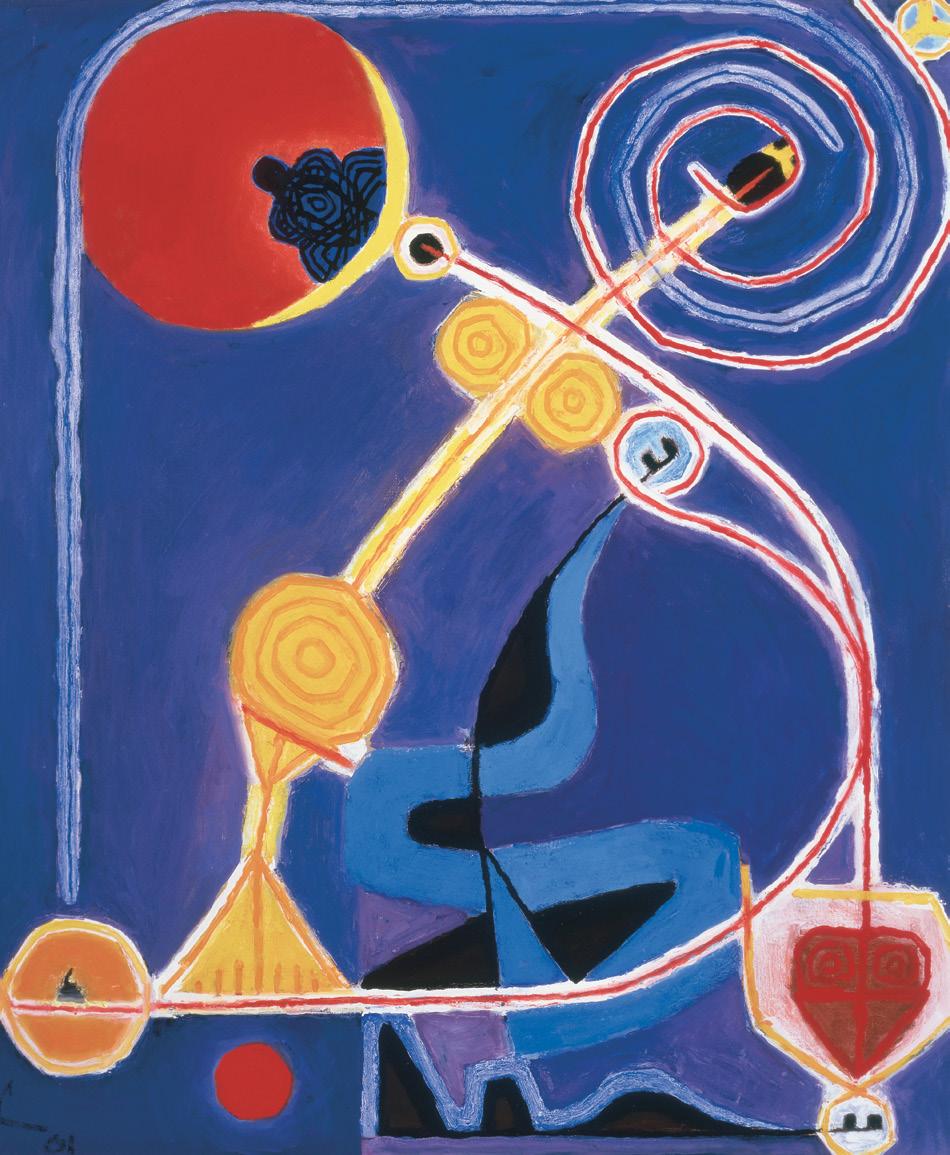



TEXTS BY Timothy Anglin Burgard
Walter Hopps
Bruce Nixon
Robert Flynn Johnson
Bruce Guenther
Anthony Torres
Fine Arts Museums of San Francisco
In association with Hudson Hills Press New York and Manchester
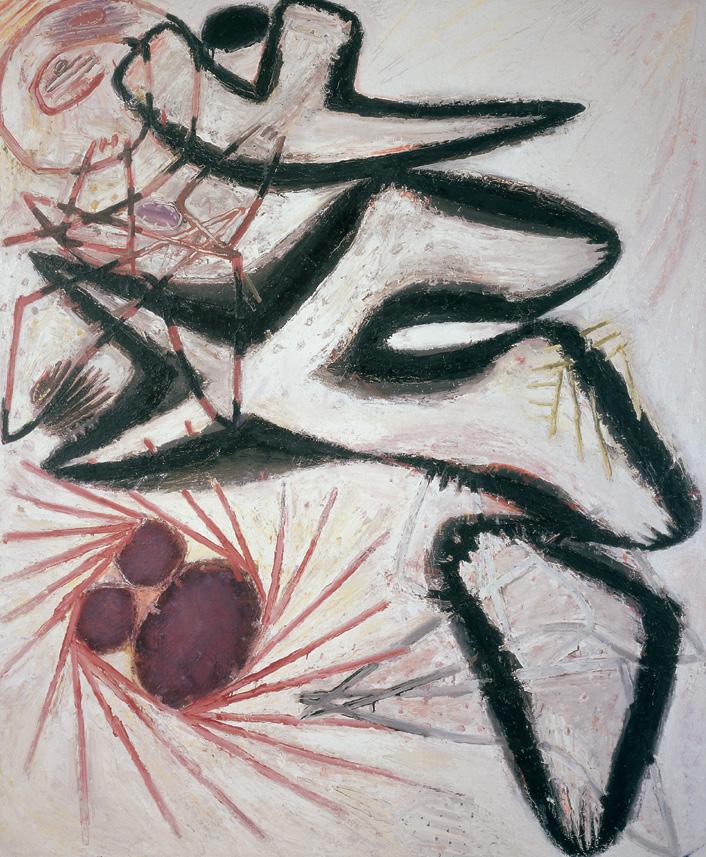
vii Foreword
Harry S. Parker III
xi Introduction
Bruce Guenther
1 Beyond Words: The Hand of Humanity
Timothy Anglin Burgard
9 Paintings and Graphics from 1948 to 1965
Walter Hopps
29 A Wonderland of His Own
Bruce Nixon
179 The Drawing Process
Robert Flynn Johnson
191 Every Thursday Night
Bruce Guenther
229 The Life of the Hand
Bruce Nixon
279 Negotiating Space: The Sketchbooks
Anthony Torres
301 Illustrated Chronology
Diane Roby
Anthony Torres

For over half a century, Frank Lobdell’s work has immeasurably enriched the local and national cultural landscape. His stature is reXected in the acclaim of art critics, in the respect of fellow-artists, and in the admiration of his students, regardless of their personal artistic philosophies. To state that Lobdell is “an artist’s artist” is to acknowledge that he has pursued his calling with passion, discipline, and integrity, and that he has elevated the creation of art above its reception in the art world.
Lobdell’s diverse body of work is linked by its shared sense of humanity. In the 1940s, he was among the pioneers of the San Francisco Bay area school of abstract expressionism. During the 1950s, he gradually reintroduced the human Wgure into his work, thus expanding conventional conceptions of both abstraction and Wguration. Drawing inspiration from the vision of Francisco Goya, these works presented a dark, existential worldview shaped by the cumulative horrors of World War II, the Holocaust, the atomic bomb, and the Korean War.
In the 1960s and 1970s, Lobdell expanded the scale and scope of his Wgures—most notably in Summer 1967 (In Memory of James Budd Dixon) and in his Dance series (1969–1971)—which now actively asserted their humanity in opposition to the threat posed by the war in Vietnam. From the 1980s to the present, he has developed a resonant new language of signs, one that suggests the primordial and the mythic are not relegated to the past, but still alive and vital in the present. Equating art and life on the most fundamental level, these recent works reconnect contemporary viewers with the eternal physical and spiritual struggle of the artist—and of humankind—for making and meaning.

The Fine Arts Museums of San Francisco have a relationship with Frank Lobdell that spans his entire career. Thus it is both Wtting, and an honor, to celebrate the publication of this major monograph with a retrospective exhibition of his work. Lobdell’s Wrst interaction with our museums occurred before the merger that joined them. He participated in the invitational group exhibitions of 1947 and 1948 at the California Palace of the Legion of Honor while still a student at San Francisco’s California School of Fine Arts. The M. H. de Young Memorial Museum presented his Wrst solo exhibition in 1960, and three years later, his extraordinary Wgure drawings were included with those of his colleagues Richard Diebenkorn and Elmer BischoV, in an exhibition at the Palace of the Legion of Honor.
The Fine Arts Museums’ longstanding support of Frank Lobdell’s work is commensurate with their mission to support artists of both local and national stature. In addition to organizing the present exhibition at the Palace of the Legion of Honor, two of our curators, Timothy Anglin Burgard and Robert Flynn Johnson, are among the contributors to this catalogue, along with Walter Hopps, Bruce Nixon, Bruce Guenther, and Anthony Torres. Project coordinator Anne Kohs, editor Lorna Price, research and production coordinator Diane Roby, and designer John Hubbard along with the rest of the staV at Marquand Books deserve credit for bringing this Wrst major monograph on Lobdell to fruition.
We are pleased to acknowledge that Frank Lobdell: The Art of Making and Meaning is the Wrst exhibition to be supported by the Phyllis C. Wattis Fund for Traveling Exhibitions. We also wish to acknowledge the artist’s wife, Jinx Lobdell, as well as his son Judson Lobdell, who has donated the artist’s largest and most ambitious painting, Summer 1967 (In Memory of James Budd Dixon) to the Fine Arts Museums of San Francisco. We are also indebted to Morgan Flagg, Wayne and Betty Jean Thiebaud, Michael Hackett, Manuel Neri, and Carolyn Farris whose loyal support of Lobdell’s work has helped to make this exhibition and publication a reality. We join them in paying tribute to the unwavering integrity of Frank Lobdell’s creative expression.
Harry S. Parker
III, Director Fine Arts Museums of San Francisco
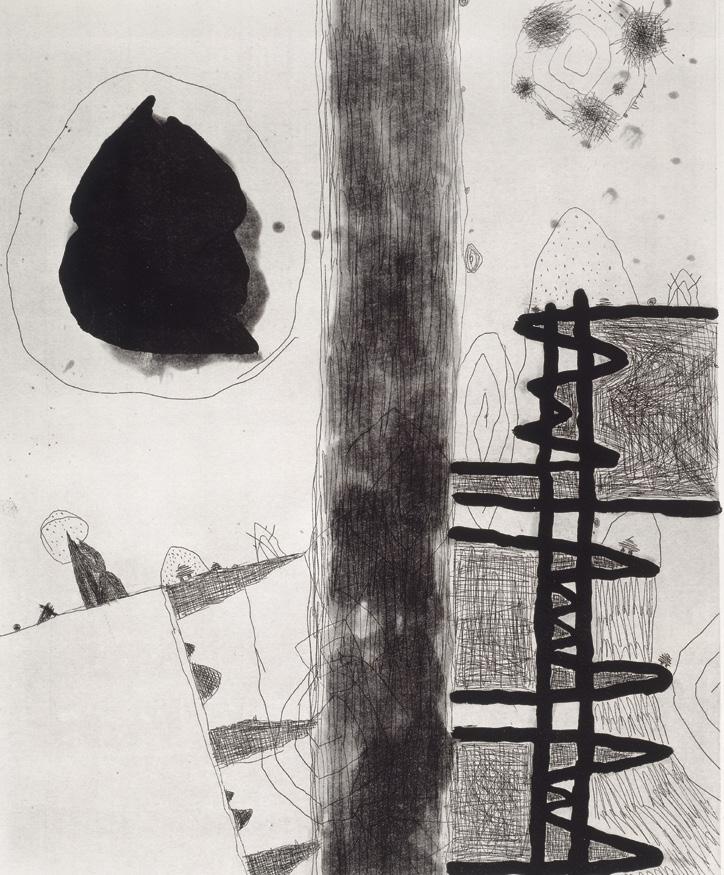
The publication of F RANK L OBDELL : T HE A RT OF M AKING AND M EANING and the series of special exhibitions that accompany it mark an important milestone in the public recognition of an American artist of the Wrst rank. A collaborative endeavor, the institutions and individuals involved have come together to celebrate and document the ongoing artistic achievement of Frank Lobdell, a preeminent member of the San Francisco Bay Area’s artist community. Though widely recognized by his peers as an “artist’s artist” and celebrated for his teaching career, Lobdell has not received the broad public recognition that his contemporaries David Park, Richard Diebenkorn, and Elmer BischoV have been granted. This handsome book, with its voluminous illustrations and scholarly essays, is intended to correct that disparity and provide a guide to the rich evolution of Lobdell’s aesthetic over the course of some sixty years of invention and innovation.
In each successive decade of his working life, Frank Lobdell has been counted as an artist whose work is essential in deWning parameters of artistic dialogue in the San Francisco Bay Area, where his reputation and stature were well established both nationally and internationally by the mid 1950s. The power of his paintings brought him widespread critical attention. Long before he would have regular gallery representation in San Francisco itself, he was exhibiting internationally. As early as 1951, his work was included in exhibition at the Petit Palais, Paris, in a group show; in 1955 he was represented in the Third Biennial of São Paulo; and in 1958, at the Osaka International Festival, Japan, as well as venues in London, Turin, and Eindhoven, including early solo exhibitions in Paris and Geneva. He also showed regularly in solo and group exhibitions in New York, Los Angeles, and San Francisco; in exhibitions at San Francisco’s M. H. de Young Memorial Museum and the Walker Art
Center, Minneapolis (1960); The Whitney Museum of American Art (1962); the Solomon R. Guggenheim Museum, New York (1964); and a major retrospective exhibition at the Pasadena Art Museum (1966), among many others.
Frank Lobdell’s early abstractions of the 1940s powerfully expressed the eVects of service in World War II on his psyche. Responding to their tenor, Thomas Albright, the late San Francisco art critic, observed of them: “[There is] constant . . . evolution in Lobdell’s art . . . from a somber, sometimes tragic sense of elemental conXict to a lyrical and exalted liberation, from darkness into light.” As a student under the G.I. Bill at the California School of Fine Arts (now the San Francisco Art Institute), Lobdell embraced its rejection of traditional canons of still-life and Wgurative painting for an emerging paradigm of process-driven gestural abstraction: “I can’t be content with prettiness when a feeling of turmoil seems most characteristic of our times.” Nevertheless, a focus on surface and color as the building blocks of abstraction began to emerge around this time, coming into full fruition in the successive decades.
By the early 1950s, Frank Lobdell had clearly found his own voice, and his Wrst truly independent paintings emerged. Anthropomorphic references begin to appear in his ever-more-physical abstractions, reinforcing meaning and emotional connections. As with much of Lobdell’s work, the references are often suYciently personal to be opaque, yet for the viewer, recognizable enough to be provocatively troubling. Dore Ashton, New York art critic, observed of him:
[Lobdell] is one of the few San Francisco painters who have been able to take the lessons of ClyVord Still and Mark Rothko, and do something with them. [He has] developed a symbolic imagery that stays close to the myth themes that these older painters were exploring around 1946. [The symbols] . . . engender an atmosphere—a dark, almost chaotic atmosphere of beginning.
Lobdell has enjoyed long tenure as a central Wgure in the instruction of painting in the San Francisco Bay Area. He began his distinguished teaching career in 1957, by accepting an invitation to join the faculty of the California School of Fine Arts. He taught there until 1965, when he left to serve as Artistin-Residence at Stanford University. He joined the Stanford faculty in January of 1966 and taught there for the next thirty years.
From the late 1950s to the mid 1960s, Lobdell participated in weekly Wgure-drawing sessions with his friends Diebenkorn, BischoV, and Park. After moving to Stanford in 1966, he continued the practice, drawing with fellow-instructors Nathan Oliveira, Keith Boyle, and others. Essentially an abstract artist from the beginning, in those years Lobdell used these weekly sessions as a springboard to develop a vocabulary of abstraction that was informed by a study of the human body and grounded in the formal issues of abstract expressionist gesture. His subsequent incorporation of diverse art historical references such as Francisco Goya or surrealism, coupled with direct painting techniques, further distinguished his work as a unique voice on the West Coast.
Lobdell thinks in color, and color is central to the concerns of the last twenty years of his work. It becomes increasingly saturated and jewel-like as he has perfected his technique of layering diVerent translucent colors, one upon the other, to create a much-enhanced and glowing third value. He began to juxtapose warm and cool hues early in his career, and this practice assumed a new importance in the work of the last two decades as it shifted space and emotional tenor within the paintings.
In addition to his work as a painter, Lobdell has been an avid and persistent innovator and explorer of various printmaking techniques, including lithography, etching, and monotypes. He has produced numerous editions through important associations with leading West Coast printmaking studios, including Tamarind Lithography Workshop in Los Angeles; Smith Andersen Editions in Palo Alto; and master printer David Kelso of made in California, Oakland, among others.
In more recent years, Frank Lobdell has been honored with a Pew Foundation Grant; awards from the American Academy and Institute of Arts and Letters, New York, including its Gold Medal for Distinguished Achievement in Painting (1988), and he was elected to the National Academy of Design in 1998. He has served as Visiting Artist/Artist in Residence at Tyler School of Art, Temple University; Yale University School of Art, and other institutions. Frank Lobdell has succeeded in creating a new and meaningful paradigm for his painting, which now embraces a universal symbolism of the sacred and the profane, in breathtakingly beautiful works of both high seriousness and play. In this most recent phase of his work, he depicts a world full of movement, activity, joy, and boundless emotion. To encounter a Lobdell painting today is to engage at the highest level in a complex dance between structure and symbolism, form and meaning. He deploys a high-key palette in dynamic compositions with an erotically charged cosmos populated with abstract Wgures whose sources range across historical world culture and the lexicon of universal symbols. He draws for imagery on West Coast Indian totems, Kilim rugs, prehistoric fertility Wgures, Mediterranean painted pottery of antiquity, Buddhist sculpture, Native American art, and Celtic knot designs.
With a timeless message of human longing and interdependence, Lobdell continues to confound expectations and engage the viewer in a dialogue of earthly pleasure and spiritual enlightenment. Always pushing the limits of his working methodology, he continues to experiment with materials, challenging himself as he devises new strategies of engagement in both painting and printmaking. It is that spirit of inquiry and deep passion that this volume and the related exhibitions celebrate.
Bruce Guenther, Chief Curator and Curator of Modern and Contemporary Art Portland Art Museum, Oregon

Frank Lobdell is a member of “the greatest generation,” not because he served in World War II, but because he survived the physical and psychic scars inXicted by that war and went on to create a signiWcant body of artwork. As a G.I. Bill student (1947–50) at San Francisco’s California School of Fine Arts, he confronted the existential question of whether art retained any relevance in a world that had been permanently transformed by the Holocaust and Hiroshima. For Lobdell, the war became a Wery crucible that stripped his life and art of all illusions. Only through a lifelong artistic struggle has he been able to confront the disasters of war, to reaYrm his paciWst political ideals, and to resurrect the human Wgure as the natural locus of a humanity that seemed to have perished during that conXict.
Lobdell’s Wrst major experience with the art of war occurred in 1940, when he and Wve other students from the St. Paul School of Fine Arts drove through a blizzard to see the Museum of Modern Art’s Picasso retrospective, then on view at the Chicago Art Institute. Lobdell “camped out” at the museum for three days and later called this transformative experience a revelation, one that conWrmed his calling as an artist. Forty years later, he vividly recalled: “I felt the power of painting to really move. I wanted that power, the power to stir emotions as strongly as I was feeling the work I was looking at.”v
If the Picasso exhibition was a revelation, its principal text was the monumental Spanish Civil War painting Guernica (1937, Wg. 2). Lobdell spent an entire day studying Picasso’s apocalyptic vision of birth and destruction, life and death, and innocence and evil. The young artist was particularly struck by the innovative installation of dozens of Picasso’s related drawings and paintings, and observed, “You could read it like a book.”w Like predella panels in a Renaissance altarpiece, these independent works of art collectively augmented the

visual and visceral impact of the larger painting. PreWguring a central tenet of abstract expressionism and Lobdell’s own work, Picasso’s Guernica opus declared the process of artistic creation itself to be a meaningful act and subject. Lobdell’s strong response to Guernica also was inXuenced by the painting’s scathing political indictment of Nazi Germany and Fascist Spain for the destruction of a Spanish town and the deaths of its civilians. As a teenager, Lobdell brieXy considered enlisting in the famous Lincoln Brigade of foreign volunteers, in order to join the Spanish Republicans’ Wght against Francisco Franco’s fascists.x As a mature artist, Lobdell would later emulate Picasso’s perception of painting as a political act in his own antiwar works such as Summer 1967 (In Memory of James Budd Dixon) and the Dance series (1969–1971). But with the United States entry into World War II, Lobdell deferred his art aspirations; he was inducted into the Army in 1942.
In April of 1945, Wve years after viewing Picasso’s Guernica, Lieutenant Frank Lobdell confronted the harsh realities of war when he came upon a barn in Gardelegen, Germany, that was Wlled with the charred corpses of prisoners who had been burned alive by German soldiers. On April 13, over 1,000 concentration camp prisoners had been forced into the enormous, hay-Wlled barn, which was then set ablaze with gasoline and incendiary grenades. Several desperate prisoners scraped their Wngers down to the bone while attempting to dig under the barn doors with their bare hands. The few prisoners who managed to escape the barn were machine-gunned by the German soldiers.
When American troops arrived on the scene the next day, they found over 300 smoldering corpses in the barn, and over 700 bodies buried in an adjacent mass grave. Photographs of the massacre were published in Life magazine on May 7, 1945, and were included in an exhibition entitled Lest We Forget, which toured the United States. But this horriWc scene of “charcoal corpses” contorted by fear and by Wre, their blackened and skeletal hands futilely
grasping for escape, was already indelibly seared into Lobdell’s visual memory. Speaking of his World War II experiences, he later recalled: My identity was shaken by that experience, as I think everyone’s was. . . . Somewhere in All Quiet on the Western Front, [Erich Maria Remarque] remarks that there are no survivors. I think he’s absolutely right. No one who has been involved in one of these wars truly survives. It’ll haunt you for the rest of your life. . . . I painted my way out of a lot of this. Fortunately I had the talent to do this. I couldn’t say that I came to grips with myself except that I was no longer as anxious about a lot of experiences. Somehow the anxiety had maybe gone into the paintings. A bit therapeutic, an unloading on the canvas.y
One of these early paintings, 31 December 1948 (Wg. 1) reveals a dialogue with ClyVord Still’s work, which had been exhibited at San Francisco’s California Palace of the Legion of Honor in 1947. For Lobdell, this inXuential exhibition “hit just as hard as the Picasso show. But in a very diVerent way.”z Still’s work represented an “assault” on the dominant School of Paris aesthetic and shattered conventional conceptions of representation. Still’s work also provided a new visual vocabulary—abstract, elemental, and mythic—that resonated with the existential world view of Lobdell and his fellow war veterans. Although Lobdell never studied with Still at the School of Fine Arts, he admired the older artist’s use of abstraction as a metaphorical mediating point between personal and public narratives. Speaking of his work in terms that could be applied to many of Lobdell’s early works, Still explained:
It is like stripping down Rembrandt or Velasquez to see what an eye can do by itself, or an arm, or a head—and then going beyond to see what just the idea of an eye or an arm or a head might be. In a sense, all the paintings are self-portraits. The Wgure stands behind it all until eventually you could say it explodes across the whole canvas. But by then, of course, it’s become a whole new world. Simply by talking about it you have already begun to falsify, because you are giving names to these ideas, and the forms and colors, and textures have become something else, for which there are no words.{
Formally, 31 December 1948 preWgures many aspects of Lobdell’s later works, including a shallow surface tension between form and space, the deWnition of forms by light or its absence, and a mutable interplay between ostensibly abstract forms and Wguration. The composition’s interlocking puzzle pieces oscillate between a clinging cohesion and a shattered fragmentation, creating a claustrophobic context that extends beyond the canvas’s borders. The agitated brush and palette-knife strokes, fraying and dissipating along their edges, resemble scars raked into the earth, and create a sense of disintegration and dislocation.
Although 31 December 1948 initially appears to be abstract, Lobdell’s explicit linkage of his early work with his traumatic wartime experiences encourages further examination. For example, the four or Wve diagonal black
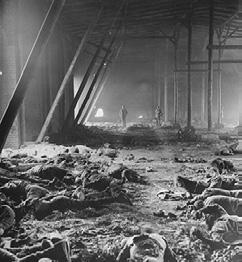
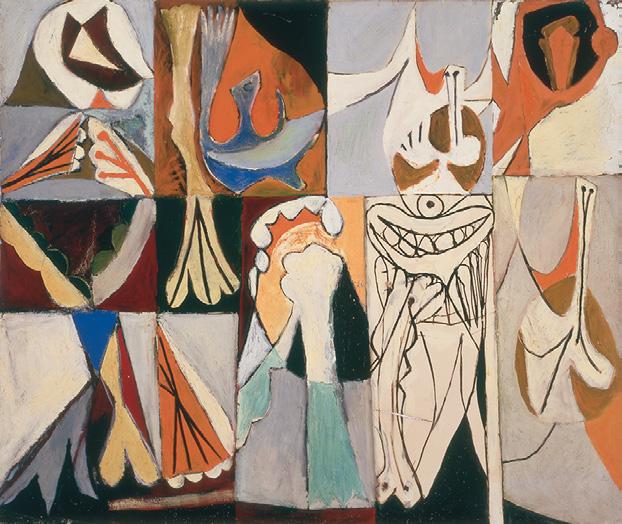
forms at the upper left resemble Wngers, part of a large, blackened handprint impressed upon the canvas surface and streaked by blood red across its palm. These silhouetted, totemic forms also may be seen as individual human Wgures, teetering on the edge of an abyss. A second clawlike black hand descends from the upper right and, subverting the image’s traditional associations of divine intervention by the hand of God, appears to menace the recoiling Wgures below. A third red, white, and yellow hand form lies lifelessly across the bottom of the composition, the Xesh worn away from the joints of its three skeletal Wngers, one of which bears a ringlike band of gold.
Several of Lobdell’s early postwar paintings reveal his attempts to come to terms with the atrocities committed in the barn at Gardelegen. A comparison of 17 October 1947 (Wg. 3) with 31 December 1948, however, reveals an exponential artistic evolution from an analytical and geometric dissection of the human Wgure, to an embodiment of irrational violence and overwhelming emotion—from a depiction of physical pain to the actual sensation of psychic angst. Like a solitary Auguste Rodin hand (Wg. 4), in which the expressive fragment represents the whole, Lobdell’s hands represent the graspable human fragments of an inhumane and incomprehensible whole. These brutalized, dehumanized hands not only capture the victims’ death throes—
they also seem to represent the disembodiment of humanity itself during World War II.
Lobdell, whose prewar political ideals had prompted unsuccessful attempts to enlist in the Marines and the Air Force, was deeply ambivalent about his World War II service. Describing his experience at Gardelegen, Lobdell pointedly noted that the American troops expressed outrage over the atrocities at the barn but demonstrated a relative indiVerence toward the bodies of German civilians they had seen in the town.| Lobdell’s disembodied hands, oscillating between abstraction and Wguration, appear to express this moral dilemma. They blur the distinction between the lifeless hands of the victims and the menacing hands of their executioners, and perhaps also the hands of the artist—ultimately implicating everyone in this crime against humanity:
Fascism had been defeated in a war that a lot of people felt was a worthwhile war, without, of course, realizing the other side. By the time we’d conquered Germany and Japan, we’d been reduced to using the same means. I felt that at the time. An uneasiness about a lot of this. Say, the bombing of Dresden, and the atomic bomb at Hiroshima. Mixed feelings. It saved me from the South PaciWc, and in a way it was the end of the war, but if our enemies had been terror bombing and [using] Hitler’s tactics, etc. If this had been the enemy, why we had defeated ourselves.}
Although many of Lobdell’s abstract expressionist contemporaries rejected overt Wguration, their emphasis on painting as process—a visual record of the physical and psychic traces of the artist’s hand and mind—actually elevated the individual human being’s role as the artist/creator. These personal and cultural contexts illuminate one of Lobdell’s favorite themes:
The hand is so important. This is how things are described. . . . . The main thing is to keep your hand in it, through the entire process. The image can be changed by the medium, and you get something you wouldn’t otherwise have known. . . . But it’s the hand in the end. And it has to be my hand in all of this.~
Lobdell’s use of charcoal black, crimson red, and golden yellow in 31 December 1948 inevitably evokes traditional associations with death, blood, and Wre. As in Picasso’s Guernica, or in Goya’s The Disasters of War (1810–15), the glaring contrast between white and black suggests a battle between the forces of light and darkness, reason and madness, and life and death.
A less obvious connection may be made between Lobdell’s palette and that of Rembrandt, whose Lucretia (1666, Wg. 5), in the Minneapolis Institute of Arts, had made a strong impression on the young artist before the war. Rembrandt’s image of Lucretia, who has just fatally stabbed herself and hovers between life and death, emphasizes her hands (one grasping a knife and the other clutching a cord) and the startling red streak of blood that stains her bright white chemise. Rembrandt’s singular use of Xickering yellow or gold light to convey a tangible sense of humanity and spirituality is perhaps reXected in 31 December 1948, although Lobdell also raises the possibility that this spiritual light has been fanned into a hellish inferno.
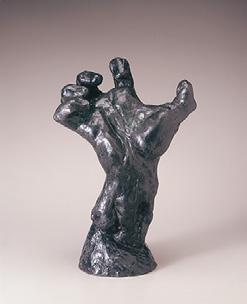

The most appropriate thematic analogy is perhaps provided by another painting that Lobdell admired—Francisco Goya’s Madrid: 3rd of May, 1808 (1814, Wg. 6), which depicts the nocturnal execution of Spanish resistance Wghters by a Wring squad of French soldiers. Goya’s symbolic use of color, including the ominous black sky, the phosphorescent white shirt and gold pants of the central protagonist, and the large red pool of blood spilling from the pile of executed prisoners, appears to be echoed in 31 December 1948. Similarly, the parallel array of death-dealing riXes menacing the Spanish prisoners Wnds resonance in the menacing, clawlike black hand and recoiling Wgures of Lobdell’s painting.
More signiWcantly, Madrid: 3rd of May, 1808 illuminates the seeming contradiction between heroic humanity and ignominious death found in both paintings. The upraised-hands gestures of both Goya’s central Christlike Wgure and Lobdell’s anonymous victim are futile in the face of inevitable death, but they are also deWning moments of human transcendence. Ironically, these deWant martyrs are most alive and most human at the moment when their lives are about to be extinguished.
Like the pigmented handprints found in the neolithic cave paintings of Lascaux, France, Lobdell’s painted hands represent one of the most elemental signs of human identity and self-expression. In the context of the atrocities at Gardelegen, they provided a powerful metaphor for conveying the unthinkable, the unspeakable, and the incomprehensible. Describing his aspirations as an artist, Lobdell declared, “The truth is, you’re after something beyond words. Hence, if there are words, you haven’t done it really. If you can Wnd words for something, then you’d better get back to work. It goes beyond words.”vu In the aftermath of World War II, the Holocaust, and Hiroshima, these archetypal hands commemorated the eternal human struggle for survival and provided a touchstone for the artist’s subsequent invention of a personal sign language. But in 31 December 1948, Lobdell’s hands had already suVused the vocabulary of abstraction with a luminous humanity that slowly re-emerged, like a phoenix from its own ashes, to deWne his art.
Timothy Anglin Burgard is the Ednah Root Curator of American Art and Curator-in-Charge, American Art Department, at the Fine Arts Museums of San Francisco.

Notes
1. Terry St. John interview with Frank Lobdell, San Francisco, April 8, 1980, Archives of American Art, Smithsonian Institution, hard copy in Frank Lobdell artist Wle, American Art Department, M. H. de Young Museum, San Francisco, p. 7.
2. Ibid., p. 9.
3. Timothy Anglin Burgard interview with Frank Lobdell, October 30, 2002.
4. Terry St. John, op. cit., p. 35.
5. Terry St. John, op. cit., p. 19.
6. ClyVord Still, quoted in Thomas Albright, “The Painted Flame,” Horizon (Nov. 1979), p. 32.
7. Timothy Anglin Burgard, op. cit.
8. Terry St. John., op. cit., p. 26.
9. Bruce Nixon, interview with Frank Lobdell, San Francisco, 2002, cited in “The Life of the Hand,” below, p. 233.
10. Terry St. John, op. cit., p. 26.
y Lucientes,
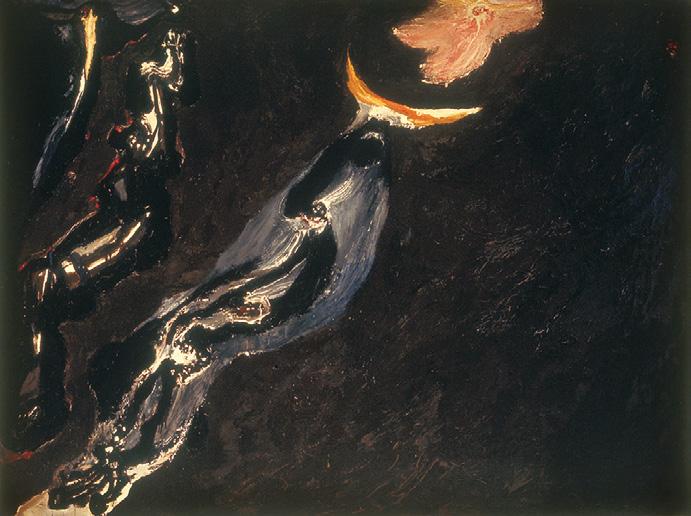
Paintings and Graphics from 1948 to 1965
Pasadena Art Museum
March 15–April 10, 1966
Central to the art of Frank Lobdell loom the issues of mortal struggle and moral choice. His art is deeply introspective, evokes questions of human dilemma, and is far from an art of preconceived formal order, ideatic postulate, or hedonistic engagement. Confrontation with Lobdell’s art immediately reveals his commitment to an evolving, intuitive, painterly process. Each painting, for the most part heavily worked and reworked, obviously involves a prolonged process of formation. There is the sense that these paintings have been brought into being with great diYculty, and this sense of diYculty and struggle so overtly expressed determines a core of meaning in the painting. The paintings are diYcult in another sense, in the way their imagery deWes conventional identiWcation as either abstract or Wgurative. Established is a uniquely ambiguous imagery (something other than a readable, visual metaphor) completely interlocked with and revealing of the physical consequence of the paint and paint application. The speciWc conWguration of Lobdell’s imagery changes as his work evolves in time, but perhaps consistent with it is its profoundly disquieting, often anguished tenor.
In locating Lobdell’s work in the context of today’s serious advanced art, it is important to know that his Wrst fully mature work appeared in the period 1948–1950. This comes at the climactic moment in the emergence of what is implied in the phrase “New American Painting,” as associated with the work of Gorky, de Kooning, Newman, Still et al. The physical characteristics of
*This essay appeared in the catalogue Frank Lobdell: Paintings and Graphics from 1948 to 1965, published by the Pasadena Art Museum for an exhibition curated by Walter Hopps and presented at the museum March 15–April 10, 1966. The exhibition was then shown at the Stanford Art Museum, May 1–31, 1966. Reprinted by permission of Norton Simon Museum.
opposite Fall 1958, reproduced on the cover of the Pasadena Art Museum exhibition catalogue, 1966.

Lobdell’s painting, of course, associate it with that work of the New American Painting conventionally identiWed as abstract expressionism.
While New York City in the 1940s was unquestionably a primary center of abstract expressionist development (i.e., essentially the New York School), it is nonetheless the case that related, germinal work was emerging in the San Francisco Bay region at virtually the same time. Further, the transience of certain artists (particularly Still and Rothko) between the two cities at the time carried approaches to painting developed in the San Francisco region to New York, as well as from New York.
Lobdell’s primary home and working environment since the Second World War has been San Francisco. When the spotlight of recognition and notoriety came, for many obvious reasons, to focus upon the artists and activity in New York (pronouncedly so by 1955), Lobdell remained as a major Wgure among those few who stuck it out in San Francisco. While it does not follow that those artists working in New York City and destined to receive great notoriety necessarily expected or sought it, it does follow that those artists, such as Lobdell, remaining far from any spotlight in San Francisco markedly demonstrated their unconcern for either potential notoriety or frenetic art world involvement. Lobdell’s deliberate decision to remain in a place promising little in the way of notoriety and its material beneWts goes beyond explaining his relative obscurity ten years ago to suggest the extent to which he maintained a belief in the value of a rather rigorously independent, self-reliant role for himself as an artist.
In tracing the course of Lobdell’s life there are events to be singled out that have obvious bearing on the nature of his art. His youth was spent in the Midwest, primarily St. Paul, Minnesota, a city far from being a sophisticated center of modern art. Lobdell’s childhood preoccupation with drawing was not discouraged at home and was eventually stimulated by an unusually enlightened high school art teacher, Eugene Dana. His experience in high school triggered his desire to pursue Wne art and led him to study with Cameron Booth at the St. Paul School of Fine Arts in the late 1930s. At that time, Booth was clearly one of the few artist-teachers in the Midwest involved with any real sense of modern art.
With little important art existing in Minnesota, Chicago was the closest important center for Lobdell to see art of the past or anything approaching current activity. Unfortunately, circumstances for him were such that visiting Chicago was not easily undertaken. Lobdell had visited Chicago’s Art Institute at the time when The Museum of Modern Art’s vast Picasso exhibition was presented there. The impact of the exhibition was decisive; this was Lobdell’s Wrst encounter with a large number of great twentieth-century paintings. The curious muscular and rather brutal vitality and sophistication that mark Picasso’s painting around 1906–1910 Wnd something of a later date transformation in Lobdell’s Wnest work. It is at least clear that this aspect of Picasso aVected Lobdell far more than Picasso’s detached architectonic
structure and analytical cubism. Lobdell also came to have a great regard for Picasso’s skill in draftsmanship.
Lobdell left art school immediately after his encounter with the Picasso exhibition and began to devote his full time to painting on his own, maintaining a studio in St. Paul, and later in Minneapolis. His early independent career was interrupted by military service from 1942 to 1945. Following the war, Lobdell chose to reenter art school under the beneWts of the G.I. Bill. At one point he considered establishing himself in New York City, but personal circumstances dictated San Francisco, and he completed the program of the California School of Fine Arts.
The California School of Fine Arts has occupied a major role in the development of art in the Western United States from its founding before the turn of the century to the present. The eVect of this school, now known as the San Francisco Art Institute, was never greater than in the late 1940s following the war. Lobdell’s association with this school was of vital consequence to him during that period as a student and later, in the 1950s, as a member of its faculty.
ClyVord Still, undoubtedly the California School of Fine Arts’ greatest teacher, characterized this school in the late 1940s as far from being an ideal center for artists themselves, in that it was disorganized, naive in many of its programs and administrative functions, and often unsympathetic to the most serious teachers and students in residence. Nonetheless, Lobdell enjoyed the opportunity to work virtually on his own with what amounted to a government subsidy. Moreover, the school’s milieu tended to blur distinctions between the faculty and those mature students returned from the war, many of whom already had the beginnings of a career prior to military service. The variety of artists variously associated with the school was quite extraordinary, including such men as: Elmer BischoV, Ernest Briggs, Richard Diebenkorn, Edward Dugmore, John Hultberg, Jack JeVerson, the late David Park, Mark Rothko (during his summer session visits), Hassel Smith, Clay Spohn, and many others. The impact of Still’s art was felt throughout the school. Beyond Still’s art itself, Lobdell highly valued his exposure to what he refers to as “the weight of Still’s intellect.”
The work of certain artists of his generation, who were active in the San Francisco Bay region up until 1950 (and beyond in the case of some), contrasts sharply with the often foreboding quality of Lobdell’s art. For example, the work of Richard Diebenkorn assumed a more calm, lyrical nature. The work of Hassel Smith was characteristically involved with imagery of ironic and unpredictable wit. Sam Francis, who attended the University of California in Berkeley across the Bay, was developing an abstract expressionist approach involving a sensuous and expansive hedonism, in extremely marked contrast to Lobdell’s work. Perhaps the work of these artists was visually related, if at all, only in respect to certain general characteristics of space and scale operative in their painting. The essentially postcubist space involved a sense of
extendibility of forms beyond a limit as cropped by the canvas’s edge. Thus, critical or dramatic elements in the composition might well appear at the canvas’s edge rather than being centrally located and contained.
Lobdell visited Paris brieXy between 1950 and 1951. For him the experience turned out to be particularly unsatisfactory. The postwar artwork in Paris seemed weak and eVete in the face of its prewar tradition and in comparison with the adventurous, vigorous work he knew was being done in the U.S.
In 1951 Lobdell returned to San Francisco and soon settled in the studio, near the San Francisco waterfront on Mission Street, which he has occupied until this time. Lobdell encountered a startling situation; art activity as he had experienced it before living in Paris seemed to have collapsed. Many important artists had left the city, most of them for good. The nature of the California School of Fine Arts seemed to have changed; the lively contemporary exhibition program fostered by Jermaine MacAgy came to a standstill when she and her husband, Douglas MacAgy, the outgoing Director of the school, left the area. There remained incredibly little art life in the city apart from that maintained by Dr. Grace Morley at the San Francisco Museum of Art and that occasionally generated by artists themselves in the face of poor and diYcult circumstances. Something like a mere six private collectors and gallery dealers together scarcely provided a resourceful patronage for the art created in the area. Lobdell has characterized 1952–1953 as the dark years, and he worked in a sense of isolation that must have seemed peculiarly close to that which he had experienced in Minnesota before the war. Somewhat ironically, the interest that began to be taken in Lobdell’s work, stemming from around 1957, came from New York, Los Angeles, and Europe.
The writings of two American authors, Herman Melville and Henry David Thoreau, have preoccupied Lobdell during the period of his work in this exhibition. Without, of course, suggesting that Lobdell’s art illustrates this writing, it seems that Lobdell shares parallel concerns and somehow makes them known in his work. Such concerns, deep in the American grain, continue to haunt our thoughts.
Walter Hopps is Curator of Twentieth-Century Art at the Menil Collection in Houston, and Adjunct Senior Curator of Twentieth-Century Art at the Solomon R. Guggenheim Museum, New York. In 1966 he was curator at the Pasadena Art Museum.
Pasadena Art Museum, March 15–April 10, 1966
The following information is reproduced from the 1966 Pasadena Art Museum catalogue for the exhibition Frank Lobdell: Paintings and Graphics from 1948 to 1965 (March 15–April 10). Images of artwork have been added if available. Titles and collections are listed as recorded in 1966; dimensions are updated. Current information on works illustrated here appears below in the List of Illustrations (p. 387).
The paintings listed here have been selected by the artist as comprising his principal body of work executed between 1945 and 1965 in the medium of oil-based pigments. Dimensions are given in inches, height preceding width. All paintings are on canvas except no. 58, which is on a Masonite panel. Those listed with (*) are unavailable for this exhibition.
The graphic works listed here have been selected from the artist’s total output of several hundred that were produced in these same years. The drawings are executed in mixed media, as indicated, except the final entry (no. 98), which is a lithograph.
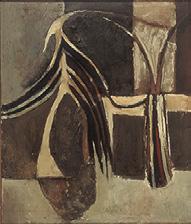
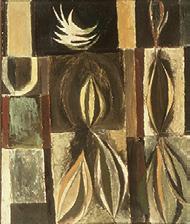

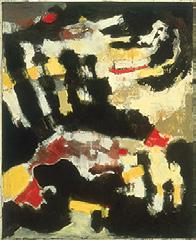






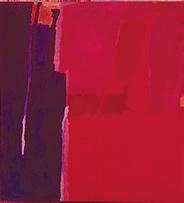
12. NOVEMBER 1953 NUMBER 1
73


14. MARCH 1954 (2) 69H × 65H


16. MARCH 1954 (4)
not illustrated
17. APRIL 1954 NUMBER 1

18. JULY 1954

19 × 14 inches

69

69

69H × 48 inches


70 × 61G inches


26. FEBRUARY 1957
(Black painting)
69G × 60G inches
Mr.
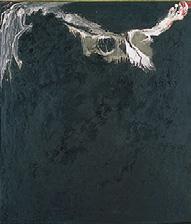
69G × 60G inches

70 × 60G inches
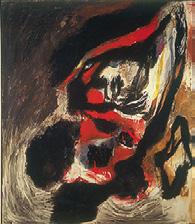
75
not illustrated
87G × 70 inches
Lent anonymously




34. FALL 1958
69G × 91I inches

69
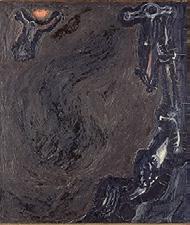

70
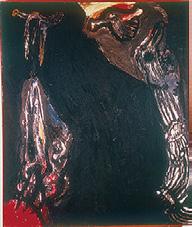
38. APRIL 1959
70I × 74G inches
39. JUNE 1959
73G × 70 inches


40. SUMMER 1959
68G × 91 inches
Mr.

41. AUG 1959
61 × 37 inches
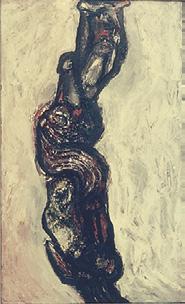
42. OCT 1959
48H × 49I inches
Martha Jackson Gallery, New York City
43. JULY 1960 *
39 × 31 inches (approximate)
44. SEPT 1960
73 × 49 inches
Mr. and Mrs. Harris Newmark, Los Angeles
45. OCT 1960
48 × 44 inches Ferus Gallery, Los Angeles
not illustrated not illustrated
not illustrated
46. FALL 1960 *
85H × 69I inches
Martha Jackson Gallery, New York City
not illustrated not illustrated
47. FEBRUARY 1961
61H × 70 inches
James A. Michener Foundation Collection, Allentown Art Museum
48. MARCH 1961
63 × 70 inches
Mr. and Mrs. Gifford Phillips, Santa Monica





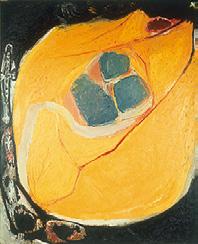
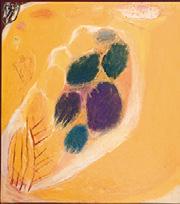


56. SUMMER 1962
69I × 97G inches
Martha Jackson Gallery, New York City
57. 3 OCT 1962
30 × 24 inches


58. ASCENT (Red) 13 OCT 1962
72I × 48I inches
Martha Jackson Gallery, New York City

59. DARK PRESENCE (Yellow) 3 JAN
97G × 69I inches
60. FEB 1963
62H × 69M inches
Martha Jackson Gallery, New York City 1963
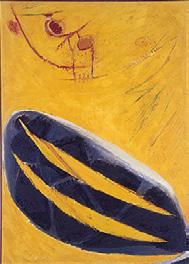
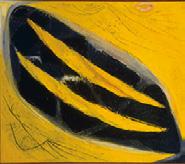
61. DARK PRESENCE III (Yellow)
61H × 69I inches
Martha Jackson Gallery, New York City

62. DARK PRESENCE (White) 20 MARCH
70H × 60H inches
Martha Jackson Gallery, New York City

NOV 1964 60 × 50 inches


JUNE 1964
60J × 49M inches





70. MAY 1965
57 × 47H inches

71. SUMMER 1965
83K × 69 inches
72. OCT 1965
57 × 43 inches
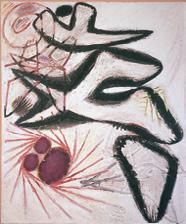

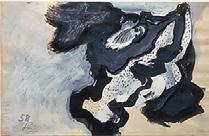
74. Untitled 1958 Gouache and ink on paper
9J × 14 inches
Mrs. Albert Levinson, Los Angeles
75. Drawing 7/4/58
Gouache, ink and collage on paper
18 × 24 inches
Mr. and Mrs. Robert A. Rowan, Pasadena
76. Untitled Gouache and ink on paper 9 × 14 inches
Ferus Gallery, Los Angeles



77. Untitled Gouache and ink on paper
13L × 11 inches
Ferus Gallery, Los Angeles
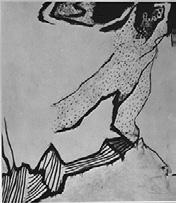
78. Untitled Gouache, ink and pencil on paper
14M × 20G inches
Ferus Gallery, Los Angeles

79.
14I × 20H inches
Los Angeles
15G × 20 inches

83. A 2
Crayon and pencil on cardboard 8 × 14 inches
Martha Jackson Gallery, New York City
16K × 13G inches
Martha Jackson Gallery, New York City
7H × 15 inches
84.
Crayon and pencil on cardboard 8 × 14 inches
Martha Jackson Gallery, New York City
Martha Jackson Gallery, New York City not illustrated not illustrated not illustrated not illustrated not illustrated not illustrated not illustrated
85. Untitled #22
Gouache and ink on paper 15 × 17I inches
86. Untitled #19
Gouache and pencil on paper 14 × 17 inches
Martha Jackson Gallery, New York City
11I × 17I inches

11I × 17I inches

17

17
Martha


17
Martha
Gallery, New York City not illustrated


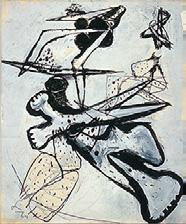
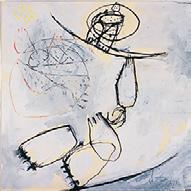



When Frank Lobdell arrived in the San Francisco Bay Area in 1946, recently married and less than a year out of the Army, he soon found himself in the company of a small group of artists fervent in their pursuit of the new American abstraction. Their center of gravity was the California School of Fine Arts—now the San Francisco Art Institute—a rambling, old Mission-style building collected around a fortresslike tower on the slopes of Russian Hill, and most of the other artists Lobdell met there were much like himself, young veterans funding their studies with the G.I. Bill. Few were native to the city. Many of them had discovered it while journeying to and from the PaciWc front, and then they returned, drawn to its balmy weather, the glistening coastal light, and the silent, creeping fog banks that cloaked the city in briny mists, which transformed the nighttime streets into a spectral tableau, to the North Beach clubs where a nascent jazz revival was already underway, and to the gregarious world of the saloons and coVeehouses—a city close to the landscape that surrounded it on every side, with an easy, relaxed atmosphere far diVerent from the metropolitan centers of the East Coast. For the Wrst time, too, the study of art represented a realistic alternative to a conventional college education, and to conventional social and professional ambitions—something that had a powerful appeal for men whose youth had come to an end amid the destructive sprawl of global warfare. Art oVered itself as a practice into which they could direct their experiences: the self-reXexive conditions of abstraction promised a means of exploring a sense of existence that literally deWed description. And the school had risen to meet this need, with Douglas MacAgy, a new director whose handpicked instructors were in most cases no more than a few years older than the students and just as enthusiastic about the emerging progressive art.
Bruce Nixon
opposite 1. June 1964
Like many artists whose working lives have been similarly long and productive, Lobdell’s can be arranged into a discernible sequence of stages, even if they do not always assume a neat or outwardly logical order. But his career rightly begins in the late 1940s with his embrace of abstract expressionism, in which he recognized that painting might provide a lifelong arena of individualized inquiry, a place where he could, indeed, be entirely himself. Later phases of his career, particularly the complex body of work that began during the mid-1970s, may be more far-reaching in their signiWcance, but Lobdell was occupied from the start with the ideas that have engaged him throughout his career. One sees, for example, a fascination with the exchanges that occur when invented forms are placed in the various kinds of spaces that can be created upon painted canvas; these spaces may allude to “real” spaces in an interrogative way but should never be confused with them, since one of Lobdell’s subjects, the origin and nature of meaning, is inseparable from his conception of the work of art as a controlled, intensely personal site whose uncertain relationship to the real world is very much to the point.
A trait that distinguishes the human from other species is its will—or perhaps more accurately, its compulsion—to generate meaning from forms and signs. We are a reading species, and so we depend upon systems of representation to make sense of our experience of the world. The extent to which ‘meaning’ is collective or individual, general or speciWc, intrinsic or invented, is another of Lobdell’s concerns, and we often Wnd him working in the overlap between Welds of possibility. Inquiry into the conditions of meaning and the ways in which visual information may be garnished with cultural signiWcance is not new, of course, nor is Lobdell the only artist to have recognized that abstraction oVered tremendous potential as a method of contemplating it— whether as self-dramatization, as an open-ended, nonspeciWc visual form, or simply as a diVerent kind of representation. But he approached the task with considerable originality, and he has gone his own way, resisting abstract expressionism’s tendencies during the 1950s toward an increasingly vigorous generality of reference in materials and application.
With unXagging diligence, Lobdell instead absorbed a wide range of images from both art and nonart sources as he went about shaping his own Xexible spatial environments and a lexicon of forms with which to populate them— forms that have remained resistant to conventional symbolic associations. Over time, these forms would take on lives of their own, as they were absorbed into the gradual, systematic evolution that has been pervasive throughout the work itself. In many artists, such patient, deliberate production would extend the promise of revealed meaning, but Lobdell avoids presumptions of this sort. In questions concerning the human condition, he has no deWnitive answers; indeed, the questions themselves may be no more than illusions. It was as if he had seized upon the most promising visual ideas of the day, drawn from the surrealist-derived imagery of Joan Miró, Mark Rothko, Adolph Gottlieb, and William Baziotes, and intensiWed their activities upon the canvas, pushing them as hard and as far as he could, until he crossed into a territory that was utterly, recognizably, his own. He never felt a need to reduce his imagery. The deployment of signage in early abstract expressionism, which tempered its
auratic visual presence with a provocative ambiguity, had moved him. Rather than abandon it or permit it to be subsumed in the reWnements of the modernist canvas, he wondered where else it might lead and what additional accomplishments awaited it, and then he set about Wnding out.
The direction of Lobdell’s late phase is announced as early as the mid1960s, in the magisterial paintings Summer 1967 (In Memory of James Budd Dixon) and Summer 1968, but the conditions of his career may be as much a result of his decision to remain in the Bay Area as they are a matter of temperament—though the determination to separate himself from the center of the art world should also be regarded as temperamental. He kept abreast of events, but was under no pressure to submit his work to the prevailing doctrines of late modernism. He knew that the appearance of Wgural imagery in his work would encounter little, if any, disapproval in a region in which boundaries between abstraction and Wguration had never been clearly Wxed: so it was that the Wgure as Wgure appeared on his canvases during the early 1950s, and there it has remained, in one form or another, ever since. Immense shifts have occurred, of course. The functionality of the Wgure, which is such a distinctive aspect of the canvases of the 1950s and early 1960s, falls away as the artist begins developing idiomatic Wgural forms whose correspondence with the human body is no longer readily apparent, forms that refuse to abide by the familiar traditions of Wgurative meaning in art.
In essence, Lobdell has devoted himself to the creation and expansion of his own visual vocabulary, one to which he—and possibly only he—has full access. He has constructed a wonderland of his own, and as we go about interpreting what we encounter there, the work holds a mirror to the human imagination and to the array of procedures with which we go about assembling meaning. We will look for meaning, of course. We can hardly prevent ourselves from approaching the canvas as a vehicle of symbolic imagery. Along the way, however, careful observation of the machinery of interpretation may be explanatory, not because it provides any particular answers but because it unhinges the very possibility of absolute meaning or immutable truth.
Still, in Lobdell’s mind, the evolution of his imagery has been toward sign, not symbol; more precisely, it has moved away from symbol, seeking an escape from the symbolic. In common usage, ‘symbol’ and ‘sign’ are virtually interchangeable, but for Lobdell, ‘sign’ carries the implication of neutrality: it is a signiWer that refers to nothing other than itself. It is free of reXexive associations, which bestows a certain kind of availability. The symbol, on the other hand, is by deWnition referential, relying upon its connections to the established themes of a collective culture for successful application in the work of art: broad cultural agreements regarding the ‘meaning’ of the image constitute the basis for archetypal forms, literary allusion, the presentation of readily apprehensible thematic content, and so on. These distinctions of terminology acquired signiWcance for Lobdell during the 1950s and again in the late 1960s and early 1970s, when he discovered that overtly Wgurative elements, with their inevitable symbolic inXections, tend to direct the reading process along predictable, well-established channels of interpretation, an experience that demonstrated the limitations of the symbolic within the context of his own
speciWc concerns. Reliance upon conventions inevitably bound the work to dominant themes in the culture; at the very least, it required an acquiescence to cultural narratives of which Lobdell was highly skeptical, or in which he did not believe at all. At the same time, his Werce independence would not allow him to submit his work to the familiar rituals of rebellion and critique, which would be just as compromising in the end. He sought instead a path of his own.
From this perspective, Lobdell’s career can also be regarded as an investigation into the diVerences between symbol and sign, and why those diVerences are of such importance. In transitional paintings such as Summer 1977, Winter 1979, Fall 1980, and Spring 1982, we witness the force with which he penetrates the symbolic and then casts it aside. He turns to signage in its stead, his own signage: the sign as the initial moment in the life of the symbol, its chrysalis state, prior to cultural internalization and thus to the establishment of thematic identity that occurs as meaning begins to gather around it. Each of his signs has its own history, certainly, but we can never be sure of its full range of reference for the artist, or if a precise catalog of reference even exists. Lobdell is not in the business of self-expression, which would only impose a further determinant upon the work.
As a narrative—and it is that—the prodigious Xow of images from Lobdell’s studio is a kind of theater, with the canvas as a stage. The work is not simply artiWce, however, any more than it is simply presentational, a mode of illustration. In the end, Lobdell’s signs, regardless of their meaning, or their lack of it, belong to the world because they are in the world and can exist nowhere else. Perhaps they are a little uneasy about this, and long for a certainty that will always elude them. Then, too, they must operate against the instincts of a culture highly skilled at generating symbols and meanings of its own—often cynical, self-serving ones. Meanwhile, on the level of the individual painting, Lobdell struggles toward the moment that satisWes his eye. Each painting seeks that moment for itself, and the originality of the imagery simply assures that his eye will recognize that moment when it arrives.
An old black-and-white photograph taken in one of the studios at the California School of Fine Arts during the late 1940s provides a rare view of a class during that era. A number of students can be seen from behind as they labor at their easels. Neither a model nor an instructor is in evidence, and most of the paintings could be described as variations upon the characteristic local abstraction of the era. One of the students is Frank Lobdell, who has stepped back from a large, cluttered image that vaguely recalls a Picassoesque automatism—the mobile line that creates forms which are then revised with patterns of color. Picasso was still a preeminent Wgure for many young American artists, who responded to his restless, protean outpouring of forms and images. Lobdell himself had traveled by automobile to Chicago during the winter of 1940, while he was still a student at the St. Paul School of Fine Arts in Minnesota, to see an exhibition of Picasso’s work at the Chicago Art Institute, where he found himself transWxed by Guernica (1937). It occupied the far wall of a long gallery otherwise devoted to studies and

smaller canvases related to the painting, appearing with the force of revelation amid the Wres of war in Europe.
Lobdell would continue to draw information from Picasso’s work for many years to come, but that is getting ahead of the story. For the time being, with the war so close in memory, eVorts to extend a local surrealism derived from Picasso and other European models had become increasingly problematic— the style was not exhausted so much as burdened by prewar aYliations that now seemed all but irrelevant—and Lobdell’s own diYculty is evident in the tangled imagery of the painting before him. This one is a struggle, but it is a struggle against the persistence of direct inXuence. One senses that Lobdell has recognized the deeper problem before him, and although he eventually chose to work through rather than abandon his sources, the painting in this photograph seems to encapsulate the situation of the moment. Painters in New York had experienced a similar conXict after launching themselves during the late 1930s and early 1940s from various surrealist models, but even before the end of the decade, they had found their answer in greater visual simplicity and clarity of intention; this resolution can be seen as an underlying motive in Rothko’s hovering rectangles and Gottlieb’s bursts, Robert Motherwell’s vast ovoid shapes, and the monochrome canvases of Barnett Newman, with their towering, unequivocal objecthood and frank acknowledgement of the viewer before them. But Lobdell was laboring in much diVerent company, and he would arrive at some crucial answers late in the summer of 1947, when he went to see an exhibition of thirteen paintings by ClyVord Still at the California Palace of the Legion of Honor, a museum devoted largely to



historical European art in a low, windswept Beaux-Arts building overlooking the Golden Gate.
Still was an instructor at CSFA at the time, having been hired the previous year, and his imperious manner, his outspoken views on abstract painting, and the high-Xown, messianic rhetoric with which he expressed them had already created factions within the art school. He had been in the Bay Area earlier in the decade, employed in the defense industry, and his work appeared in a museum there for the Wrst time in 1943, apparently without much local impact. Four years later, circumstances had greatly changed, and because so many artists were aVected by it in one way or another, the 1947 exhibition is now regarded as a watershed event in San Francisco’s emergence as a center of abstract expressionism.
But Lobdell did not like what he saw, at least not at Wrst. The crusty surfaces of Still’s paintings, built from dark earth tones applied with a palette knife, seemed crude and deliberately opaque, and he was determined to reject them. More than a half-century later, he recalled: “All of this painting was an assault on what I had developed, an assault on my inXuences up to that point. Color in Still was raw. The paint was raw. But I was so anxious to protect my investment in French art that I went back a dozen times, trying to Wnd a Xaw, a reason to put this stuV down. Then one night I was working on a canvas in my studio at Sausalito and the next thing I knew, there was some of that ragged edge, some of that color, in my painting. And I realized I’d been had. It woke me up. It was like an irritation, getting in the way of something I felt comfortable with.”
opposite and above
For Lobdell, the full eVect was not immediate, but certain ideas that he took from Still would have a lasting impact: indiVerence to decoration; immersion in the materiality of paint and the sheer physicality of the relationship between texture and form; a sense that the events on the painting continue beyond the edges of the canvas, which leads to a rejection of the frame as an arbiter of coherence and meaning; the ways in which large Welds deWne smaller ones, and vice versa, an active exchange that inXuences the spatial character of the overall image; and by extension, an understanding of the painting as a fundamentally spatial event. Lobdell never really accepted the idea, in circulation by the 1950s, that Still’s work was based in the Western and the romantic landscape traditions. For him, its primary subject was space, space built with a technique so coarse and aggressive that it bordered on violence. Picasso brought a barbarism of his own to the image, which was an aspect of his appeal for Lobdell, but Still shifted emphasis from depiction and narrative invention to the painting as an object unfettered by conventions of pictorial logic, an image excavated from its own materials.
Other contemporary painting was available to artists working in San Francisco at the time. The San Francisco Museum of Art owned Pollock’s Guardians of the Secret (1943), a painting whose inXuence can be detected in the work of a number of artists in the city, and also owned Rothko’s large surrealist canvas Slow Swirl at the Edge of the Sea (1944); museum annuals brought the work of Gottlieb, Baziotes, Rothko, Jackson Pollock, and other artists in New York. But distance—the condition of information often acquired at second hand—would prove to be an impediment to the local dispersion of European modernism. The Bay Area had no émigré artists to serve as role models, nor galleries in which to see their work; most of the art activity revolved around the schools. As a result, San Francisco never experienced a surrealist phase in quite the same way as New York, and indeed, some notable aspects of the surrealist program simply had no application there. But with the understanding that the self had priority in abstract painting, an idea of surrealist automatism did arrive more or less intact. As a result, San Francisco abstraction displayed a distinctive gestural tendency almost from the start, sometimes Xamboyantly so, in colors inXuenced by the variety of the landscape and the chiaroscuro of intense light and shadow.
While abstract painting in the Bay Area was greater than the sum of its inXuences, one can chart aYnities between Pollock’s surrealism and James Budd Dixon’s scabrous canvases; the compositional divisions and muted palette in Rothko and Edward Corbett or Edward Dugmore; the frisky, erotic line of Arshile Gorky and Baziotes as it popped from Hassel Smith’s twirling brush; or Pollock’s allover paint application, pushing hard against the borders of the canvas, in the work of Ernest Briggs. In the end, however, the evocation of the physical world, in all its immediacy, would be central to the character of San Francisco abstraction, together with the rather idealistic embrace of abstraction as a journey into selfhood, using automatism as the primary vehicle of access; or to put it another way, the subconscious and its negotiation of the environment around it, expressed in paint. In Lobdell, the debt to automatism is most evident in his drawing practice, an extensive, wide-ranging pursuit
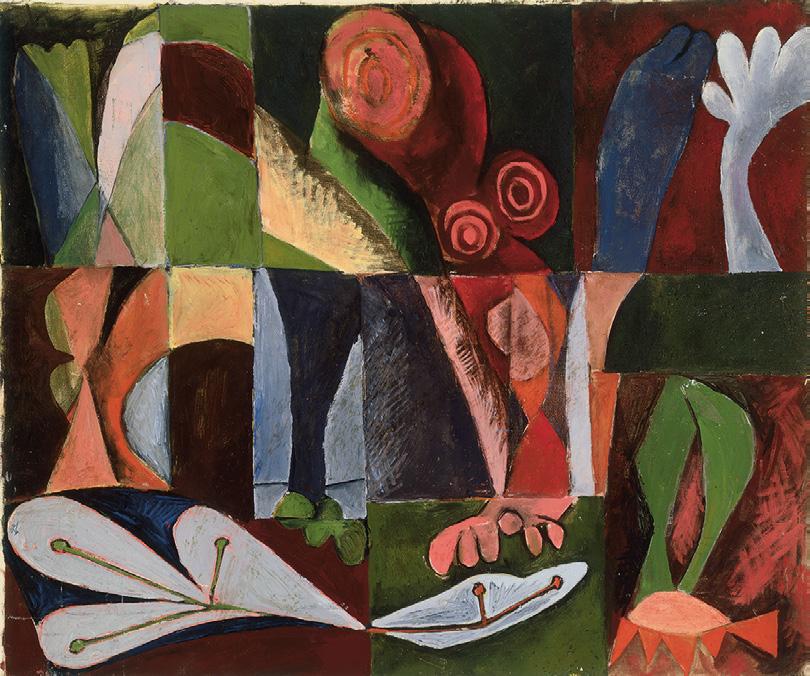
that exists in a kind of parallel to the paintings until the mid-1970s, when the drawings and paintings begin to move into close alignment. But with the San Francisco group as a backdrop to his activities during the 1940s, it is clear that he was already as interested in signage and space as he was in signature gesture.
At times, Lobdell can be quite straightforward as he works from ideas that were circulating throughout the period. 10 October 1947 (Wg. 2), for instance, is assembled into a grid of squares and rectangles, each containing a discrete pictographic image; in November 1947 (Wg. 3), reddish rectangles are set down like bricks, creating an architectural form that resembles a niche, with a totem wedged into its dark space.


The format of 10 October 1947, derived from cubism, eliminates centralized or hierarchical perspective, as it does in Gottlieb’s similarly arranged images. The pictographs suggest no internalized thematic connections; the compositional structure keeps the eye moving from one box to the next in a quest for associative order, though it is granted little opportunity to alight on any one spot for very long. If this is a specimen drawer, its organizing principles are uncertain, and if it is a collection of “found” objects—found in the subconscious, that is—then the artist seems quite determined to prevent the conscious mind from reassembling it symbolically. If the verticality of the composition is meant to play upon the notion of the painting as a window, prospect is denied; it opens instead upon an apparently random sequence of diVerentiated views whose simultaneity cannot be absorbed in a glance. In this instance, painting is plurality rather than a purveyor of Wxed meaning. References to archetype, particularly in 10 October 1947, are suggestive at Wrst glance, but their obscurity eventually closes them oV. The images are not selected from some dictionary of symbols with the intention of constructing thematic relationships. Their objective is semblance rather than speciWcity. One is reminded of Picasso’s Girl Before a Mirror (1932, Wg. 4), in which a grotesque, disjointed interior state is reXected back at the cubist Wgure before the mirror, as if identity—physical and psychological—can only be measured in terms of disruption or fragmentation. But Lobdell had recognized already that symbol, even archetypal symbol, is fundamentally illustrative, a clear code, while signage, with its resistance to the decoding process, leads the viewer
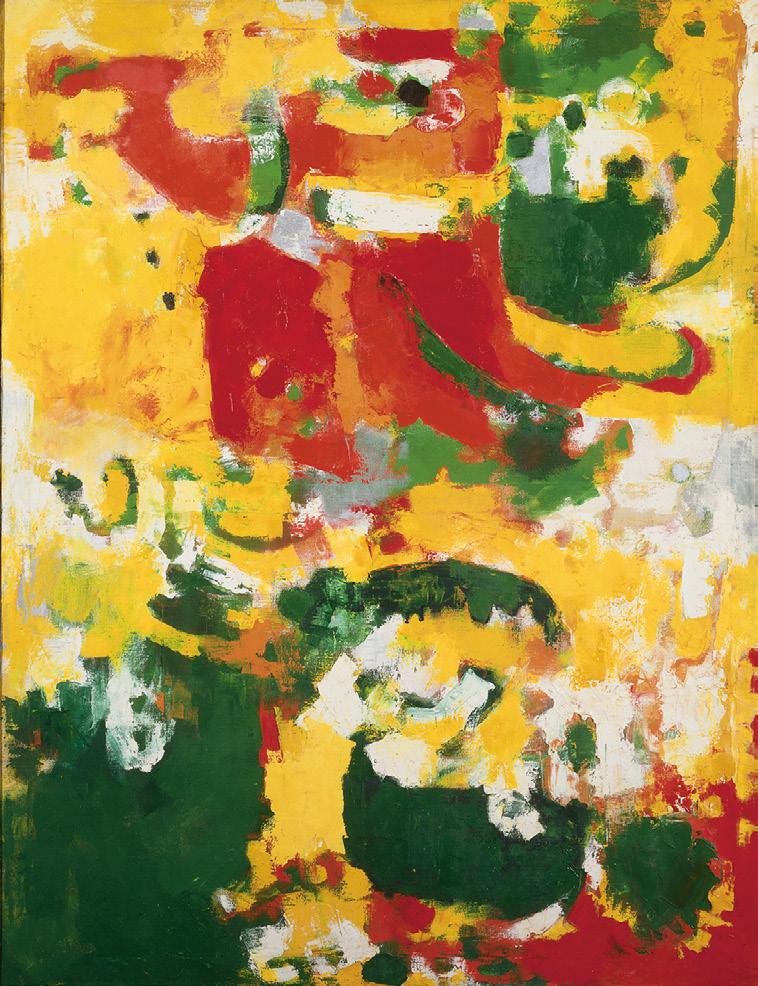
back to the function of the painting as a painting: a visual event that draws attention to the inherently abstract nature of the medium rather than a poetic cipher, ripe for interpretation.
Lobdell did make use of a more orthodox gesturalism, but given the historical circumstances, that would have been diYcult to avoid. A sturdy, exuberant brush is at work in the asymmetrical arrangements of color patches in, for example, May 1949 (Wg. 5). Just as frequently, however, Lobdell uses generous brushwork and thick color Welds to brush out, bury, eliminate, or disguise areas of prior painting activity, a tendency evident in 31 December 1948 (Wg. 6), 13 September 1949 (Wg. 7), 1 January 1949 (Wg. 8), and 30 April 1949 (Wg. 9) The strategy of removal also occurs frequently in his drawing practice during this period: a habit of packing his surfaces with an abundant spillage of imagery and then covering or partially withdrawing those that do not seem necessary to the resolution of the work—indeed, the technique continues to serve him even now. Nor was Lobdell the only artist in the Bay Area to employ it during those years. Well into the 1950s, many of Richard Diebenkorn’s abstract canvases pursue a similar method: the horizontal, earth-colored ridges and planes that suggest landscape often mask dense zones of paint activity. In Lobdell’s case, the images can be just as broadly evocative, but at the same time, their very generality follows from the artist’s desire to leave the familiar image world behind. In this sense, the dark formations in many of the paintings function much like the Xat, forbidding ink Welds in the drawings, lying across tangled bursts of linear activity. At the same time, they gaze toward the Wgural canvases of the mid-1950s, those tormented shapes developed from a severely limited palette and charged masses of brushstrokes.
But spatial relationships are a fundamental concern. The spread of dark color (in 31 December 1948 or 30 April 1949) has a striking visual eVect: the paint feels almost nondimensional, a rich-hued but unequivocal substance that lies directly upon the surface of the canvas, simultaneously deXecting and heightening our sense of the depth beneath it. It traverses a region between the representational and the nonobjective, image and pure paint, expression and a ruthless handling of materials. To some extent, these tendencies in the work may derive from Still, whose ragged compositions were intended to defeat the enclosure of the frame, which he regarded as an unwelcome tyrant: by doing away with conventional hierarchies of visual eVect, he hoped to undermine the traditional security of the rectangle, and by extension, the idea of the painting as a mode of embodied meaning. Still did not wish merely to replace order with disorder, a condition for which there could be no real justiWcation. But his paintings pose a crucial question: what, other than space, can the painting describe? For the moment, at least, this is crucial to Lobdell, though he also digresses from it to consider ideas that may have been drawn from Rothko or Corbett as he divides 27 January 1948 (Wg. 10) into elegant washes of cream, brown, and mossy green, once again with a screenlike Xatness that arrests our vision at the surface of the material. The edges along the bands of color are borders where the forms linger, or where they are trapped: the ovals with spiky teeth, like barred holes that almost (but not quite) permit a view beyond the surface of the painting. These
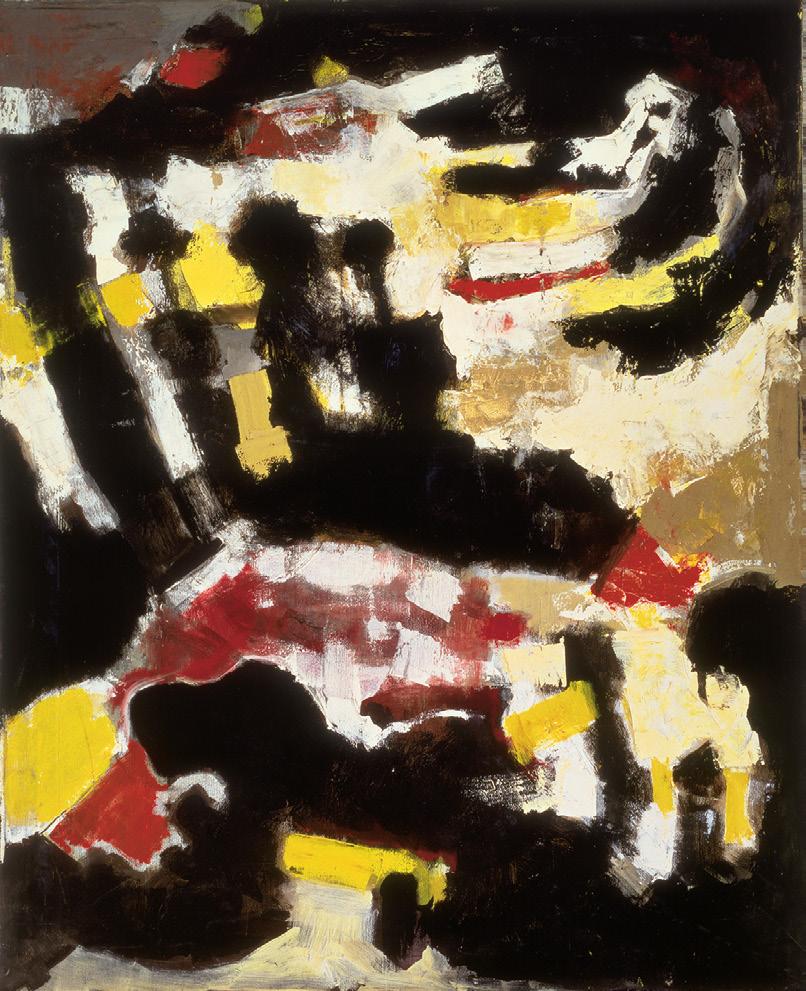



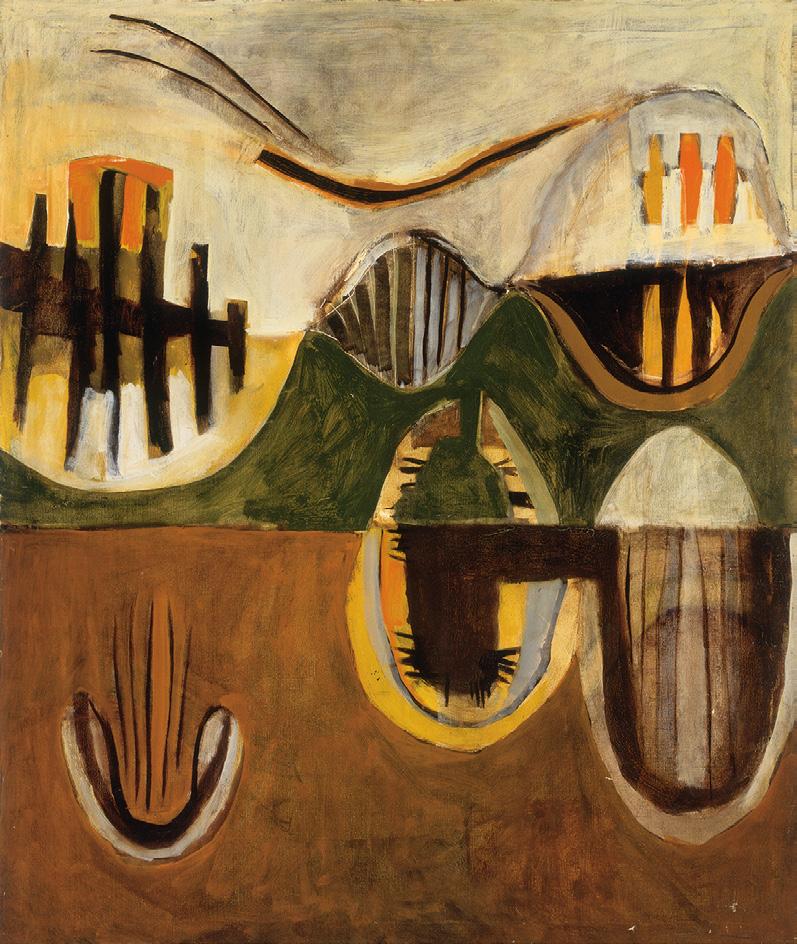

holes will continue to have considerable importance for Lobdell, and they reemerge later; yet even at this early stage, their intimation of other spaces behind the canvas is a signal that the broad, brushy paint Welds should not be regarded simply as “background.” The artist is attempting, rather, to Wnd a means of engaging a multiplicity of spatial Welds. In this instance, they beckon with the promise of a further view before bringing us to a halt with their fearsome denial of entry.
Lobdell was moving swiftly as he internalized a wide variety of the developments taking place elsewhere in progressive art. He never studied with Still, however. He had seen the work of students who bore Still’s inXuence in a direct way, and so, as an instinctive act of artistic self-protection, he decided to avoid the older artist’s classes. In any case, the golden years of the abstract expressionist experiment at CSFA were coming to a close by the decade’s end. Veterans attending the school on the G.I. Bill had exhausted their funding. Faced with a critical decline in enrollment, MacAgy, who had led the school through this exhilarating era, departed in mid-1950. Within months, Still was gone, too, having adjourned to New York.
That same year, Lobdell took what remained of his G.I. Bill money and sailed for Paris, where he enrolled at the Académie de la Grande Chaumière, although he rarely attended classes. Neither did he seek out the recent developments in European art. He spent most of his time working in a cavernous studio at the Académie Colarossi, where, in the wintertime city, American
27 January 1948
expatriates and their families camped around a single immense stove. It was also a social place, with wailing infants and people coming and going all the time. In a photograph taken in the Colarossi studio, Lobdell stands among several large canvases. One in particular virtually mirrors the composition of November 1947, but in this instance, the forms are simpliWed Stillian Welds, with ribbonlike shapes dangling around the edges of the wide vertical planes; its organization into parallel panels echoes, too, the subdivisions characteristic of Picasso’s horizontal paintings during the 1930s and early 1940s, including Guernica. Although the work in the photograph is intriguing, it speaks most clearly, perhaps, of the thoroughness with which Lobdell was working his way through ideas regarding abstract painting as he patiently pursued his quest for an authentic personal style.
“I never really emulated Still’s space,” Lobdell said, “but I think that I understood the principle behind it pretty well. It was an environment rather than a deWned space. I can remember a few paintings in that exhibition in 1947 that were just great. Very moving paintings. There was a spatial ambiguity that I saw there, which is in Rothko’s work in a diVerent way, and in Pollock’s in yet a diVerent way. There was the matter of the spatial environment that all the work shared, and which I came to see as signiWcant.”
In the end, San Francisco would be the only city other than New York to produce a signiWcant abstract expressionist group, though relatively few artists there sustained or further developed the form to the extent that artists did in New York. Yet the failure to extend the style locally may have been no more than a matter of circumstance. The region lacked a substantial continuous art tradition of its own, and the commercial opportunities available in New York even by the early 1950s did not appear in the Bay Area until the end of that decade. Since so many painters went there primarily to study, they had no deep loyalty to the city itself, and so an inevitable dispersion began in the early 1950s, creating a vacuum that was Wlled by the artists now associated with the Beat era.
At the same time, the lack of a strong regional art tradition provoked anxiety in some of the artists who did remain, which found expression in their eVorts to establish traditions of their own. This provides an explanation for the appearance of an identiWably local Wgurative painting style in the Bay Area during the 1950s, although the Wgurative movement was also a product of more encompassing conditions already in place in the region. From the beginning of the modern era, progressive developments in art were rarely embraced without question as they made their way to the West Coast. More often, they aroused a native mistrust of both European and East Coast models, and as a result, discourse among artists surrounding the “new” tended to focus on the appropriateness of assimilation, or how the “new” would, or should, become the “local.” Separatism, whether it operated as a geographical fact, a regional mythology, or simply a component of regional identity, became the platform upon which local artists interrogated the American acceptance of foreign models. For this reason, a durable regional enthusiasm for the California Style watercolorists, or for the vivid, painterly scenes associated with the Monterey and Carmel art colonies, comes as no surprise, nor can it be dismissed simply as willful provincialism.
The situation was informed, of course, by skepticism regarding the very notion of a centralized American culture. The new was often required to justify its claims upon the regional artist, and so the local embrace of abstract art during the postwar decade aYrms the extraordinary promise it held for artists at that historical moment. If an enthusiasm for abstraction did, in fact, arrive from outside the region, it was immediately contagious. A conception of the painting process as a quest for authentic individual voice held a natural appeal for artists who were not only fresh from the experience of war but who discovered that the insights of their experience opposed the mainstream values of a nation emerging as a conWdent, aZuent superpower. In this context, San Francisco never really required a distinctly surrealist period, nor did artists there feel a need to turn to archetypal or tribal imagery in order to evoke a “collective” or “essentialized” culture. That work had already been done elsewhere, by others. If the quest for a “primal” self was an ambition, that self operated in a contemporary, postwar world and needed to be addressed in a contemporary setting.
As an artist, Lobdell at the turn of the decade is inseparable from these conditions. In the same way that he intuitively avoided close study with Still, he was now drawn to the isolation and relatively placid pace of the Bay Area as a setting in which to continue his work. Another year had passed, and his stay in Paris came to a close. He returned to San Francisco in 1951, supporting himself with various part-time jobs. His Wrst studio was at 645 Chestnut Street; he next set up a studio in the AudiVred Building, a handsome nineteenth-century structure along the Embarcadero. Ernest Briggs and Jack JeVerson, with whom Lobdell would enjoy close collegial relationships, were two other artists in the building, but much of the old crowd was gone. They were on their own.
The thousands of drawings that Lobdell has produced during his career are essential to an understanding of his work, but in these Wrst decades, they rarely follow an obvious course, or an easy one. Unlike the drawings after the late 1970s, which are largely committed to speciWc paintings, images, and compositional ideas, the early drawings take on a quality of sprawl as they sift through swarms of ideas, and yet they will almost always suggest the presence of an underlying discipline or concentration, as if any image, however far-ranging, is still tethered to a central purpose. They map a terrain, though not necessarily a clear path through it. Formal overlaps exist among the early paintings and drawings, certainly—the surging masses, the solitary and sometimes fragmented Wgures, the melancholy, faintly gothic romanticism—but a clear sense of correspondence is absent, at least until the early 1960s. The numerous digressions and anomalies—the quirky Wgures, the oblique references to mythology, the visual ideas that recollect a distinctly European surrealism—would appear to have only slight bearing on Lobdell’s primary imagery, but regardless of their speciWc associations for the artist, they can be seen as the declaration of his desire for the freedom to pursue his own needs and interests, one from which he could not turn, and one that would liberate him from the dogmas of representation and abstraction still in force in the Bay Area at that time. If the paintings, especially after the early 1950s, adhere to a Wgural expressionism that developed from Lobdell’s experiences
among the San Francisco abstract expressionist group, his drawings, which he had already come to regard as a tool of research and self-investigation, demonstrate a much wider range of interests, and they reveal the care and patience with which he pursued them.
The crucial element in the drawing practice, which soon spilled into the paintings, is a quality that Lobdell simply calls the hand. Almost everything he has done in his art, it seems, is related to the hand’s development and maintenance. The inferences embodied in the term are obvious, and yet the idea of ‘hand’ quickly spreads to an array of references and meanings, all of which are integrated into the practice itself. In the most straightforward sense, the hand holds the mark-making tool and commits the marks: it represents the literal, physical component of drawing, the actual movement of the pen or pencil across the surface of the paper. An individuality of gesture is intrinsic, of course, and so the drawings, well into the 1950s, may be seen as a quest for an idiosyncratic mark—that is, the gradual distillation of what is wholly the artist’s own from amid the array of marks and gestures he is capable of making but which arrived from sources or inXuences that seem to him inessential, extraneous, or imposed. The matter of inXuence is tricky, as Lobdell recognized early on, and at some point, distinctions can become very Wne. But abstract expressionism, as he encountered it after the war, oVered a solution.
For Lobdell, the performative aspects of the style were appealing, certainly, but problematic. For him, painting and drawing could not be sustained by the self—the self was not supreme or even primary, nor could it be separated from the world at large—and so art had to be about something else, too, or something more, in a way that acknowledged the inextricable bonds of self and other. An additional reWning discipline was necessary, and he found it in surrealist automatism, the one aspect of the surrealist program that had survived the passage to the Bay Area more or less intact.
Like the artists around him, Lobdell had no particular interest in the doctrinaire aspects of surrealism or its loyalties to certain modes of imagery, but automatism, as a means of wedding the hand to the subconscious, oVered a method of sorting through the mark-making process, particularly within the swift, improvisational arena of the drawing. The hand could be made into a sensitive medium between the subconscious and its sense of the world, or a mediator between them, and it soon became the basis of Lobdell’s drawing process. From this perspective, his work can be regarded as a kind of pragmatic, empirical, customized, perhaps distinctly American surrealism, focused on the revelation of process, not on image as an exemplary product.
By the late 1940s, the hand had become fundamental to Lobdell’s drawing practice, and he let it roam. Those early sheets are often packed with imagery. In one ink drawing from 1949 (Wg. 11), squarish forms are arranged into planes of decreasing size and then Wlled with tight crosshatching that transforms them into networks of individuated, and activated, spaces. In another drawing of the same year (Wg. 12), Lobdell uses crosshatching to build a mass of dangling forms; on one side, the crosshatching dissolves into a column of horizontal lines that recalls the shading of George Herriman’s Krazy Kat, a Depressionera cartoon strip that Lobdell followed avidly as a youth. But he uses ink washes


to close oV large areas of the drawing, as well, so that linear forms seem to slip in an almost clandestine way from beneath the edges of the dark Welds, though other forms may also be detected, obscure beneath the ink. Every detail that survives the artist’s ruthlessly reductive procedure heralds its signiWcance. In 5 Oct 49 (Wg. 13), an ink drawing, a Wgure almost emerges; we sense the presence of arms, legs, breasts. A few drawings are openly surrealist. In many of the early drawings, the ink Xows as if alive, determined to avoid static rendering. Forms may be biomorphic or vaguely Wgural, but they are never really depictive. Lobdell is not drawing pictures, he is drawing to see what will appear. There are Wgures within Wgures, faces, winglike shapes, but his imagery resists analysis; it is more readily felt than described or explained, as if wordless response is the true domain of visual art, situated outside the persistent grasp of language and its ceaseless explications. Compositionally, the imagery often seems to be climbing up the sheet, as if from a space that remains out of sight, beyond the reach of the rational, language-ridden mind— the mind that will neglect no opportunity to exert its will upon the eye.

Once he began probing the mark in this way, Lobdell recognized that a cultivated self-forgetting in the mark-making process would reveal innate tendencies of formal structuring and organization that were as intrinsic as the mark itself. This in turn oVered the possibility of building a total image that could operate within the conWnes of the rectangle and yet remain reasonably free of the directives of external inXuence. It was a discovery that would eventually lead him away from the symbol, a carrier of cultural meaning, to the sign, a form or image that emerges from the unconscious without the need to adhere to preconceived thematic demands. The distinction reXects surrealism’s devotion to the intuitive as the source of an elevated understanding of reality, one that readily manifests itself in visual forms.
By the early 1950s, Lobdell had also revealed a preoccupation with connecting his forms—the kinds of linkages that keep the eye roving over the surface of the sheet—and with decisive, often dramatic tonal contrasts that treat light as both a source of illumination and a coexistent space. The inXuence of Picasso is still there, with its emphasis on the reinvention of familiar motifs
13. Untitled, 5 Oct 49
and the isolation of particular elements within the image, but in the drawings of this period as in the paintings, Lobdell has begun to regard the image in terms of space, which is to some extent a consequence of his encounter with the paintings of ClyVord Still. For Lobdell, however, space alone would never be a fully suYcient subject, either, not even the kinds of turbulent spaces that Still laid down in slabs across big sheets of canvas. But automatism supports him in his sense of the signiWcance of space by making it a medium or carrier of form. One does not develop without the other.
Frank Lobdell’s emergence into a truly personal style was attended by the unequivocal appearance of the Wgure in his work. The Wgure had never disappeared entirely from abstract expressionist practice, despite its emphasis upon nonrepresentational imagery. It occurs in de Kooning, of course, and Wgural references can be discerned in Pollock as initiating motifs beneath the drizzle of paint; the importance of the self in abstract expressionist painting seems to have insisted from time to time that the artist admit some correspondence with the human form into the image. But Lobdell’s Wgure stands well apart from the emergence of a Wgurative painting movement in the Bay Area during the 1950s, as it occurred in the work of David Park, Elmer BischoV, Diebenkorn, and others. While Lobdell (at least during this period) and Park both rely upon the individual memory as a source of imagery, Lobdell had little interest in ideological distinctions between representational and nonrepresentational art, nor did he share Park’s ambition to create a vernacular expressionism from the advances of the abstract painters. Their goals were very diVerent, and for Lobdell, the least innocent of artists, the infusion of memory in his imagery would assume neither the aYnity for the scenery of everyday life that typiWed much of Park’s work after 1949, nor the aura of nostalgia that entered Park’s painting at mid-decade and, indeed, touched most of the artists associated with Bay Area Wguration during the 1950s. In Lobdell, memory goes far beyond what is recollected with an aVection that grants signiWcance to the past, to the penetration of a subconscious that had been shaped—or misshaped—by the stress of extreme experience, and for him that experience was World War II. Lobdell had witnessed the German retreat across Europe and the senseless, vindictive destruction left in the wake of a defeated army: towns viciously razed, the burning and killing, the sheer savagery of human rage. Abstract expressionist painting had responded quite well to certain of his needs, but how much, exactly, could be demonstrated on the canvas? How far could the artist go? Would he encounter limits, after all? Lobdell recognized that the irrationality of extreme violence could never be explained in a rational way, but his work during the 1950s suggests the extent to which he wished to tear himself loose from the eVects of these experiences, to literally wrench them from the place where they had lodged within his being. These paintings are marked by an acute and persistent awareness of death—an anxious, mordant presence that has never disappeared entirely from his work—and so the solitary Wgure that appeared in those years, cut oV from the world, and from any safety or reassurance the world could conceivably provide, may well be the artist himself. Although Lobdell
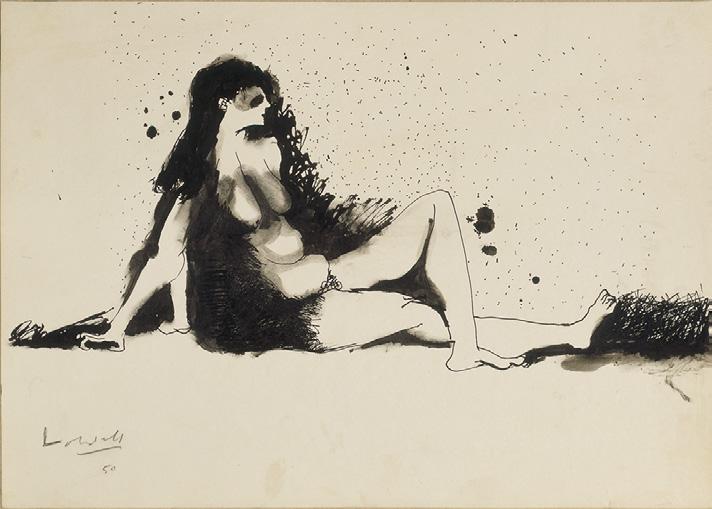
was confronting the eVects rather than the acts of war, the paintings themselves suggest that one is ultimately indistinguishable from the other. Any interrogation of violence is a probe of the aftermath. The act itself remains forever inexplicable, beyond the reach of aesthetic description.
March 1954 (2) (Wg. 15), whose motif, a grotesque, truncated Wgure that appears to linger in distraught balance before toppling into a void, belongs to a sequence of six or seven related paintings from this period, and it is an apt example of Lobdell’s passage away from more orthodox forms of abstraction. The painting holds two decisively diVerent spaces: one, a pale, Xat zone comprising most of the canvas, contains the Wgure; the other is a much smaller patch of tarry black that seems to pour from the upper corner, as it begins to engulf the tilted form that struggles against it. The spaces function, and indeed exist, only in relation to each other; their precise location is unclear, as is the identity of the Wgure itself. These ambiguities act to direct attention to the struggle between the Wgure and the space around it, the harrowing moment of precarious, unstable balance, the surrender of control—a moment that, in fact, goes on forever within the Wxity of the image. At the same time, both the reduced palette and the use of heavy line to render the upward thrust of the form recall Guernica. Picasso’s decision to work in black and white was undoubtedly pragmatic—a simpliWcation necessitated by the organizational
14. Untitled, 1950


requirements of a large, densely populated image—but its austerity supported the moral seriousness of the content as well, and this probably is Lobdell’s intention. The absence of other colors in March 1954 (2) suggests an absence of equivocation and a rejection of the implications of either moral nuance or moral relativity.
Though color had been prominent in Lobdell’s previous work and would be again in the decades ahead, in this painting, he seems to want to step away from it to investigate the thematic leverage of the limited palette, and here, less color does, indeed, generate substantial psychological resonance. Even though one can imagine these paintings in a wider palette, their simplicity enhances the elemental nature of a bleak and apparently futile struggle. With its arms lifted in alarm or self-defense, or both, the Wgure reiterates the beseeching form on the right side of Picasso’s painting, which is a reference to the white-clad man who is about to be executed in Goya’s Madrid: 3rd of May, 1808 (1814, Wg. 16). All three evoke the CruciWxion.
The matrix of reference is no coincidence. For Lobdell, the absence of a strong art tradition in the Bay Area was fortuitous. It became a challenge, undertaken as a matter of choice, to which he responded by constructing a personal foundation of inXuence as a substitute for tradition, one intended to support and sustain his particular needs. He wanted only to be himself, as
opposite
15. March 1954 (2)
above
16. Francisco de Goya y Lucientes, El 3 de mayo de 1808 en Madrid: Los fusilamientos en la Montaña del Príncipe Pío (Madrid: 3rd of May, 1808), 1814. Museo del Prado, Madrid.


fully and as completely as possible, and he felt free to avail himself of all of art history. If Guernica oVered one example of how the modern artist might bear witness to the consequences of mechanized warfare, a distinctly twentiethcentury form of atrocity, Goya represented yet another. Goya had constructed a memorable body of imagery related to the Napoleonic Wars, which swept down the Iberian Peninsula during the early nineteenth century, and he may have witnessed at Wrst hand the accumulated dead, the hanging, dismemberment, and rape, and the retaliations by the military against the citizenry that would provide the imagery for the eighty-two etchings that comprise The Disasters of War. As in the Caprichos that preceded them, Goya was extending conventions of satire that came to him from William Hogarth and Thomas Rowlandson, and which would continue in the bitter political cartoons of Honoré Daumier—but this is the stuV of art history. Goya’s images are unforgettable, and truly his own.
18. Francisco de Goya y Lucientes, Grande hazaña! Con muertos! (Great deeds—against the dead!), plate 39 of Los desastres de la guerra (The disasters of war), c. 1812–15. Museo del Prado, Madrid.
For The Disasters of War (Wgs. 17–18), he developed a pictorial logic particular to his subject matter, one capable of investing it with an unrestricted emotional force. In these works, location is rarely, if ever, speciWc; space, even ‘up’ and ‘down,’ can be confusing. At the same time, the grotesqueries go beyond caricature. The distorted, disWgured human body is no longer a source of satire or amusement, as it had been in Hogarth and Rowlandson, but carries the weight of the artist’s humiliation, horror, and disgust: as the undigniWed, brutish emblem of modern existence, Goya’s Wgure simply turns away from the idealized form of the Western art tradition, an act that grants tremendous moral weight to the images themselves. Lobdell, who had set himself to a similar task, recognized a kindred spirit and was responsive to the originality of Goya’s achievement.


The imagery of the Disasters sweeps past the mere strangeness of the Caprichos (Wgs. 19–20) and their depictions of nightmare, hallucination, and human compulsion, for the artist is now concerned with the appearance as well as the force of evil, which spreads like a contagion during wartime. By isolating incidents and placing them on a landscape without clear points of identiWcation or context, Goya extricates them from the normal coordinates of rationality. Quite often, the space in which these events occur is a void in which conventional morality does not even exist; its participants are only the pernicious agents of a reXexive brutality. One might also think of Kurtz and his murmured witness to the horror of human barbarism in Joseph Conrad’s Heart of Darkness almost a century later. Goya had already been there, and had found a way of sharing the experience in a visual language that neither trivialized nor sentimentalized its extremity. Yet the overall eVect of the series is never quite deWnitive. Over the course of dozens of images, Goya vacillates between a piercingly felt moral outrage and despair that the modern world is, indeed, a nightmare. The gap between these responses can be narrow and subject to Wne gradations.
The events of the subsequent century and a half would neither alleviate the misery of human violence nor sustain the promise of a better future, and so Lobdell, the late-twentieth-century artist, is impatient with subtle modulations of hope and hopelessness. An unyielding morality is the backbone of his art, and as his recollections of war collided with the surreal ethos

of the Cold War and the politics of fear practiced by opportunistic witchhunters in the American government, the embattled spirit became his informing motif. War, which bares the brutish instincts beneath the pretty skin of “civilization,” is as emblematic of the modern era as it is of any previous period in human history. Like paint on a canvas, society is a thin Wlm; the circles on the paintings, all bars and razorlike teeth, portholes choked with threat, are the ruptures through which the truth of life might be glimpsed. Lobdell wishes to know just how much can be borne by the painting, and by selecting Goya and Picasso as his ancestors, he aYrms the relevance of the Wgure to the task. At the same time, their work suggested ways of extending the human form beyond the overtly symbolic and the literary to create an imagery of visceral impact.
This goal is evident in both December, 1955 (Wg. 21) and November 1957 (Gray II; Wg. 22). In the Wrst, a taut cruciform Wgure ascends toward a womblike circular shape. The circle, with its hazy surrounding ring, seems just within the Wgure’s reach, but of course it is not. Indeed, the Wgure may not be

ascending at all—it could just as easily be hovering, falling, or even orbiting— while the space surrounding it is an environment made of paint put down in rash, urgent currents of brushstrokes. Like many of Lobdell’s paintings of this period, December, 1955 is constructed with a simple diagonal composition whose thrust directs the eye toward the gulf between the Wgure and the circular form—a crease in space where the diagonal movement wavers, subtly separating foreground and background. In November 1957 (Gray II), a striking asymmetrical composition that places both Wgure and circle on the right side of the canvas—in this instance, the Wgure is formally echoed within the darkness of the circle—the space feels quite large, a turbulent rush of colliding currents. In his use of the circle as an opening, or perhaps as an entirely diVerent

space, Lobdell glances back to 27 January 1948; the circle will linger in the artist’s imagery for decades to come, operating in much the same way.
These are sturdy, straightforward compositions. With their chilly light and their evocation of space as vast, inhospitable, inscrutable, they have a wintry atmosphere that reXects a decidedly American taste for the mythic and archetypal; one can hardly imagine a European surrealist being so unequivocal. Though Lobdell reiterated this format on paper, introducing media such as gouache and casein to control his grays and give the drawings a more painterly appearance, many of the drawings of this period are even more thorough in their exploration of the gothic, nightmarish aspects of the paintings.
As much as Lobdell is concerned with the expression of dark personal truths, the problem of signage and meaning remains present for him, and so he is greatly concerned with the diYculty of organizing meaning in ways that are not wholly dependent upon familiar modes of symbolic representation. Like Goya, he seeks his own logic of depiction, and this keeps him from accepting without question the unspoken cultural accord that supports the application of the symbolic. The image must be readable and make a kind of sense, but it must be his. In essence, he declares himself: what I have seen with my own eyes tells me that the old symbols are insuYcient, that no such certainties exist, that the great myths of the culture serve a view of the human condition that I cannot share. The critic Thomas Albright noted that Lobdell’s work of this period suggests Miró dragged back from the Stone Age, an observation that speaks to the stormy, melancholy wildness of these paintings, even if it does not quite give full credit to their realization of the artist’s desperation and horror, nor the depth of the horror itself.
So it is that the ooze of black paint in March 1954 (2), intruding upon the upper right corner of the canvas like runoV from a toxic spill, joins Lobdell to a tradition of black painting that would include Goya, Rembrandt, Manet, Motherwell, Still, and such early American visionaries as Albert Pinkham Ryder and Martin Johnson Heade. Again, the network of reference is deliberate. The appearance of darkness in art is rarely just a state of diminished light, as if someone has blown out the candles or pulled a blind, and so it oVers an open zone that is never entirely governed by symbolic function. At the same time, black is a diYcult color for artist and viewer alike; its visual gravity naturally draws the eye from other areas of the painting, and Lobdell’s interest in harnessing these eVects goes back to the 1940s.

In January 13, 1955 (Wg. 23), his handling of the color is fairly abstract. Concentric rings of black and white lead to a dark central circle whose tattered edges recall an open maw. Its evocation of a mindless will to devour reveals the extent to which Lobdell has already internalized Goya’s imagery— think of the dark, grotesque mouth of Saturn Devouring His Son (Wg. 24), one of the murals painted by the artist between 1820 and 1823 on the walls of his home at Quinta del Sordo. But elsewhere among Lobdell’s paintings of this period, the absence of light is nocturnal: for these Wgures, the passage through darkness is a night journey. Or black may suggest a mood, an atmosphere, the cold, impersonal breath of mortality: nothing encroaches upon human endeavor like darkness, or so exposes its frailty. Or it relates to the opposite
23. January 13, 1955 above
24.



impulse, already apparent in the work of the 1940s, to brush out, blot, cover, or eliminate earlier imagery, a picture-building technique that can function as an act of repression, or as a gesture of negation, like closing the door on a roomful of monsters. The circle oVers a light from “behind” the darkness, a space toward which the Wgure reaches with the blind will of instinct.
In drawings from these years, the Wgural forms are often distorted or ogrelike; they seem to have escaped from nightmares (Wgs. 25–27). Black ink runs in channels around them, and as form and space connect, the Xow carries the eye across the picture, keeping it from focusing on form alone. Form does not exist without space, and space will neither isolate nor release it. We face a whole Weld, shaped by a hand that participates in the totality of mark-making. Everything happens on the surface of the paper, and everything that exists on the paper must be placed there. The mark is always engaged in a complex simultaneity of concerns. These drawings may hold a dazzling amount of detail, although Lobdell is always prepared to hide or eliminate aspects of these activities, no matter how much has been invested in them: he applies his ink washes, and the pictures can become very black in the course of the selection process. In the gouache drawings, which often involve extensive scratching and inscribing, there is a greater concern with a ‘tangible’ space. The brush wants to treat space not as a total, Weldlike atmosphere but as something literally built from Xuid, interlocked components. This eVect is even more pronounced on those occasions when Lobdell employs an exaggerated horizontal format, in which Wgures appear to be buoyed along as if awash in the space around them. During this period, however, the most spectacular example of Lobdell’s handling of the color occurs in April 1957 (Wg. 28), a predominantly black painting of human scale. In his testing of the capacity of the canvas to bear the burden of painful emotions, he does not always tread lightly over the


territory between sign and symbol: one pushes at the other, and sometimes they push hard, but in April 1957 they achieve a conXuence of sorts. Here, the ascending Wgure is the container of egg-shaped forms that Lobdell was utilizing as early as 13 September 1949 (Wg. 7), and which would become a staple of his imagery at the end of the 1950s. The Wgure itself might be a spiritual emanation, or a semi-abstraction, or the haunting image of an intruder into the artist’s dreams, or a kind of apotheosis of the ghostly Wgures of the previous paintings. The inverted arc crossing the upper portion of the painting recalls the outstretched arms of earlier Wgures, and there is the hint of a head—and a halo—at the point where these arms meet. In its broadly rendered outline, the form recollects the crude weapons in Goya’s Duel with Cudgels from among the Quinta del Sordo murals (Wg. 29), though the identiWcation of referents is little more than an art-critical game, one that demonstrates the extent to which the image asks for explication and then denies eVorts to construct a summary explanation. The form emerges from an apparently endless black Weld, the same darkness into which it must Wnally withdraw.
Because parts of the Wgure itself are depicted in the thickened hue of the areas around it, distinctions between Wgure and ground are never entirely clear. Perhaps they do not even exist—the Wgure is indistinguishable from its surroundings and vice versa—a merging of form and space—a space that is opposite 28. April 1957
either all void or all surface—as if the fundamental condition of the human spirit truly is inseparable from conditions governing the entire universe. Painting in the twentieth century has been much occupied with disrupting the Wgure/ground relationship, but in Lobdell, the impulse assumes a certain moral tone. Meanwhile, the few scant sources of illumination are thrown into dramatic relief by the surrounding darkness, as if light has been squeezed through cracks between the brushstrokes, and so the thin band of gold and white around the Wgure’s head takes on the otherworldly glow of a tremulous, ambivalent sanctity. Symbolically, of course, light is most often interpreted as spirit—an ineVable divinity—or reason, both of which may be invoked to disperse the darkness of savagery and irrationality. To deny light, or to replace it with darkness, particularly the airless, impenetrable blackness of April 1957, is to suggest the loss, or even a complete absence, of divinity and reason.
At this point, Goya provides another point of comparison, for the Disasters are full of blacks and deep grays. In eVect, Goya leeches light from his scenes, and the grays, which appear to be surrendering light to darkness rather than the reverse, subvert conventional symbolic meanings; this is the light of nightmare and madness. But because Goya’s light will not accept its traditional evocative function, it obstructs interpretation, and so the absence of light has the paradoxical eVect of illuminating the depravity that governs the scenes themselves. This is the territory of Heart of Darkness, as well, where civilization (light) is no more than a rickety barricade against moral catastrophe. Without its reproving presence, human enterprise would soon descend into the bestiality that is its essence. These ideas had resonance for Lobdell, who gazed through the cynical posturing of Cold War politics to the fear and the ferocity of violence beneath it. His own august morality forced him to look and kept him from turning away.
The nearly wholehearted embrace of blackness in April 1957 imbues the work with a primitive power—a kind of black magic—an abandonment to feelings that are more often suppressed than exposed so nakedly. In yet another echo of Goya and Conrad, this work rejects the belief that human civilization, to which the life and well-being of art are inextricably bound, originated in innocence, or in any kind of Eden, for that matter. If we imagine that the outspread arms of the Wgure are meant to evoke either the Christian cross or a benedictory gesture, we should think again. There is little hope to be found here. Lobdell has created a faceless genie, a gargoyle for his own time.
The upraised arms are as close as he will ever get to traditional symbolism. Goya actually used it with some frequency—it appears in The Madhouse (1793–94), The Deluge (1793–94), and The Miracle of Saint Anthony of Padua (1798), and is echoed formally in the prominent horns of The Witches’ Sabbath (1820–23, Wg. 30). But Goya may only have been recalling the long-suVering saints and sinners of Northern Renaissance painting, who made their appeals to a God who seems not to have been listening. That silent, withdrawn deity, steadfast in its refusal to illuminate itself, may be an aspect of Lobdell’s burden in April 1957, and if that is so, then the feeble light outlining the Wgure, as an intimation of divinity, is very faint, indeed. With April 1957, Lobdell pushes beyond the unmodiWed romanticism that has so far been prominent in

his Wgurative work, to an image whose dark ambiguity speaks of impulses that can never be truly articulated, certainly not by the resources of language, no more than they can be cleansed from human behavior.
April 1957 is emblematic of Lobdell’s mature engagement with the abstract expressionist legacy, and he would continue to utilize its stylistic means well into the 1960s. In some instances, he returned to a vivid, confrontational palette: the dense yellow of Black Edge III 23 March 1962, or the bloody, thickened red of 3 October 1962, another of the artist’s climbing, ascending Wgures. In 3 October 1962 (Wg. 31), the creeping spread of black space appears in the lower left corner of the canvas, pushing the composition from below, while the Wgure, mounted at the top of a meandering path—a gauntlet, really—and framed against a portal of molten color, recalls the cruciWxions of previous works. For Lobdell, this form also refers in a general way to an image from a fairy tale, the Wgure who peels back the Xesh of her abdomen to reveal the dark visage of the spirit within, an opening that may be seen, too, as a revelation of another space, one oVering escape from the ghastly, seething inferno below. Other images also reoccur regularly during this time: the saclike form, for instance, stuVed with round forms and suggestive of some swollen matriarch preparing to spawn yet more of these nightmarish creatures, returns in Black Edge III 23 March 1962 (Wg. 32), its basis in the Wgure made explicit by its tucked feet, a Wgure that may be sleeping, hibernating, or gestating; there is a hint of the black corner from December, 1955 encroaching from outside the canvas. These pictorial issues are thoroughly worked out in the drawings, and by 1958, Lobdell had begun to move beyond the relatively simple, juxtaposed spaces and the narrative imagery of December, 1955 to enigmatic images in which a multiplicity of dark spaces encroach upon the light, spaces populated by an expanding variety of Wgural forms.
Yet even as the decade waned, Lobdell was still grappling with the insuYciency of the symbolic: he knows the habits of the literate eye, which “reads” in a proscribed manner, as it has been trained, and as a result it may overlook the artist’s other concerns. This is a serious problem for Lobdell, and one of his
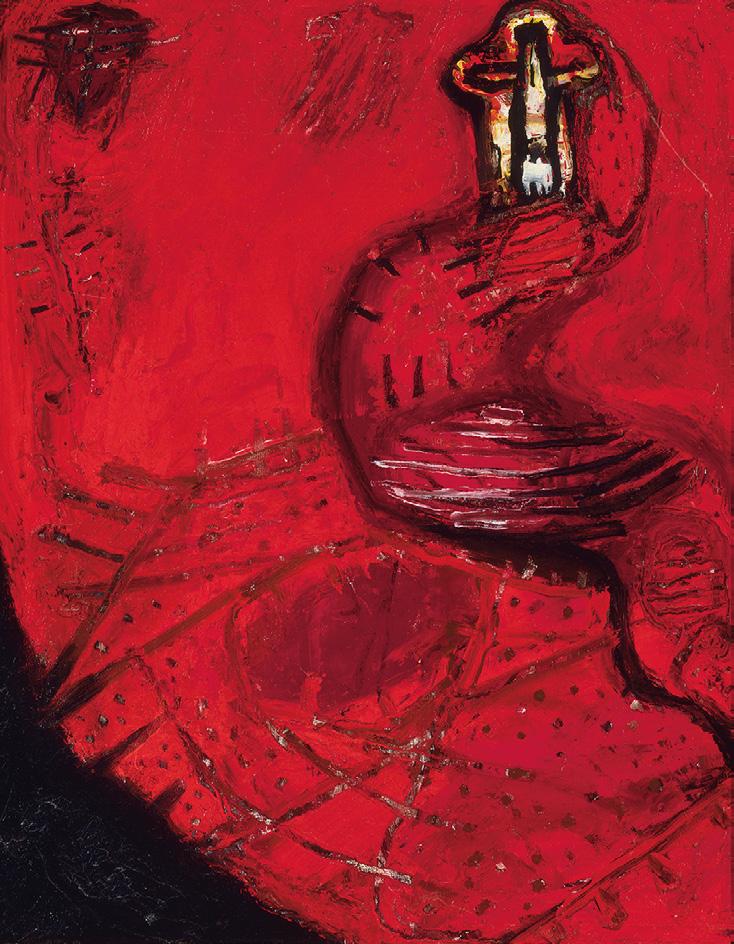


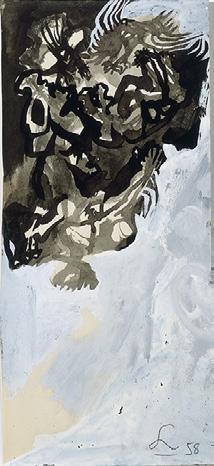

solutions lies in his tendency to maintain a continuous process from painting to painting, embodied in both the imagery and the characteristic marks of the hand—a practice in which no single image can ever be discrete or deWnitive. Each painting merges with its predecessors as well as its successors, one much like another, an elaboration upon the artist’s themes. His mark is sturdy and utilitarian, as if he means to replace gesture, the great signiWer of abstract expressionist painting, with motif, the sign whose inconclusive qualities are enhanced rather than relieved by its passage from painting to painting.
By now, of course, the work has become increasingly identiWable as Lobdell’s. This was inevitable, but from the artist’s point of view, hazardous. Style has its pitfalls, and for him, the mark must somehow become more than signature. He does not want his painted spaces to become quagmires. Thus the paintings, with the large drawing practice behind them, continue to probe the emergence of the mark from within the artist himself. This also deWnes his relationship to surrealism. Where does the mark originate, and what inXuences exert themselves upon it? To go another step, what aspects of the mark are broadly human, based in an archaic consciousness of the physical world, and what are his alone? And what, Wnally, are its purposes beyond the functional tasks of communication? Can it do more than it has done already? By allowing the mark to regenerate from painting to painting as the very basis of organization, Lobdell grants it a life of its own—a life that he attempts to bring forward, on its own terms—with the hopes that the process of regeneration will lead to insights into how, exactly, the imagination organizes meaning around the sign.
There is risk, of course. The process is inextricable from the aesthetic reordering of experience, a mediating condition that Lobdell had struggled to avoid since the late 1940s. The anxiety that can be detected in much of the work of this period arises to some extent from the artist’s fear that his signs may evolve into symbols. Or that they might come to assume a strictly autographic function, channeling attention away from the conditions of their production. Or that his exploration may prove fruitless in the end, an exercise that yields little.
As the 1950s came to a close and the new decade began, these concerns exert themselves in the drawings, as well, and one senses that Lobdell discovers some of his answers there. The circles and networks of light that occur in the ink drawings from these years reveal a steadily developing awareness of the kinds of spatial divisions that are possible in the image, reXecting his ambition to make the Xat surface hold a number of spatial events simultaneously. These lessons are then transferred to the mixed-media drawings, where the illuminated circle becomes increasingly eVective at conveying the artist’s goal that his Welds be seen as active and spatial. By establishing junctures between his spaces, Lobdell creates an atmosphere of visual ambiguity that pulls the eye into the complex terrain of the image and at the same time attempts to extend the space of the drawing outward, toward the eye. This is a problem for the hand, which must discover the means to persuasively express complex pictorial ideas. As one instance of a technique that assists in accomplishing this, Lobdell begins to bundle his marks, building them into

Summer Mural 1961
37. Untitled drawing for Summer Mural 1961 below
38. Untitled drawing for Summer Mural 1961
dense, agitated clusters: these clusters may become channels across the images, or they may be used to develop individual spatial Welds, but either way, they are granted both an animation and a mobility, as well as a dimensionality that diVers from modeling.
This period in Lobdell’s drawings reaches a kind of summation in the pencil and crayon drawings that were made in conjunction with the wall-sized painting that came to be known as Summer Mural 1961 (Wg. 36). The drawings were not done for the painting, at least not as preparatory studies, but a commonality of interests is evident, and ideas given extensive treatment in the drawings seep onto the canvas. Many of the drawings evoke an environment of Xowing masses, and the careful integration of form, space, and mass is apparent in the way in which hints of objects appear among the accumulated marks: bones, organic and plant shapes, land formations—an archeology subsumed in the movement of coagulated lines. But Lobdell avoids too much speciWcity. He still does not cross readily or without caution a certain line in the depictive status of the image. The gradual mastery of spatial depiction is evident in the crayon drawings from this series, in which the waxy black lines, compressed within the narrow horizontal format of the drawing sheets, exert considerable pressure on the literal boundary of the plane. At the same time, tiny fragments of color or unmarked paper glint like jewels from within an encasement of darkness.



These drawings can be characterized by a growing conWdence in the manipulation of diVerent kinds of contrast, a technique that will be of increasing importance to Lobdell in both drawings and paintings. More and more, he is thinking in terms of movement and countermovement, shifts in shape and scale, a willingness to let forms run together, contrasts in color and tone— contrast as a way of dramatizing the image, of pushing forward what seems most important. Using a pen, ink washes, pencil, and gouache, he organizes his contrasts in line, tone, and mass in order to exploit spatial depiction as a primary mode of dramatization. He is forcing space to behave in complex ways, often with an eccentric or radically asymmetrical organization that directs attention to the existence of additional spaces that aVect the picture but are beyond its borders. In this way, he is able to achieve strong visual eVects on relatively small sheets of paper. But a gothic sensibility continues to exert itself in the primordial Xow of dark, ripe lines, and so the path into the future would lie in modulating the terms of the drama in more subtle ways, with greater variety, and to more complex eVect.

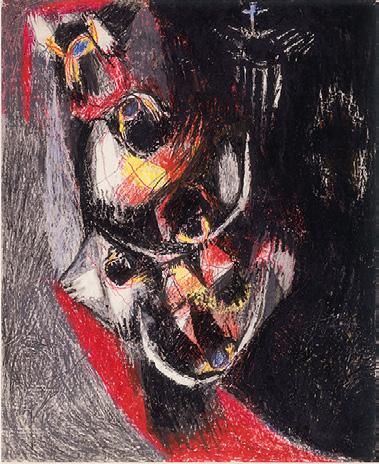
A distinguishing characteristic of Lobdell’s work during this period, and indeed through the late 1970s, is its brusqueness of technique. This indicates neither an indiVerence to Wnish nor a desire to proclaim the authenticity of the work with a rough expressivity; it represents, rather, a need to reject the sensual appeal of reWned technique, as if that, too, might be read as symbolic—that is, as an eVort to create a self-contained object that freely extends its thematic essence to the viewer—or as a token of indulgence. No hard answers are to be found here, and Lobdell resists the temptation to traYc in insights and artistic truths. The unpolished surface has precedents in (among others) Cézanne and Picasso, for whom the idea in the work and the process of visual resolution were of greater importance than the work as an aesthetic product. Similar aYnities may be found among other abstract expressionist artists, particularly in the Bay Area, where raw paint handling became an accepted signiWer of spontaneity and emotion. Lodbell had studied Cézanne at length, but in his own work, these characteristics also drew support from ClyVord Still, who had made a virtue of blunt paint application.
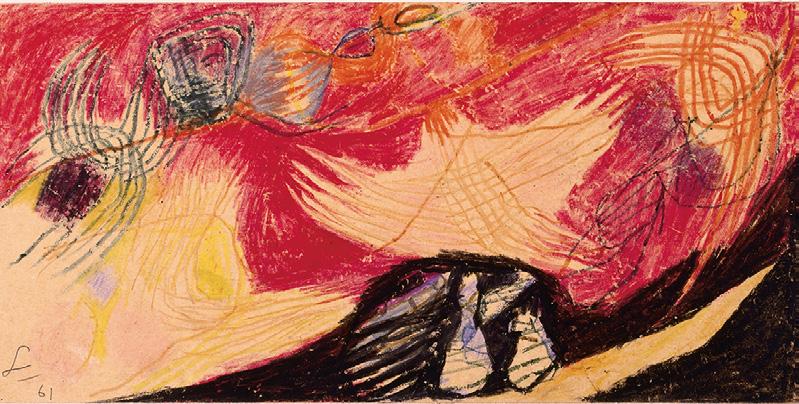

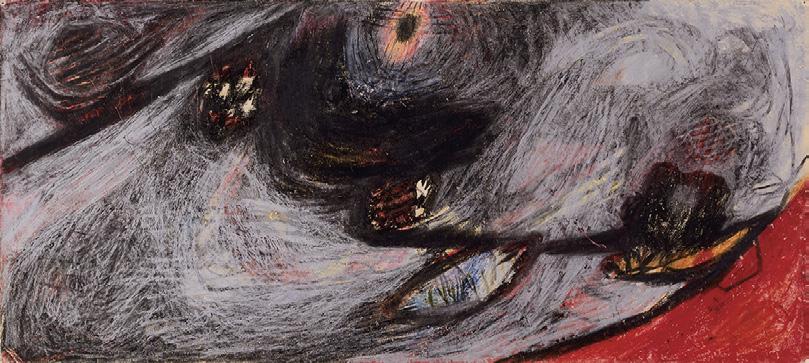
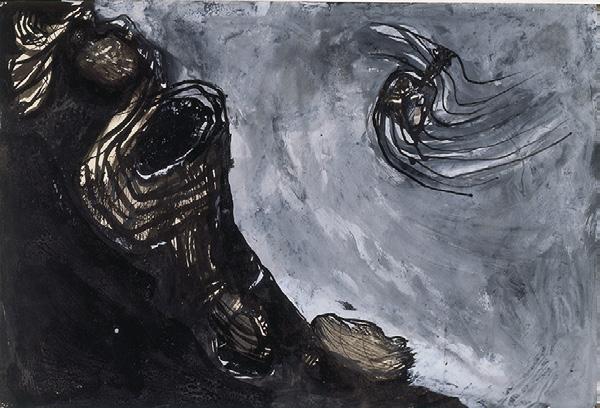

Instances of painterly elegance can be found among Lobdell’s canvases of the 1940s, but during the years following his encounter with Still’s work in 1947, he began to either suppress or shed that impulse. Too much can be made of Still’s inXuence on Lobdell’s work, but during the 1950s, as Lobdell was consolidating his own concerns, particularly as an artist who had chosen to remove himself from the orbit of the New York School, Still provided a useful model—not just as an artist absorbed by decidedly personal issues, but as an artist he had known and observed Wrsthand. Still’s strategies, which were to some degree the result of his mistrust of the New York art world, may have had little in common with Lobdell’s inquiry into the capacity of the canvas to bear the expression of extreme experience, but their fundamental logic—to establish his own standards for the success of the painting, and then to meet them—was eminently practical and could be transferred more or less unaltered to Lobdell’s project.
Still was an outsider himself. Born in North Dakota and raised in Washington State and Alberta, Canada, he spent much of his working life before 1950 in the West; he was self-conscious about his provinciality, which might have posed a severe handicap if he had simply measured himself against artists in New York. Instead, he proclaimed his shortcomings as indigenous and characteristically American, transforming them into a platform from which to critique painting objectives that were already being codiWed on the East Coast. In his campaign against the doctrinaire aspects of the abstract expressionist idiom, his tactic was to exaggerate what otherwise would have been seen as weaknesses—the rough drawing style, coarse surfaces, and dark, opaque palette—and in so doing, he reconWgured his legacy in the mandarin reWnements of the nineteenth-century romantic landscape in the American West as raw, elemental, genuinely native. If abstraction was to be the national style, he argued, then nationalize it in every way.
Still had decided, it seems, that the only adequate response to the prejudices of the East Coast toward the provinces was an aggressive assertion of self-worth, and it could not simply be stated. It had to be demonstrated—and so the towering canvases, their environmental compositions, the light splashed across darkness, the earthen colors, and jagged, geological forms were all intended to operate culturally as well as visually. Thus Still presented an oddly appropriate guide to a young artist from the American Midwest whose experience of Europe was war, not immersion in its cultural life, and who now worked apart from the center of the American art world. In Lobdell, Still’s polemical posturing becomes a means of embracing and making use of a sense of outsidership that he could not ignore.
For Lobdell, the war still raged, and he recognized the value of working in an atmosphere free from the direct inXuence of a centralized culture. Unlike Still, he had no reticence about admitting the inXuence of European art into his imagery, but at the same time, the brash virility of his technique suggests that neither did he wish his work to be interpreted in terms of cultural subservience. If he took from the art of Europe, he felt that he could do so boldly, with no need to disguise its presence. An originality that was free to roam amid art history, and at the same time embody his own historical moment and locale, opposite 46. February 1963
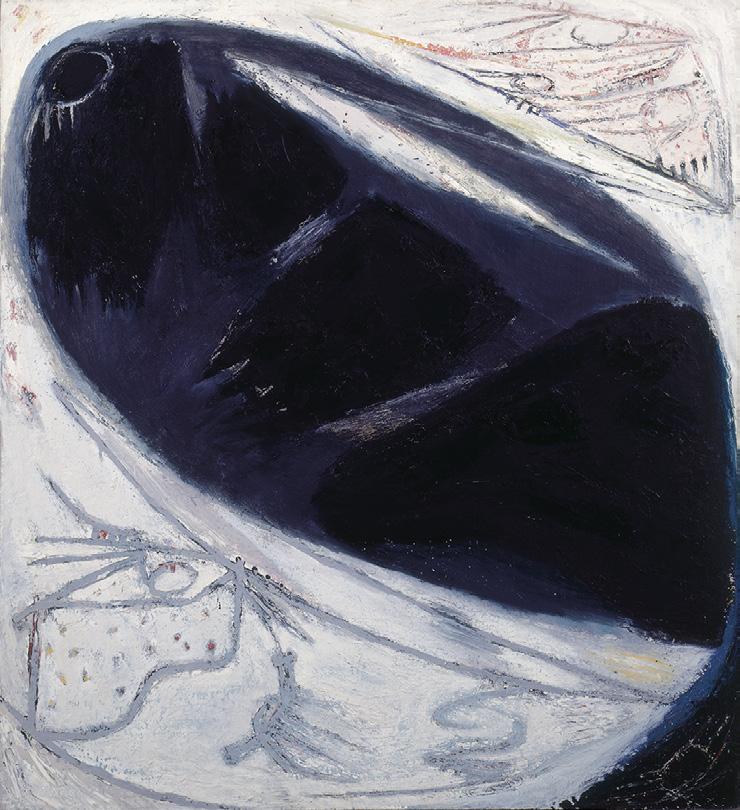
represented a viable alternate path that was not merely eccentric or selfindulgent, and Lobdell took these matters to heart. They justiWed his choice without condescension. Only during the 1960s did the dire urgency of the paintings of the previous decade begin to ease, as if a sliver of shrapnel was Wnally working itself out of deep Xesh, and when it had done so, Lobdell was soon producing the canvases that would move him even more decisively into the realm of sign.
February 1963 (Wg. 46) provides a good example of the transition taking place during this period, though in time it would be clear that none of the early lessons had been either lost or abandoned. In this painting, a large, dark oval all but Wlls a Weld of brilliant yellow. Two canoe-shaped yellow crescents Xoat within the oval, although the relationship between the form and its surrounding space is not readily apparent: is the dark shape form or space, and are the crescents in it or on it, or are they continuous with the Weld? A small triangle of encroaching dark paint appears in the lower right corner, from which a gray line emerges to curl itself around the oval. Yet the shape itself oVers no readily apparent references. And of what signiWcance are the patterns and forms inscribed in the yellow Weld around the black form? They appear to be the marks of the maker, the signs with which he leaves an imprint of his presence, like the scratching on a cave wall beside some ancient pictograph. Similar marks reappear in subsequent paintings, but for the moment, they represent a means by which Lobdell announces a shifting sense of his role as artist. He is an image-maker, but it is his image, not image as meaning. A more ominous version of the oval occurs just months later, in 3 October 1963 (Wg. 47), in which it hangs like a chrysalis from a dark shape in the corner of the painting, this time in a Weld of white; it contains disassembled parts from the Wgures of previous canvases, notably the feet of Black Edge III 23 March 1962 and the ring that surmounts the Wgure in April 1957. Here, Lobdell fully embraces a process that will occupy him for the remainder of his career: his engagement with the transformational properties of signs, as they are taken apart, reassembled, and reshaped over the course of decades, in an investigation so thorough that no end is ever in sight. In a general way, Lobdell inherits this procedure from surrealism—the continual fragmentation and reorganization of the image as a metaphor of transformation, and of the mercurial exchange between physicality and consciousness—though it comes to him most directly through Picasso, for whom fragmentation, as the representation of an existential condition, drew upon the modes of cubist structuring, with their bases in simultaneity of form. There is always a lot going on at once. In Lobdell, however, the nagging, irresistible impulse to reassemble imagery is inseparable from the self-transformational status of the paintings themselves. The Wgure is never Wxed, even though its parts retain their individual identities, and so Lobdell can rebuild it time and time again as something new. Figural imagery from the late 1950s reappears in the dense simultaneity of Wgural reinvention in, for example, Fall 1964 (Wg. 48) and October 1965 (Wg. 49), as if the artist is caught in a ceaseless, compulsive movement that leads him back and forth across an endlessly changing, endlessly variable landscape of form. Reinvention becomes a declaration of possibility, and an acknowledgement of change as the fundamental condition of existence. opposite
3 October 1963

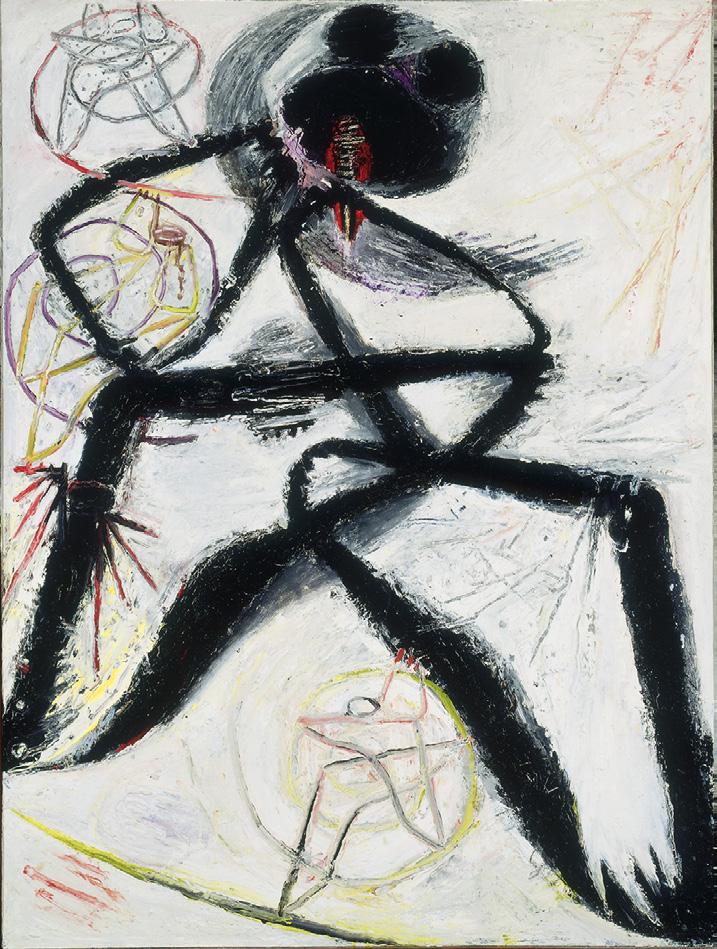

It is retrospective logic, perhaps, to suggest that the most natural course for Lobdell during the 1960s would lie in the expansion of his Wgural capacity. But once he gained suYcient authority in the handling of pictorial space, what could he do other than extend the range and variety of the forms that populate it? Lobdell’s work is by nature evolutionary, and with the passing decades, it becomes increasingly apparent that a thorough exploration of space precedes its habitation. So it is that Summer Mural 1961 points toward the future. By its very scale, the painting not only evokes space, it proclaims space, and then proceeds to penetrate that space with a massive, Wgure-stuVed form that is both totem and phallus, and at the same time, a space within space. The composition appears again, transformed now, in January 1962 (Wg. 50) and November, 1961 (Wg. 51), then merged with the motif of 3 October 1962 in the frightful

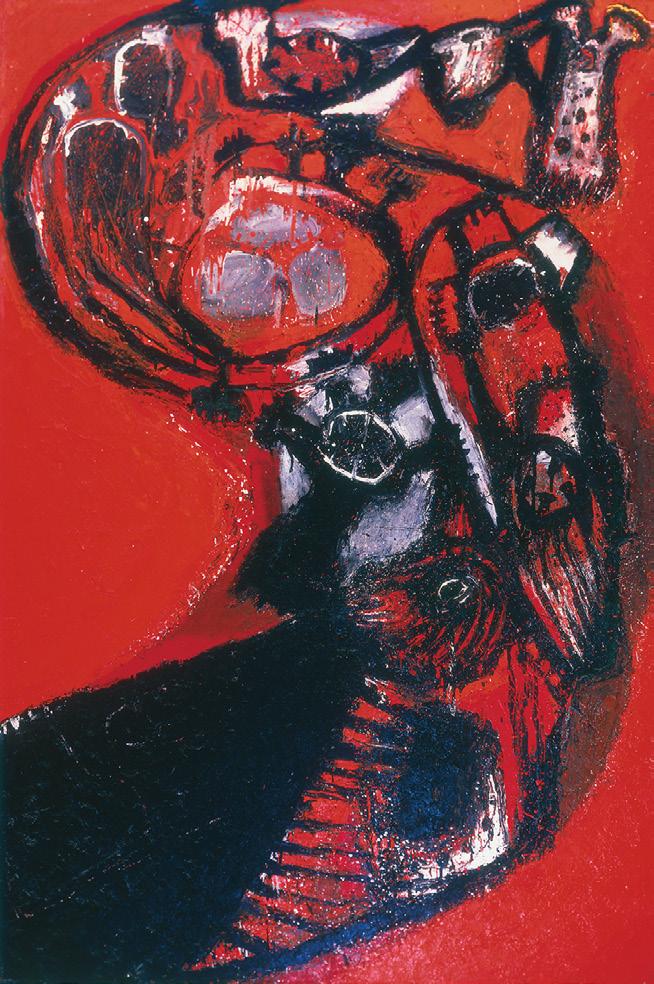

convolutions of Ascent (Red) 13 October 1962 (Wg. 52) In the years ahead, some of the wailing, tormented shades that populate Summer Mural 1961 would appear in other paintings; a few survive in Lobdell’s most recent work.
The many drawings made during the early and mid-1960s also probe a mounting complexity of formal and spatial interaction. There are drawings from 1961 that glance backward, relying on an encroaching dark color in a corner of the sheet to suggest a separate space, while the ascending Wgure also lingers, although it has evolved into a complex column or mass of Wgures, while a number of less tangible Wgures occupy the surrounding space. In other sheets of the same period, Lobdell edits sections of the initial drawing with black ink and then covers the ink with white crayon or oil pastel, putting down marks like brushstrokes in order to generate a quality of Xow—it snakes through the image, buVeting against various reconWgured forms along the way—while the layers of contrasting pigments add to the depth of the space itself. And in still others, such as an untitled mixed media work of 1964, the Wgures seem to be swirling around each other in dynamic array.
In many of the drawings of these years, Lobdell favors the exaggerated horizontal format of Summer Mural 1961, but in the drawings, the format has been selected not in order to accommodate an eccentric shape but, it seems, for its associative qualities: its connection to landscape—this is Lobdell’s land, and here is a view of it—or to cinema—this is a still of a continuous, unfolding process that will, indeed, go on and on. By the time he arrives at, say, Untitled (1964, Wg. 53), a large mixed-media work, we can identify as many as six coexistent spaces around the expanding Wgural repertoire. In both organization and imagery, this drawing, with its wild, centrifugal spillage of forms, its scratched surfaces and many atmospheric layers of gray, also gazes in the direction of Summer 1967 (In Memory of James Budd Dixon), another horizontal canvas that is one of the artist’s most ambitious statements of this period.
Ascent (Red) 13 October 1962
Untitled, 1964
Other drawings of the same period (Wgs. 54–59) also continue a process of assimilating and expanding methodologies that have become integral to much of Lobdell’s subsequent practice: the transformational capacities of the forms themselves, perhaps even as a prerequisite to the artist’s decision to retain them from image to image, forms that literally epitomize the changeful nature of existence; the simultaneous depiction and schematization of space, as if to acknowledge that painted and drawn space are both representational and real in their own ways, on their own terms; the assertive treatment of space as space rather than as background; the utilization of concurrently existing spaces, unlikely juxtapositions of scale, and Wgural forms whose relationship to each other remains uncertain at best. There is no clearly disclosed or explanatory ordering principle, and in combination, all of these various elements formulate a rebuttal to the conventions of perspective, inherited from the Renaissance, which not only privilege the visual but, as an organizing procedure, imply that certainty regarding the world is actually possible and available to (or through) depiction. In Lobdell’s world, art is not in the business of extending cultural narratives of reassurance and order; one must be cautious of anything that masquerades as certainty. So it is that we also encounter Lobdell’s growing preoccupation with forms that elude familiar or predictable symbolic readings simply because they refuse to make sense in that context. At the same time, it is characteristic of Lobdell that he remains forever conscious of the properties of his media: this is itself an aspect of the hand. If the hand is seeking stimulation and challenge, what would be the value of treating all media as though they were the same? Drawing permits the additional exploration of ideas that interest him in painting, but he does not confuse it with painting. It is a medium of experimentation, practice, exercise, and notation. By the time Lobdell arrives at the mixed-media drawings of the mid-1960s, which do indeed have the appearance of Wnished works, it is not that he wishes drawing to behave like painting, or to act as a painting surrogate, or even to achieve more quickly the eVects of oil paint; rather, he wants his most ambitious drawings to achieve an analogous spread of eVects. Thus, the untitled sheet from 1964, with its grays and its dizzying, orbital composition, lies between drawing and painting: using light-colored gouache, Lobdell infuses the Weldlike spaces with qualities of depth and complexity, while extensive scratching and inscription at diVerent points around the image establish a linear environment quite diVerent from anything he might have achieved using similar techniques in oil. This in turn aVects the “space” around the marks: they “cut” the surface space with the clarity of surgical incision.





56.
1963 below
57.
1964 above
58.
1963


To observe some of the paintings of the same period, such as December 1964 (Wg. 59), May 1965 (Wg. 60), October 1965, or Summer 1967 (In Memory of James Budd Dixon), is to see the ways in which Lobdell transfers the lessons of one medium into another in an expansive rather than an imitative way. He does not want the paintings to behave like drawings, either, and on these canvases, he generates surface eVects that would be unavailable in any drawing medium. Both May 1965 and October 1965, for instance, have a texture like alligator skin—the precision of the drawing is transformed into something rugged and visceral—and as a result, the organizing Wgures bear a rather diVerent relationship to their surrounding space. The paintings generate more tension than the drawings do, and a more direct engagement between the Wgure, which is now fragmented and schematic, and the space around it. In the latter instance, Lobdell depicts the Wgure in a kind of space within a space, while its reference to Goya’s Saturn Devouring His Son suggests a concurrence (or conXuence) of art-historical spaces, as well.
December 1964
May 1965
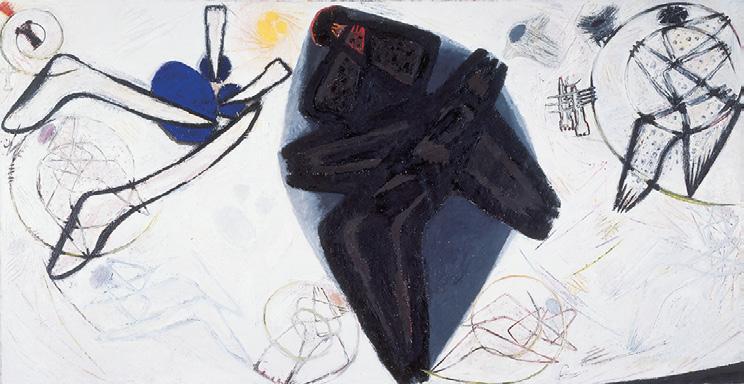
In 1957, Lobdell joined the faculty at CSFA, which was launching its graduate program and would soon be known as the San Francisco Art Institute. His work had been included in the 1955 São Paulo Biennial, and he was now showing on a regular basis in New York and on the West Coast. His career continued to build momentum throughout the 1960s, and in 1965 he spent the year at Stanford University as an artist-in-residence; in 1966, he joined the art faculty there. On the surface, it was a typical Bay Area art career. San Francisco’s commercial art market had not yet developed enough to support individual artists, and so artists of prominence were rewarded, or induced to remain in the area, with teaching positions. Lobdell probably needed little encouragement, and he soon left the city to relocate in the mid-peninsula suburbs near the Stanford campus. Even at that point, he felt no need for proximity to the centers of the art world. More than anything else, he wanted time to work. By the mid-1960s, in any case, he was passing into another phase, of which the emblematic canvas would be Summer 1967 (In Memory of James Budd Dixon; Wg. 61).
The ideas, composition, and spatial concepts for Summer 1967 (In Memory of James Budd Dixon) emerged in the thirty-three prints that Lobdell completed at Tamarind Lithography Workshop in Los Angeles the previous summer. During ten weeks at Tamarind, he editioned thirty-two of them using a wide, often unorthodox variety of techniques, including reversals, second runs, partial images taken from transfer paper, and altered stones. As his visual ideas are turned inside-out, the series provides a case study in the concentrated development of a personal imagery, and the means by which an intense focus on a narrow range of imagery in one medium was transformed


into an authoritative, coherent utterance in the painting itself (Wgs. 62–65). Many prints feel complete in themselves: they do not require the painting, or even the other prints, to conWrm their logic. Others do have an exploratory feel. At times, Lobdell seems to move back and forth between form and space, emphasizing one and then the other as he works slowly toward some kind of resolution. Lithographic ink lies on the surface of the paper in its own way, and so the sense of space in the prints rarely attains the complexity of the completed painting. But Lobdell was prepared to attempt anything that he could imagine upon the stone, and so he was able to create some unusually rich environments for his Wgures and signs.
At 7H by 14H feet, Summer 1967 (In Memory of James Budd Dixon) is a large painting, and it brings together a number of the Wgural forms with which the artist had been occupied since the turn of the decade, all placed within a pale paint Weld that summarizes his spatial explorations up to that point. Though it is not quite a blueprint for the great series of the 1980s and 1990s, it can be approached as Lobdell’s Wrst comprehensive essay upon the use of signage. He was no longer building his images around solitary (human) Wgures, which inevitably suggested a correspondence with the artist himself, an autobiographical element too exact to remain eVective as imagery. And, perhaps, he no longer felt the irresistible urgency that had motivated the paintings of the 1950s, at least not in the same way: changes had occurred in his relationship to the painting as the carrier of the image, and so the imagery itself began to change. Or the story itself was simply acquiring greater complexity as it continued to evolve, and thus the telling of it demanded an expanded means.
Untitled, Tam 1713, 1966
63. Untitled, Tam 1713: State II, 1966
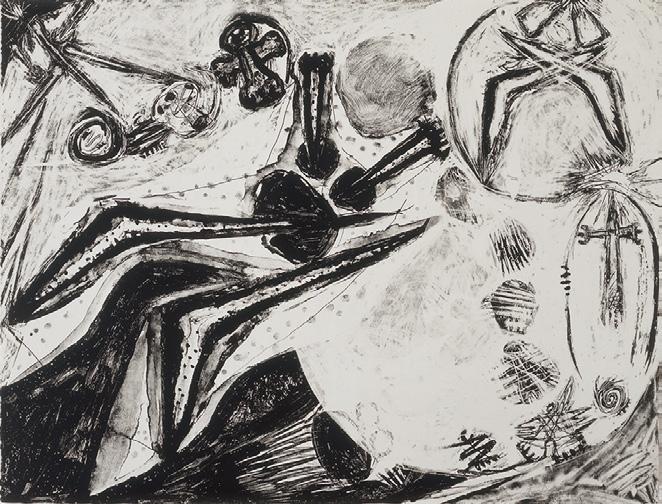
By the mid-1960s, Lobdell’s Wgures could already be described as a populace of sorts, characters that perform upon the surface of a canvas whose intimations of depth and dimensionality do not function in an illusionistic way, but are an aspect of the painting process and refer to the history of the work itself—that is, how it was made, and how much of its making remains discernable to the viewer. From the beginning, Lobdell had often started his paintings by loading the canvas with imagery and then editing it with the brush, and in Summer 1967 (In Memory of James Budd Dixon), he enlarges this practice to a grand scale. The Wgures are not located exclusively in space, but in time: where and when they were brought into being in the course of the painting process, and what happened to them along the way. And yet, the scale and Weldlike composition of the painting evoke space, insisting that it be regarded as a spatial entity, or as a certain kind of site or location.
The subtitle of the painting, as well as the placement of the enfolded dark Wgure at the center of the canvas, has led to the now-commonplace reading of Summer 1967 (In Memory of James Budd Dixon) as an elegy, and the ghostly Wgures, many of them inscribed in the glowing paint surface, naturally suggest a meditation on mortality and rebirth prompted by the passing of an artist who had been an active participant in San Francisco’s abstract expressionist group. In fact, the canvas was stretched during the spring of 1966,

while Dixon was still alive, and Lobdell then left it while he went to Tamarind. Dixon had been close to Lobdell during his early years in the city—Dixon was already in his mid-forties by then—but the older artist’s alcoholism was aVecting his production by the 1960s, and he had dropped from view. Dixon died while Summer 1967 (In Memory of James Budd Dixon) was in its Wnal stages, and although a rumination upon death as an aspect of the work would hardly have been uncharacteristic, Lobdell added the subtitle not so much as a testament to his colleague—he did not have Dixon speciWcally in mind when the painting was conceived—but with the thought that an undervalued regional artist might be remembered because of it.
Some of the imagery in Summer 1967 (In Memory of James Budd Dixon) had appeared in turn-of-the-decade works such as March 1961 (Wg. 66) and

Black Edge III 23 March 1962 (Wg. 32), most notably the enfolded form as a centralizing motif, and the ursine claws and dot pattern that characterize the Wgure in the upper right corner of the painting. These maintained their presence in Lobdell’s repertoire of signs during this period, but there are some recent additions, too: a Wgure built from stacked clusters of inscribed lines; a keylike form that evokes both a cross and a Wgure with outstretched arms, as a further evolution of the cruciWxion motif; the three circles organized into breasts and a seemingly pregnant belly, caught inside a circular pattern of lines that seem to be spinning in an outward direction; and the spirals that

contain, and connect, many of the Wgures and set them into motion, around and around, or backward and forward through “space.” These signs belong to Lobdell alone, and in this spacious painting he takes possession of them, placing them together as if marshalling his forces for the future.
Lobdell’s signs appear alongside forms derived from Picasso—most obviously, the trailing, clublike appendages that refer to the Wgures of Guernica (Wg. 67), and to the beach pictures executed during the 1920s and early 1930s. The inclusion of this art-historical imagery is not merely a matter of appropriation, or even homage. What Lobdell has actually taken from Picasso is a procedure of formal invention: an assembly of formally Xexible signs that refer to the Wgure (and by implication, to the Western Wgurative tradition) but at the same time suggest a breadth of private reference that is available to the artist from one painting to the next. At the same time, the potential for an apparently endless reassembly, in Lobdell as in his predecessors, constitutes a literal rejection of the kind of Wguration whose very wholeness naturally lends content to the form: the uniWed Wgure speaks of received meanings, aYrmations, and assurances—things in which Lobdell, of course, has no particular faith. Here, the fragmented Wgure delivers the form directly into the hands of the artist, who Wnds that more intriguing discoveries are to be made in places where unity, both formal and philosophical, is less certain.
Like the God to whom the sinners of early Northern Renaissance painting made their appeals, history is silent. Thus Lobdell uses the past in the knowledge that neither Goya nor Picasso nor any other historical Wgure will rebut his appropriations. He exploits the silence, which reiterates the silence of the canvas itself; in the end, the images of Western art history, even recent art history, join the images drawn from obscure or archaic sources, or from his own hand. They exist within a general repository, and the artist selects from among them equally, just as he places them alongside each other, with the intention of discovering what will occur in the process of doing so. He picks his
masters with care, but with the understanding that their images were bequeathed to the future from the very start. Their associations with particular art traditions make the process of integration more challenging, but of course they bear the promise of more interesting results.
The outsized feet appeared in Lobdell’s work at least as early as Summer 1962, and they would recur with some frequency as the artist tested their pliancy by reconWguring them in a number of works. An instance of this tendency is Summer 1968 (Wg. 68), in which one “arm” is perpendicular to the other, rising like a woodpecker’s crest through the blue and black circles of the belly-and-breasts form, so that the “breasts” become “eyes” and the “belly” becomes a wide, circular “mouth” that echoes previous references to Goya’s Saturn; we tend to “feel” rather than “read” the character of the Wgure, which Xoats in a white space inscribed with selections from Lobdell’s coterie of signs. The Picassoesque forms are deWned by overlapping lines, a technique that denies their unity and substantiality as human references—or perhaps redeWnes the idea of unity within an expansive network of pictorial forms. Unlike Summer 1967 (In Memory of James Budd Dixon), Summer 1968 is quite crowded, and the Wgures shove against its borders, as if attempting to escape their condition.
In Summer 1967 (In Memory of James Budd Dixon), the debt to Picasso is not only formal. While he was getting started, Lobdell found himself thinking about the exhibition of Guernica that he had seen at the Art Institute of Chicago more than twenty-Wve years earlier, which included many of the drawings and smaller canvases that Picasso had done as studies during his work on the painting. These became “studies” for the viewer, as well—that is, objects to be studied—with the promise that they might reveal noteworthy information regarding the means by which the artist resolved a number of formal problems. This made an impression on the young art student, who saw that a painting could be made in much the same way that a novel is written, bit by bit, back and forth across the text, with continual editing and revision that gradually yields the contours of the Wnished work. Just about anything can happen along the way; released from the restrictive environment of preconception, the making of the painting assumes a unique, unpredictable character and history as the image struggles toward the moment of balance that satisWes the artist. Lobdell’s own process reXected this understanding, but typically his drawing and printmaking activities existed separately from speciWc paintings, as the elements of a more general enterprise. Never had he focused all of his resources upon a single canvas for an extended period of time. For Summer 1967 (In Memory of James Budd Dixon), he decided to alter this approach, and he arrived at Tamarind with the intention of devoting his entire workshop period to visual ideas related speciWcally to the big canvas, in order to develop each in turn. Every motif would be isolated and studied exhaustively, until he felt that he had absorbed it as deeply as he could.
The fragmented Wgure would remain central in Lobdell’s work until the end of the decade, when he began the Dance series in response to the Vietnam War, and even there an echo of the form still lingers. By now, the fragmentation of the human body also functions as a metaphor of the conditions of

modernity—this is true of Picasso as well. But it still retains its greater signiWcance as an embodiment of a ceaseless metamorphosis, as a persistent, inescapable existential condition. And from this point of view, Lobdell naturally rejects traditional requirements for thematic structure or content. The work is not required to be “about” anything, at least not in a predetermined or self-conscious way, because it will inevitably assume its own modes of meaning in the course of its making. With its foundation in a process that mirrors the transformational state of existence, it absorbs all the raw materials of source and inXuence into the process itself. Once metamorphosis is made preconditional to its very existence, the work is free to go anywhere, while its essential verity remains intact.
Lobdell is not Picasso, of course, any more than he is Goya, and so the admission of inXuence can be more properly regarded as an acknowledgement of a network of passages and connections that includes all three artists, and indeed, all artists, and all images. So it is that Lobdell’s drawings of the 1960s begin to absorb an exceedingly wide array of imagery, often from sources quite outside the art world, and he would continue to transform these images in the years to come, in some instances to the point that their origins were no longer recognizable. At the same time—and to some extent, perhaps, as a consequence of this process—the relationship between the drawings and paintings also begins to shift during the late 1960s and early 1970s, slowly at Wrst, but with a gathering momentum that will eventually bring the two mediums together.

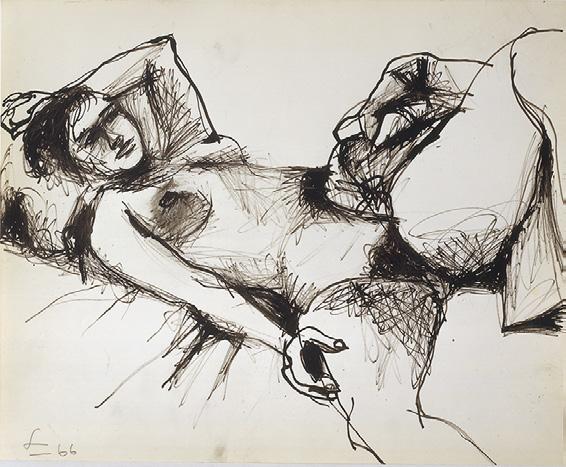
In 1959, Lobdell also began participating with Richard Diebenkorn and Elmer BischoV in weekly sessions of drawing from a model, and after his move to Stanford, he continued the practice for some years with fellow faculty members Keith Boyle, Jim Johnson, and Nathan Oliveira. It was a departure from his normal mode of working, but during the course of a decade, he produced well over a thousand sheets. Many are straightforward, and because the drawings from these sessions, by all of the artists, have been exhibited in various combinations, Lobdell’s work appears to be sympathetic, at least at Wrst glance, with the ambitions of the Bay Area Wgurative movement. But Lobdell never aYliated himself with Bay Area Wguration—his ties to it were social and collegial, not artistic—and his work is by far the least idiomatic of the group. Direct observation of the model was a venerable practice, and he submitted himself to it, as if declaring his desire to be seen within the context of tradition, as part of a lineage. Lobdell’s instincts had always been Wgurative, but if he is not “traditionally” Wgurative in the way that BischoV or even Diebenkorn were, he clearly believed that the Wgure was still a necessary talisman in the life of art. And so, during a period when his own paintings were moving toward increasingly oblique modes of reference, he turned to the most basic of Wgural practices, as if, paradoxically, working directly from the model would enable him to push his painted imagery even further from naturalistic form.
71. Untitled, 1965
72. Untitled, 1972
73. Untitled, 1973
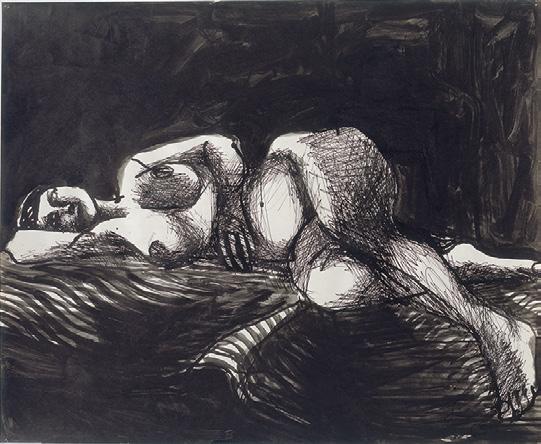
Lobdell normally deferred to the other artists, allowing them to establish the poses for the sessions according to their needs. To surrender control over the motif represented a useful challenge. His task was to bring the eye and hand to the subject before him. As a matter of process, however, the drawings will often reveal how closely Lobdell looked at the work of other artists and then used the sessions to think further about what he saw there. This tendency often seems most apparent in those instances in which the model has assumed a complicated recumbent pose, which enables the artist to treat the body as an assembly of interconnected abstract forms, each available to certain distortions and exaggerations. In Untitled, 1965 (Wg. 71), Untitled, 1972 (Wg. 72), or Untitled, 1973 (Wg. 73), for example, Picasso is an obvious inXuence, and there are moments when Lobdell all but mimics Picasso’s drawing style, using unruly bundles of ink lines to render form in a way that denies the drawing as illusion and thus Wxes it entirely within the context of the artist’s hand. In Untitled, 1965 (Wg. 71), the face is treated with the kind of cool, classical elegance that also is characteristic of certain periods in Picasso’s career, not as an idealization of the model’s features, but as a way of integrating her identity with particular traditions of depiction. In Untitled, 1972 (Wg. 72), the upward-gazing proWle is cartoonlike, though the line that describes the edge of the form is quick, agile, dynamic, while the Wgure’s foot is outsized, decidedly masculine, and distinctly Picassoesque; as in many of these drawings, dramatic contrasts are fundamental to the visual eVect. References converge



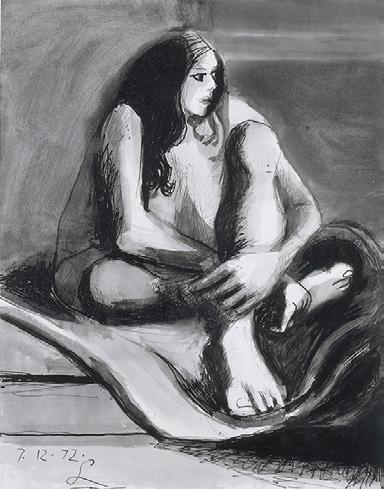

in Untitled, 1967 (Wg. 74), but here they intentionally heighten the matrix of small, lightly toned shapes established in a complex design across the sheet.
In Untitled, 1972 (Wg. 75), the oversized appendages, almost grotesque in appearance, recall Goya’s Saturn and, by inference, Lobdell’s paintings of the previous decade, while the blanket beneath the model seems to Xow around her body like the movement of the space around the artist’s womblike painted forms. Lobdell’s long involvement with automatic drawing could hardly be set aside, and as the sessions with the model continued, he gave free rein to the hand, encouraging it to perform its most characteristic gestures in a substantially diVerent context. So it is that a number of drawings favor a decisive cross-shaped composition, a play of horizontal and vertical elements that pass through and hold the Wgure. There is, as well, the drama of Untitled, 1972 (Wg. 76), in which the X of the platform brace is stated more emphatically than the form of the model, who lies like a corpse across the platform above it, close against the top edge of the sheet, an arm thrown across her abdomen like a disembodied form, her legs unnaturally contorted, as if she had been cast lifeless upon this cross. One can only wonder how the paintings might have developed if Lobdell had introduced distinctly female Wgures during the 1950s.


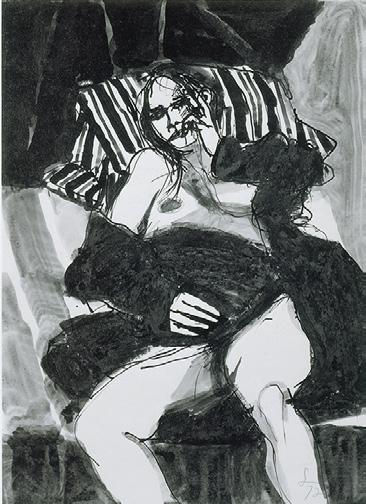


Elsewhere, Lobdell refers to other forms and marks that hold signiWcance for him—the ladderlike networks of lines, for example, on which the Wgures make their passage into the void in March 1954 (2) (Wg. 77) and again in 3 October 1962 (Wg. 78)—as if conWrming them as his own and, at the same time, sinking them even deeper into his consciousness. In the broadest sense, he is simply permitting the hand to act, as if to determine what it prefers in the process of creating a recognizable, naturalistic image. If he allows his inXuences to come forward, it is because aspects of another artist’s work are of particular interest to him, and the most eVective way of probing this interest is to use the ideas themselves in the immediacy of the session environment. In other sheets, Lobdell may choose to focus on a technique, or emphasize the details of the room rather than Wgure or atmosphere. In Untitled, 1965 (Wg. 81), he depicts an illusionistic space in complex, authoritative arrangements of Wgure, furniture, and mirror images. But he is always attentive to the hand, learning about it, exercising its abilities, by doing many diVerent things and Wnding the areas of commonality between them.
opposite above left
77. March 1954 (2)
below left
78. 3 October 1962
above right
79. Untitled, 1972
below right
80. Untitled, 1972
above
81. Untitled, 1965

Quite a few of the drawings are overtly erotic, with an emphasis on the details of the model’s genitalia that is rare in the drawings of the other artists. Lobdell’s intentions seem to lie in the accurate evocation of the atmosphere of the studio, in which an unclad female reclines before three or four (male) draftsmen. He willfully exposes the inherent voyeurism of the session, something more typically denied by the objectiWcation that takes place in Wgure drawing, as if by tacit agreement with tradition. Consequently, his drawings address the moment of their making in its entirety. The Wgure is never really neutral; if he is going to draw the nude, then he is determined to hide nothing. Lobdell recognizes the extent to which the sexual presence of the model inXuences the situation in which he Wnds himself, and this is the quality he wishes to capture on paper.
Lobdell: “Drawing is the source of it all. You can’t just look. You have to get involved with it to know what you’re looking at. In other words, you really have to look. But drawing the Wgure also educates the hand. When I’m drawing anything in paint, in any of these images, the hand has already been there—it’s been educated by so much work on the Wgure. The eye, too, I suppose. But my hand has to understand the origin of a form. In that sense, drawing is my way of thinking.”
The problems of seeing, of testing the reliability, or unreliability, of the eye, so critical to Cézanne or Giacometti, are not of pressing concern here. The moment-to-moment capacities of the eye are perhaps even beside the point. And this, of course, is where Picasso departs from Cézanne: looking is no longer fundamental to picture-making in quite the same way—the primary transaction is not between the visible, physical world and the image, with the artist as a mediator who contemplates the limitations of human perception, but between the artist and the image. That may be Picasso’s most signiWcant legacy for an artist of Lobdell’s inclinations. His involvement with forms and signs takes place in the imagination and is inextricably bound to the human impulse to generate some kind of sense of what he has created. Given that condition, construction of the image could hardly be based in perceptual problems. And if the unreliability of the eye is simply accepted as given, then certainty of meaning in the invented form is called into question, too. What can ever be absolute or deWnitive if the bases of meaning lie in the innate variability of the individual? Even the idea of a “visual” art—an art dominated by a single mode of perception—may be spurious. For Lobdell, drawing is Wnally, and can only be, a function of how the hand creates, a conclusive proof that signs do not originate in sight alone. The real task is to locate the place from which they come, to discover a means of stimulating their further appearance, and to somehow cultivate their uniqueness of form.
Untitled, 1964

During the 1960s, the West Coast once again became a point of passage for American soldiers traveling to and from a distant war, much as it had been twenty-Wve years earlier. Lobdell had students and a son of draft age, and as casualties mounted in the jungles of Vietnam against the familiar backdrop of political dissembling and maneuvering, his old outrage returned. For an artist, whose work rarely achieves much public visibility, the terms of engagement with public issues are always diYcult, and here Lobdell separates himself from teachers and models like ClyVord Still: a good deal remained of the youth who had responded to the force of individual utterance in Guernica. By the same token, high modernism’s lofty detachment from topical concerns denied Lobdell’s longstanding desire to Wnd ways of expressing intense emotion on the canvas. He would not have been persuaded by arguments that the austerity of minimalism, a dominant style of the period, had encoded a critique of the war into its references to fabrication, standardization, the formations of the urban environment, and the sterility of modern life. Those impulses were not necessarily absent from the work, but neither were they stated clearly enough, nor with suYcient passion. Commentary made at such low volume was easily ignored.
The ineVectuality of painting in the world of events poses a singular dilemma—a moral dilemma, in its way—and one that Lobdell could hardly ignore. A personal statement was possible, certainly. But could the work of art join in a meaningful way with the mounting chorus of protest? During the late 1960s and early 1970s, in response to Vietnam, Lobdell undertook a sequence of paintings that became known as the Dance series. These eight canvases, with several others that accompany them thematically, such as the excruciatingly painful Winter 1969 (Wg. 83), borrow once again from art of the past.
Much of his work during the 1950s can be regarded within a context of Lobdell’s wartime experiences and his feelings about the political environment of the Cold War; in this sense, it may be aligned to the wave of Wgural expressionism that emerged in Europe and the United States during the postwar era in the shadow of more prominent abstract modes—but because their foundation in archetype eVectively detaches them from temporal considerations, the paintings of the 1950s confront what at that time was still called the human condition. In its topicality, the Dance series makes no such plea, and as a result, even the complex spatial moves that occur in the Wnal paintings of the series, such as Dance VIII (Wg. 84) or Spring 1972 (Wg. 85), are still overshadowed and perhaps troubled by this thematic presence. And, of course, they remain problematic, too, as an apparent reversion to methods Lobdell had left behind a decade earlier.



In Winter 1969, which evolved from the airless, more broadly gothic vortex of Summer 1969 (Wg. 86), the womblike oval around the Wgure is the color of bloodstained water, and the spiral has become both fuse and snare, burning at one end as it entangles a Wgure whose crescent-shaped head, with its daggerlike tongue, quotes from Guernica. An inscribed object buzzes near the grappling form, while some of Lobdell’s characteristic signs, such as the crossshaped Wgures with keylike feet, appear alongside an encroaching brown space as agitated witnesses, vibrating with alarm before this otherworldly zone of nightmare and hallucination in which the depths and details of illusionism have no place. It is a raw, reXexive image, laden with reference and

symbol, hardly more than a work of agitprop. In some of the related paintings of the period—the dramatic January 1969 (Wg. 87), for instance—it is as if the symbols are situated in conXict with each other in compositions whose circularity deWnes the endlessness of their struggle and the impossibility of resolution. These are works whose success relies upon visceral impact. The armored, mechanistic Wgure of January 1969, as another example, invites no interpretation; it is as emblematic as the carved handle of a Crusader’s dagger.
Nevertheless, to disregard the Dance paintings out of hand would be a mistake. The series develops a progressive internal narrative whose motive is as much formal as it is thematic. If the work is driven by the artist’s moral outrage



and his desire to involve his art with events, he is always working as an artist. By the time the series reaches something like apotheosis in Spring 1972, in which the Wgure, depicted in outline, achieves both rough elegance and a remarkable pliancy in a spatial setting of understated depth and variety, Lobdell has added to his understanding of the life of the image and its habitation of the canvas. These lessons would remain useful long after he abandoned the imagery of the series itself.
Several early images from the Dance series, including Fall 1968 (Wg. 88) and Dance III (Wg. 89), clearly refer to the patchwork cubism of Picasso’s The Three Dancers (1925, Wg. 90), or to the balloon limbs of Figures by the Sea (1931), which lie across each other in a surrealistic rendering of predatory eroticism. But if Lobdell was quoting from Goya and Picasso, he was also recollecting the gleefully grotesque visions of mortality in Northern Renaissance woodcuts and the tarot, as well as the Dance of Death that takes place near the close of Ingmar Bergman’s The Seventh Seal (1957), in which a row of Wgures silhouetted against the dying daylight mount the crest of a long hill. Set in the aftermath of the Crusades, the Wlm contemplates the silence of God in the face of human suVering and death, and it was heavily revived on college
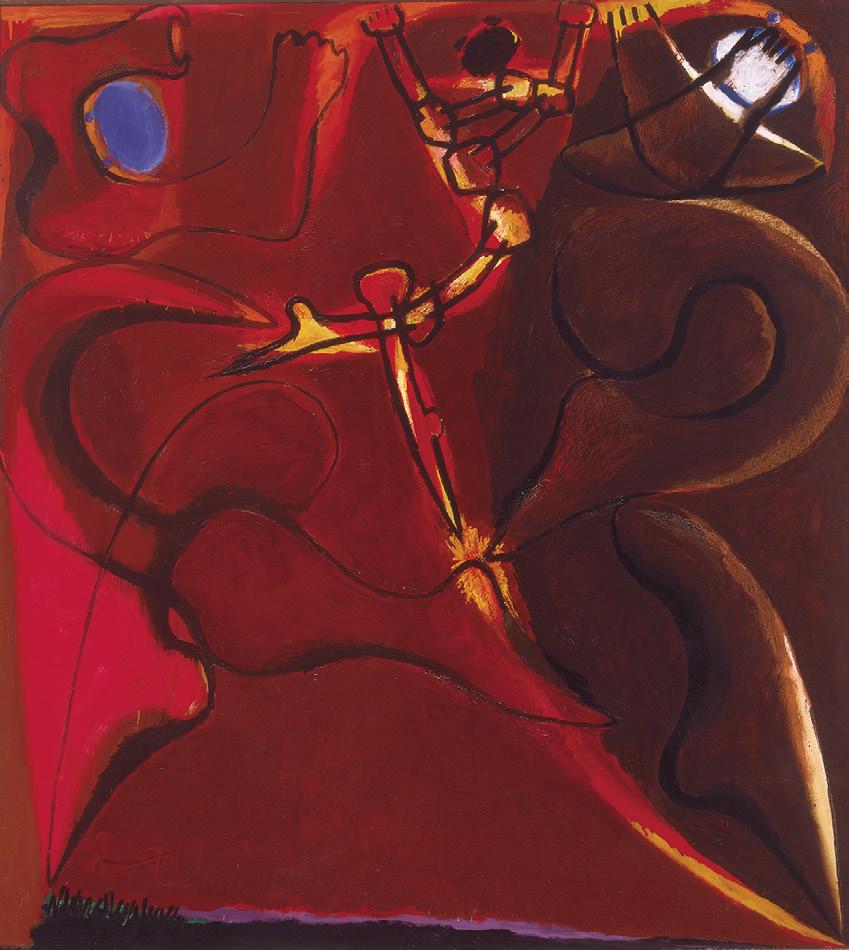


campuses during the Vietnam years. Other images lurk in the background, too: the malevolent hell of Hieronymus Bosch; Goya’s Saturn, which transformed a classical myth into a stark essay on the cannibalism of the old who feed upon the young in the Welds of conXict; and the mayhem of Krazy Kat. In Dance V (Wg. 91), the play of tarnished gold, as it follows the shape of the Wgure down the canvas, echoes the handling of color as light in Rembrandt’s Lucretia (Wg. 92), a painting at the Minneapolis Institute of Arts that Lobdell knew as a youth, or the pattern of light moving across the canvas in The Conspiracy of the Batavians at the National Museum in Stockholm (Wg. 93), which he studied in reproduction. For Rembrandt, a man of the seventeenth century, the light indicated both divine presence and the immutable truth of Reformation theology. But this same God of the Western Enlightenment had become a subject of debate in the divisive atmosphere of the late 1960s in the United States: one did not have to look very far to see the many epic horrors of the century—poison gas warfare during World War I, fascism, the Holocaust and other episodes of ethnic genocide, the deployment of nuclear weapons at the end of World War II—and now a war in which even language was corrupted by the oYcial discourse of denial and justiWcation. Lobdell’s bow to Rembrandt can only be ironic, but not merely as a signal of his own anger and frustration. Even though his light organizes the canvas in much the same way that Rembrandt’s does, the nature of the illumination is less certain by far. Unlike Rembrandt, Lobdell invests his belief in the real and present action of the paint itself as it organizes the image, rather than in its symbolic references. In a broader sense, the tendency toward reference in the Dance series gestures deWantly in the direction of modernism’s cult of originality. Lobdell recognizes that his quest is not for originality, at least not for an originality synonymous with novelty, but for authenticity, whether as authentic morality, authentic emotion, or as an authentic act of imagination. For him, ‘originality’ is a matter of ‘origins,’ which exist in his own hand, and in the lingering mark

of his forebears and ancestors in his work. He no longer feels a compulsion to be ‘novel,’ and a conception of originality as authenticity opens the entire world of imagery to him in somewhat diVerent terms than before. He can do with it as he wishes.
A blueprint for the Dance series can be seen in Fall 1968. Here, the primary Wgure has been transformed again, this time into a lighthearted dancer moving toward the left of the canvas, away from a crescent that divides the pictorial space and away from the ravenous, amorphous form lurking behind it. These motifs continue to change from one painting to the next, however, as a slender, robotic Wgure, drawn from Picasso’s Dance, takes center stage, often in a merrily malignant pirouette between two balloonish Wgures, its partners. These images are theatrical, but in this instance, ‘theater’ also may refer to military terminology—the combat zone as a theater of war—and to the manner in which government and industry publicly present their justiWcations for the conXict and the loss of life that it entails. The Wgure lends a ritual element to the artist’s commentary, as if he himself is well aware of being caught in an inevitable enactment of outrage and protest, even as it remains expressively elastic as a form: its dance conveys triumph (Dance IV, Wg. 95); demonic delight (Dance V, Wg. 91); entanglement (Dance VI, Wg. 94); and nocturnal bacchanalia (Dance VIII, Wg. 84), rather like The Witches’ Sabbath of Goya or




the unspeakable rites of Heart of Darkness. By the end of the series, the balloon Wgures also have become outlines, Xexible, schematic forms open to adjustment. This pliancy may Wnally be a metaphor of human survival. Lobdell had also returned to the dour hues of his work from the 1950s— some of the surfaces have the muddy opacity of poster paint—but the open silhouette constitutes a signiWcant development in his formal vocabulary. In one crucial departure from the paintings of the 1950s, these Wgures do not emerge out of the paint but are based in line from the start, which in turn leads the artist into a drama of Wgure and ground. Relationships between form and space are no longer well deWned, and even foreground and background refuse to be divided in conventional ways; by the end of the series, these areas resemble “piles” of tilting planes that recall cubist paintings of the mid-teens, especially those of Braque and Gris. In Spring 1972 (Wg. 85), one of the last Dance paintings, the line describing the Wgure is played out, literally so, in a bulbous, empty shape that pushes against the very edges of the painting, and against the ground. A clublike form—just arms and legs—is retained from among the previous images in the series, but it has surrendered the kind of explicit embodiment that occurs in, say, Dance V (Wg. 91). At times, some of these late Wgures recall David Smith’s unraveling of sculptural line in twisting, cablelike passages of metal through open space. The parts of the body seem interchangeable, with the possibility that they can be made to refer to things outside the human realm, a characteristic that also reXects Lobdell’s roots in surrealism. But the reconWguration of the body in the Dance series also questions the logic of form, particularly the bases of human identity in its physical attributes: the artist’s protest is lodged in this reconstruction, which describes an identity distorted and restructured by the moral conXagration of war.
Spring 1972 (following the related Fall 1971, Wg. 98) also includes a secondary Wgure, a dark ghost Xoating ‘within’ or slightly ‘behind’ the linear Wgure, while small circles are deployed around the canvas to enhance the visual rhythm of the composition. The blue ghost introduces a portentous atmosphere of mystery and spectral, submerged life, one that might have come from somewhere outside the painting, and as a visual device, it marks the length of the journey from the rather straightforward, Picassoesque references in the imagery of only two or three years earlier. Lobdell has thoroughly ingested the modern vocabulary that was essential to his early development and now uses it in a fully idiosyncratic way. The Wgures of the Dance series did not necessarily begin as strictly personal forms, but their place in the painting becomes personal during the course of the series as they are stretched well beyond the formal boundaries of their origins.
That Lobdell had been thinking as an artist all along is evident in the drawings that accompany the series (Wgs. 99–107). They clearly serve the hand: they sustain its purpose, secure in the awareness that the hand will outlive the issues swirling around it. Here he considers ideas without pushing his anger to the foreground, as he does on canvas. A drawing from 1971 (Wg. 100), for example, deals with the same expansion and fragmentation of the Wgural form, and the same deconstruction of Wgure and ground that occurs in some of the late Dance paintings, but the lighter colors communicate the Wgure
opposite 98. Fall 1971



diVerently, while the retention of buried or “ghost” images heralds a technique that will be exploited to great eVect in mixed-media works in the decades to come. The Wgure, depicted in outline, blown up like a balloon, ampliWed, and disassembled upon a pale ground from which its substance as a body is inseparable, or indistinguishable, suggests a further investigation of Picasso’s cubist surrealism. Coexistent spaces, indicated by slivers along the edges of the sheet, hem the Wgure and compress its ground of operation. Other gouache drawings of those years, carried out in muddy browns, blues, and slimy greens, are related directly to the paintings, but elsewhere among these drawings, we can watch as Lobdell works out the underlying problems of the series in a way that is more characteristic of his practice as a whole. What began in anger concludes as an investigation into the organic life of the sign and the symbol.
The severe Xattening of space that occurs in both the drawings and paintings of the Dance series suggests a rejection of conventional perspective that is more deliberate, and more extreme, than anything Lobdell had attempted
1971
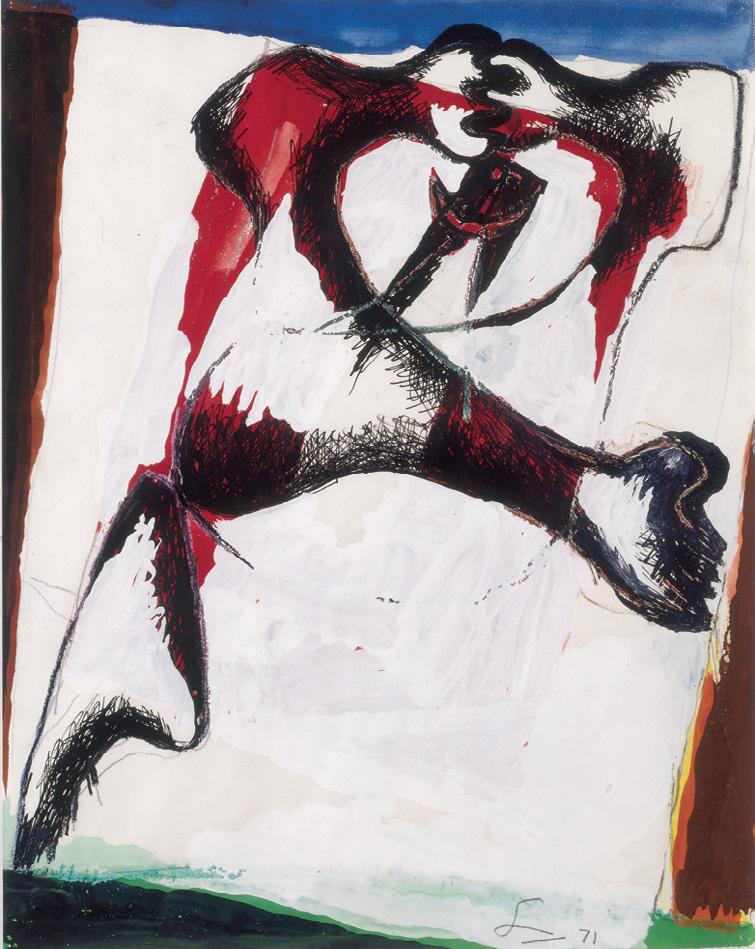





previously. Even the large paintings of the 1960s, which palpably contain the hovering forms, are more forthright in their resemblance to real or readable space. This shift can be interpreted metaphorically, of course: Lobdell refuses to accept a “perspective” on the morality of war. By extension, the rejection of perspective also represents a broader refusal to acquiesce to systems of representation and all that they imply. Still, he does not typically declare himself in the terms of open rebellion. In his hands, rather, the systematic loses its necessity. There are, quite simply, ways of making Wgurative pictures that do not rely upon accepted means of Wgural representation. The “realism” of perspective attempts to create an illusion of continuity between the viewer’s space and the space of the image, but Lobdell wants nothing to do with this sort of reality. The world is not so willingly available to representation and its guiding assumptions. Once again, it is as if he says: My own experience has taught me otherwise, and I will not comply. To release oneself from such systems and their inextricable attachment to a culture of destruction is itself a freedom, and the faith that this freedom can be enacted on the canvas will be yet another aspect of Lobdell’s work in the years to come.
The immediate impact of the Dance series on Lobdell’s work is impossible to assess. He recognized that his use of an explicitly Wgural imagery had reached an end, at least for the time being, and he began tinkering with another Picassoesque strategy: to scrape down his painting at the end of the day and then build it anew on the next, so that the Wnal image, when it eventually comes about, is built by, or in, the memory rather than directly upon the canvas—not a succession of stages whose full history remains embedded in the materials of the work, but a new image on each occasion, based upon the one before. It was another challenge, intended to stimulate himself and his

imagery. But Lobdell conducted this experiment with Commercial Etch, a paint made for application on metal surfaces. Within just a few years, these works began to blister and crack. Even the color changed. Most of them had self-destructed by the end of the decade.
The work after the late 1970s achieves the coalescence of style and purpose that had been promised by the paintings of the 1950s and 1960s. And it was a matter of coalescence: Lobdell became less preoccupied with what was to be said and more concerned with the means by which he might say it, with the conWdence that themes would emerge on their own, as the residue of the process. He had devised to his satisfaction a set of conditions in which invention could be stimulated, and rewarded, by a relatively restricted range of images and spatial conWgurations. At some point, the viewer may begin to feel that each painting or drawing looks pretty much like another: not that they are actually identical, but that they tend to evoke a sameness of visual eVect. Only when we gain familiarity with a substantial number of images from among the paintings and drawings, and the range and fecundity of Lobdell’s invention becomes apparent, is his accomplishment revealed. The drama of change is subtle but pervasive, and every painting is a product of painstaking research and exploration.
Because the paintings after the late 1970s seem so diVerent from their predecessors in the Dance series and, of course, those of the 1950s, there has been a tendency to see them as the work of a relatively placid, self-assured maturity. And these paintings do exude an otherworldly indiVerence to events occurring elsewhere in the art world and the world at large, as if they reside in a universe of their own. It is often observed that in Lobdell’s later work, the tones lighten and space opens into vast territories of color, not illusionistic, exactly, but deep. One senses, too, the softened, distant echoes of other ¬n de siècle phenomena—the symbolists, for instance—and their withdrawal into a geography of private signs and symbols well removed from the world of human struggle in which the broken, schematic Wgures of the Dance series (as Thomas Albright described them) perform their mad ballet upon paint Welds the color of merde. But even lacking the paintings of the mid-1970s to chart the transition more clearly, it is apparent from the images at the end of the decade that Lobdell was, in fact, behaving consistently. In surviving canvases such as Untitled (1977, Wg. 108) or Summer 1980 (Wg. 109), he enters this “new” world in an almost literal way, by exploring its space, like a blind man entering a room for the Wrst time. Space, it seems, must be settled Wrst, and here the artist’s initial interest focuses on its dimensions rather than its habitation. Certain familiar motifs reappear—the seated Wgure built with lines inscribed in the paint, the jagged teeth, the crosses, the crescent that harks back to the yellow forms of February 1963 (Wg. 46)—while the hues and muted tones of the color Welds naturally evoke expansive space. But the work is exploratory, and what these canvases most assuredly signify is that when space is conceived as paint, and vice versa, it truly becomes its own world. Lobdell, however, is the creator, not a colonizer. He has often regarded the painting as a fragmentary view—a fragment of what he himself sees—or what can be

seen—and now it is smaller than ever before. He seems to be combing this space from a close perspective, as if with a magnifying glass. The problem, it seems, is not necessarily the amount of space that can be shown, but the extent to which space can be shown at all. Painted space may be symbolic, too, and Lobdell knows the risks of proceeding carelessly. In truth, these paintings do shed some of the literalness of the earlier work, for the artist is moving past the paint and into the painting itself.
As he went about charting a new course during the mid-1970s, Lobdell did much of the arduous work in drawings and monotypes, which allowed him to move quickly and explore ideas almost as soon as they occurred to him. But among the paintings, some of the best examples of the period, such as Summer 1980 or the more complex Fall 1980 (Wg. 110), retain something of the legacy of abstract expressionism, although he tends to focus upon the

operational means of painting rather than its materiality. Space has been an issue for him from the beginning, and as he explores it again, a more experienced traveler now, he seeks a territory in which his own emotional investment does not dominate the image in such a readily apparent way; his various motifs are no longer asked to restate their origins from work to work.
One might be tempted to think of this period in purely psychological terms—as some critics have—a shift from an outer to an inner space. In his previous work, certainly, Lobdell had pressed himself to convey a quality of emotion that spilled across the canvas, an objective that seems to disappear during the late 1970s. The shift might be described more accurately, however, as a relocation from the public space of painting—its engagement with events and the memories of events, and the artist’s response to them, with the understanding that the image will be displayed—to a private, or local, space in which the painting as a carrier of signs can be investigated at length, without intrusions. During those same years, Lobdell also showed an increasing reticence regarding the conduct of his public career, and even in the Bay Area, he became something of a distant eminence. The shift, then, is not inward, strictly speaking, but toward privacy, in a quest for a place in which to pursue his ideas without fuss or undue interruption. As he had come to understand, response to events introduces subject matter, which incurs meaning as a matter of course—precisely the situation he wishes to avoid. After sharing himself so freely for so long, he is at pains to withhold the associations in the forms that are now emerging in his work, as he strives to allow them to develop on a natural course, as free as possible of exterior demands.
This path of argument might seem disingenuous, since the idea of the painting as a document (or site) of personal symbolism (or ritual) is now commonplace, a view based upon an assumption that meaning is always present in the work, persistently so—meaning that not only can but should be deciphered. Lobdell hopes to frustrate this tact, which from his point of view is hardly more than a reXexive response. Readers will read, after all, and so he refuses to invest these canvases with culturally explicit content. Some of the Wgures of the late 1970s, mounted upon crescent shapes, may appear to be a kind of advance force, reconnoitering the spaces, but even such seemingly obvious correspondences are neither deWnitive nor reliable. The forms are slippery, and familiar strategies of interpretation do not readily adhere to them. Lobdell, meanwhile, keeps his eye on the ‘origins’ of the work, his ‘originality,’ by now embedded as deeply as a root system.
In the Bay Area, Lobdell was not the only one of his generation of artists to pursue this course. Something similar occurs in Diebenkorn’s Ocean Park series, and in Manuel Neri’s treatment of the standing female Wgure. One might fairly suggest that the patient development of the hand has been a matter of concern for them, too. At this point, however, the analogy breaks down. Although Lobdell is involved with the day-to-day processes of invention, he is not so interested in Wnding a means of integrating his work into the surrounding culture. For him, the very existence of the artwork poses a fundamental existential question: one wonders at times if he really expects his work to be understood, or if he wants it to be, or, for that matter, if he believes
that comprehensive understanding is possible. Is any theme truly immutable, outside or separate from work and viewer alike? The presence of determining elements in the work of art—symbols, for example, or certain kinds of Wgures—is made possible by assumptions regarding their basis of understanding. We have simply agreed that certain themes are the appropriate substance of art, and so we tend to look for their fulWllment in the artwork. But does this constitute ‘understanding,’ or is it just a convenient complicity? Nothing is absolute, certainly nothing that can be depicted by stylized modes of representation. And if this is so, what requires the artist to pursue a format that would encourage us to think otherwise? If the purpose of communicative media is to communicate, what, exactly, is being communicated? Is it a free exchange, as we are pleased to suppose, or is communication, beneath its habitual structures, directed primarily toward control and compliance?
By its very nature, Lobdell’s later work tests this proposition. He has created a world, and the visual language with which to conduct its day-to-day existence, for the purpose of freeing himself from some of the most deeply embedded directives of the culture around him. Is it possible to say something about the problems entailed in saying anything? He makes the attempt. In part, he measures the limits of his freedom, but at the same time, his work holds up a mirror to the culture, one that displays the determined and determining principles of so much cultural production. Who even notices these things? Because they are so pervasive, we tend to take them for granted. But this is exactly the point. That he is free, even within the limited Weld of the picture, only demonstrates the sheer diYculty of the achievement.
The hand remains essential to this enterprise. With the imagery literally in hand, Lobdell grants life to his forms and simultaneously discovers what course that life means to take. He conducts his process in collaboration with the imagery, a condition permitted by its breadth and Xexibility as a visual language, and by his willingness to allow it to proceed on its own terms. Thus, when Lobdell speaks of drawing as a way of discovering possibilities, possibility is not deWned by pure invention, but by the active revelation of what his images mean to do next. The imagery—this new world—has been uncovered by the hand, but in truth, it was always there, awaiting release by the hand. Through the process of automatic drawing, the hand sets it free. The search for “possibilities” is simply an exploration of the fullness of this world. The imagery must be cultivated, but so must the hand: one cultivates the other. The artist, of course, never knows exactly how “full” this world is. How could he? But the hand is inextricably tied to the process of discovery, which goes on and on.
This is not to suggest that the artist surrenders control of the process, or that he attempts to distance himself from his own activity. Rather, his activity comes to resemble contemplation or meditation as the willful self disappears into the task. It is not a loss of control so much as a kind of mutual engagement, but at the same time, the successful cultivation of the practice is a function of the degree to which it is carried forward for its own sake, out of a curiosity to see what happens next. This motive is simply most evident in the drawings, which were accumulating in vast quantities. Where are the boundaries of practice, after all? What limits can be placed upon it?
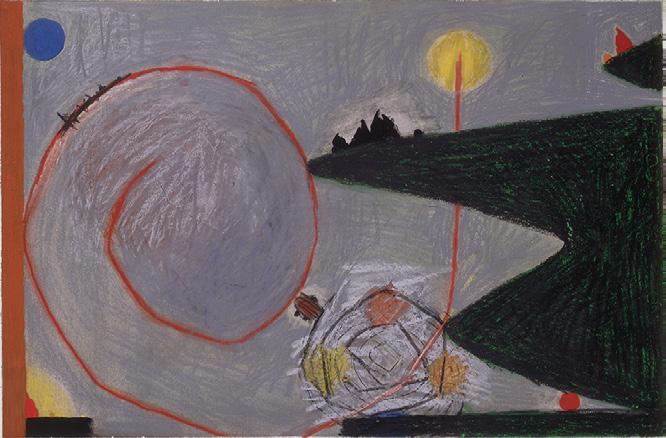


In any case, drawing has proven remarkably responsive to this conception of practice, precisely because it can be engaged in such a continuous, empirical fashion. Drawing exists in a state of endless becoming, and it represents a daily rendering of the artist’s own state, something that became even more evident in the late 1970s and early 1980s, as the drawings moved toward closer alignment with individual paintings. One also discovers in the drawings after the late 1970s that Lobdell is a gifted draftsman: his marks possess vitality and a strong, intricate personality, with the capacity to carry a great deal of information. In the sense that no Zen practitioner would regard meditation as passive—it is, in fact, very active, participating in the total experience of the moment—one feels the substantiality of engagement in Lobdell’s line. It achieves a quality of focus that reXects the concentration of the practice, and it is a line of considerable beauty.
Untitled (Skowhegan, Summer 1984)
Untitled (Skowhegan, Summer 1984)
Untitled (Skowhegan Summer 1984)
As Lobdell’s work developed during the 1980s, it continued to resist interpretation on a painting-by-painting basis, and this became one means by which it eluded submission to the limits of the frame. Unlike Still, Lobdell has never quarreled with the traditional shape of the canvas. He chose instead to overcome its inherent physical limits through repetition: the frame (whose boundary around the image also serves as a metaphor for the limitations that exert themselves in almost any endeavor) holds the image and determines its physical form, but its borders dissolve before the procession of images as one melts ineVably into the next. Lobdell was setting down an image world of his own, and its exploration would require an immense, interrelated production of drawings, prints, mixed-media works, and even occasional sculpture as well as the paintings. It is as if each has a place in a vast sequence, like the photographs in a Xash book, which produce the eVect of continuous movement as the pages are snapped from front to back.
Lobdell’s work, one feels, would perform in much the same way if it could be seen in its entirety and in order—a complex world on its own evolutionary trajectory. Characters come and go, and change; they are beings in their own right, and because of their Wgural context, the Xow of change creates an atmosphere of linkage or identiWcation among the forms in the work, human life, and by extension, the profuse, ever-changing life of nature. Consequently, Lobdell’s Wgural imagery is best approached within a context of unity, as a whole body in motion. That these Wgures do act may be of greater signiWcance than the “meaning” of the actions themselves. But questions will arise. What underlying forces move the Wgures? Do they act on their own? Or are they aVected by the actions of the forms and spaces around them? In what ways? Can we ever be certain that our interpretation of their activities is correct? Or complete? And why does interpretation matter? What, Wnally, is at stake? Do their acts exist to be interpreted, or is interpretation only a game of the observer?
Lobdell’s palette would become another indicator of the shift: yellows, blues, and greens so intense that they themselves become loci of attention in much the same way that the tar-thick blacks had done in previous decades. The bluish-greens of 6.26.92–11.6.92 Bleeker (Wg. 114) or 10.28.91–12.4.91 Bleeker (Wg. 116) are nocturnal, but their mood is silent, still, implacable, and yet the circles of yellow and white that appear across the canvases, as references to light or to additional spaces, suggest an undersea realm merging with other landscapes. Elsewhere, the blues can be regal, the yellow hues bright, sunny, inviting; when the intensity is muted, as in the monotype 8.9.91 II (Wg. 115), the color is that of a tepid, wintry sunlight. In a large canvas such as 2.22.93–4.8.93 Bleeker (Wg. 117), the color surrenders its precision, and the insinuations of pale blue and gray evoke a kind of netherworld, while the hazy spheres that appear to Xoat in the distance, deep in painted space, hint at a supernatural presence; at the same time, they resemble the glow of distant lights along the docks near Lobdell’s San Francisco studio, cloaked in a soupy nighttime fog. Largely monochromatic Welds often occur in the easel-scale paintings, placing the imagery in clariWed relief and imbuing it with warmth—certain blues or salmonlike pinks function in this way—or, among the various yellows

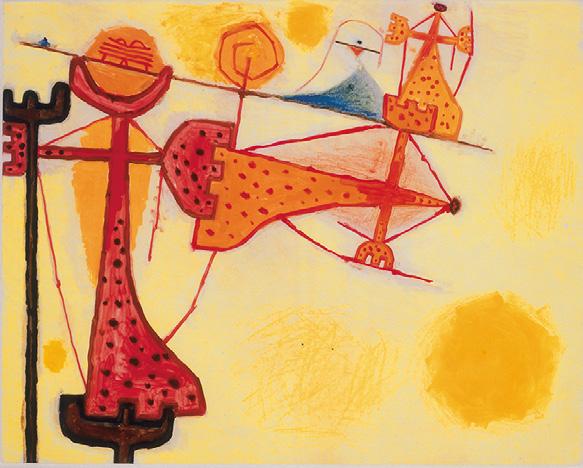
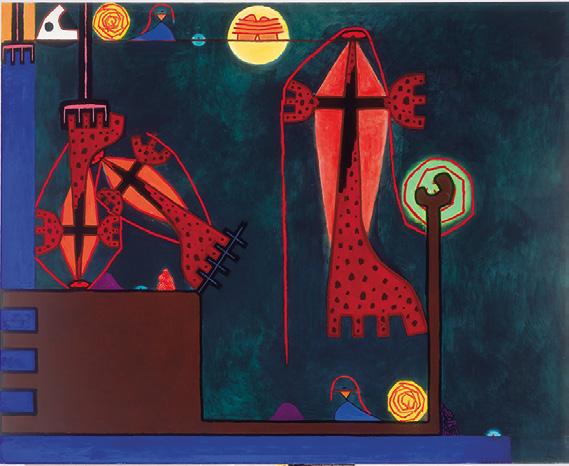

and greens, with a coolness that objectiWes the forms, as though they were specimens held up for observation. Either way, uniWed color keeps the imagery close to the surface of the painting, or seems to push it forward, against the containment of the surface, much as it did in some of the artist’s work of the late 1940s.
The actual operation of the painted space tends to reXect Lobdell’s interests at any given moment, however. At times, there is indeed a sense of “real” space, but it is a coexistent space that appears to lie “behind” the Wgures; elsewhere, it takes on strong qualities of atmosphere, and seems to seek an integration with the Wgural activity. For a period during the mid-1980s, it seemed to suggest a theatrical backdrop, separate from the Wgures, unequivocally the stuV of paint. The paint does not function merely as background, but neither does it act in a discernible way upon the Wgures; here, as elsewhere, Lobdell is constructing and investigating variants in the relationship between Wgure and ground, using the world of the canvas to explore the diVerent ways in which his formal elements meet and link. Even the paint changes after the late 1970s: the Wlm is thin, producing a smooth, unstressed surface dedicated to the image and relatively free of gesture; line, too, is most often rendered in


a straightforward, self-eVacing way. When Lobdell builds space, he works patiently, layer by layer, scraping and repainting, to create insinuations of depth and substance. Contrasts in the temperatures and values of his palette are a means of controlling and modulating these eVects. If the swampy greens and bottomless blues suggest pathways of interpretation, in the end they act as all the colors do, to shift attention toward the forms, which often seem quite indiVerent to the atmosphere in which they dwell.
Thus the heightened contrast in 11.17.98 Pier 70 (Wg. 118) deWnes a relationship between the reddish Wgure and the curvaceous dark forms to its left, while the other surrounding Wgures and circles seem to advance and recede, setting up a formal rhythm, as if the two central forms—the red Wgure especially—are swirling through the yellow space as they ascend toward the viewer. The placement of the various circles organizes the composition and provides a network of spatial events that grants each character its own “place,” a site in which its identity is isolated. By the same token, the icy Welds of 10.21.94–11.30.94 Bleeker (Wg. 119), with their soft variances of hue, highlight the large forms occupying each of the quadrants of the composition. The two upper forms are circular, while the two lower ones are (if only by inference) cubic; the frontal arrangement and formal reiterations suggest a puzzle of
some kind, but the forms themselves are static, as if literally disconnected from their environment, in striking contrast to the activity in the space around them.
Still, the nature of the space should never be taken for granted. As we discover when we approach almost any of Lobdell’s paintings, distance has given us no advantage. When we peer “into” the canvas from a close perspective, as if peering into space, the Welds reveal a tremendous amount of brushwork, subtle modulations in hue, and quiet but deliberate divisions within seemingly contained areas of color: these areas may not even be “Welds” at all, but a gathering of spaces that meet or collide with or rub against the forms, each space possessing its own inherent qualities of shape and Xow. Once again, it is a tendency that operates against conventional perspective. No “one point” can be found to assist in generating meaning within the frame. Unlike the surfaces of so many representational works, which dissolve at near view as their imagery breaks down into the abstract components of their making, Lobdell’s paintings come alive as we get closer to them. (This characteristic strikes down yet another system, the cliché of art appreciation classes that when viewers stand before a painting, they should position themselves at a distance of three times the height of the canvas in order to see the work to “best” eVect. As a viewing “technique,” it will not work deWnitively here.)
As his work in various media began moving toward a greater unity of purpose, Lobdell also began to separate his image-making into three basic stages: the drawings, the “Wnished” mixed-media pieces, and the paintings, toward which the process is directed, as a kind of summary of the concerns in each particular cycle of development or inquiry. This is a general description of his procedure, but it provides one explanation for his prodigious industry. Dozens of drawings may be necessary before an idea is prodded into motion, and more will be made as it is clariWed. This is the nature of evolution. Since the late 1970s, Lobdell has been moving among an increasingly discursive range of references. Old loyalties linger—the familiar motifs from Goya and Picasso, or the molten light of Rembrandt—but they are sunk so deeply into his consciousness that their appearance is hardly more than an echo. By now, Lobdell is collecting imagery from (among many sources) Celtic knot designs, prehistoric fertility Wgures, kilim rugs, scenes from the pottery of Mediterranean antiquity, Native American art and Eskimo totems, and seated Buddhas. As he works with these forms through many, many drawings, often over long periods of time, they are gradually absorbed into his hand. They may be simpliWed by this process, generalized, and transformed, and they may meet, link, intersect, or simply stand side by side; the compositions themselves are presentational, in that they appear to be governed by certain deWnite rules of order—there is generally a sense of up and down, for instance, of gravity, direction, placement facing the viewer—but the origins of the forms, like their associations for the artist and their actual operation within the totality of the imagery, do not avail themselves to any kind of standardized reading. Ultimately, it seems, Lobdell’s interest in the image is visual; its “original” meaning is not the basis for selection, nor is the image simply injected into

a picture, although it must undergo a passage of integration in which it is either transformed and absorbed or, in some cases, eliminated. It must prove itself as a form and sustain the artist’s Wrst spark of interest. Images are extracted from other contexts, but they come from so many sources that a radical recontextualization inevitably occurs as they enter Lobdell’s work like wanderers from faraway places, altered—physically and perhaps psychically—by their travels. The patience and care of Lobdell’s process simply assures that any juxtaposition of images will seem ineVable and sure. Each has grown accustomed to the company of the others, regardless of their initial diVerences.
The process of integration begins on paper, of course, but eventually the imagery advances from the notational sketches and the outpouring of drawings into complex ink drawings that may incorporate oil pastel or water media as editing and space-building materials, and then into larger mixed-media pictures that make use of watercolor, gouache, pastels, ink, and colored pencils. The mixed-media works slow down the image-building process, permitting the
Untitled, 1999
Untitled, 1991

development of spatial events in a manner closer to the oil paintings, but they are also distinguished by the introduction of color, which poses its own conditions and carries its own connotations into the picture. Lobdell begins with a lot of formal activity and then edits, and in many of the mixed-media works, a network of imagery remains in evidence, ghostly beneath the surface washes and the drizzle of colored pencil lines. At some point, the foundational form moves onto a canvas, though the paintings are by no means Wxed from their inception. In their early stages, the initiating motifs are gestural and fairly abstract, and modulations and adjustments to both image and color are always in eVect throughout the painting process. The key to the organization

of the painting lies in Lobdell’s responsiveness to imagery that has been so extensively developed. It is not that the painting is a known territory, but Lobdell can maintain the intensity of his involvement because he is secure in the sturdiness of the foundational aspects of the process.
And so the hand continues to reconWgure the imagery, which must remain free of conventional narrative or literary associations if it is to transcend the merely inventive. Thus, a certain Wgure may be clearly female, but she can appear in numerous states: the feet shift in size; the belly and breasts meet or overlap or are separated; the neck may be long or short; a straight line may indicate the presence of shoulders; the circles may be elaborated into concentric



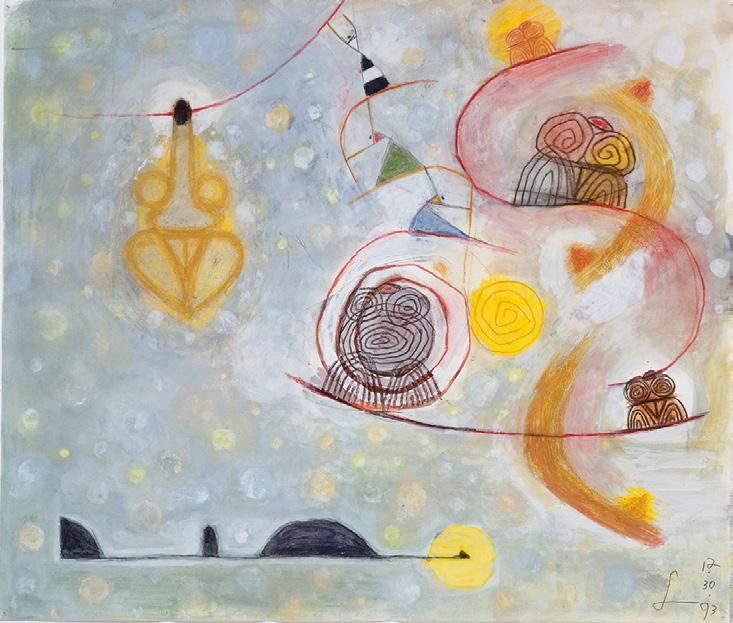
rings that may or may not overlap; or the entire body may be enshrouded in a vessel shape or, perhaps, a totem. The male forms may stand, or they may lie as if in repose, but it would be diYcult to say if this is the posture of stasis, sleep, rest, or defeat, or if it is a poised, still moment preceding some action. A kilimbased Wgure may suggest a cross, but certainly nothing as speciWc as a Christian cross; it may suggest other things, as well. Other forms serve as witnesses. Some are active, the leading players. A few appear to be representatives from elsewhere—other spaces, other landscapes, other cosmologies, other imagemaking traditions, not all of them Western. The hovering, squarish form that appears in many pictures may refer to formal garb of the samurai, or to the Xoating city that appears in one of Goya’s Quinta del Sordo murals—a place apart from the sordidness of our own brutish, violent world. In any case, we have no way to know what each conWguration means to the artist, nor what it “should” mean to us. ‘Meaning,’ such as it is, is also subject
to change. Some forms suggest diVerent meanings at diVerent times. Meaning has no more stability than anything else. There are pictures in which a variety of spaces and an entire narrative sequence appear simultaneously. Where does a story begin, or end? The imagery is mercurial, resourceful, situational. Its role, even its basic function in the picture, shifts over time, but these changes are not directed toward deliberate obfuscation. What would be the point? This is not Lobdell’s relationship with the viewer. The drawing practice is proof that his own sense of responsibility lies with the image, and so the diYculty of the imagery is not a function of its obscurity but of its originality—originality as the insistent particularity of the artist himself—not entirely free of the inXuences of life in the world, which are the inXuences we have been taught to identify and chart in the work of art, but as free as he has been able to make himself.
And yet, the continuity of the imagery within the full life of the work— as well as the life force exerted by the individual images—implies that a governing order may reveal itself in time. This, of course, holds the promise that the work contains the seeds of its own interpretation. A question, however, as Lobdell poses it, is the extent to which the key to this order can be traced through his signs to other systems of meaning, particularly systems (perspective, Wgural representation, and so on) already familiar to us. Or will the interpretive procedure eventually collapse, stalled by the indeterminacy of our conclusions? Perhaps the paintings wish to pose the recognition that uncertainty is ultimately an existential condition—a fact of life—and that symbolic systems, in art and elsewhere, can only be illusory, the wan reassurances of a certainty that may Wnally be as indeWnite as the symbols themselves. In this assertion, these paintings also establish a bridge to the grasping, unfulWlled Wgures in the paintings of the 1950s. Indeed, there is no actual division between them. They simply chart the unfolding stages in the same journey of development. But this is also a journey of understanding: understanding of what painting is, and what it does, and how it does what it does, and why.
In their ascent through Xurries of dark brushstrokes toward the light above, the Wgures of the 1950s do not actively resist archetypal aYliations; this is the very stuV of symbolism. In the end, however, they were unable to fulWll their quest for reunion or redemption—from one painting to the next, these solitary Wgures appear as if suspended in an amniotic Xuid of inWnite yearning, like characters trapped in a recurring nightmare. Because the imagery was prompted by memories inscribed upon the artist’s psyche, it suggests how completely the act of painting had become a quest to give voice to things that could not be described adequately by language, and a quest to rid himself, picture by picture, of a nightmare that haunted him still. Taken together, the arduousness of the struggle, its epic and religious overtones, and its failure, all speak of the path by which Lobdell arrived at an understanding of the inadequacy of symbolic description.
This presented a real obstruction. No matter how cathartic the art-making process may have been for the artist himself, the work as art was compromised by limitations in the readings applied to it. Nor did time necessarily expand or repair the process. More often than not, early readings continued to enmesh

the work as the years passed, casting their inXuence over subsequent responses to it. As Lobdell recognized, this was not strictly an art problem, and the shifts of the 1970s, particularly as they appear in the monotypes and mixed-media works, suggest that he was indeed preoccupied with these questions. Do interpretive Xaws reside in the symbols, whose narrative force may well have been exhausted by long usage, or in the vagaries of cultural meaning, which must pass like creased and wrinkled currency through many hands? Or do they simply reXect the limits of experience among his interpreters, a condition for which no critic can be held responsible, nor any artist control? If the Wgures of the 1950s were clearly human, however introverted and self-enclosed, many of the recent ones are barely more than stick Wgures. Direct, physical
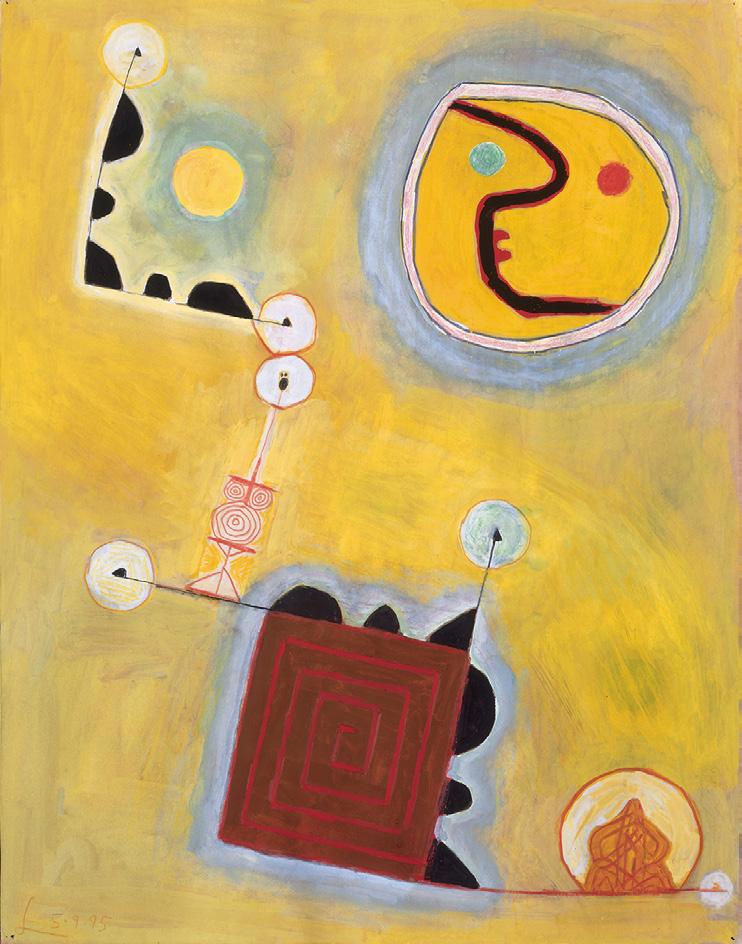

correspondence is not really possible. It must take place within the poetic imagination, the subconscious landscape of spaces and forms.
This further explains Lobdell’s sense of the image as sign rather than symbol. If his Wgures were explicitly symbolic, he might also feel the need to incorporate additional means of supporting or accommodating them, in order to state their presence and function as clearly as possible and enhance their operation as symbols. Thus the work would cloak itself in the already known. As signs, his forms are pretty much what they appear to be: schematic images that project Wgural references without initiating reXexive connections to a symbol-laden Wgurative art tradition. If they do take on certain symbolic properties in Lobdell’s hands by playing roles of their own within the world of his pictures, these associations can be said to lie outside the familiar terrain of cultural speciWcity; the artist is a participant in the culture around him, a condition he cannot hope to escape, but on the canvas, he is free to operate under—or perhaps simply to cultivate—a diVerent set of rules. His Wgures often evoke a generic or generalized atmosphere of associations from art and archeology, but the clues to their origins have been eroded by long use, while their seemingly endless capacity for reconWguration argues that meaning itself is Xuid, Xexible, continuous, unassured. Surrealism may explain this operation as a conXuence of sources from the world and the unconscious, but in the end, it fails to provide a deWnitive accounting of its eVect upon us. And yet, as if to resist the encroaching possibility of meaninglessness, Lobdell maintains his allegiance to a larger narrative, whatever it may be, as it Xows from his hand. The work itself, as a kind of daily devotion, possesses intrinsic value, which exists apart from conventions of meaning. One might think of William Faulkner’s claim to the sole proprietorship of Yoknapatawpha County: an acknowledgement of the fundamental bond between the artist and the art, one that admonishes those who would see the work of art as something other than what it is: the professor, for example, who poses a hypothetical situation to his class and then asks how a particular literary character might handle it. The question clutches at embedded meaning, but it is unanswerable, for it demonstrates a misunderstanding of the function of the character within the work. To go a step further, it denies the work of art as art, by asking art to be something it can never be. Characters are not real people, and characterization is only an aspect of a complete aesthetic construction. Life and art are not interchangeable.
Thus Lobdell resists the common modes of narrative. Perhaps the only traditional narrative element that survives intact is the basis of the work in a discursive, ongoing process. Each picture leads into the next in a ceaseless text that exhibits no particular desire for conclusion, and as a result, their truths are forever partial, or only partially disclosed; his “stories” fail to resolve into handy kernels of insight. But such is life itself, impossible to summarize or contain, try as we might: this is a fundamental recognition behind Lobdell’s late work. In its reliance upon an iconography deployed with a consistency bordering on the ritualistic, the imagery shows a self-reXexive mythic impulse, and so Lobdell’s pictorial strategies after the late 1970s can be regarded as an extension of the self-mythologizing that took place on the
canvases of the 1950s. During the 1990s, especially, much of his imagery has continued to evoke a powerful atmosphere of aspiration—and resurrection— with the elongated Wgures, the vertically directed compositions that rise from dark rectangles along the bottom of the canvas, and the springy, energetic compression that develops from the formal relationships between the central Wgural elements. The sheer range of imagery during this period thus reXects the range of Lobdell’s pictorial curiosity, just as it measures the ingenuity with which he has eluded predictable codes of reference.
Lobdell: “A lot happens without consciously determining it. These are images I can deal with, and there are associations I have with some of the images, but that’s just to start things oV. Once I’m into it and deeply involved, there’s an unconsciousness that goes to work. There’s the mystery. You never really understand what it’s about. You may think that you’re doing one thing, but unconsciously something else is happening. I’m talking to myself in the painting, actually, and what it’s about is important to me. What’s important to others, especially artists, is the use of paint to dramatize the subject. And to dramatize it, there is a whole raft of elements.”
But we will continue to interpret—we can hardly help ourselves—and the interpretive process is accompanied by a need to name the things encountered along the way. In anticipation of this process, Lobdell deXects meaning with signs that resist naming. What do you call the forms that populate his pictures? The Wsh head? The two-toned moon? The open mouth? The fertility doll? The meditating Wgure? The monster? The dancers? As labels, such terms, if they apply at all, are virtually meaningless, and inexact at best. It may be enough to say simply that the forms exist. Labels are no more than a shorthand that can never capture our experience of the Wgures themselves. Naming is bound to the construction of meaning, but here, names are themselves signs denoting the signage to which they can refer but never fully describe.
The diYculty is literally unavoidable, and almost anyone who spends time with Lobdell’s work will discover the extent to which it operates as a deWning condition: when we apply routines of reading to these paintings, we discover sooner or later that Lobdell has changed the rules. He, on the other hand, has discovered that the rules are rather less than ideal, certainly less than deWnitive. The symbolic is not divorced from experience, obviously, and it has merits, but the burden of usage will aVect its potency sooner or later, especially when diYcult, complex experience is the subject: the hoary symbols of war, the human condition, love, death, and patriotism, to note just a few, Wnally become little more than hollow signiWers or expressions of sentiment. This, it seems, is inherent in our reliance upon representation as a means of communication, since regular usage is itself a habit, a habitual way of both experiencing and describing the world. In his eVort to construct a personal “language” out of many representational languages, a process in which forms drawn from a wide variety of sources (including himself) are uniWed by the hand, Lobdell challenges the idea that any single “language” of representation can serve successfully as a kind of visual lingua franca.
On the surface, Lobdell’s imagery reiterates some of the old problems of cross-cultural reference—think of Picasso’s appropriation of African artifacts,
surrealism’s infatuation with outsider artists, or the inclusive techniques of collage and assemblage—but at the same time, he pursues this course because nothing stops him from doing so, and he does it in a way that refutes the conventional logic of appropriation as a central issue in the work. Artists are always taking up forms they did not invent, none more than representational artists. Thus, Lobdell poses a translation problem. The very idea of translation presupposes a commonality of human experience that levels diVerences in languages, symbols, and by extension, cultures themselves—that one culture can be expressed accurately in the language of another—but is this really possible?
In Lobdell, the motivation to combine and absorb imagery arises from a desire to renew and enrich his experience of art by avoiding established circuits of telling and reading. The search for forms that are not of his origination, but which have an aYnity with the characteristics of his hand, becomes a path toward his own reinvigoration of the quotidian language of Wgural painting. Why should he tell his story solely in the language of his culture? Because we encounter it almost every day, we assume, of course, that we know its meaning. But do we really? The artist is not so sure of himself, and he asks only that forms be extensible within the context of his day-to-day process. What, after all, prohibits him from using a form solely as form? Its prior history is an aspect of its life, but perhaps not its essence, not the force or the source of the stamina that will sustain it in its migration from one context to another. Forms are of the world, as the artist is, and their lives do, indeed, go on and on through time, as subject to change as anything else; words may make a similar passage, carried by the people who use them, to be introduced elsewhere, into another language, where, if they survive at all, they are subsequently (re)shaped by the complex contingencies of usage. Lobdell is connected by this strategy to predecessors such as Miró or Klee, who shaped their idiosyncratic forms from a variety of “foreign” inXuences, with intuition as the principle of governance, the highest form of authority. But even after decades, Lobdell’s language can still seem as elusive as the petroglyphs of an extinct society. We glimpse a shadow of meaning before it slips from view once more.
Meaning may, and probably does, exist in the work, but we must devise our own methods for extracting it. We are required, in fact, to reenact the cultural process of generating meaning from signs, but we must do it for ourselves, not in accordance with the standards of cultural currency, never knowing for sure if we are “right” or “wrong.” This itself is a translation of sorts, but it is translation as experience, not simply as an aYrmation of cultural assumptions. Along the way, we mirror the artist’s own procedure, but once again, there are no guarantees. Meaning is confounding in its variability, as it must always be in both art and life. In Lobdell’s case, the repetition of imagery works against rather than in support of revealed meaning. We may distinguish between darkness or light, submersion or space, the softness of an enveloping fog or the precision of manuscript illumination—for Lobdell is surely the rubricator of his own internalized text—but who would care to summarize the Wgural narrative within? It cannot be broken down in that way.
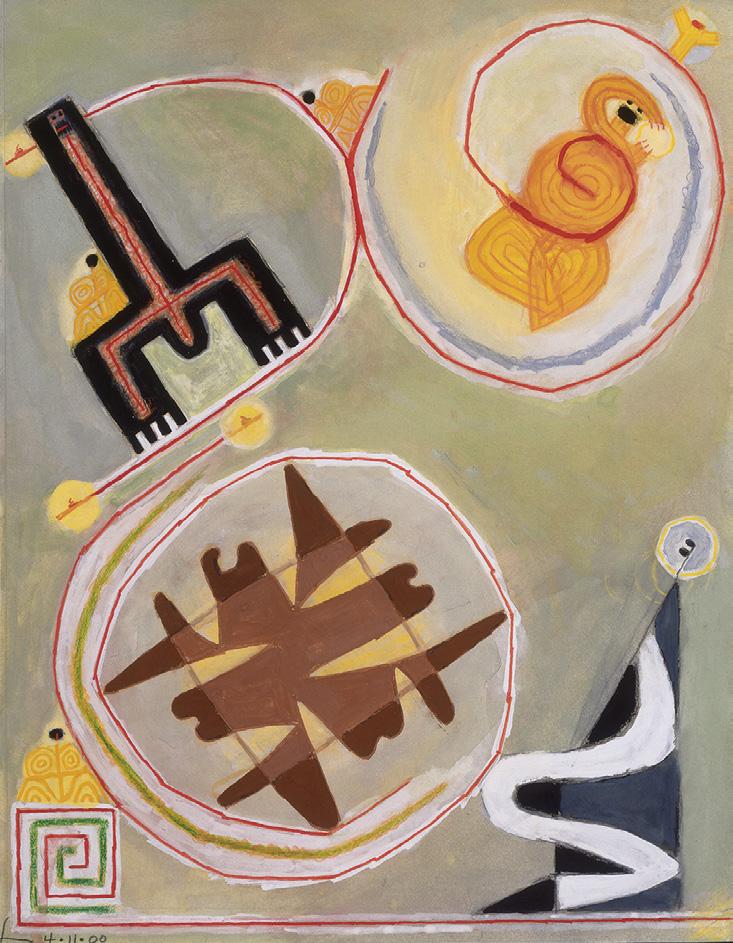

Lobdell: “There is a cast of characters, which are the images that I play with and enlarge on and bring my imagination to. I’m attempting to create a world of my own. In presenting it, there has to be a certain resourcefulness of mind as well as materials. What the painting represents is, in the end, how it’s made, the qualities of mind, imagination, and intelligence that are brought to it, the qualities of hand—the hand is deWnitely involved—and lastly, it would represent heart, but that’s hard to determine. What I’m seeking may be an impossibility, but it’s important to keep trying.”
In the end, space is still a crucial ingredient. In canvases such as Untitled, Spring 1989 (Wg. 131) or Untitled, Summer 1989 (Wg. 132), Lobdell builds a network of frames (echoing the tilted, cubist Welds of the Dance series) that denote a sequence of spaces within the borders of the paintings themselves; in the latter painting, a kind of proscenium “landscape” forms a border along the bottom of the picture, a clue to how the spatial events in the work might be looked at, while the “interior” of the image generates at least three distinct pictorial levels. Two are distinguished by slight alterations in the values of the yellow tones, and a third, just oV-center, is dark blue, integrated with the rest of the image (as in the former painting) with a wavy line that snakes along its edge, as if sewing it into the picture. The Wgures that dance across the bottom of this painting glance back to the Wgures of the Dance series, but here they may be either audience or witness, or both, or neither. The Wgure within the blue rectangle is by now another familiar form, and it will remain so, lending the work a ritual aspect, as did the dancing forms two decades earlier. This is presentational imagery, a collection of forms placed on display in a spatial setting complicated—and idiosyncratic—enough to suggest that space, too, has its duties to perform.
The plot thickens elsewhere. In 10.28.91–12.4.91 Bleeker (Wg. 116) or 2.22.93–4.8.93 Bleeker (Wg. 117), for example, the pictorial space is not only “deep” but feels active, although it does not really come forward to envelop the Wgures, which perform very close to the paint surface. The Wgures appear to occupy a space no thicker than the paint required to put them there; they have come as far forward as they can, and ‘backward’ does not seem to be an option. This eVect reveals another characteristic of Lobdell’s visual world, that space is not a totalizing environment and will not necessarily be called upon to perform the task of enclosing or unifying an image: once again, uniWcation may be an adjunct of readily readable meaning. In Lobdell’s spaces, natural law may not apply, nor are its characteristic modes of enactment replicated, as they might be in a more conventionally representational work. When space is placed at a distance, the eVect is one of deWnite disjunction, and if the Wgures do, in fact, occupy a space of their own, then the two kinds of spaces suggest a laminate, another way in which the artist may describe coexistent spaces in the painted image.
In their early stages, Lobdell’s canvases tend to be extremely gestural: he sets down a rudimentary imprint of form and space in a style that brings to mind some of the familiar traditions of abstract expressionism. And strictly speaking, the space is an art space, one that exists only in two dimensions. But
just as the grid of a Wxed perspective denotes one (philosophical) conception of order, Lobdell’s spaces denote another. When we encounter it, conventional perspective always tells us a great deal about the hand behind the work, and about the mind (or will) behind the hand, but Lobdell does not make himself known in this manner. It would be incorrect to suggest that his spaces are undiVerentiated, even on those occasions in which space appears as a kind of ribbon, carrying form upon its surface in scroll-like fashion; rather, space is subject to a range of diVerentiation, sometimes simultaneously, it seems, or rediVerentiation, linked to the artist’s careful modulations of form. But what lies behind this indeterminacy? We long for a clear, incontrovertible answer from Lobdell himself. Following James Joyce’s artist, however, the hand governing the Wgures, “like the God of the creation, remains within or behind or beyond or above his handiwork, invisible, reWned out of existence, indiVerent, paring his Wngernails.” Even though the overall composition has been brought into a state of balance, our eyes Wnd no true place of rest. Lobdell’s preferred image has many focal points, and none. As in the grid paintings of the 1940s, there is a feeling that rest can be dangerous, that the place of rest is exactly where meaning begins to accrue. In the moment of pause, the ordering process is already underway.
Almost every member of Lobdell’s cast of Wgures has something of the objectivity of a logo. Once again, Joyce’s artist comes to mind: “The personality of the artist, at Wrst a cry or cadence or a mood and then a Xuid and lambent narrative, Wnally reWnes itself out of existence, impersonalizes itself, so to speak.” Lobdell does not expect the Wgure to act as a surrogate of himself, nor does he wish it to; it may speak for him, but it is not him, and should never be regarded as an expressive agent of the artist’s self. At the same time, he has almost completely erased the idea of the Wgure as a “character,” a construction assembled from available, recognizable characteristics for the purpose of embodying deWnite thematic motives. Like the lists of characters that are sometimes included at the beginning of densely populated nineteenthcentury novels, Wgural variety reXects the breadth of the artist’s undertaking and his prodigious industry, his ambition to include as much as he can of his world in the work. But the characters themselves are mute. We often remark that certain paintings “speak” to us, but in fact it is our own speech that we hear. In Lobdell’s work, the silence can be forbidding, although it is primarily the silence of the painted image, placed into service as an element of the work, a literal refusal on the part of the forms to say anything speciWc about themselves: without this information, their importance to the artist cannot be measured by conventions of relative scale, for example, or the inclusion of well-established signiWers, or where and how they are placed within the composition. No one Wgure appears to be either substantially more signiWcant than the others, or more central. A small form, seated inconspicuously in the corner of a painting, may play as important a role in the narrative as one of the larger forms. This is a subversive tendency, a rebellion against the reXexes of systemic perspective, but at the same time, it instates a diVerent order, a diVerent kind of perspective.
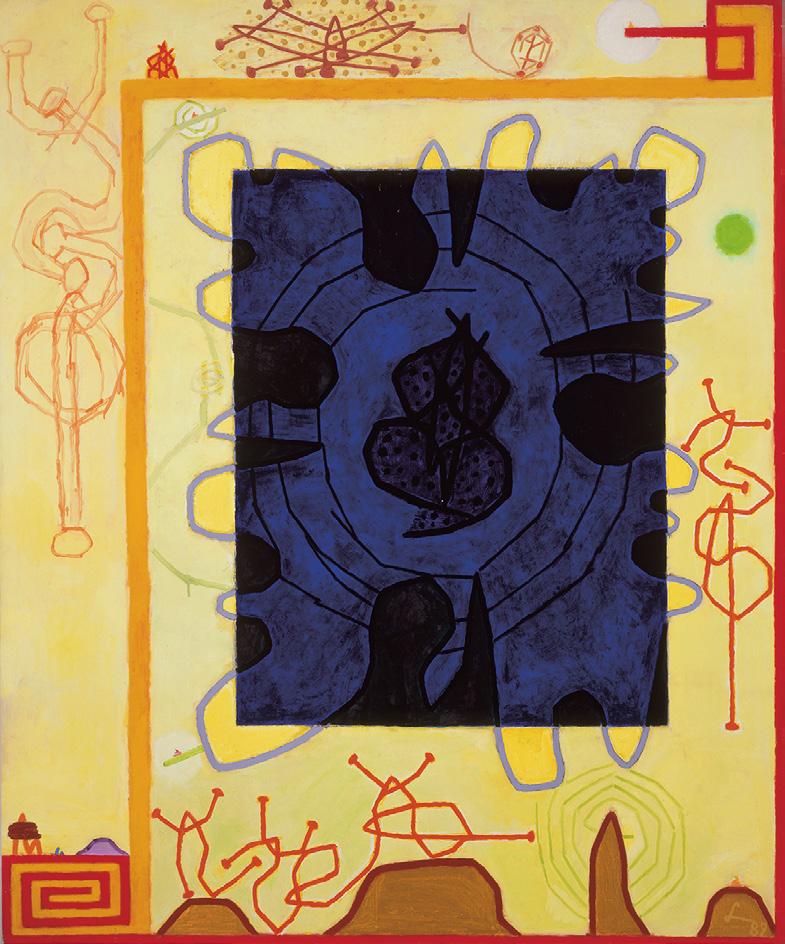
For Lobdell, the lives of his Wgures are bound intimately to his own, and to his direct involvement with them. Even after his retirement, when he was conWned to a hospital bed following surgery, he continued to Wll small sketchbooks with hundreds of drawings. It is endless, a process that recalls Umberto Eco’s explanatory postscript to The Name of the Rose, which is itself an epic, labyrinthine inquiry into sign and meaning: “I wrote the novel because I had a yen to do so. I believe this is suYcient reason to set out to tell a story. Man is a storytelling animal by nature.” After so many years, Lobdell seems to Wnd a suYciency in the act of telling. Pace, rhythm, form, sequence, all follow from that impulse, and they emerge from the ceaseless operation of the hand. In a way, Lobdell has only pursued one of the clichés of Wction: a story begins when characters are placed together in a setting.
And yet, the Wgures can be as impersonal as any corporate logo. Four or Wve of them, or more, may appear in a single painting—not “Wgures” as Diebenkorn or BischoV might have deWned the term, but Wgural just the same—and although they appear to interact, their codes of behavior function primarily within the speciWc demands of the painting. They coexist, and because they seem vaguely familiar somehow, we often feel instinctively that they are readable. Each is cloaked in an atmosphere of reference—there may be traces of archetype, anthropology, aboriginal Wgures, the archaic—just as each extends a promise of reference without actually fulWlling it. Meaning is altered by transformation, and the capacity for continual transformation is an essential feature of Lobdell’s formal population, with the eVect that the fecundity and the evolutionary spread of his process resemble the tireless processes of nature without resembling the most familiar forms of life.
But here is the surrealist legacy once more: these forms, which are characterized by both a multiplicity and nonspeciWcity of reference, challenge the faith that all things can be known, or that they should be. Like the logo—or any system of perspective, for that matter—Lobdell’s forms can be reiterated from setting to setting, intentionally so, although iteration does not act as an aYrmative, stabilizing device here, or it is not primarily that. As much as anything else, it simply extends the potential for continuation. If this implies a certain stability, it is not stability as a service performed by a system of visual organization to the values of the culture around it. Lobdell aYrms his own continuity, and that is all, but clearly it is enough, for it represents a triumph of perseverance and conviction.
For all their neutrality, Lobdell’s Wgures possess identities—some are gendered, others may appear as witnesses or guardians, a few are totemic—and they are neither static nor inert. In Lobdell’s most recent paintings, a prone Wgure appears within a dark rectangle at the bottom of the frame, clearly an image of mortality. As other Wgures rise above it, they may recall the Wgurative gestures of the 1950s, but the nature of the present resurrection is less apparent, as is its success or failure. The prone and rising Wgures may coexist in a kind of stop-time—the story is presented in its entirety on the surface of the canvas, all at once, alpha and omega, not in chronological sequence. The painting contains time as well as space, but a question, as always, is how much time, and how much space, and where does each begin and end?

In most, perhaps all, of these paintings, a great deal of attention is devoted to line, which appears in one form or another in every image: drawing exerts itself in the painting process in an almost literal way. In the paintings, line has a number of functions, but the most obvious, and perhaps the most important, is connective. These connections can be literal. They touch the forms, and in so doing, they establish relationships among the forms and suggest ways of thinking about them. By extension, they also operate spatially, linking the various spaces that occur around the surface of the painting, and occasionally providing a platform for one character or another. Because they are like lines on a road map, contiguous with the surface of the painting and only occasionally oVering strong intimations of depth, they lead the eye, and this movement— as in the canvases of the 1940s—assists in dissolving the possibility of an ideal perspective. For this reason, the line is rarely straight. It may appear as a spiral, or it may be full of curves, snapping through an image, as it does in the female Wgure on the right side of 3.15.99 Pier 70 (Wg. 133), or it may turn suddenly, as if correcting its course. The movement of the line assures, however, that no Wgures remain isolated. There is a network, a web of being, an unfolding action, a sense of time passing, perhaps even a narrative. In an echo of the Dance series, the male and female Wgures of the later work, especially during the 1990s, engage in a kind of minuet—their scale shifts and their relative positions change, while other Wgures pass around them.

In 2.22.93–4.8.93 Bleeker (Wg. 117), a more intricate and theatrical work, a red line stretches across the canvas, making an almost complete journey from side to side, connecting most (but not all) of the Wgures, forms, and disklike spaces: it suggests a narrative line, a token of the artist’s function as narrator. It is subject to gravity, rolling over circles, dipping, hanging. When it breaks, as it does on the right side of the canvas, it resumes shortly, seeking connections to other forms. At one point, it serves—as it also does in 6.26.92–11.6.92 Bleeker (Wg. 114) or 12.30.93–2.3.94 Pier 70 (Wg. 134)—as a surface upon which the Wgures sit. In all of these instances, the Wgure is a kind of hybrid, loosely aYliated with both fertility forms and the seated Buddha, and with some of Lobdell’s previous forms, but when it appears on the line, enclosed in a circle, the dimensionality of both form and line is altered. Is the form thin or the line thick? Are these sorts of descriptive categories even relevant in this setting?
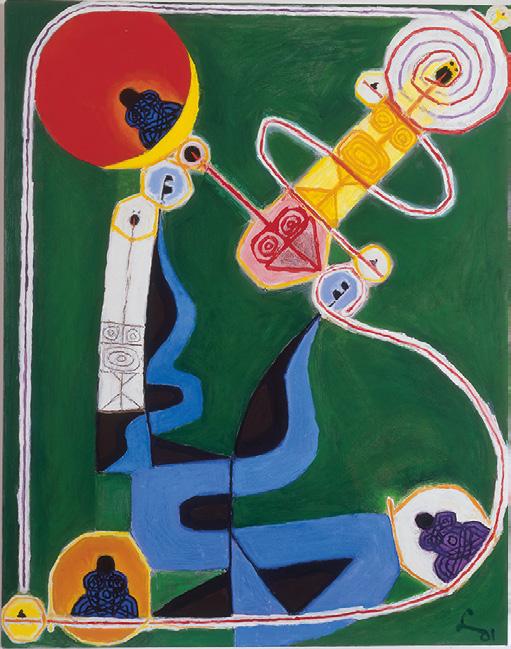
Does the circle constitute another space, or an opening between spaces, or is it a diVerent sort of sign altogether? Lobdell’s imagery seems most dreamlike in images such as these, and the line most unitary. Line rather than space links and organizes the various elements of the imagery. But there are other linkages at play, too: in 2.22.93–4.8.93 Bleeker, we follow the blue band down the left side of the canvas and along the lower edge, and the adjacent snakelike band that drops from the upper edge makes a sharp right turn along the bottom, then rises to intersect with a reddish, guardianlike Wgural form on the right.
Elsewhere—in 10.28.91–12.4.91 Bleeker (Wg. 116) and 10.21.94–11.30.94 Bleeker (Wg. 119)—the line appears to be gathered on a spool from which it is unraveling, whether at the hands of one of the weavers in the latter, or simply because it has become entangled with one of the forms, as in the former. More
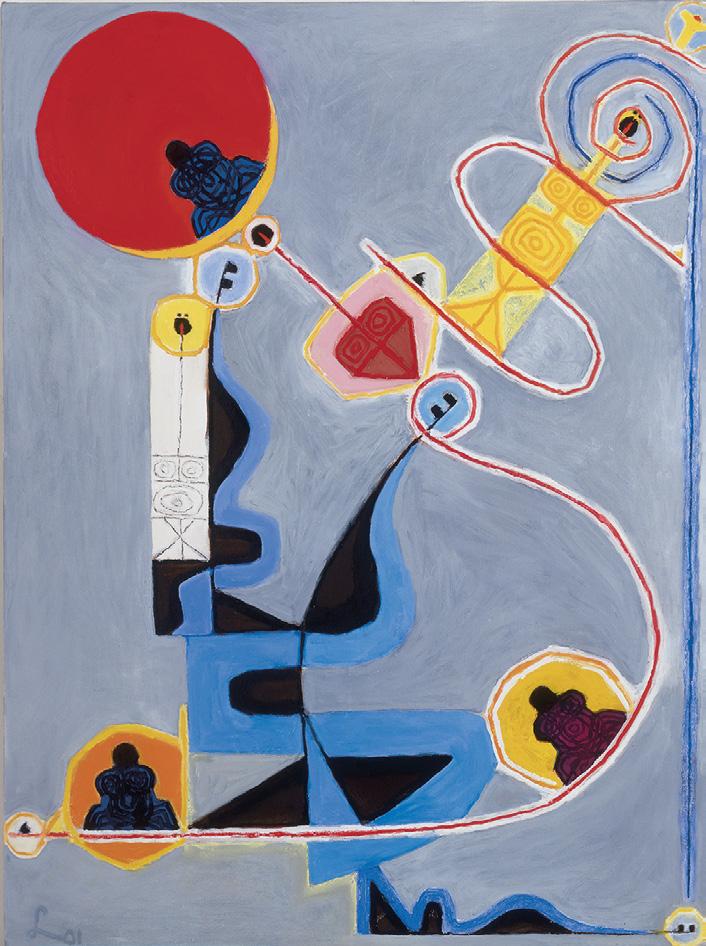

recently, in Pier 70 Summer I 2001 (Wg. 135) or Pier 70 Summer II 2001 (Wg. 136), the line moves around the edges of the canvas, as if to oVset the geometric symmetries of the composition. Along the way, their connective movement establishes further relationships among the Wgures and formal elements. These works—and the imagery they contain—are both more “abstract” and more “Wgural” than many of their predecessors, complex compositions that generate a springlike tension using formal networks that recall Australian aboriginal painting. A line intersects and connects all the Wgures and compositional subsections to each other, and to the extent that the paintings are fragments of scenery, they suggest a cycle of compression and release— another mirror of nature’s process.
The lines also fragment and multiply, framing and surrounding, ordering and reordering space. They pass through or over circles that dot the canvases, introducing new zones into the space of the image, like portholes or passageways to somewhere else. Lobdell has been reWning this motif for decades, opening it to additional functions. The line, however, suggests that he himself still skirts the matter of fulWllment. Though a spiral may originate in light, we can never ascertain whether the end of the line indicates a conclusion or a beginning, or if such distinctions even matter. The line is on a journey, too— slow, patient, not always well marked, but persistent. When paintings are clustered chronologically, as they are in Pier 70 Summer I 2001, Pier 70 Summer II 2001, and Pier 70 Summer III 2001 (Wgs. 135–37) for instance, the process is easily observed. From painting to painting, the color Weld changes from green to deep blue to a pale, powdery blue, though certain lines and forms remain constant, such as the wide, curving line that sweeps across the bottom of the image and up the right side to snake toward the center of the canvas, or the red sphere in the upper left corner, with its golden, crescent-shaped base, and the dark Wgure seated upon it. Other Wgures stretch or shrink, while the black and blue forms that seem to rise from the bottom of the image are transformed, like growing things.
It Wnally becomes evident that the many entangled lines tie the end to the beginning, and both to everything in between, so that each painting and each drawing resonates within an entirety. One can chart the way in which the Wgure with its arms outstretched, once so evocative of Goya and Picasso, becomes a “cross,” which in turn becomes an interlocking, keylike form that seems to grip a surrounding line in the shape of an old-fashioned coYn or the ropes on a ship’s mast; or the way in which the upturned mouth, with its sharp little teeth and dagger-shaped tongue, becomes a smooth crescent mounted on the top of a columnar shaft; or the way in which the large-footed Wgure of the paintings of the mid-1960s is echoed formally, like a distant ancestor, in many of the Wgures of the 1990s. In the wonderland of Lobdell’s paintings, nothing is created or destroyed. That much, it seems, is a matter of immutable necessity. Forms simply return, summoned by the artist across time, to be reconWgured by the intervening years.
It would be difficult, even for Lobdell himself, to calculate the eVects of his decision to remain in the Bay Area. If a Wgurative expressionism did not exactly Xourish among painters in New York during the 1950s, it maintained a presence there, but one wonders how comfortable Lobdell would have been on the East Coast: the Werce antagonism that greeted the expressionistic Wguration of Peter Selz’s New Images of Man at the Museum of Modern Art in 1959 reveals the extent to which critics and artists alike had taken sides on the issue, and the degree to which abstraction was regarded, at least for the moment, not only as a national style but as the only credible progressive mode. It almost certainly would have been a stultifying atmosphere for him.
In the Bay Area during the postwar decade, authenticity of voice was a primary virtue, and for an artist of Lobdell’s inclinations, what sort of setting
could have been more accommodating than that? By the early 1950s, as the initial wave of enthusiasm for abstract expressionism began to subside, neither abstraction nor Wguration commanded the scene on the West Coast, and in any case, the zone between them was easily traversed. Advocates of one or the other can be easily found, but just as many artists were using both. And too much can be made of the Bay Area Wgurative movement as a local occurrence—it was not a group whose members shared a uniform conception of the Wgure in art, nor was it as inXuential as some subsequent claims for it have suggested. In the end, any historical account only assists in describing a local environment of variety and openness. During the late 1950s, when Lobdell and BischoV worked side by side on the faculty at the San Francisco Art Institute, students still lined up behind the “abs” or the “Wgs,” but in practice, the work of the era demonstrates that barriers between the two modes barely existed, a condition that continued well into the 1960s and beyond: this is evident in the work of Jess Collins, Roy de Forest, William Wiley, and Joan Brown, among others. Lobdell is darker and more ferocious than most, but in his work, as in that of many of his contemporaries, the artist’s geographical placement can be translated as the freedom to adjust the presence of artcritical ideology in the work as he wished, or to avoid it altogether, as quite a few artists did.
In any case, Lobdell has operated intuitively. As much as any other factor, this accounts for the consistency of his concerns as they occur throughout a career of more than half a century. He could hardly have plotted so steady a course for himself from the beginning. It reXects, rather, the artist who has been there from the start—the same artist who responded so strongly to Guernica in 1940. Intrinsic to the undertaking has been a quest to understand the process by which meaning is generated from the signiWers of human culture, but Lobdell has never penetrated “meaning,” nor has he presumed to do so: this is not his obligation. In his rejection of the easy, reassuring truths of acculturated meaning, he has sought a place where ideas of “process,” “nature,” and “meaning” are indistinguishable from each other. “Meaning,” like everything else, dwells amid the ever-changing phenomena of existence. Lobell’s work reXects the operation of life, and whatever may be inferred from it cannot be separated from the continual process of an unfolding creation.
Bruce Nixon, an independent scholar, has written extensively about contemporary California artists. He is formerly editor-in-chief of Artweek.
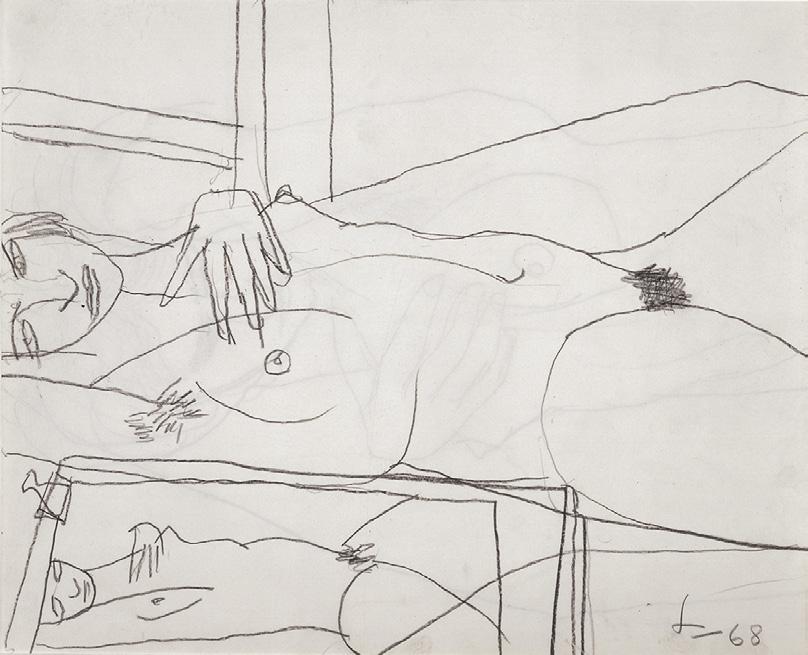
Beautiful colors can be bought in the shops on the Rialto, but good drawing can only be brought from the casket of the artist’s talent with patient study and nights without sleep.
—Tintoretto
Noted in Carlo RidolW, Life of Tintoretto (1642)v
Like so much of the quality in life, the creation of art is too often taken for granted by the majority who have no idea of the process behind the product. It is not that labor and eVort have to be evident and acknowledged. In fact, as James McNeill Whistler tartly observed, “A picture is Wnished when all trace of the means used to bring about the end has disappeared.” But how does the artist reach the level of competence where his ability bears fruit in consistent achievement? Not far from the truth is the old joke about a stranger in New York City asking a passerby, “How do you get to Carnegie Hall?” The ironic reply: “Practice, practice.” Sharpening and reWning the creative tools needed to be the best at one’s endeavor is a necessity. Tennis players serve, jazz musicians jam, and artists draw.
The obvious question is: why would Frank Lobdell, a distinguished abstract artist, submit to the rigor of weekly drawing sessions from a model? This was not to be some short-term experiment, but an ongoing activity that began in 1959, when he was invited to become the third member of a group that included Elmer BischoV and Richard Diebenkorn, and which lasted until 1964. With his appointment to a teaching position at Stanford University in 1966, Lobdell continued the routine of drawing sessions with his new colleague Nathan Oliveira, often joined by Keith Boyle and Jim Johnson. This activity lasted until 1974, when Lobdell returned to working entirely in abstraction.
The answer to the question of Lobdell’s reasons for joining a drawing group is both multilayered and logical. Most artists by choice and necessity work alone, which is conducive to concentration but often produces a sense of isolation. The opportunity to join a group allowed Lobdell to break his selfimposed seclusion through creative interplay with convivial peers. The lot of



the artist is not an easy one, and the weekly reinforcement of mutual purpose with fellow artists should not be underestimated.
To an artist, a human being is both the most natural subject matter and also the most elusive. A look, a gesture, a shift in body language can reveal or obscure. Removing clothes, the social armor of our society, completes the challenge. Nakedness adds to the mix the element of sexuality if not the possibility of eroticism.
Access to a model was the common purpose for the sessions. Her presence was the beginning of a process. The direction each artist took from week to week, however, was particular to his individual moods and creative needs. Pablo Picasso spoke of this matter: “Ideas are just simple points of departure. . . . As soon as I set to work, others seem to Xow from the pen. To know what you want to draw, you have to begin drawing it. . . . There’s an old Spanish proverb: ‘If it has a beard, it’s a man; if it doesn’t have a beard, it’s a woman.’ . . . When I have a blank sheet of paper in front of me, it runs through my head all the time. Despite any will I may have in the matter, what I express interests me more than my ideas.” w




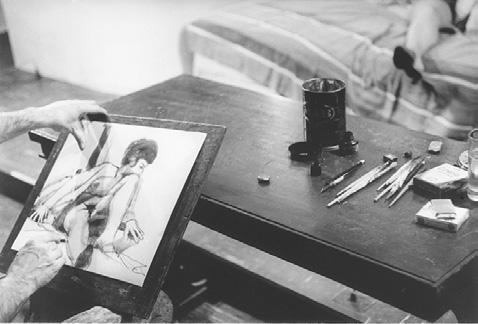






Frank Lobdell’s nudes are loose women . . . not literally but Wguratively. They Xow across the beds on which they are posed; spill out of the chairs in which they lounge. He juxtaposes the curves of hips, breasts, and buttocks against the geometry of furniture. The starkness of Xesh is achieved through the use of the untouched or lightly washed paper against the dark-washed background interiors. There is an unabashed sensuality and spirit to these women. The eroticism comes in part because they are not depicted as individuals but as a universal female presence both natural, alluring, and somewhat dangerous.
above left
8. Untitled, 1972
above right
9. Untitled, 1974
below
10. Untitled, 1968

It is easy to see how the energy and activity from drawing the posed model would inform and reWne Lobdell’s abstract work, for the parallels are obvious. The circles of breasts and nipples, the dark triangle of the female sex, the squares and rectangles of furniture all merge the geometric and the real. The “take a chance” quality of these sessions was remarkable. It can be seen in the creative choice of poses, the arrangements of props, from beds and chairs to mirrors and patterned cloth backdrops. It can also be seen in the choice of drawing materials and the degree of Wnish in the works. Sometimes they were dense, reWned, almost formal, and, at other times, slight, spontaneous, and liquid. Each week was a new beginning with no expectations, only possibilities.
If there was a single word to describe the purpose of these drawing sessions, it would be freedom . . . freedom to seek, freedom to Wnd, freedom to experiment, freedom to fail. It is important to articulate that Lobdell and his fellow participants were not creating art at those sessions. Instead, they were engaging in the activity of drawing. It is crucial to be able to work at one’s craft without the prospect of outside evaluation and the preoccupation of creating a commodity.

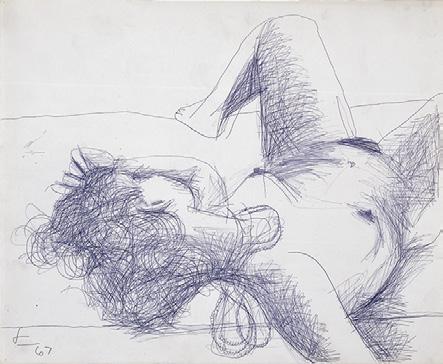
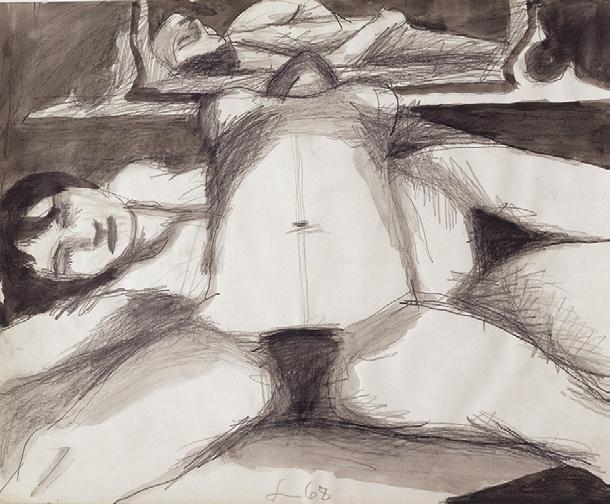

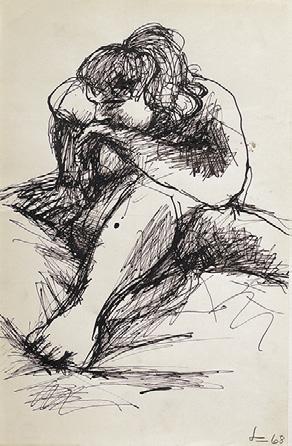



Long after the ink had dried and a drawing session had become a memory except for the marks left on the sheets of paper, Lobdell could review the record of his activity. He could judiciously reXect as to which sheets he should tear up, which to put aside for further consideration, and which deserved to be signed and dated, and only at that moment become works of art by Frank Lobdell.
Robert Flynn Johnson is Curator-in-Charge, Achenbach Foundation for Graphic Arts, Fine Arts Museums of San Francisco.
Notes
1.

Every Thursday Night
In 1959, a simple invitation to join some friends at a weekly drawing session would prove an important aesthetic opportunity for Frank Lobdell. Just as his earlier decision to return to San Francisco rather than New York City following his study in Paris had Wxed the course of his professional life, Elmer BischoV’s invitation to join him and Richard Diebenkorn in their drawing sessions would provide Lobdell with both intellectual reinforcement and a sympathetic venue where he could begin to develop a new formal vocabulary. Until that point in time, drawing had assumed a decidedly secondary role in the generation of his gestural abstract paintings, which were emerging from the inXuence of his friend and mentor ClyVord Still. For Lobdell, drawing would come to be a passion into the present. He begins every day in the studio and ends every day at home making sketches on a drawing pad. Drawing has moved from academic exercise into the very core of his artistic process to become Lobdell’s primary means of Wnding form and voicing emotion, a “dialogue for myself, to myself. If someone else overhears it, that’s okay.”

above
The Thursday night drawing sessions Lobdell joined had their beginnings in the early 1950s as weekly studio visits among David Park, Elmer BischoV, and also Richard Diebenkorn after he returned to the Bay Area in 1953. They had all been friends since the late 1940s, and the occasional sketching from a nude model at one or another of their studios evolved into a weekly routine of drawing and lively discussions about painting. David Park’s eventual withdrawal from the group because of failing health led BischoV to invite Lobdell to take his place. All three were instructors at the California School of Fine Arts (CSFA). The Thursday night sessions provided them an excellent forum for moving back into the serious work of their studio practice; they were especially convenient for BischoV and Lobdell, who had classes scheduled only on Monday and Wednesday. The sessions gave them mutual support and proved to be an important social time as well as occasions for ongoing dialogue.





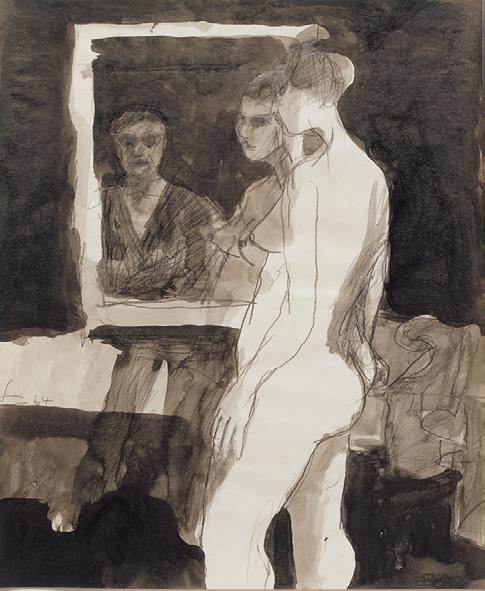

These Thursday evenings assumed an easygoing but surprisingly Wxed routine. Because both BischoV and Diebenkorn’s studios and homes were in the East Bay, but Lobdell’s studio in the old AudiVred Building was in downtown San Francisco at the bottom of Market Street, the group met there less often. BischoV would arrange for the models from the professional models’ guild, and the three artists would show up at the appointed studio for a drink or two around 6 p.m. They ducked out to a neighborhood cafe for supper, then returned to the studio to meet the model around 7 or 7:30 and drew until 10–10:30 p.m. To assure a maximum amount of drawing time, the models were asked to take only one long break during the evening, rather than short breaks between each pose. The artists all used a full range of drawing materials, including charcoal, lead pencils, India ink, and even ballpoint pens. BischoV had some preference for charcoal, and Diebenkorn and Lobdell tended to favor India ink with steel or bamboo pens and brushes for applying washes.







Because life-drawing sessions generally tend to reXect a generic kind of Wgure drawing, it is interesting to note that some of the unique qualities of the works the three artists produced in these sessions are attributable to the studio settings. It is often possible, if not to date the drawings precisely, at least to locate in which studio the drawing was made by the setting and props around the Wgure, as the studios were distinctively outWtted. Diebenkorn’s studio in the Triangle Building, in Oakland, had a wrapped-cane armchair and an old, woven string or rattan couch with striped fabric pillows and a throw on which the model was often posed. The fabrics and wicker textures impart a certain echo of Matisse’s idyllic Mediterranean works, at least in the drawings of Diebenkorn, for whom Henri Matisse was a lifelong inspiration. The same striped fabrics and props in Lobdell’s drawings, however, become aggressive directional patterns and shadowy force Welds.
opposite above left
11.
1965
above right
12.
below left
1964
below right
14.
above
1965
15. Untitled, 1968




1965 above left
above right
18.
below
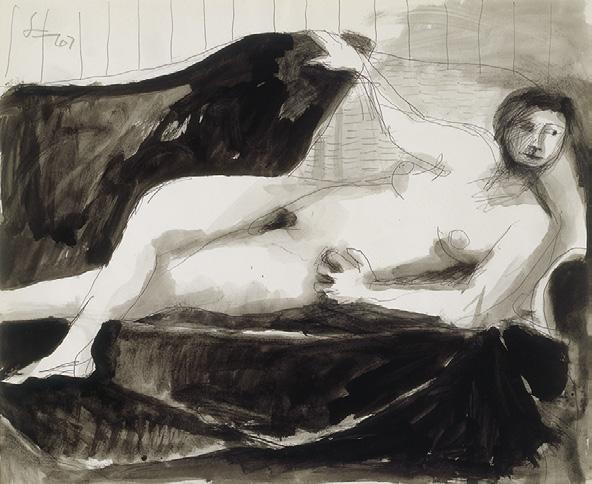


20. Untitled, 1967
22. Untitled, 1965


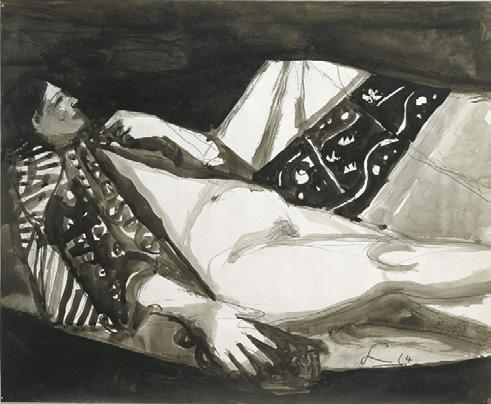

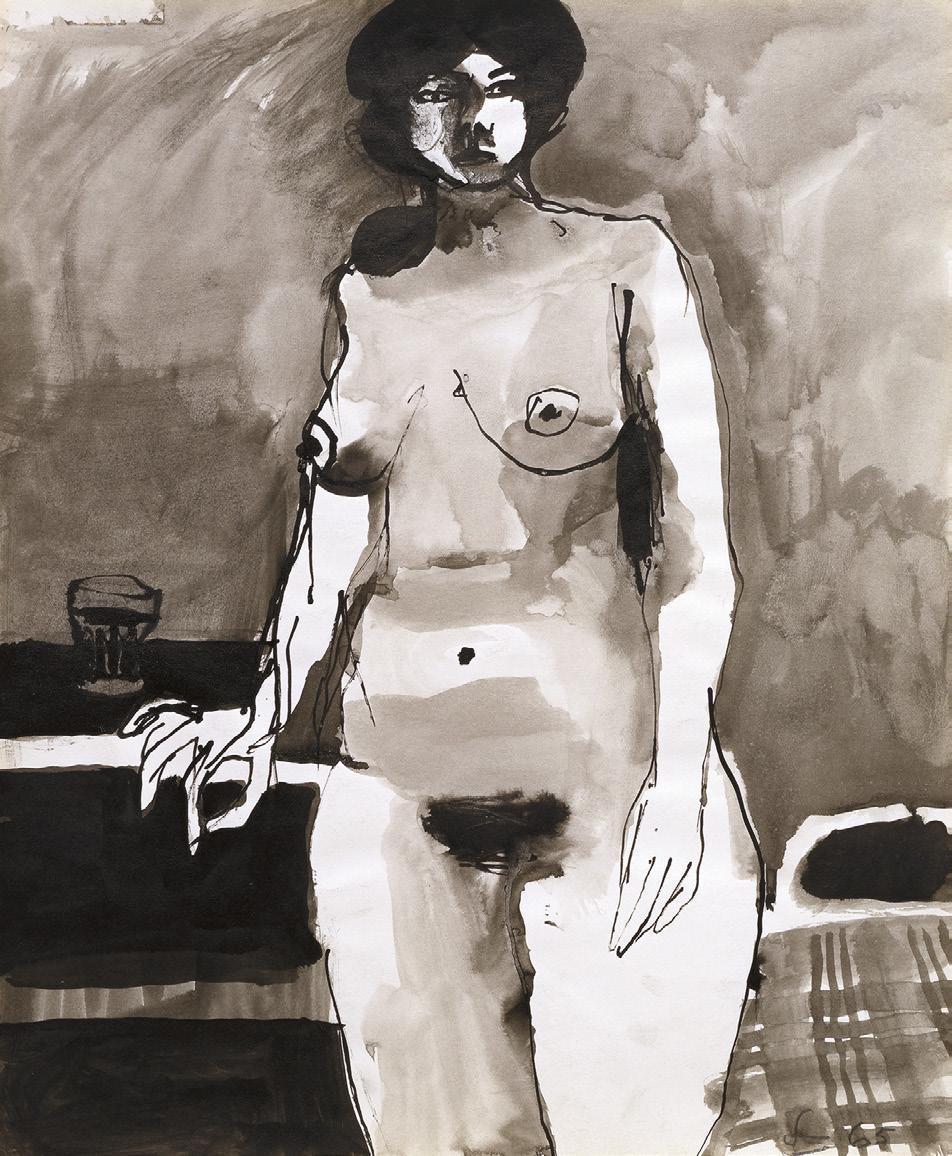
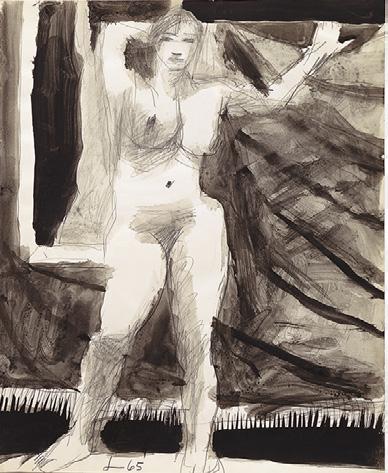
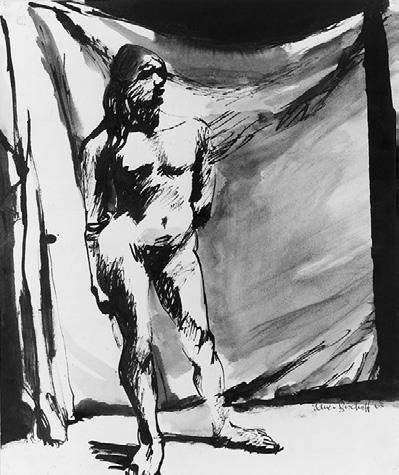
Elmer BischoV’s studio in an old organ factory on Shattuck Avenue, in Berkeley, featured a 1930s wooden dresser with mirror, a daybed with a tartan cover, and across one end of the studio, a taut wire on which to hang various backdrop fabrics, mirrors, or over which the model could throw her arm in a standing pose. The model set-ups in BischoV’s studio, with the possibilities presented by the wire and various layers of fabric and mirror reXections, often resulted over the years in the most spatially complex drawings of the sessions.
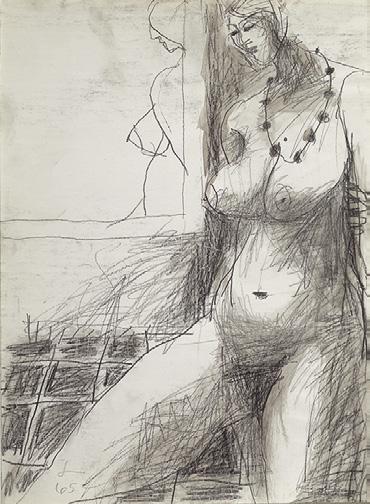









Lobdell’s studio on the top Xoor of the Victorian-era AudiVred Building had tongue-in-groove wainscoting that appears in the artists’ drawings, as does an old leather upholstered chair with turned legs, padded arms, and button-tucked back. There is also a wooden chair of square proportions with cross-braced arms into which the model often appears to be tucked or slouched.



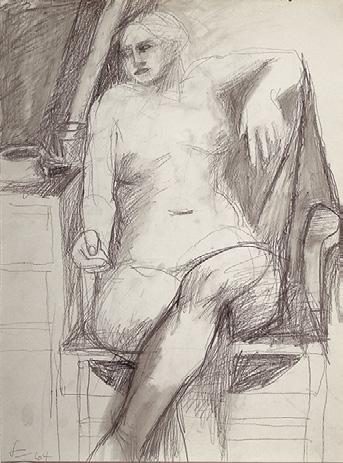
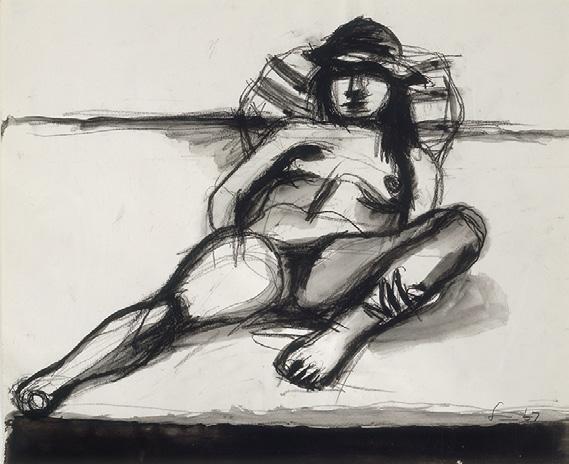


Another identiWable site in these men’s drawings is the Danville, California, house and property that belonged to BischoV’s family, and to which the trio repaired with a couple of models for two or three weekend sessions à la Manet and Le Déjeuner sur l’herbe (1863). These drawings of nude models with Xoppy sun hats disporting themselves on the grass have a carefree quality unseen in the more sedentary and quiet studio-based works.
1965


The Thursday evening sessions served diVerent purposes for each artist. BischoV and Diebenkorn were in the midst of their active engagement with Bay Area Wguration, a school of work that, along with David Park, they had brought to national prominence. These evenings of drawing clearly provided a useful tool for them to discover or reWne compositional problems in their Wgurative paintings of the time. BischoV enjoyed a reputation as a talker, and the evenings he spent with two of his best friends were the perfect opportunity to discuss art and argue about the issues of representation and abstraction in painting that were so much a part of artists’ and critics’ dialogue in the later 1950s and early 1960s.
For Lobdell, the evenings served a diVerent though related purpose, in that he saw himself Wrst and foremost as an abstract artist and used the practice of drawing the Wgure as a way to develop a vocabulary of shape that could convey an emotional or erotic charge. He approached these Thursday evenings with the intention of pursuing a speciWc goal or interest, and he used the model as a vehicle to explore attitudes of making imagery and new ways of working with materials, as “a means of investigating where I haven’t been before. I had to think about a goal—my interest—for the night.” As a result, Lobdell would often rapidly produce two or three drawings oV of a single pose, dropping the wet sheets to the Xoor during the session, while BischoV would develop a single, more complete, and conventionally rendered work. Afterward, Lobdell would collect his ten to twelve drawings from the session and stack them away in the studio, unsigned and undated, to sort through another day. He generally didn’t rework any of the drawings later, as BischoV did on occasion, preferring instead to move on to the next work.
47. Untitled, 1967
48. Untitled, 1967


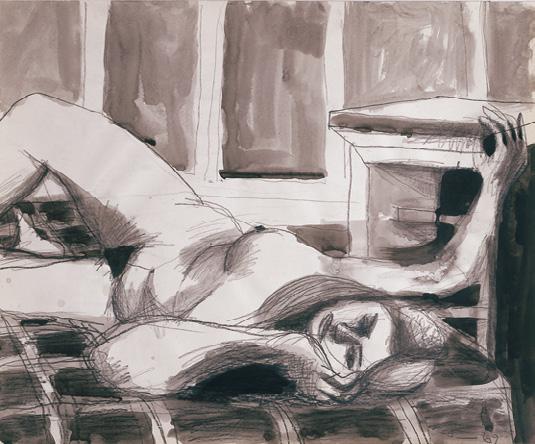


Diebenkorn and Lobdell had found an inexpensive source of paper at the Crown Zellerbach warehouse, where at a nominal cost they could buy reams of coated-stock paper in large commercial sheets and have it cut down to their favored 14 × 17-inch format. This hard-Wnished paper held a crisp line well, and the coating of sizing and Wller that gave it its white surface would respond to water and heavy inking by rising from the substrate, creating almost gouache-like grays that both Diebenkorn and Lobdell exploited to enrich their work of this period. Lobdell seldom used line alone, preferring to introduce a broader range of values through ink washes that carved and structured space on the drawing sheet, with the Wgure becoming a salient part of the overall light and dark pattern. Working wet and rapidly, Lobdell would occasionally need to reestablish the white of the paper by rubbing through the ink or peeling a layer of the paper away to adjust the light/dark emphasis or a speciWc form in the work. Like pentimenti in painting, the resulting change in texture of the peeled paper areas or the residual stain from the rubbed-away ink or pencil evidences the artist’s gestural attack and intellectual attitude. left
52. Untitled, 1967
53. Untitled, 1964


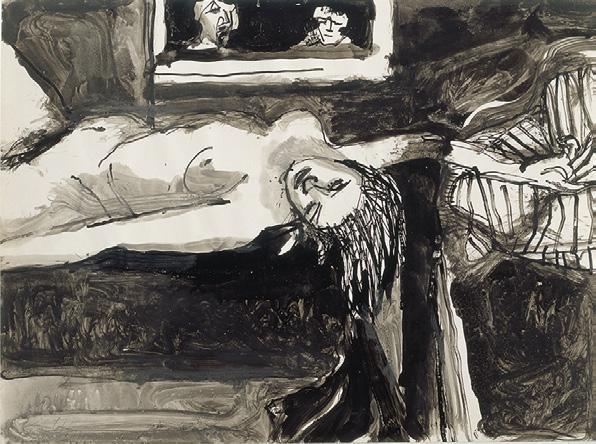


More than anything, Lobdell deployed the drawings as an exercise in looking, to help him analyze how the path of the eye moved across, through, and around the compositions he created with the Wgure. “Gesture, the attack, informs the drawings,” he reXected; the point was “not to illustrate something, but to Wnd it.” Fond of the device of the mirror in the set-ups at BischoV’s studio, Lobdell was intrigued with the possibilities of doubling the Wgure and the opportunity to introduce other aspects or sides of the experience by recording both observed and observer—the model and the artist drawing her. The various mirrors that appear in the drawings create new planes of reality and edges of dark and light, which he records and exploits freely. Creating dynamic shapes from an isolated part of the model’s body—a thigh, an arm, a breast—with repeated tracing of its silhouette, or the Xoating of a saturated black around the shape, Lobdell was inventing the vocabulary that would give form, in the mid-1960s, to his emotionally searing series of abstract works on a reprise of Francisco de Goya’s monumental painting Saturn Devouring His Son (1820–22). Unlike the cool intellectual detachment of Diebenkorn’s nudes or the quietly discrete sensuality of BischoV’s Wgures, Lobdell’s drawings capture a vibrant physicality that is highly sexual and erotic even at its most abstract. Pendulous breasts, swelling thighs, an aggressively black pubis, symbolically open a Dionysian glade that is both celebratory and carnivorous. It is an energy that Lobdell Wrst harnessed in those Thursday night sessions, and which has carried into his present painting some forty years later.
57. Untitled, 1967
58. Untitled, 1964
above

In 1961, Walter Hopps organized an exhibition for the Pasadena Art Museum (now the Norton Simon Museum of Art) of Wgurative drawings by Diebenkorn and abstract drawings by Lobdell. It was the Wrst time that Lobdell had exhibited his drawings, which have remained generally unseen until recent years. In 1963, another exhibition was organized for the Achenbach Foundation for Graphic Arts at the California Palace of the Legion of Honor in San Francisco, which showcased the three artists and the drawings they were creating every Thursday night. The exhibition was an apotheosis of sorts because the drawing sessions were slowly winding to a close as the three artists’ careers evolved and their personal lives changed. Lobdell would accept a teaching position at Stanford University and move to Palo Alto in 1965, and Diebenkorn would move to Santa Monica in 1966 to begin teaching at the University of California, Los Angeles.
Frank Lobdell taught life drawing and painting at Stanford University until his retirement in 1991. In Palo Alto, he began a similar drawing session that ran from 1966 into the late 1970s. The group variously included Nathan Oliveira, Keith Boyle, and Jim Johnson, among others.
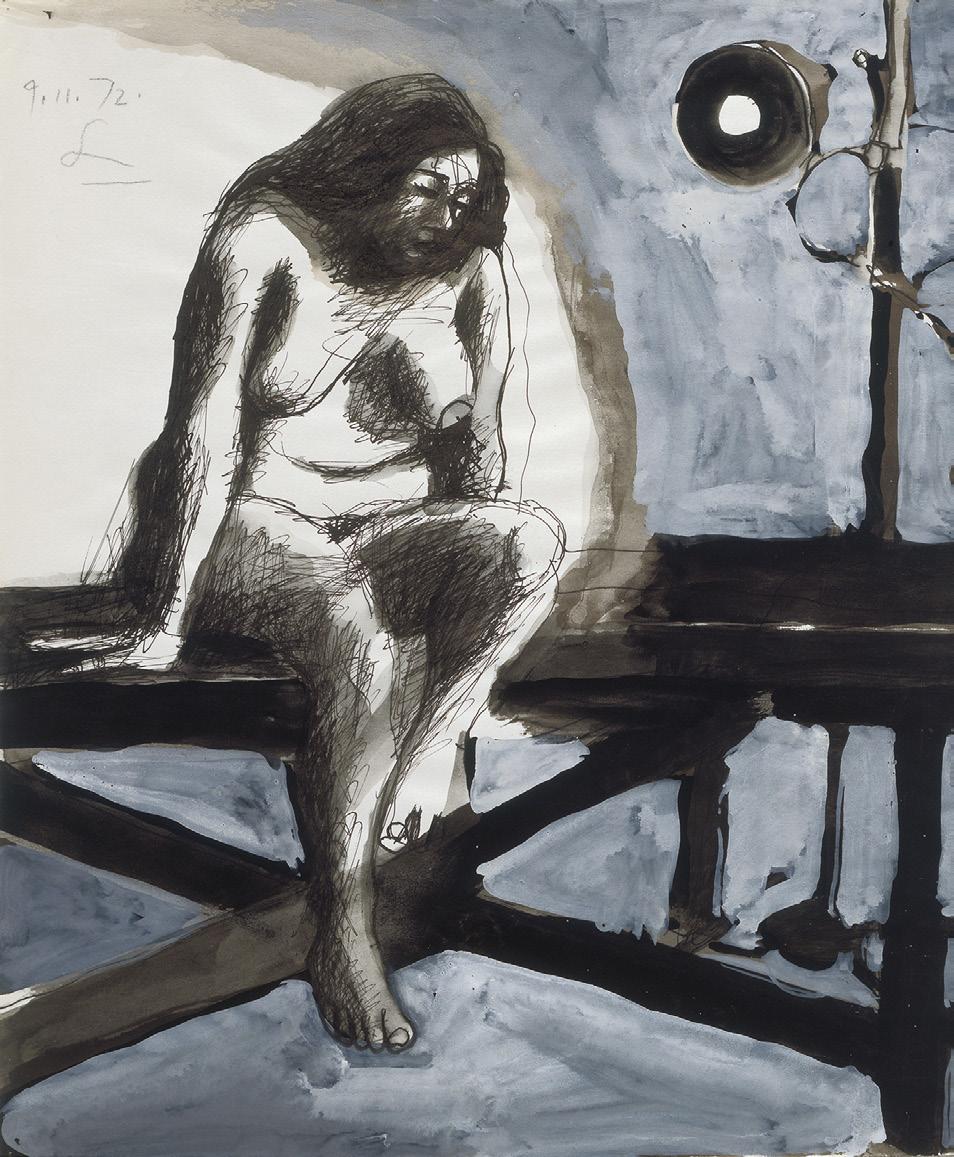








Drawing had become an essential part of Lobdell’s studio practice and presaged every shift in his paintings. Where once he drew only in variations of black and white, Lobdell’s drawings now are fully in color and are often highly Wnished pastel and colored pencil works of great subtlety. For Lobdell, drawing now begins with doodling to discover forms and feel the intuitive associations among them. He moves those emergent associations onto larger sheets of stretched paper and searches out the emotional and formal balances that cause the work to coalesce. Color, which has been central to his concerns over the last twenty years, then pushes strongly to the fore to work the compositional and emotional sense of the drawing toward a more perfect pitch. As the drawing Wnds its formal resolution as an intellectual, symbolic, and emotional construct, Lobdell begins to consider if the drawing can become a new painting that will be, as he put it, an intimation of “that which has always been there.” The search for the clearest expression of some part of an eternal truth has driven Frank Lobdell’s creative quest and propels him to begin to mark the next sheet of paper.
This article is based on interviews with the artist in San Francisco during November and December of 2001.
Untitled, 1973
Untitled, 1974

To note that Frank Lobdell is known primarily as a painter is simply a way of saying that his substantial output as a printmaker is not so well known, or that his prints have so far failed to gain the public forum granted his paintings. This condition probably was inevitable. Lobdell has treated the print, whose basis in replication makes it an inherently public medium, as a private activity, not unlike drawing. Because he brings much the same goals to printmaking and drawing, both are best understood within the context of a comprehensive process. Lobdell’s intention has always been to exploit the innate characteristics of the medium in an ongoing investigation of his imagery, forms, and spatial depictions, with the idea that its particular technical demands may yield some unpredictable but valuable bit of visual information, something that could be found nowhere else, which he can then carry back to his other work. In this way, the paintings have emerged from an outpouring of drawings and prints that seems literally to course around them in an immense, eddying Xow—a condition that tends to dismantle some of the boundaries that might otherwise separate them. Not that they are indistinguishable from each other or entirely free from the traditional associations that cling to them as media; rather, they are inseparable as components within the larger, more incorporative enterprise of constructing an idiomatic visual language.


Although Lobdell has maintained steady drawing and printmaking practices from the start of his career, both of which have dealt in a general way with issues central to the paintings, after the late 1970s, they surrendered some of their independence as they grew increasingly entangled with speciWc canvases. The artist negotiates a path through a world of his own devising, with its own array of characters and its own organization of the spaces in which they act: yet, the image is invariably at stake, a condition whose dynamics are governed by Lobdell’s convictions concerning the artist’s role as an image-maker—convictions tempered by an abiding mistrust of the ways in which images may be commandeered by the culture around them, their meaning determined and consequently compromised by assumptions that arise from their collective use.
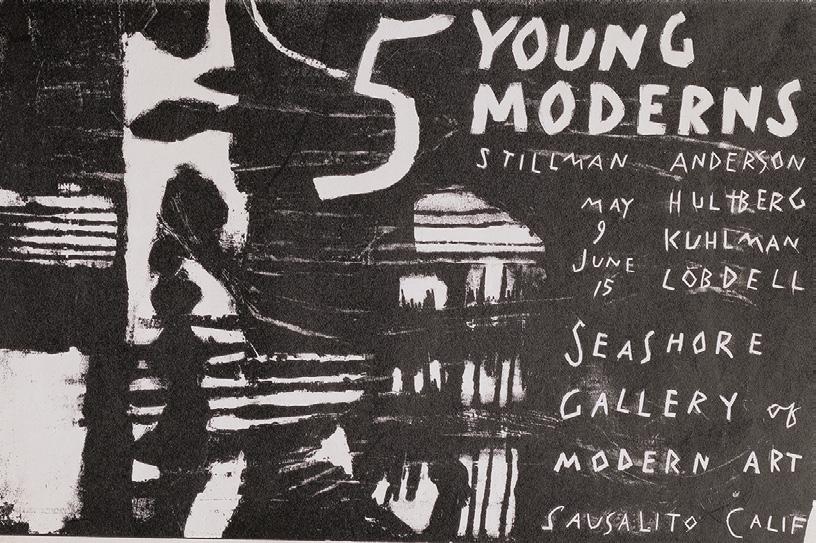
Lobdell, of course, never oVers his work as a statement, at least not in a deWnitive way. His job is to press his imagery endlessly, relentlessly, with as much variety and in as many situations as he can create. It is a process in which he immerses himself, and in the Xuid zone in which his characters and forms are subject to continual change—from one medium to another, and from image to image, through time—meaning is experienced as pliant, ambiguous, elusive, forever fascinating, unWxed by the transformational motives that underlie its very existence. From this perspective, Lobdell’s works on paper truly are indistinguishable from the paintings; one is seen most accurately in terms of the other.
Lobdell made his Wrst prints in 1948 in a lithography class at the California School of Fine Arts (now the San Francisco Art Institute), where he
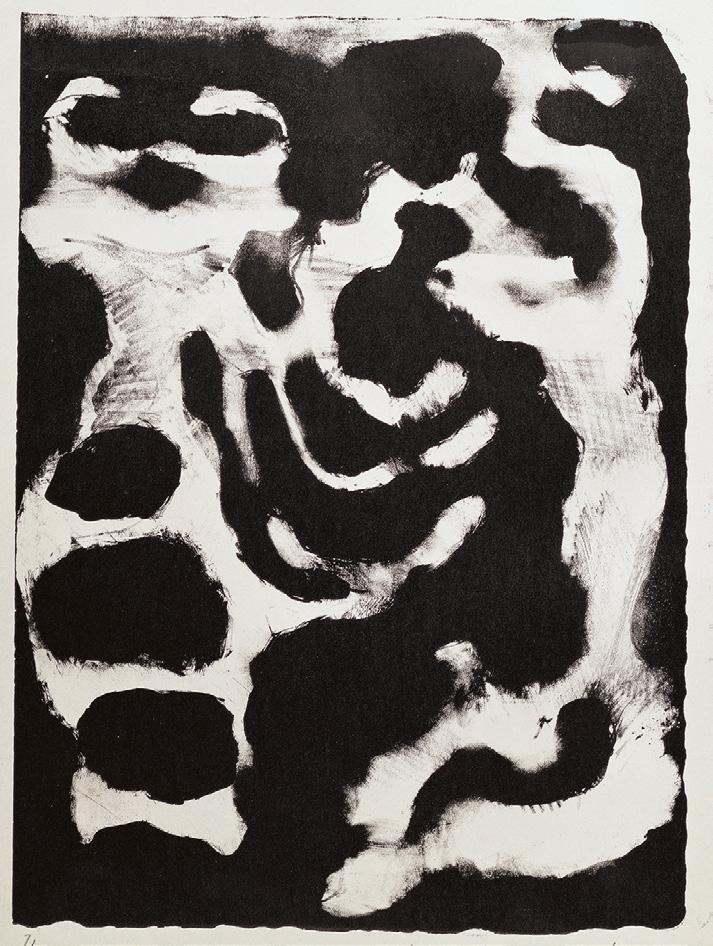
produced a handful of editions featuring imagery characteristic of his early work. In addition to a number of short projects at small Bay Area presses, he has enjoyed some productive collaborations, one at the Tamarind Lithography Workshop in Los Angeles, where he completed thirty-three editions during a ten-week residency in 1966, and then, beginning in 1983, when he began working with printer David Kelso at the Oakland-based press made in California, a partnership that continued until 2000, resulting in nearly Wfty intaglio editions. But Lobdell has done a great deal of monoprinting as well, particularly during the 1970s and 1980s, using presses available to him while he was on the faculty of the art department at Stanford University and then at 3EP, a small printing facility in Palo Alto; these were undertaken during a period of considerable uncertainty and proved crucial in formulating his subsequent direction. He later returned to lithography to produce seven editions in 1985 while he was an artist-in-residence at the Tyler School of Art at Temple University.
Since the late 1970s, Lobdell has devoted his practice to the development of his characters, forms, and spatial conWgurations, which he advances in a patient, thoroughly evolutionary way; this can only be accomplished one image at a time. Thus he brings an exploratory attitude to printmaking, an eagerness to discover how it can assist in developing his forms and in further revealing the ‘hand’—the literal, characteristic manner in which the individual artist constructs an image, mark by mark. His devotion to the life of the hand explains the basis of his printmaking in studio rather than marketplace values. The prints are neither surrogates nor facsimiles of the paintings. Each comes to life in its own way, and there have been, by his own admission, many failures.
“The hand is so important,” Lobdell has said. “This is how things are described. And when you describe something in another medium, it will have a diVerent character than when it’s described in paint. The main thing is to keep your hand in it, through the entire process. The image can be changed by the medium, and you get something you wouldn’t otherwise have known. Each medium presents a diVerent set of problems. But it’s the hand in the end. And it has to be my hand in all of this.”
Lobdell did three lithographic editions at CSFA, producing a dozen or so versions of each (Wgs. 2–3). Many years later, he recalled that no one at the school seemed to know how to use the equipment, and so students were entirely on their own. As a result, these works involved some unorthodox inking techniques as well as direct carving onto the surface of the lithographic stone and the use of broken stones, although a willingness to tinker and improvise with an unfamiliar medium, undeterred by either imperfect tools or incomplete technical skills, seems by now characteristic of the artist: it is precisely the process that yields the surprises and discoveries he values so highly. And in the lithographs of 1948, he achieves an awkward beauty in images that seem simultaneously organic, biomorphic, physiological, and maplike, though they suggest X-rays as well—bold inversions of black and white that meet along ambiguous borderline passages of scratchy, tenuous middle tones. Lobdell’s father worked as a printer in Minneapolis, where the artist spent much of his youth, “and so,” as he would recall, “I had some aVection for lithography. But I wasn’t a born technician. We learned on our own and experimented a lot.”
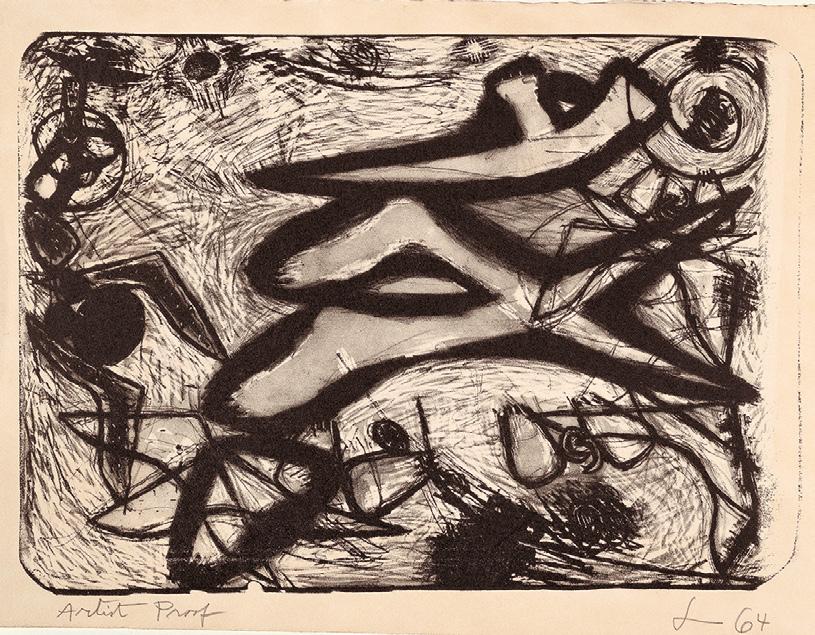
In 1964, Lobdell also did two lithograph editions at Original Press with Joseph Zirker, a Bay Area artist and printmaker who had trained at Tamarind. These images, which seem fairly typical of Lobdell’s work at the time, are built around disjointed Wgural silhouettes that seem to be swimming in space, surrounded by other forms from the artist’s work of the period, like moons orbiting a planet (Wgs. 6–7). Lobdell did a series of drawings to prepare for the sessions at Original Press, and so this was also the point at which the link between drawing and printing established itself for him: “When Joe Zirker asked me to do a lithograph, I thought, well, what’s it going to be about? I got to thinking that maybe it should be about the painting that was going on then, and so I did some drawings to see how that might look. At that point, drawing became more closely related to lithography, and to painting, than it had been before.”

Clearly, however, the lithographic process suggested other possibilities, and so when Lobdell went to Tamarind some two years later, he had a deWnite mission in mind. Before leaving for Los Angeles, he hung a huge canvas in his studio—the canvas that became the magisterial Summer 1967 (In Memory of James Budd Dixon)—and already he was sifting through an array of forms as he planned the work. Some strong images had emerged in his paintings during the 1960s, and he felt a need to get to know them even more completely. Thus he made a conscious decision to use the Tamarind residency to explore speciWc ideas for the big painting, at length and in as many conWgurations as possible. He approached the print studio as a kind of laboratory in which he might engross himself in a selective set of forms for the sole purpose of acquiring an authority that he could then bring back to the painting itself, a signiWcant departure for an artist who had generally worked out his paintings directly on the canvas.




The strategy had been suggested years earlier, in 1940, when, as a student at the St. Paul School of Fine Arts, Lobdell had traveled to see a Picasso retrospective at the Art Institute of Chicago. The exhibition featured Guernica (1937), which hung by itself at the end of a long gallery otherwise dedicated to many of the drawings and smaller canvases that Picasso had done as studies for the painting. These demonstrated the means by which he solved a number of the problems that had emerged during the work on Guernica, and they showed, too, how a large, complex painting might be altered and reshaped by the very processes entailed in its making. Now Lobdell hoped to pursue a similar path, a choice that, as much as anything else, reXects the deliberation with which he seeks challenges for the purpose of provoking insight into his own procedures and imagery.
The Tamarind Lithography Workshop, founded by June Wayne in 1960, is widely regarded, along with Universal Limited Art Editions, Crown Point Press, and a few other workshops, as a catalyst in the print renaissance in America during the late twentieth century. It came into being at a moment when lithography had all but disappeared from Wne-art practice in this country—the American Scene artists were the last to employ it extensively, though they did so in a conventional way, in order to create inexpensive pictures—and so Tamarind was conceived as an educational facility. Wayne employed a crew of master printers, but most of the technicians were apprentices, students from colleges and art schools in the area, and they often found themselves working with artists who were not primarily or even actively printmakers. Consequently, Tamarind tended to produce interesting or idiosyncratic results, rather than the kinds of art prints that would have appealed to connoisseurs, but for Lobdell, this environment was propitious. He soon discovered that the young technicians shared his sense of adventure. After the master printers explained what he could not do with the inks and lithography stones, he went oV and did just that, usually at night or on a weekend, and then he found some willing apprentice to proof these experiments. As a result, the untitled lithographs he produced there include a number of remarkable individual editions, but at the same time represent a distinctive body of work in their own right (Wgs. 8–18).
A dense, dark, heavy Wgure, all but enveloped in a womblike oval, dominates the center of Summer 1967 (In Memory of James Budd Dixon), its disjointed limbs enfolded in an attitude of gestation as it hovers in the middle of a pale Weld. It is an atmosphere without palpable gravity, in which aspects of the central form are repeated in variations that appear to Xoat around it, as if in a state of suspended motion, while another space, rendered as an acute triangle along the lower right edge, seems to encroach from an area outside the work itself. The tenacity of Lobdell’s involvement with this particular set of forms is evident in the lithographs—here, ‘set’ also evokes the mathematical application of the term, as this group of forms, like a collection of integers, is subjected to aggressive, often radical reordering upon the Weld of the stone— and so a network of correlation emerges between the prints and the Wnished painting, even though the precise points of association may not always be immediately evident.

Taken as a whole, however, the prints suggest a process of intuitive analysis that considers how the set will behave under diVerent conditions. A few of the lithographs are Wlled with Wgures that seem to scratch and squirm in a close, murky, frightening space, rattling against one another in agitated clusters; in others, the space expands, opening the Weld and pushing the Wgural activity to an edge or a corner of the sheet. Lobdell often Wlls these open areas with rich colors whose inky surface clots the image with a humid, viscous atmosphere. There are instances, too, in which we can observe a sequence from print to print as the image appears Wrst in a conventional mode, black on white, then as a negative version of the same image, and then in color.
In many instances, radical changes occur as a print moves from its Wrst to second state, as if Lobdell is Wnding ways of editing the print in much the same way that he might edit a drawing, by eliminating information from among the congested, restless press imagery. Sometimes his reductive techniques do resemble drawings of the same period, rendering depth by endless scratching and mark-making. But some prints are still packed with a remarkable amount of imagery by the time they reach the Wnal stage, as the various Wgural forms and their individual spaces seem to collide, compressed by the size of the sheet. They are recognizable as the forms that will appear in Summer 1967 (In Memory of James Budd Dixon), but in the lithographs, they seem to compete for space, as if asserting their worthiness as forms. It is a process of natural selection: which of them will act most eVectively in the painting, and which will be consigned to secondary roles.


And while some of the prints are quite elegant, others have a murky, malignant quality that inevitably recalls The Disasters of War, the print series by Francisco Goya that already had played a signiWcant role in the development of Lobdell’s themes and imagery; his lithographs suggest a similar sort of journey into the airless lair of nightmare and hallucination. He must have experienced moments when the very act of drawing on stone evoked the archaic, nocturnal mystery of the prehistoric cave painters.

Lobdell did not exactly follow Picasso’s path to Guernica. The Tamarind prints exist prior to, and independent of, the actual painting process and were never required to address particular problems as they were arising on the canvas. By the same token, the inexact nature of this relationship opened up the narrative that occurs from print to print; the process became an immersion in the imagery rather than into the problems created by the imagery in another medium. The eVort to absorb these images so deeply could itself be regarded as a kind of problem-solving, an eVort to “solve” predictable problems in the painting before they even arose.
The lithographic process enabled Lobdell to alter and rearrange images in ways that would not have been easy or, in some instances, available in drawing or painting. His catalog of experiments and technical feats can no longer be recovered in its entirety, but certainly he utilized reversed images, ghosts, segments rendered from transfer paper that allowed him to bring together sections from previous prints onto a diVerent stone, as well as a variety of materials and application methods that often resulted in strikingly active, complex qualities of space.
Unlike drawing or even intaglio, the smooth surface of the lithographic print uniWes the application of the hand with the material image in the Wnal print: the tactility created by the imprint of the drawing tool or the physical texture of paint or line simply does not exist. We tend to read the image as an image rather than as a process, and as a result, the layered or time-based eVects of the artist’s procedure, as a noteworthy aspect of the work, are largely


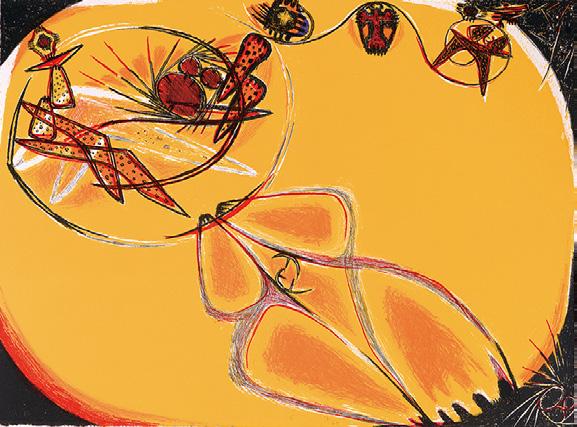
withdrawn from the forefront of our reading activity. This led Lobdell to emphasize the imagery itself, not an entirely characteristic trait in his work up to that point. In the Tamarind prints, he asks his forms to demonstrate their validity as forms, without the support of his considerable facility with paint or the vigor of his drawn line, and without the history of the making process built into the surface. Lithography may yield subtle nuances of tone as well as rich, bottomless blacks, but as a record of the hand, its ability to smooth over the details of its production means that it can never really be approached as an archaeological medium.
Despite the proliferation of formal arrangements, these prints are ultimately more attentive to space then they are to form. When the space is open and Lobdell Wlls it with color—an unequivocal red or yellow, for example— the forms are like swimmers in a moist, overheated, tangible atmosphere. When it closes, Lobdell struggles against the impinging impenetrability of the black pigment: he scratches, scrawls, wipes, dips, scribbles, erases, adds tusche, and then he goes at it again, in pictures utilizing complex, interlocked spatial zones to generate an unsettled mood of agitation. In essence, Lobdell was testing his formal vocabulary and his indigenous mark under conditions of image reproduction that were still largely unfamiliar to him—it remained a Weld of free play, which was really the point, after all—and he found them strong. Summer 1967 (In Memory of James Budd Dixon), completed the following year, remains a benchmark work in a long, productive career.
16. Untitled, Tam 1711, 1966
17. Untitled, Tam 1711 State II, 1966
18. Untitled, Tam 1711A (trial proof), 1966


As Lobdell’s imagery evolved during the late 1960s, it continued to grow in complexity. The solitary Wgures of the 1950s, engulfed in otherworldly atmospheres of yearning, were no longer suYcient, and by the early 1970s, as the tormented ballet of the Dance series moved toward its conclusion, Lobdell realized that he probably had done as much as he wanted to do—or could do—with overt Wgurative reference. Still, he was by no means certain of the path ahead. By the end of the decade, he had eliminated obvious human reference altogether as he went about developing forms that were Wgural but not, strictly speaking, Wgurative: having been divested of the familiar correspondences that normally assist in generating empathy with the viewer, these forms were free to go their own way, in an existence that evolved from one image to the next. He also borrowed formal ideas from across the span of art history, and as he drew these various motifs into his work, he subjected them to a ceaseless process of assimilation and transformation, investing them with his own associations. In essence, he had created a population of highly personal but malleable forms that he could alter or manipulate more or less at will.

23. Untitled, 10.21.81 State III
This direction was not immediately obvious, however. It announced itself during a period of concentrated printmaking activity that began in 1976, as Lobdell confronted his situation head-on in a series of monotypes made on presses in the Stanford University art department. These were done with the assistance of Lee Altman, a graduate student at Stanford at the time, and the two of them went on to do more than a hundred prints over the next Wfteen years: “When we started out,” Lobdell recalled, “I worked two or three nights a week with Lee. I painted all day and then went over to the shop after supper, and we often worked until two or three in the morning. It was very helpful at the time, when I was thrashing around for an image. I was thinking that I could go representational or toward an abstract world. The monotypes became a means of exploring these directions.”



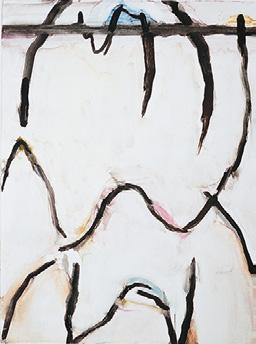


Like lithography, the monotype, in which ink is applied directly to a smooth plate, can be very agreeable to the painter or draftsman, and as Lobdell realized immediately, one of its advantages is ease of production. The work on the plate can be wiped away or revised, and since monotypes are generally printed quickly, without the level of technical assistance required by lithography, they oVer tremendous versatility to an artist as comfortable as Lobdell is with drawing with a brush. After a run through the press, the “ghost” that remains on the plate can also be put to use, and there are instances in which Lobdell worked continuously with the same plate to produce four or Wve prints. At the same time, other materials are easily applied to the Wnished print as a way of further developing the image, an option that Lobdell has exercised with some frequency. He still keeps monotypes from this period in his studio, and from time to time pulls one out for more work.
The actual path of development would be impossible to reconstruct, but given his methodology, it seems likely that as Lobdell encountered spatial depictions that piqued his interest, and as he began exploring them—varying his colors and ink applications, or rearranging them into sections and pushing forms of one kind or another into the Weld—he felt a need to devise additional signage responsive to the new environment, characters that would inhabit it, enliven it, test its operations. This is veriWed by a number of the monotypes from the beginning of the series, in which narrow bands enclose the space from both the top and bottom of the image, while bulky forms appear to traverse the central zone (Wgs. 25–27). Whether the enclosures represent the “top” and “bottom” of the space, or other spaces, or spatial fragments, is less certain.
Untitled, 8.27.83
left
Untitled, 8.28.76 I
middle 26. Untitled, 8.28.76 II
right 27. Untitled, 8.28.76 III
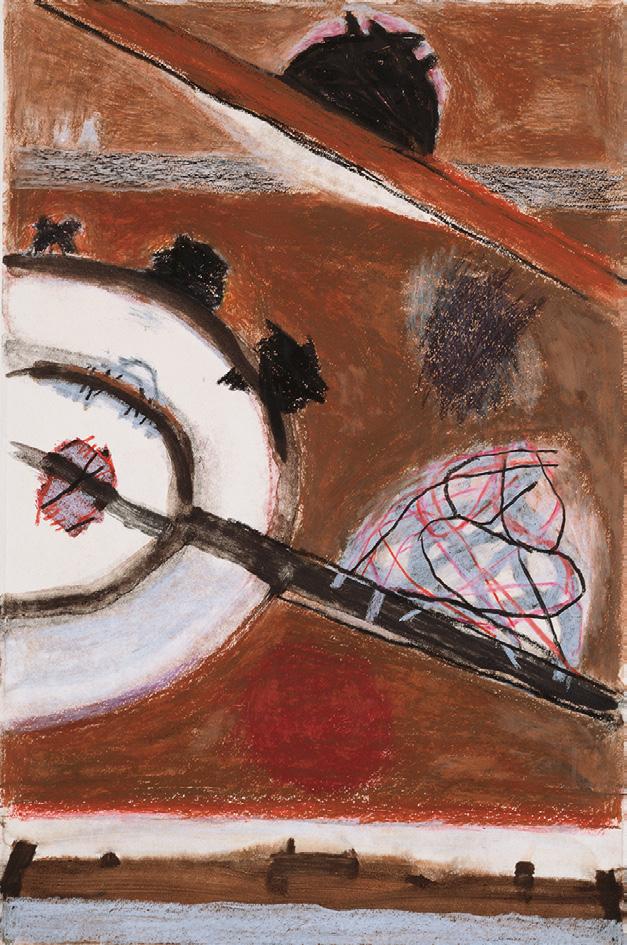

The compositions are straightforward, but the artist is only avoiding needless complications and distracting details. As it becomes more familiar to him, he begins reconWguring the visible Weld, often with networks of diagonals, and the expanding cast of Wgures enters the scene with greater frequency.
Many of the later monotypes are dominated compositionally by a variety of sectioning devices, and by lines or bands that move diagonally through the image, as if they have arrived suddenly from outside the picture, leaving behind a trail before they disappear from view on the other side of the frame, only to return at a diVerent point, sometimes on a diVerent trajectory (Wgs. 28–30). A sense of the image as a visual fragment had been fundamental to Lobdell

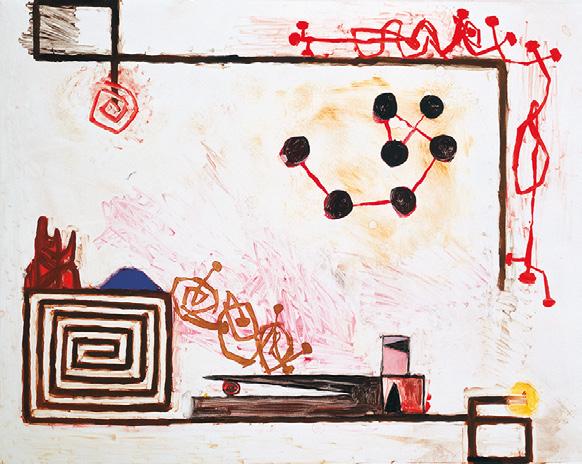
almost from the start, but now he explores it in a particularly dramatic fashion, ruthlessly cropping images and making use of line to signify time, the duration of passage implied by its weaving path. At the same time, an equally signiWcant element of the monotype production is the introduction of complex color, often in unpredictable juxtaposition—emboldened colors that depart from the typically strong, unambiguous palette of Lobdell’s previous paintings and mixed-media drawings. The identiWcation of color with space is not entirely new to him, either, but here the novelty and complexity of his color as well as its frequent beauty carries him a substantial distance beyond the unequivocal Welds of the Tamarind lithographs.
Even before the end of the 1970s, color assumes several diVerent but related functions: it separates one space from another, giving each its own individual existence, while various application techniques assist in deWning the nature and restrictions of each individuated space as a space: as primarily depth or primarily surface. Lobdell exploits the brushy look that often typiWes the medium, mounting a visual exchange between painterly space and the extreme Xatness of the printed surface, a situation that challenges him to think hard about the nature of the space itself, and about ways of depicting it. That the monotypes should be seen as a kind of working journal, at least during those Wrst years of activity, is suggested by the uniformity of means: almost all of the images are contained within a vertical format on sheets of the same size, like a window overlooking an ever-shifting view.
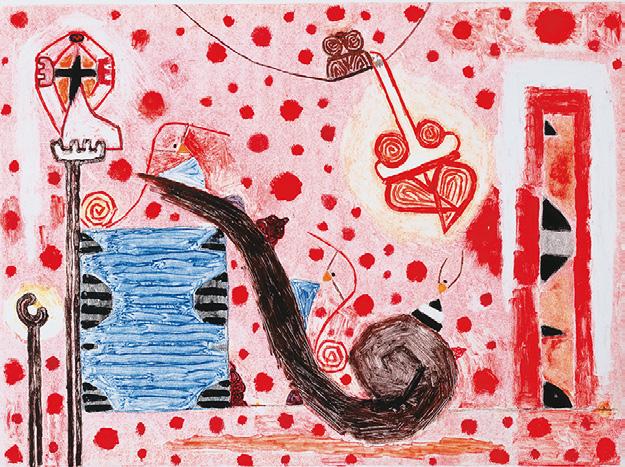


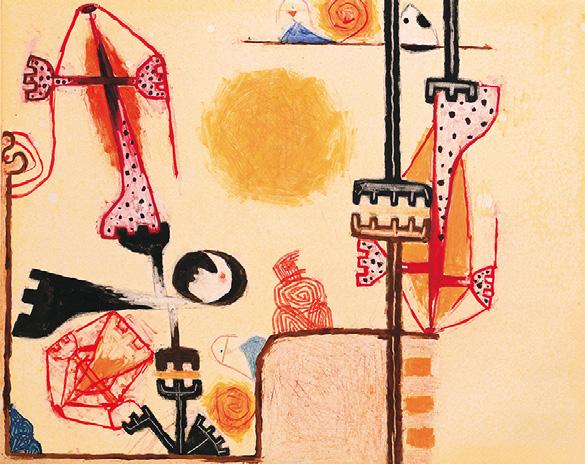
37. Untitled, 11.7.81
38. Untitled, 11.2.81

Some of these ideas were sustained when Lobdell undertook a sequence of eight etchings in late 1981 for 3EP, which had been established in downtown Palo Alto some three years earlier by Joseph Goldyne, an artist and printmaker, art dealer Paule Kirkeby, and collector Mary Anderson. (After Altman went to work for 3EP in the late 1970s, Lobdell also printed monotypes there until the early 1990s.) In the intaglio series of 1981, which was printed by Ikuru Kuwahara, some of the images, including 12.9.81 (Wg. 39), 12.5.81 (Wg. 40), and 11.1.81 (Wg. 41), bear a direct relationship to forms that were appearing in the monotypes, and to some of the signiWcant paintings of the period, such as Fall 1980 and Summer 1982, in which the space is inhabited by dark disks, bands of color, spirals, and wavy, cablelike lines. Lobdell generally avoided the kinds of linear applications that are commonly associated with intaglio, preferring instead to use hard ground techniques and spit bites to construct arrangements of broad tonal areas. The painterly etching was already popular among artists in the Bay Area, and amid so much local printmaking activity, Lobdell’s 3EP prints represent rather conservative instances of the style; in his tendency to rely upon imagery well established elsewhere in his work, one senses that he was still acclimating himself to a medium that he found diYcult, at least initially. above
39. Untitled, 12.9.81







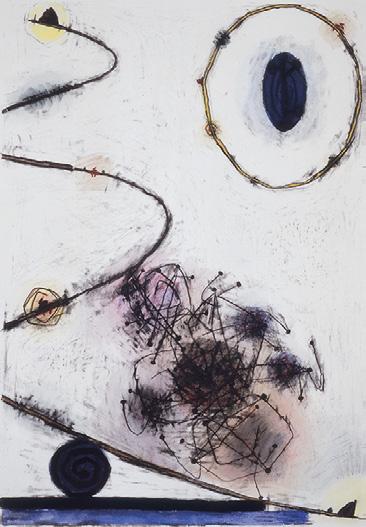
above left
above right
By the time he began working on the sequence of lithographs at the Tyler School of Art with John Dowell, a printer who had been at Tamarind, Lobdell’s sense of direction was well established (Wgs. 42–46). These prints are not illustrational, by any means, but they are free of the atmosphere of struggle and intense labor that had informed the Tamarind prints and the monotypes. Executed on Mylar, the images were then transferred to the stone, and like much of the artist’s work of the mid-1980s, they contemplate a relatively Wxed range of concerns: the division of space into blocks or compartments; the movement of line across the edges of the image; the protrusion of forms, including triangles and arcs, into the space, thus forcing new spatial events into being; the use of spirals and other linear notations to either link forms or apply pressure to the composition; and the presence of shapes that act as holes or ruptures in pictorial space. In Lobdell’s work, no space should ever be regarded merely as background to the imagery; it always coexists with other spaces that are integrated by and with the formal activity they contain. When the prints were completed, Lobdell began hand-coloring them. He retained these editions as well, and even now, many years later, returns to them when he wishes to work further on some aspect of the image.


The habit of returning to previous, “uncompleted” work has been encouraged by the consistency of the artist’s formal vocabulary after the late 1970s, although it reXects, too, the singularity of his devotion to the development of his visual language. Such open use permits the accidents and discoveries in which Lobdell so delights; as an expansive language, his formal means are enriched by so much activity. He has accumulated a repository of prints, some of them decades old, which aVords an opportunity to return to a prior image rather than simply beginning anew, like a memoirist reinvestigating his own past in the light of things newly reconsidered. Perhaps it is not unusual for a painter to pull old canvases out of storage and rework them over periods of many years, but Lobdell has maintained this habit in every medium, however informally. He looks again, and then looks deeper by applying his hand to the image. His intention is to approach the print as a surface that is not blank: the information in the preexisting image requires that he respond, engaging his hand and his imagination in a way that would not be possible otherwise. Even if the image is not fresh, it is his, and so he must test his subsequent practice against it, building around forms that will not move.



By 1983, when he began printing with David Kelso at made in California, Lobdell was already fully engaged—as in the Tyler prints—in visual strategies that have remained close to the center of his practice ever since. In the prints done at made in California, his organization of space resembles that of his paintings from the same period, and most if not all of his active motifs make their appearance. Kelso had established the studio in 1980 after working at the Katherine Lincoln Press, El Dorado, and Crown Point, and his printing technique was characterized by a crispness that was especially well suited to an artist whose painting, for all its liveliness of color, had grown increasingly draftsmanlike. What is striking about their work together is the range of techniques now at Lobdell’s disposal—the heightened linear activity suggests an inextricable relationship to his voluminous sketchbook practice—as well as the prevalence, at least in the beginning, of black-and-white images. Many multiplate color etchings would be completed over the years, but they do not necessarily dominate the series, which seems surprising in an artist whose paintings during the same period display a highly sophisticated color sense. The prints look almost denuded by comparison, but in these instances Lobdell seems most interested in investigating the structural foundations of his imagery.
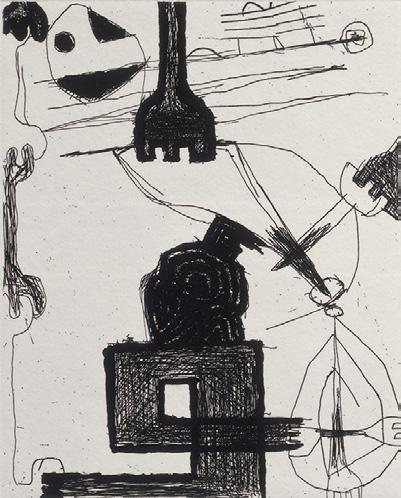





The series is also Lobdell’s most sustained collaboration, and that, too, represents a signiWcant departure for an artist who conducts his studio practice with a monkish discipline: “The reason I enjoy collaboration,” Lobdell said, “is that it is so diVerent from my normal involvement in the studio. Of course, intaglio slows things down, and that’s not a bad thing to have happen, either. But I enjoy working with a printer because there’s another sensibility involved. I’m curious about everything that aVects the work, and so I learn from a good technician.”
In the development of an idiomatic visual language, Lobdell has come to regard his forms as signs rather than symbols, and the distinction is important to him. Symbols, to his understanding, exist in order to mediate meaning: they refer to things or ideas other than themselves, and tend to generate meaning from their collective cultural use. As a result, agreements regarding meaning become shortcuts in the reading of an image, which in turn may overdetermine

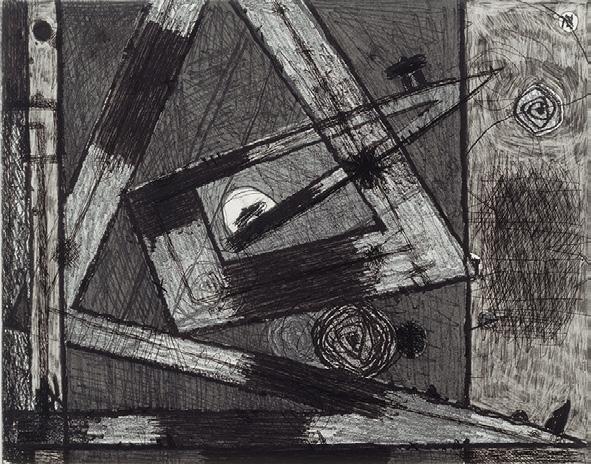


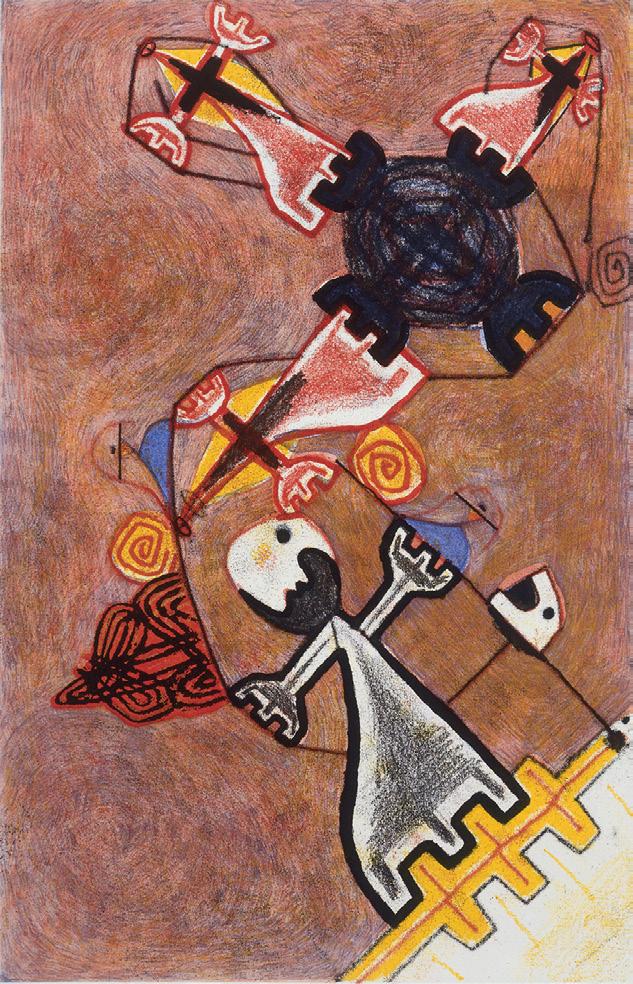

the viewer’s reception of the work—once we have recognized the familiar operation of the symbols in a work, we often assume that we know what the work is about. Signs, on the other hand, have a primarily formal existence. As the substance of his own visual language, they have meaning for him, and some have acquired narrative meaning through regular use, but in general they are treated as a self-contained, self-referential system by the artist, who manipulates them without the need to explain his decisions; as a result, his Wgures are intentionally separated from art’s most prevalent Wgural traditions, which bear the burden of their own familiarity and symbolic conventions. Thus Lobdell avoids both the strategies of a nonrepresentational abstraction and the kinds of Wgurative references that automatically evoke symbolic associations in the viewer. Lobdell’s images can be read, certainly, though not with any available dictionary. He has devised his own vernacular, but his decision to share it without providing a guide or a set of operating instructions enables him to draw attention to ways in which meaning comes into being. Yet the precise nature of that meaning remains forever uncertain, as all meaning Wnally must. Still, he is conscious of his formal subjects—‘subjects’ as a native population over which he has dominion—as a self-involved world of his own creation, and so the print


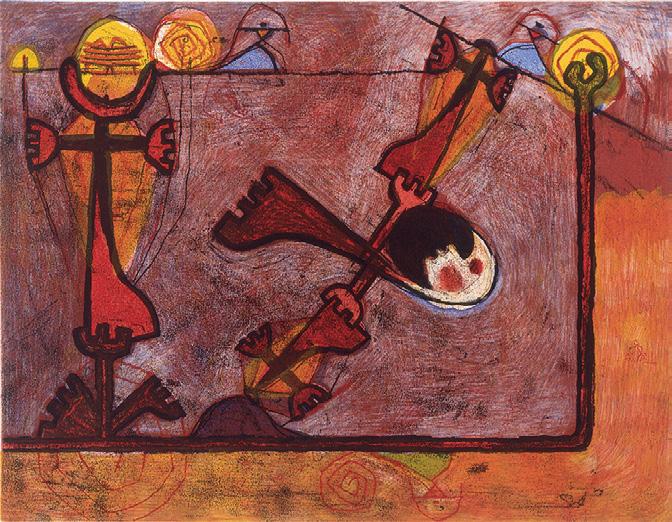

series enters the Xow of paintings, drawings, and multimedia works that Lobdell has produced during the past several decades, documents of the evolution of this world.
Many of the images recall Lobdell’s sketchbook drawings—5.25.90 (Wg. 62), 6.29.91 (Wg. 63), or 10.17.95 (Wg. 68), for example—clean, deftly described episodes and vignettes from the pages of an epic tale. After a small edition is completed, the same plate may reappear months, even a year later, in a more highly evolved state, one that certainly can be identiWed as “diVerent,” even “Wnished.” Once again, Lobdell is not simply adding color or other plate activity to the areas between the lines. Rather, the fundamental structure of the original image is further developed in ways that expose its complexity; together, the two versions chart his thinking about the image over a period of time and reveal nuances that have occurred in the course of his interaction with the printmaking process, whose procedures (unlike drawing or mixedmedia) can be indirect or subject to interruptions at various stages throughout production.
opposite above left
62. Untitled, 5.25.90
above right
63. Untitled, 6.29.91
below
64. Untitled, 8.7.92
above
65. Untitled, 2.12.00





On occasion, the journey is not a far distance, and Lobdell covers it with restraint (as in 10.17.95 and its successor, 7.30.96, Wgs. 68–69), while others (6.29.91, Wg. 63, and the gorgeous 8.1.91, Wg. 66, for instance) reveal a rapid advancement toward spatial arrangements that echo his paintings and multimedia works. Many of these prints are fairly small—the sketchbook analogy still holds—and as graphic works, their Xatness tends to heighten the feeling, less evident in the paintings, that the forms function like actors performing upon a proscenium of some kind. Their interplay, which appears to be taking place very close to the surface of the image, is responsible for much of the narrative tension: the space around them is certainly more than a theatrical backdrop or background and yet less than fully enveloping. Lobdell addresses this condition at some length in the prints, and some, such as 6.12.91 (Wg. 67) or 6.14.93 (Wg. 70), strive for a complexity in which middle tones appear to constitute a middle ground between form and space.
For Lobdell, intaglio has presented particular challenges. It lacks the playfulness of drawing, and some of his favorite techniques for eliminating imagery are less easily accomplished on the plate. At the same time, however, its intensely graphic character renders his forms in a functional way, with the eVect of heightening their signlike nature and testing their eYcacy as signs. Or it may be that the more complicated procedures entailed in the printing process simply distance or separate the image from its origins in the direct
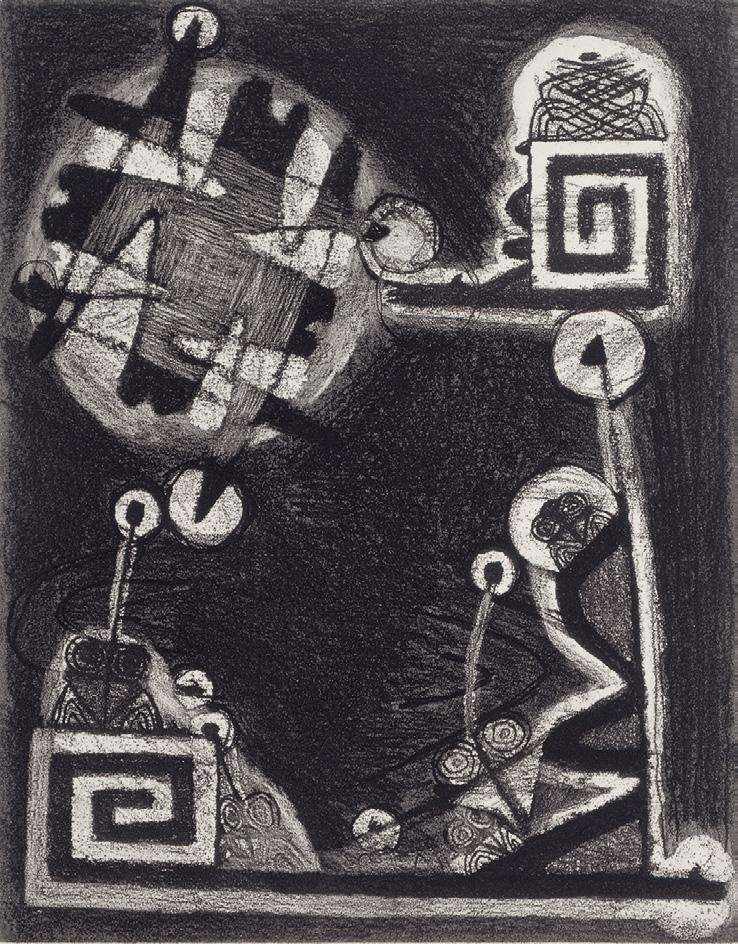


action of the hand, which is crucial to Lobdell’s sense of the life of the image. He seems deeply aware of the problem: the imagery in late prints such as 3.9.97 (Wg. 71) and 3.10.97 (Wg. 72) is invigorated by extensive plate activity and a wide range of tonal values, while 1.9.00 (Wg. 73) strives consciously for the looseness of drawing. In Lobdell’s work, one medium should never be confused with another, of course, and any correlation between them may only suggest the extent to which the artist’s synthetic imagination has found the means of bringing the lessons of one to the other.
Lobdell’s work as a printmaker, which has taken place over the course of Wve decades, is substantial enough to be regarded as a signiWcant aspect of his over-all practice. It also occurred during an extraordinary epoch in American printmaking, but Lobdell works apart from the critical issues that accompanied this renaissance; he has ignored altogether a number of popular techniques, including silkscreen and the multiple. His path has been to bring unconventional ideas about the nature of the image to fairly conventional notions of the printmaking medium. It is a risky strategy, but Lobdell was prepared for it by his own origins amid the idiosyncratic abstract expressionism that appeared in the Bay Area during the late 1940s—a gathering of painters who stubbornly resisted adherence to the doctrinaire ideologies of the day, preferring instead to go their own way by embracing the means of abstract painting as an open, entirely personal form. For Lobdell, printmaking has required neither occasion nor the submission to the fashions of the day. His eye has always been focused on his lifelong study of the nature of the image, his image, and that is occasion enough.
Bruce Nixon
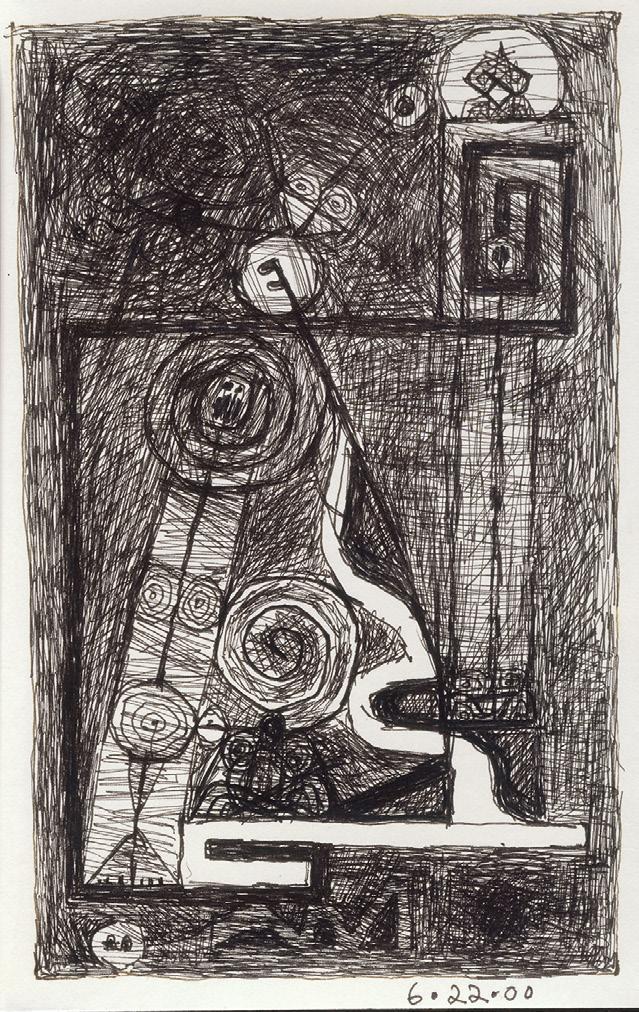
“This is My country. I paint em. I’m BOSS for this place.”
Frank Lobdell wrote these words as a dedication on the inside cover of a sketchbook in which the Wrst drawing is dated 12.1.95. Interestingly, the words were taken from wall text in the exhibition Spirit Country: Contemporary Aboriginal Paintings, presented in 1999 at the California Palace of the Legion of Honor. The recontextualization of this phrase in the sketchbook initiates a journey through sight/site-speciWc spaces that metaphorically ground a conceptual terrain—a “country” of Lobdell’s own creation.
In an eVort to achieve personal and artistic self-determination, Frank Lobdell is not averse to looking back over ground he has covered as a means to move forward, or conversely, taking from the present to revisit the past. Recognizing Lobdell’s willingness to move across diverse historical and cultural distances through a practice of gathering and manipulating images provides a key to understanding the ways in which he negotiates contradictory spaces in charting his artistic territory.
Frank Lobdell’s sketchbook drawings evince a physical engagement with materials used to construct and traverse a historically informed aesthetic landscape, and thus they provide a clue into intellectual and artistic processes that inform the way he works, through a strategy of appropriating, ingesting, and transforming a range of experiential encounters to create his visual statements.
To survey the visual topography of a tiny place that constitutes Lobdell’s “country” (here, a page in a sketchbook) is to visit a space that he identiWes as simultaneously “a sandbox for a kid” and “a laboratory for experiments.” The sketchbooks demonstrate how Lobdell works out his ideas, and they bear witness to his interaction with materials in an activity that he views as being visually analogous to “scales for a musician” or “laps for an athlete.”
Anthony Torres
For Lobdell, the drawings are both a “playful” exercise—one that informs all of his work—and a way of discovering what is useful or not, and thus the practice is valuable both in itself and in the development of speciWc works.
The sketchbooks thus reveal an ongoing practice, aimed at honing skills, that combines artistic intuition with the physicality of drawing to resolve visual problems—a process that trains both “head and hand.” This interaction functions as a means of acquiring knowledge by ingesting materials, granting Lobdell Xexibility in probing relationships among Wgures and forms that he deems worthy of continued use in his artistic explorations.
To enter this sketchbook, which spans from December 1995 to June 2000, is to step into an artistic historical Xow that is informed by a lifetime of experience and more than Wfty years of serious art making. Here in the sketchbook are congealed fragments of a highly developed, evolving pictorial world based in a personal and cultural inheritance that extends from Lobdell’s childhood pursuit of drawing, his fascination with antiquities, and his exposure to Rembrandt, Goya, Van Gogh, Cézanne, Picasso, Miró, Klee, ClyVord Still, medieval woodcuts, and prehistoric petroglyphs, as well as his encounters with a range of media that include lithography, etching, and drawings. It is through this absorption of inXuences and lessons from diverse aesthetic sources, in a process of integration and articulation in the drawings, that Lobdell is able to test forces and relations of his artistic production.
The exploratory nature of Lobdell’s drawings is discernible in the changes that occur in the Wrst several pages of this particular sketchbook. Here iconographic representations—sometimes identiWed by Lobdell as female Wgures, Buddhas, faces, skulls, and a design evolved from a tiger-skin rug found in a Matisse painting—coexist with rectangles and circles that outline “faces” or “bodies,” or delineate spaces that house these symbolic Wgures. These visual components appear on the pages in varying numbers, locations, scales, shapes, and forms to establish proportion, patterns, and rhythms in the overall compositions.
In the Wrst drawing, dated 12.1.95 (Wg. 2), lines, marks, and squiggles delineate relatively autonomous Wgures in space, which are joined by interconnecting lines and interpenetrating shapes. Desired eVects are rendered through the use of elongated and curvilinear movements, crosshatching, staccato ink marks, and a quick scratching motion of the pen. In some areas, condensed lines become rounded spheres that hover freely in space, while others are linked and given movement by a connective thread (sometimes referred to by Lobdell as a “nerve”), or by juxtapositions and interlocking contours that deWne the masses and volumes of Wgures and forms. These are strategically placed as balancing devices in the overall structure of the composition, as are the lines and dots that date the drawing.
On the following page, also dated 12.1.95 (Wg. 3), the overall drawing has been simpliWed and the H-shaped Wgures that tower at the center of the Wrst drawing are gone, as are the densely marked spheres. The amoebalike “rug” form appropriated from Matisse has shifted from right to left on the page, and now torques toward the left in an oppositional counterbalancing direction. The staccato marks that occupied the interior of the rug form have been

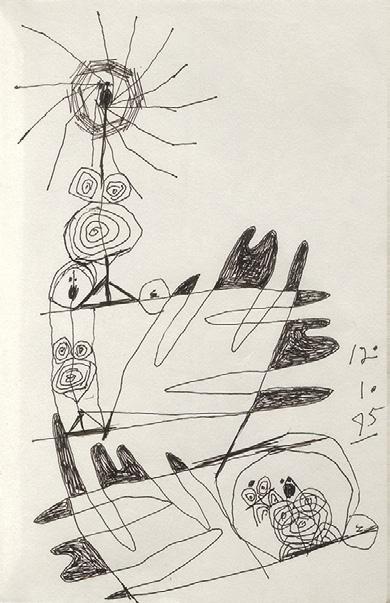
removed, reducing it to “bare bones” to emphasize its linear structure. The rug is also doubled into a second shape that, while integral to and stacked atop the Wrst, establishes its own presence as it reaches up toward a vacant space at the upper right of the page.
An elongated form that appears on the left in both drawings, a female Wgure housed in a phallic shape, is made more prominent by the elimination of a curved line that travels the length of the Wrst page, and the removal of the inverted triangular skirt of a dancing Wgure that pirouettes atop its head. A radiant, sun-faced female Wgure stands on a triangular base perched atop a line that creates the contours of a skewed rectangular rug form, integrating its blank interior with the black masses that extend outward. These interlocking lines weave together the various elements that constitute an economy of forms in this tightly balanced drawing.

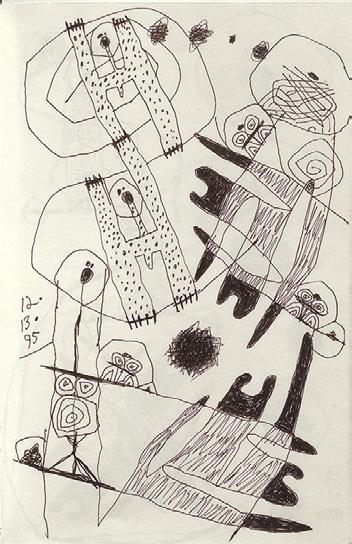
A squatting Wgure with gaping mouth that appears at lower left in the Wrst drawing has shifted to the right, with a smaller Wgure that sits on its shoulder reversed to the opposite side, and it moves from open space to a selfcontained enclosure that accentuates its presence. Also shifting from left to right on the page is the date the drawing was executed, which similarly functions in the overall balance of the design.
In the third drawing in the sketchbook, dated 12.10.95 (Wg. 4), the crosshatched spheres reappear, at once free-Xoating and tethered to a line on the right that runs the height of the page and zigzags back down through the center to create a stretched rug form. The specks that deWne its interior have returned, and in a second rug form below, short back-and-forth pen strokes are introduced to oVset the weight of the seated Buddha at the top of the drawing, as do the squatting Wgures now placed at both lower corners.
In the next drawing, dated 12.13.95 (Wg. 5), the H-shaped Wgures seen on the Wrst page have returned, lightly spotted and in a diVerent conWguration, staggered along a line that spirals at upper left, and they coexist on the page with Xoating spheres, seated Wgures, swirling lines, and a Buddha form enclosed at upper right.



6. Untitled, 2.14.99
7. Untitled, 6.12.00
right
8. Untitled, 9.26.00
left
9. Untitled, 9.29.00
right
10. Untitled, 4.12.01


The shifting constellation of visual contents demonstrates why Lobdell considers these sketchbooks “sandboxes” and “laboratories,” and additionally as “diaries.” These identiWcations speak to the personal character of the books and the multiform ways in which they function as daily technical devices for materially translating ideas and as visual records of events.

This is observable in the repeated use and transitory arrangements of a single element, an interlocking yin-yang moon face that appears in drawings dated from 2.14.99 to 4.17.01 (Wgs. 6–11). Lobdell tests the possibilities for this form in relation to others that include undulating serpents, phallic Wgures, and a design that he Wrst encountered on a Greek vase that simultaneously represents “interlocking hands” and “forces of good and evil.” His use of this yin-yang form to visually work out relationships is apparent when comparing the earlier pen-and-ink drawings with a drawing dated 4.17.01 (Wg. 11), in which color has been added in a process of reassessing the compositional structure.

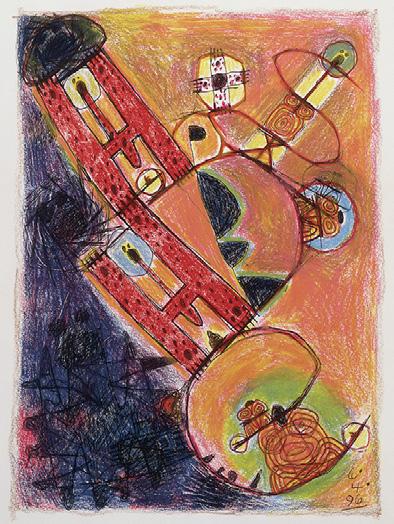
The introduction of layers of color and texture further complicates the interrelationships among Wgures and design elements, and this is apparent in a group of color sketches made in Hawaii in 1996. In the Wrst, dated 6.3.96 (Wg. 12), Welds of color subdue two curved lines that link and position various elements and serve to demarcate space, establish movement, and structure the composition. In some cases, Wgures are housed within circles of color or surrounded by color auras; in other areas, colors accentuate or complement particular design elements, establishing a push-and-pull dynamic that holds the total composition in balance. The application of layers of color also adds subtle intensity and movement, and the juxtaposition of hues and values creates areas of luminosity and vibrancy, and establishes a mood through the interplay of form and color in space. Interestingly, on the verso of this page is a simpliWed drawing that mirrors the basic compositional structure and reveals the developments and changes that occurred in the completed drawing.


Other drawings from this series demonstrate how Lobdell often uses color to obliterate certain design choices he has made. In a sketch dated 6.4.96 (Wg. 13), a dark blue-violet section at lower left smothers what was once a rug form; a radiating sun face to the left of the towering red H-shaped Wgures is also obscured. This technique of dismissing extraneous elements with color is also perceptible in a sketch dated 6.6.96 (Wg. 14), in which dancing Wgures in two circles at upper left are buried under a heavy layer of green and gold, and in another dated 9.5.96 (Wg. 15), where a pencil rendering of a yin-yang face at upper left is covered by the heavy application of pink. The drawings thus evidence Lobdell’s stops and starts, dead-ends, and his ongoing process of adding, discarding, and synthesizing contradictory and interrelated contents, structures, and spaces that teeter on the edge of imbalance, creating an overall tension in the work.
Lobdell considers his drawing process “additive” in that he adds something to a page by making marks to construct forms, develop shapes, play with movement, and explore ways that diVerent media function for diVerent purposes. If this procedure can be considered additive, it may also be subtractive, as he consumes and eliminates the blank space of the page, an idea that is useful in understanding the construction and development of these drawings, which are brought into being through modes of production and consumption.
The “playful” experiments in the sketchbooks illustrate Lobdell’s tactics for developing visual guidance systems structured to articulate dynamic movement that leads the viewer’s eye through compositional Xows set up to facilitate modes of reading and responding to ideas and formal arrangements. In the sketchbook drawings, Lobdell addresses central concerns such as the interplay of Wgurative and nonWgurative elements—which at times may be considered biomorphic, architectonic, or both—that operate in relation to and in contrast with one another, in a unity and struggle of oppositional forces that create tension in a dialectic of precarious balances and imbalances. For Lobdell, “contrast is the means you use to dramatize everything you are interested in,” and this is developed in the work through contradictory interrelationships—“movement/counter-movement, light/dark, big/small, force/counterforce; everywhere you go there’s contrast to it, that’s how you deWne . . . whatever.”
The sketchbooks can be considered sight/site-speciWc in that the manipulation of iconography and media occurs within a particular observable location, i.e., the surface of the sketchbook page. The sketches, and indeed all of Lobdell’s works, function as a means for unifying various aspects of images and gauging their eVects and inXuence on one another. The drawings reveal a process of relating forms and structures in which he challenges and tests diVerent possibilities based on speciWc formal considerations and subjective pursuits, which he blends to create precarious visual contingencies. Lobdell’s drawing praxis thus serves as a method of pushing, testing, and expanding what his images are capable of doing and saying in an open-ended discourse of various formal elements and media. To a certain extent, the drawings can be viewed as microorganisms in an evolving body of work, and as a means of constructing a transitional shifting language system that simultaneously speaks diVerent tongues, or communicates diVerent things, depending on the arrangement of the Xuctuating visual elements.
The pen-and-ink and colored drawings enlighten the entire range of Lobdell’s work, and in some cases they function as both the skeletal structure and building blocks for particular paintings, serving as guides for the construction and organization of the compositions. According to Lobdell, “It’s all about the same thing.” This may be seen in a series of small drawings made between 4.9.02 and 5.1.02 (Wgs. 16–23) that aided the conceptual development of three paintings—Pier 70 Spring I, Pier 70 Spring II, and Pier 70 Spring III (Wgs. 24–26). The Wrst black-and-white drawing (4.9.02, Wg. 16) establishes a basic structure, albeit one that shifts and changes over the course of the series, as forms and Wgures in particular positions and speciWc locations are altered by the addition or elimination of colors and forms. Intermediary
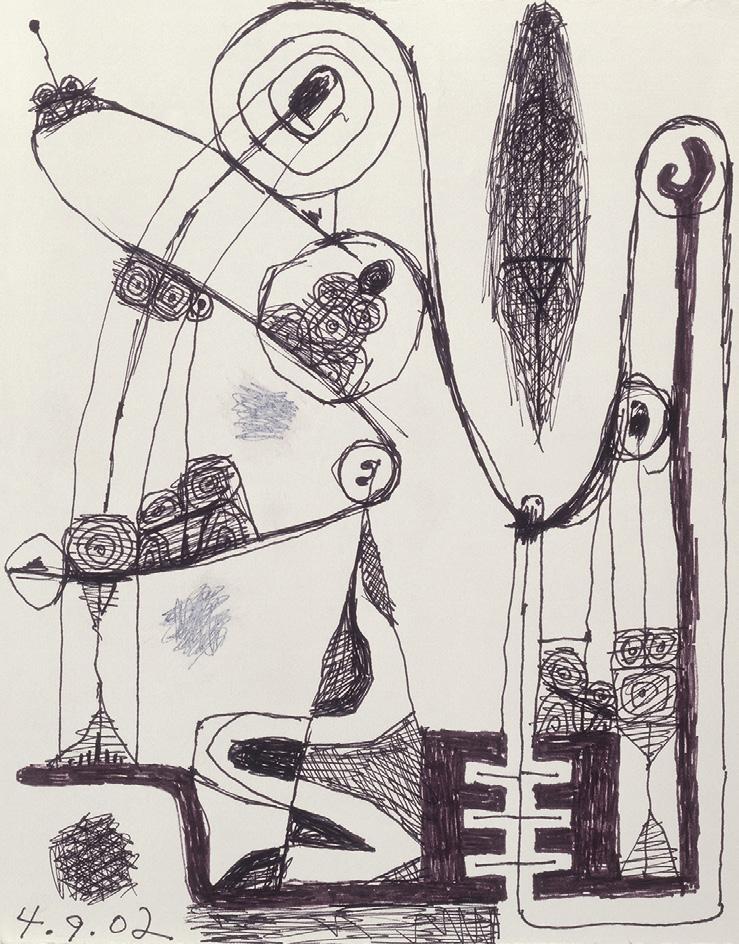


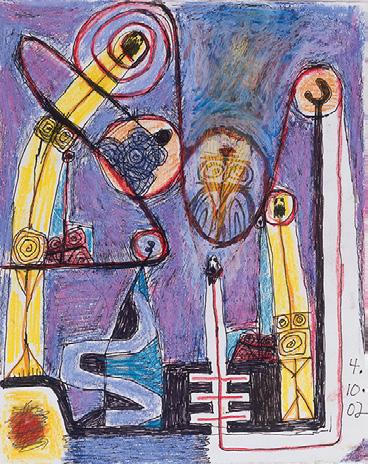


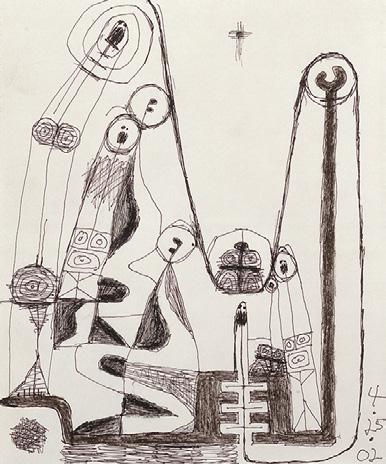
stages of compositional development seen in the sketches become embodied in the diVerences observable between the Wnished paintings. What these sketches reveal in relation to the paintings is that regardless of the media and scale, Lobdell’s conceptual processes remain consistent as he tests a range of possible combinations and conWgurations in his eVort “to push things to the limit.”
The concern with expanding and negotiating possibilities inherent in particular media leads Lobdell to acknowledge and address “constraints at the same time you are trying to go beyond them.” It is through this process of examination that Lobdell is able to recognize that with the sketchbooks, “there are limitations but there are freedoms”—two of which he identiWes as “time and convenience.” Lobdell has stated that for him, drawing in the sketchbooks serves “as a way of becoming familiar and mastering images and conXicts . . . everything in those canvases has been done hundreds and thousands of times.”
left
Untitled, 4.9.02
right
Untitled, 4.10.02
left
Untitled, 4.11.02
right 20. Untitled, 4.18.02
4.22.02
4.25.02


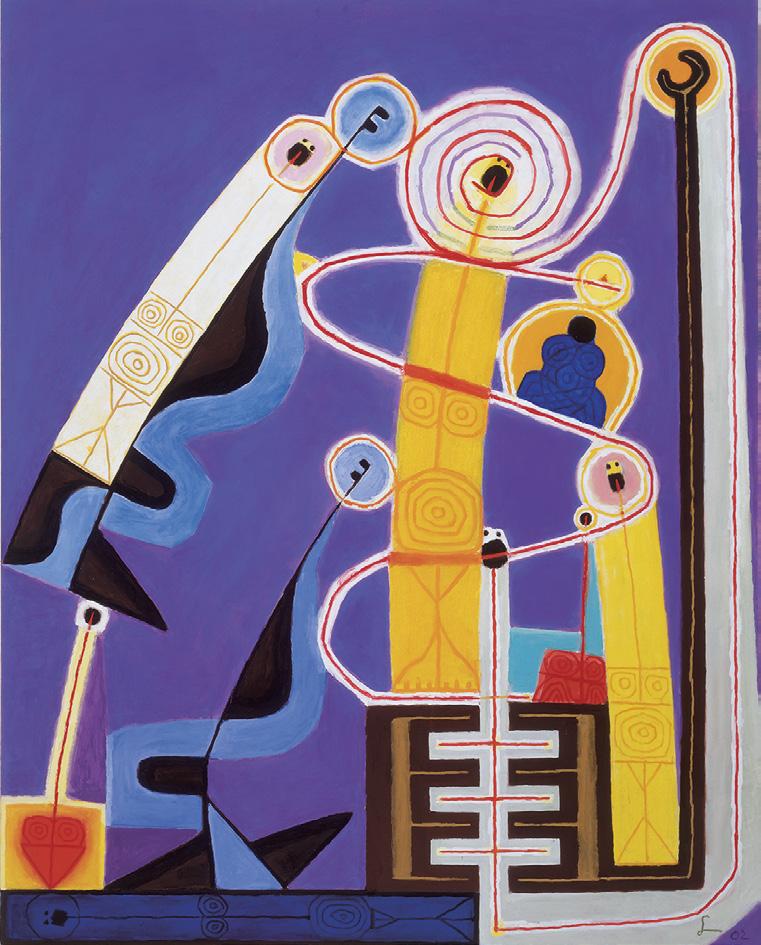

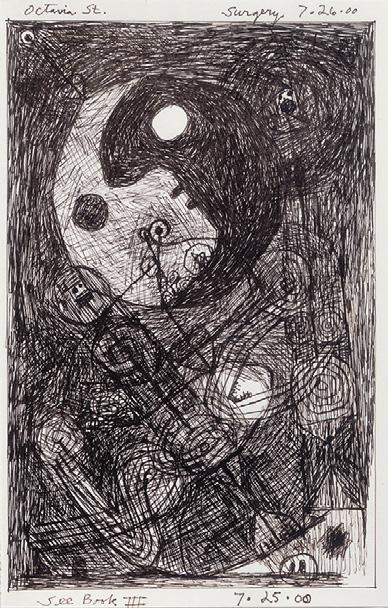
Critical as these concerns are, Lobdell is not solely focused on formal issues, nor is he engaged in a purely self-indulgent attitude sometimes referred to as art for art’s sake. To draw such a conclusion would be to simplify his aesthetic concerns and distort his artistic pursuits. Lobdell’s work can be more accurately described as subjectively creating and expanding reality through characters and structures that signify more than themselves in a multiplicity of “associations with things,” beyond simple one-to-one correspondences of speciWc symbols, objects, and meaning. Although Lobdell has experiences, words, and names that he can equate with speciWc elements in the works, and while certain forms can be identiWed as having been appropriated from diverse cultural sources, he is watchful of the danger of stiXing the associative free play that comes from anchoring his visual characters in singular identiWcation. Lobdell is thus quick to state, “I don’t know how important it is to know any of this . . . and I don’t want to take it too seriously— it’s much too important.”
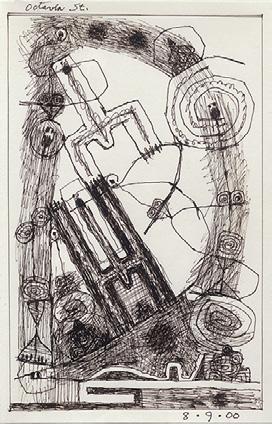

Lobdell’s sketches function not only to integrate and synthesize various ideas, but also serve as a way of working away from the easel or outside the studio. Depending on the circumstances and the tasks at hand, Lobdell’s pragmatism in pursuing his artistic investigations surfaces at diVerent times in diVerent places, and it conditions how he employs various methods and media. As such, the sketchbooks serve as journals, that is, as regular accounts of his activity in numerous locations—at home, in the studio, on vacation—and attest the truth of his statement: “I draw wherever.”
This is demonstrated in a sketchbook that Lobdell began on 6.22.2000, just before he was “laid up” by hip replacement surgeries. Present in this book are many of the characters and features seen elsewhere, and in some instances, the date is supplemented by the location, which signiWes not just the place where the drawing was made, but often a particular period, situation, emotional state, or signiWcant event. For example, one sketch dated 7.25.00 with the notation “Octavia St.” (Lobdell’s residence) was executed the day before he underwent hip replacement surgery, an event also noted with the inscription “Surgery 7.26.00” (Wg. 27). This is followed by a drawing dated two weeks later, 8.9.00 (Wg. 28), also inscribed “Octavia St.,” which signiWes his return home after he had spent time away in rehabilitation. In a diVerent sketchbook, a drawing from the interim period is dated 8.6.00 at “Sharon Heights,” where he was undergoing post-surgery treatment (Wg. 29). A later drawing dated 11.6.00 (Wg. 30) memorializes a monumental personal event, the death of his closest friend, the painter Jack JeVerson, with a line that simply states, “JeV died last night.”

If for Lobdell the drawings and notebooks constitute, among other things, an eVort to develop and deWne a vocabulary used to convey “a private story, or personal story,” the paintings that evolve from Lobdell’s exploratory sketches can be said to harbor a “spirit that emerges” in this ongoing story. In this context, Lobdell’s artistic pursuits may be thought of as a personal narrative manifested through visual tales that speak of times, people, and places, representing integrated multiple histories and recollections informed by years of work and lived experience, which he has culled to develop his visual reservoir. Lobdell’s works thus comprise his responses to diverse personal encounters, which he qualitatively transforms from his original places of exposure into modes of aesthetic and social signiWcation. Lobdell’s practice of gathering, synthesizing, and juxtaposing transhistorical cultural fragments, Western and otherwise, to close temporal and cultural distances creates a constellation of personal iconographic characters that can be viewed as a form of visual alchemy realized through his ongoing investigations of Wguration and formal interrelationships.
The sketchbooks thus comment on Lobdell’s devotion, relentlessness, and obstinacy in addressing and resolving artistic challenges, and lend credence to the notion that people are what they do, and to artistic practice as a way of being, and they identify the artist as anchored in this activity. In utilizing diverse cultural histories to relate private and personal stories, Lobdell’s pictorial enunciations can be considered a form of self-portraiture, in which the artist represents himself through the construction of his visual dramas.
Lobdell has stated that a theme of aspiration emerges throughout the work as a “striving for something,” and it is present in all of his work, and that “there’s a goal . . . it’s almost everywhere.” The expression of aspiration and goal is made visible through processes of reclamation and transformation of Wgures and structures embedded in Lobdell’s pictorial archaeology, as he blends and transgresses lines of demarcation between histories and media in order to strike a delicate balance and tension in the work. The theme of aspiration, which is central to Lobdell’s work, emerges as an allegory for redemption and resurrection that can be viewed as visually analogous to his aspirations and attempts as an artist “to get it right” in a lifelong struggle for self-determination articulated through his work.
If the terrain of the sketchbook that Lobdell began in 1995 can be said to represent a country, then the works he has completed over the years, including lithographs, etchings, monoprints, and paintings, can be said to variously constitute planets and constellations in a personal universe created by Frank Lobdell. The beauty of Lobdell’s universe lies not only in what is revealed there through multiple visual utterances, but in the fact that his universe Xows from a world that we all live in and share, diVerently, together—and thus it exists not only for Frank Lobdell, but for us, too.
Anthony Torres is an art critic and independent curator. All quotes in this article are from an interview with Frank Lobdell, conducted by the author in the studio at Pier 70, San Francisco, on July 20, 2002.
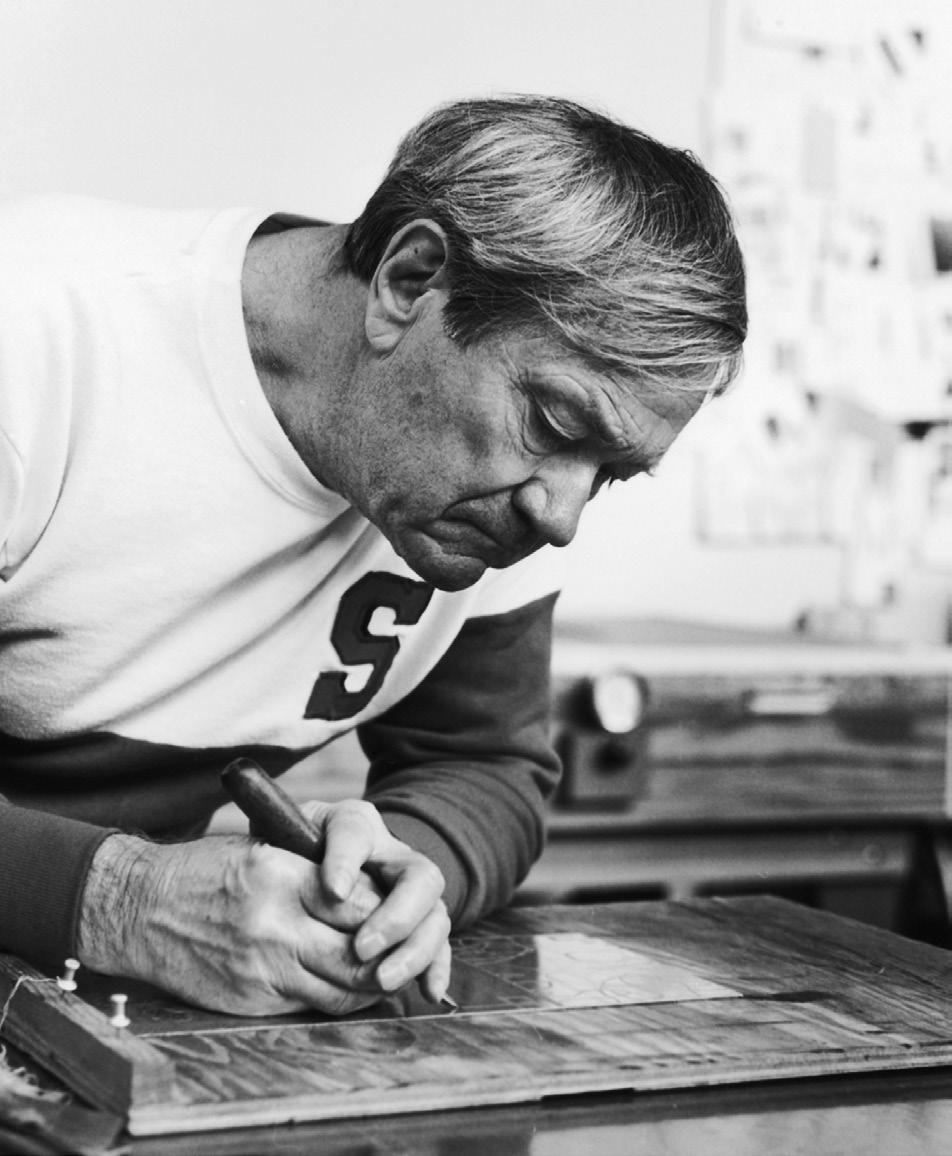
1921 Frank Irving Lobdell is born on August 21 in Kansas City, Missouri. He is the ¬rst child of Earle Leslie Lobdell and his wife Ruth Olive Saxton.
1923 The Lobdell family moves to Minnesota, settling in a house on Zenith Avenue in Minneapolis. Earle Lobdell works in an advertising agency, where he sets type, edits, and does layout. Sister Doris Ruth Lobdell is born on August 31.








1929 Sister June Elizabeth Lobdell is born on June 20.
1931 In the Depression, Earle Lobdell loses his job at the advertising agency; the family later loses their house.
Sister Phyllis Mae Lobdell is born on October 18.
1932 Earle Lobdell takes a job in Faribault, Minnesota, leaving the family behind in Minneapolis until he is settled.
1933 The Lobdell family moves to Faribault, a beautiful town on the Straight River, where Earle is employed managing a printing plant. He brings home paper and pencils, and Frank begins to devote much of his time to drawing. He visits his father at work and is awed by the skills of a commercial artist who works at the of¬ce.
In Faribault, Frank enjoys exploring the river and caves; he ¬shes and raises animals, including a goat and rabbits. He haunts the library and reads books by Ernest Hemingway, F. Scott Fitzgerald, and Sinclair Lewis.


1936 The Lobdell family moves back to Minneapolis. Frank continues his interest in drawing. He frequently cuts his high school classes and spends much of his time at the library and at the Minneapolis Institute of the Arts. At the museum, he is particularly fascinated by the mummies in the Egyptian room and the thrill of “contemplating dead people.” He is attracted to the mystique and mystery surrounding the ancient aspects of the objects that he sees.
He sees Rembrandt’s Lucretia (1666) at the Minneapolis Institute of the Arts, a work the museum acquired in 1934. The dramatic inner light with which Rembrandt infused this painting later in‰uences Lobdell’s work.
1938 In Minneapolis, Lobdell enrolls in an art class during his senior year at South High School. He studies with Eugene Dana, who, with his partner Blair Werness, exposes students to reproductions of works by Braque, Picasso, Mondrian, Moholy-Nagy, impressionists, and postimpressionists. Lobdell is especially aVected by the power of Van Gogh’s painting Night Cafe. He reads Van Gogh’s letters to his brother Theo and is moved by the romance of Irving Stone’s book Lust for Life.

1939 Enrolls at the St. Paul School of Fine Arts, St. Paul, Minnesota, which he attends for one semester on a scholarship. There he studies painting with Cameron Booth, a regionalist painter who had studied with Hans Hofmann. He makes the acquaintance of Walter Kuhlman, also Booth’s student.
Frank’s art interests broaden to include German expressionists and American painters such as Albert Pinkham Ryder.
1940 February. While an art student in St. Paul, Lobdell drives through a blizzard to Chicago with Kuhlman and four others to see the exhibition Picasso: Forty Years of His Art at the Art Institute of Chicago (on view February 1–March 3). Organized by New York’s Museum of Modern Art, the exhibition is touring museums in the United States to raise funds for European war relief. The installation includes the 1937 masterpiece Guernica and preparatory drawings and painted studies that reveal the process of its construction. During their three-day visit, Lobdell spends one full day lying on the ‰oor in front of Guernica and is especially aVected by the painting’s structure and composition. He is also moved by Picasso’s still lifes of the 1920s and the manipulation of paint in Girl Before the Mirror.
He becomes interested in the work of Joan Miró and Paul Klee.
After leaving art school, Lobdell maintains a studio in St. Paul, and later Minneapolis, where, for the next two years, he paints in near isolation.


1941 The Lobdells purchase a seven-acre property in Excelsior, on Lake Minnetonka in Minnesota, where Frank lives until leaving for the service in 1942.
1942 Lobdell tries unsuccessfully to enlist in the U.S. Marine Corps and then the U.S. Navy. He waits to be drafted into the U.S. Army. He does his basic training in Little Rock, Arkansas.
1943 Completes of¬cer training at Fort Benning, Georgia; and serves as a lieutenant of infantry (Infantry Unit Commander) until 1946. In that capacity, he instructs troops in military subjects from 1943 to 1946.
1944 He is sent overseas a few months before D-Day with a U.S. Army replacement unit, arriving ¬rst in England.
1945 In April he is wounded in Germany and sent back to England, where he meets Dorothy TaYnder, an American nurse serving overseas. She is from Sausalito, California.
Lobdell is extremely aVected by his experience of the war. He would later recall in a 1980 interview: “My identity was shaken . . . it took a long time for me to sort out what happened. . . . I painted my way out of a lot of this . . . an unloading on the canvas.”


1946 Discharged from the Army, he returns to the States and marries Dorothy Taf¬nder in Minnesota. They move to Sausalito, California, and purchase a modest house (which he describes as “a shack”). He establishes his studio upstairs.
Frequents the Valhalla Bar in Sausalito’s Hurricane Gulch with Dick Hackett, through whom he meets other artists.
Meets painters Richard Diebenkorn, John Hultberg, Hassel Smith, and Walter Kuhlman (whom he had ¬rst met in art school in Minneapolis), and they frequently visit each others’ studios in Sausalito.
Son Frank Saxton Lobdell is born on November 30.


1947 Lobdell sees the exhibition Paintings by Clyfford Still at the California Palace of the Legion of Honor, San Francisco (July 2–August 3). The work has a strong impact on Lobdell; he returns several times to the exhibition. He begins to reassess his identi¬cation with European painting.
On the G. I. Bill, Lobdell enrolls at the California School of Fine Arts (CSFA, later the San Francisco Art Institute), where he studies until 1950. Douglas MacAgy is the director, and the faculty includes ClyVord Still, David Park, Clay Spohn, Elmer BischoV, and summersession instructors Mark Rothko and Ad Reinhardt. Lobdell mainly works privately in his studio, seldom attending classes. (Contrary to popular belief, Lobdell never enrolled in a class with Still at CSFA, nor did Still serve as his mentor.)
At CSFA, he meets James Budd Dixon, John Ivy, George Stillman, and James Weeks. Diebenkorn, Hultberg, Kuhlman, and Hassel Smith, whom he knows from Sausalito, are also at CSFA.
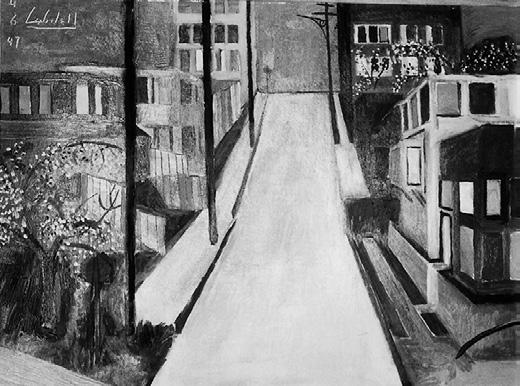
Lobdell’s work is included in the San Francisco Art Association’s Annual Exhibition at the San Francisco Museum of Art (now the San Francisco Museum of Modern Art), the ¬rst public exhibition of his work.
During this period, he is exposed to the work of Rothko, Reinhardt, Jackson Pollock, and William Baziotes, through exhibitions organized by Jermayne MacAgy, director of the Legion of Honor and wife of CSFA director Douglas MacAgy, and by Grace McCann Morley at the San Francisco Museum of Art.
An oil painting by Lobdell is awarded First Prize at the Minnesota State Fair.
November 19, 1947–January 4, 1948. Lobdell’s painting Dance in the Spring is shown in the Second Annual Exhibition of Painting at the California Palace of the Legion of Honor, San Francisco. The invitational exhibition includes works by Milton Avery, William Baziotes, Thomas Hart Benton, Marc Chagall, Salvador Dali, Max Ernst, Arshile Gorky, Adolph Gottlieb, Hans Hofmann, Edward Hopper, Rockwell Kent, Jacob Lawrence, Roberto Matta, Robert Motherwell, Georgia O’KeeVe, Richard Pousette-Dart, Charles Sheeler, ClyVord Still, Yves Tanguy, and others.
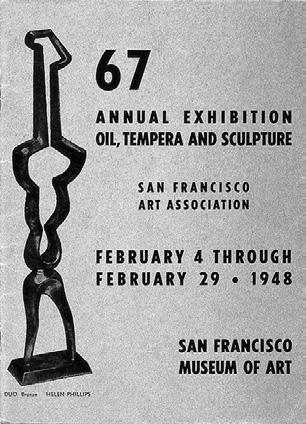

1948 February 4–29. Exhibits two untitled oil paintings in the San Francisco Art Association’s 67th Annual Exhibition: Oil, Tempera, and Sculpture at the San Francisco Museum of Art.
Studies lithography at CSFA, where he produces three lithographic editions of about twelve prints each. The class learns through much experimentation with unconventional processes. Walter Kuhlman is a fellow student in the class.
April 23–May 16. Two untitled paintings by Lobdell (nos. 535.48 and 536.48) are shown in the exhibition Young Artists of the Bay Area at the California Palace of the Legion of Honor.
1949
May 9–June 15. Participates in the exhibition Five Young Moderns at the Seashore Gallery in Sausalito, for which he produces a lithograph announcement.
Moves with his wife and son to 92 Central Street in Sausalito, where he sets up his studio.
First solo exhibition at the College of the Paci¬c in Stockton, California, where Lobdell teaches landscape painting and advanced studio painting during the summer.
Teaches painting classes for children and adults at the California Palace of the Legion of Honor (and again in 1949).
Lobdell exhibits two lithographs, Untitled No. 1 and Untitled No. 2 in the San Francisco Art Association’s Twelfth Annual Drawing and Print Exhibition at the San Francisco Museum of Art. Untitled No. 1 is awarded the Artists’ Council Prize.
Participates in a group exhibition organized by Kenneth Sawyer at Reed College in Portland, Oregon.
October 20–November 14. Participates in the San Francisco Art Association’s Twelfth Annual Watercolor Exhibition at the San Francisco Museum of Art.
Moves to a studio at 24th and Mission Streets in San Francisco. This is a productive time for Lobdell, which extends through the ¬rst half of 1950.
Enrolls in David Park’s painting class at CSFA, though he mostly continues to work autonomously in his own studio.
Creates illustrations for the book Poems & Drawings: Kenneth Sawyer, Frank Lobdell, published by Bern Porter, San Francisco.
Exhibits in a two-person show with George Stillman at Lucien Labaudt Gallery, one of the only venues for contemporary art in San Francisco.

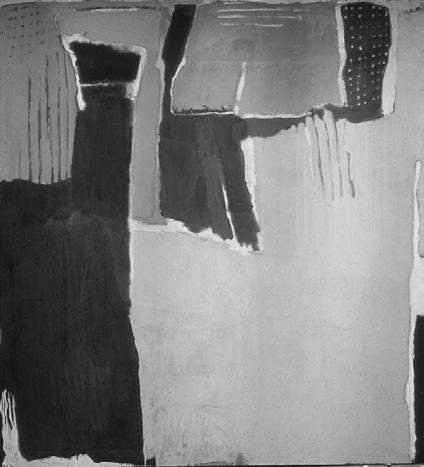

1950 February 10–March 12. Exhibits in the San Francisco Art Association’s 69th Annual Oil, Tempera, and Sculpture Exhibition at the San Francisco Museum of Art. His untitled oil painting is awarded the San Francisco Bank Prize.
Lobdell and Dorothy TaYnder divorce.
May 24–June 18. He receives a Purchase Prize for the lithograph Apr. 1948 in the 14th Annual Drawing and Print Exhibition of the San Francisco Art Association, where he also exhibits nine ink drawings.
Two of Lobdell’s paintings are shipped to London, purchased by the Waddington Galleries.
In June, Lobdell applies to teach at CSFA.
Begins a relationship with Annalise Korner, a psychologist at Mt. Zion Hospital in San Francisco, who is very supportive of him and his work. He and Annalise regularly see Richard and Phyllis Diebenkorn socially.
Diebenkorn leaves to attend graduate school in New Mexico, and in June, Frank and Annalise take a train to Albuquerque to visit him. One evening, Diebenkorn pulls out painting materials, and they stay up all night, working together on a large red painting, Diebenkorn on one side and Lobdell on the other. Lobdell is in New Mexico on June 25 when the Korean War breaks out.
Distressed over the Korean War, and motivated by the strength of the U.S. dollar in Europe, Lobdell plans to leave for Paris. In San Francisco, Annalise arranges for a friend to store Lobdell’s paintings at his mansion near the Presidio, and before Lobdell’s departure, he opens his home for a party and showing of the paintings. With funds from the sale of a painting, Lobdell leaves for Paris, stopping in New York to stay brie‰y with John Hultberg.
On September 4 he arrives in Paris. He enrolls at the Académie de la Grande Chaumière, where he studies on the G.I. Bill until 1951. He makes many drawings and visits the museums, which are just beginning to recover from the occupation and war, and where he spends time looking at paintings by Rembrandt and Goya. While in Paris, he receives the devastating news that Annalise has ended their relationship.

Lobdell’s passport, issued in August 1950.

1951
During the winter, Lobdell works in a studio at the Académie Colarossi in the Latin Quarter, a building inhabited by American artists and G.I.s. His friends in Paris include Steve Pace, Sam Francis, Jerry [Julius] Hatofsky, Claire Falkenstein, Seymour Boardman, and Walter and Dora Kuhlman.
Falkenstein receives an invitation to exhibit in the 6ième Salon des Réalités Nouvelles at the Petit Palais, which she passes around to others in the Colarossi studios. Several artists, including Kuhlman and Lobdell, pile their paintings into a large Hispano-Suiza automobile and deliver them to the exhibition. They later visit the exhibition and see their works, as well as Picasso’s antiwar painting, Massacre in Korea (1951). French critics react to their work by dubbing them “the wild pigs.” A wealthy collector invites them to her home and attempts to discourage them from continuing to paint in this manner.
He tours Brittany with wine merchant André Guilbert, Hatofsky, Pace, and others, traveling in a tiny Simca. In Brittany, they are joined by the Kuhlmans, who travel separately. The group later travels to the south of France.
Returning to the United States on September 12, Lobdell again stops in New York, staying at Pace’s apartment in Greenwich Village. He visits Still, Hultberg, and Hatofsky in New York City. He then travels to Albuquerque to visit Diebenkorn.
Back in San Francisco, he meets Ernest Briggs, and they decide to rent a space together at 645 Chestnut Street in North Beach.
Working in isolation during the 1950s, Lobdell is haunted by Senator Joseph McCarthy’s House Unamerican Activities Committee investigations, which spur him to make connections to earlier “dark periods” in history, and lead him to look particularly at paintings by Goya and other artists.
1952 He frequents Harrington’s Bar on Front Street in San Francisco, where he meets Dick Hartford, who oVers him work thirty hours a week cutting paper at Hartford’s Printing Plant. His two-day work schedule allows him to paint the rest of the time.
Through Peggy Dixon, Budd Dixon’s wife, Lobdell meets Ann Morency, a freelance fashion artist working in San Francisco, who later gains recognition as an exhibiting artist.
Lobdell and Ann Morency marry in Sausalito on October 31.



Moves his studio to the AudiVred Building at 9 Mission Street, San Francisco, where he shares a space with Briggs.
1953 Felix Landau Gallery in Los Angeles includes works by Lobdell and James Budd Dixon in the exhibition Six San Francisco Painters.
With his painting November 1953, Lobdell begins to paint what he refers to as “my own paintings.” They arise from his struggle to achieve a basic imagery without the luxury of much color and to develop something that he feels belongs to him.
1954 When Briggs leaves for New York, Lobdell begins to share his studio with Jack JeVerson, with whom he will develop a lifelong friendship. They remain studio mates through 1958. At the 9 Mission Street studio, he spends extensive time with JeVerson, Kuhlman, and Charlie SaVord.
Lobdell sends four paintings to New York for an exhibition being organized by Briggs, which is also to include works by Budd Dixon and Jack JeVerson. New York artists intervene to prevent the works from being shown, and the paintings are shipped back to San Francisco collect.
1955 July–October. Lobdell’s oil painting January 1955 is included in the exhibition Paci¬c Coast Art in the United States Section of the Pavilion of Nations at the Third International Biennial of São Paulo, Brazil, Museu de Arte Moderna, São Paulo. The exhibition is a collaborative project of the Los Angeles County Museum of History, Science and Art, and the San Francisco Museum of Art, which were invited by the Museum of Modern Art in New York to organize the exhibition. The works were selected by Marvin C. Ross of the Los Angeles County Museum, and Grace L. McCann Morley, director of the San Francisco Museum of Art. Other artists in the exhibition include Ruth Armer, Richard Diebenkorn, Walter Kuhlman, Robert McChesney, and Peter Shoemaker.
1956 The San Francisco Museum of Art presents Paci¬c Coast Art, a recreation of the exhibition presented in the U.S. pavilion of the 1955 São Paulo biennial. The exhibition travels over the next year to the Cincinnati Art Museum, Colorado Springs Fine Arts Center, and the Walker Art Center, Minneapolis.
The Municipal Art Center, Long Beach, presents the exhibition California Painting: 40 Painters in collaboration with the San Francisco Museum of Art. The show includes works by Lobdell, Ruth Armer, Richard Diebenkorn, Walter Kuhlman, David Park, John Saccaro, Peter Shoemaker, and others.
The exhibition California School—Yes or No? at the Oakland Art Museum includes works by Elmer BischoV, Jay deFeo, Richard Diebenkorn, Sam Francis, Sonia GechtoV, James Kelly, Walter Kuhlman, Frank Lobdell, David Park, Hassel Smith, and ClyVord Still. Lobdell is included in the Santa Barbara Museum of Art exhibition California Artists.

1957 At Elmer BischoV’s suggestion, Lobdell is invited to join the faculty of CSFA as instructor of graduate and undergraduate painting and drawing, and teaches a night class.
March 25–April 11. Walter Hopps includes Lobdell in the inaugural exhibition of the Ferus Gallery in Los Angeles, which he has titled Objects on the New Landscape Demanding of the Eye. Thereafter he is included in annual group exhibitions at Ferus until 1963, and then again in 1965.
Lobdell and Ann ¬nd a large ‰at on Golden Gate Avenue in San Francisco, and he spends a week rebuilding the apartment before they move in.
He and Kuhlman work at the Glad Hand Bar in Sausalito and later ¬nd work there for Jack JeVerson.
Meets Wilfred Zogbaum, a New York painter and close friend of Jackson Pollock (who had lived next door to Zogbaum in Springs, Long Island). Zogbaum lives in North Beach and regularly throws large parties with Lobdell’s former teacher from Minneapolis, Cameron Booth, who now teaches in San Francisco.
Sam Francis, John Hultberg, and Lawrence Calcagno introduce New York gallery owner Martha Jackson to Lobdell’s work and encourage her to visit his studio. Jackson travels to San Francisco and selects four paintings from Lobdell’s studio—Untitled (black and white) (1953) and November 1953 Number 1, which she purchases outright, and March 1954 (2) and April 1954 (1), which she purchases later in New York. (These same paintings had traveled to New York in 1954, but were returned without being shown.)
1958 June. Martha Jackson exhibits the four paintings on four walls upstairs in her Manhattan gallery. At her insistence, Lobdell attends the opening, traveling to New York by Greyhound bus with his wife. The show is reviewed in the New York Times by Dore Ashton (June 8, 1958, part II, p. 13), who writes that Lobdell “is working in an imaginative style related to symbolism but incorporating the Western variants of abstract expressionist techniques.” In New York, he meets Hilton Kramer and a number of New York artists.
While on the East Coast, Lobdell sees Jerry and Anita Hatofsky in Hoboken and visits Zogbaum in East Hampton. There he also meets Alfonso Osorio and visits his mansion—the inspiration for Fitzgerald’s setting for The Great Gatsby. He sees Osorio’s art collection, which includes works by Pollock, DubuVet, and “very young Stills.” He spends the summer on Long Island, in East Hampton and Springs.
With money from Martha Jackson’s purchase of his paintings, he buys a 1949 Chevrolet from Zogbaum. Returning to California, he and Ann stop in Minnesota to visit his family in Excelsior.
Lobdell’s work is included in the exhibition International Art of a New Era at the Osaka International Festival, Osaka, Japan, organized by Michel Tapié.

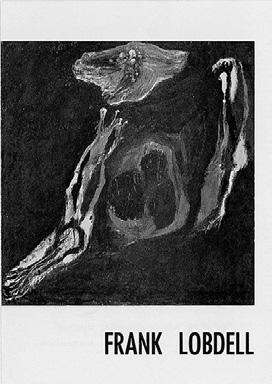

1959 Lobdell begins occasionally attending a drawing group consisting of fellow CSFA instructors Diebenkorn, Elmer BischoV, and David Park. After Park’s death in September, BischoV invites Lobdell to join the group. (He continues drawing with Diebenkorn and BischoV until the mid-1960s, driving up to San Francisco for the weekly sessions while Artist-in-Residence at Stanford in 1965. The group breaks up around 1965, when all leave CSFA for teaching positions at other institutions.)
Ninfa Valvo, curator at San Francisco’s M. H. de Young Memorial Museum, visits Lobdell’s studio and begins to organize his ¬rst solo museum exhibition.
The Women’s Board of the San Francisco Museum of Art purchases the painting April 1959 for the museum’s collection, through the Grace McCann Morley Purchase Fund.
1960 January 19–February 18. Lobdell’s solo exhibition Frank Lobdell: Exhibition of Paintings, organized by Ninfa Valvo, at the M. H. de Young Memorial Museum in San Francisco. Included are May 1955, December 1955, December 1957, Winter 1957, Fall 1958, December 1958, February 1959, April 1959, June 1959, August 1959, Summer 1959, and October 1959
January. Lobdell receives the Nealie Sullivan Award for a California Artist, named for a secretary at CSFA. The annual award, given by the San Francisco Art Association, had been set up the previous year by the bequest of Adeline Kent Howard as special recognition of a promising artist living and working in California. Lobdell is selected by jurors Nell Sinton of the San Francisco Art Commission, Professor Herschel B. Chipp of the U.C. Berkeley art department, and Oakland Museum director Paul Mills. The $1,000 prize allows him to cut back on his teaching load and devote more time to studio work. The March issue of Arts magazine (vol. 34, no. 6) runs a photo of Lobdell in “People in the Arts,” with an announcement of his Nealie Sullivan Award.
April 3–May 8. Lobdell’s oil painting Gray No. 1 (1957) is included in the exhibition 60 American Artists: Abstract Expressionist Painting of the Fifties at the Walker Art Center in Minneapolis. Works by William Baziotes, Willem de Kooning, Helen Frankenthaler, Arshile Gorky, Adolph Gottlieb, Philip Guston, Grace Hartigan, Hans Hofmann, Franz Kline, Joan Mitchell, Stephen Pace, Jackson Pollock, Ad Reinhardt, Mark Rothko, ClyVord Still, and other prominent artists are also included.
April 19–May 7. Most of the paintings from the de Young Museum exhibition travel to New York for the exhibition Frank Lobdell: Catalogue of Paintings, 1953–1959, at Martha Jackson Gallery. A catalogue is published with black-and-white reproductions and an introduction by Erik Bauersfeld. Walter Hopps purchases the painting March 1954 (2) from Jackson; he later donates it to the San Francisco Museum of Modern Art.
During this period, Frank and Ann occasionally get together socially with Richard and Phyllis Diebenkorn, usually at the Diebenkorns’ Berkeley home, often staying all night. After dinner they customarily pull out their drawing materials and draw. Lobdell and Diebenkorn show a number of these drawings around 1960 in an exhibition at Herb Wasserman’s Triangle Gallery in North Beach.
Michel Tapié includes Lobdell in his book Morphologie Autre, published by the International Center of Aesthetic Research in Turin, Italy.

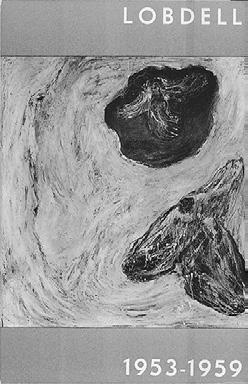

1961 April 3–29. Participates in Group Exhibit, Ferus Gallery, Los Angeles, with John Altoon, Billy Al Bengston, Jay DeFeo, Sonia GetchtoV, Ed Kienholz, John Mason, Kenneth Price, Richards Ruben, and Hassel Smith.
Paints Summer Mural 1961, working every day for four months. He completes the painting in September.
Summer Mural 1961 is selected for an exhibition at the San Francisco Museum of Art organized by Fred Martin, Robbie Connell, and a group of graduate students. Before the reception, the painting is removed from the exhibition, rejected by the museum for its phallic imagery, which causes a great commotion. Lobdell removes a second painting and withdraws from the exhibition. Artists Joan Brown and William Wiley threaten to pull their works from the show in protest. During the ensuing controversy, Lobdell temporarily resigns from his teaching position at CSFA.
December 15, 1961–January 17, 1962. The exhibition Drawings by Richard Diebenkorn and Frank Lobdell is presented at the Pasadena Art Museum, organized by Walter Hopps through the Ferus Gallery. Diebenkorn exhibits thirteen ¬gurative drawings, and Lobdell shows twelve abstract drawings in ink, tempera and crayon.
1962 Lobdell and Ann move to an apartment at 722 Filbert Street in San Francisco.
April 16–May 5. Walter Hopps presents a solo exhibition of Lobdell’s work at Ferus Gallery in Los Angeles.
October 23–December 2. Lobdell’s paintings Untitled 1959, Fall 1960, and January 1962 are included in Fifty California Artists at the Whitney Museum of American Art, New York. The exhibition is organized by the San Francisco Museum of Art in association with the Los Angeles County Museum of Art. It subsequently travels to the Walker Art Center, Minneapolis; Albright-Knox Art Gallery, BuValo; and the Des Moines Art Center. Artists in the exhibition include Diebenkorn, BischoV, Oliveira, James McGarrells, Robert Loberg, William Wiley, and others.
November 6–December 23. Lobdell’s painting Black Edge III 23 March 1962 is included in The Artist’s Environment: West Coast, presented at the Amon Carter Museum of Western Art, Fort Worth, Texas, in collaboration with the UCLA Art Gallery and The Oakland Art Museum, where it subsequently travels. Frederick S. Wight of
UCLA organizes the exhibition and authors its catalogue. Among the 43 artists in the exhibition are BischoV, Diebenkorn, Lorser Feitelson, Sam Francis, Morris Graves, Helen Lundeberg, Oliveira, Park, Rothko, Smith, and Still.
November 29–December 29. Lobdell is included in the exhibition San Francisco 9 at the Contemporary Arts Museum, Houston, curated by James “Jack” Boynton. Works by Jeremy Anderson, James Budd Dixon, Wally Hedrick, Alvin Light, Fred Martin, Manuel Neri, Carlos Villa, and James Weeks are also shown.
1963 March 21–April. A painting by Lobdell is included in the 82nd Annual Exhibition of the San Francisco Art Association, at the San Francisco Museum of Art, for which he serves as a juror.
April 20–May 21. Solo exhibition, Frank Lobdell: Paintings and Drawings, in New York at Martha Jackson Gallery.
In June, Artforum (vol. 1, no. 12) features illustrations of four drawings by Lobdell.
Frank’s father Earle Lobdell dies on July 16.
Son Judson Earle Lobdell is born on July 31.
The exhibition Drawings by Elmer Bischoff, Richard Diebenkorn, and Frank Lobdell is shown at the Achenbach Foundation for the Graphic Arts, California Palace of the Legion of Honor, San Francisco.
September. Lobdell participates in an exhibition and auction at the California Palace of the Legion of Honor, to bene¬t the San Francisco Art Institute.
Appointed Chair of Graduate Program Committee, San Francisco Art Institute.
Group exhibition, organized by Michel Tapié at the International Center of Aesthetic Research in Turin, Italy, includes works by Lobdell, James Budd Dixon, Claire Falkenstein, and Walter Kuhlman.
November 17–December 15. The Art Center in La Jolla, California, presents the Fourth Art Center Annual of California Painting and Sculpture, which includes Lobdell’s painting 15 April. Lobdell serves as a San Francisco juror for the invitational section of the exhibition, along with Fred Martin and Peter Voulkos.


1964 Moves with his family to an apartment on Jones Street in San Francisco.
He works with Joseph Zirker at Original Press in San Francisco’s Mission District, where he produces two lithographic editions.
Lobdell meets Alger Hiss at a dinner party at a mansion in San Francisco’s Paci¬c Heights. It is hosted by a psychiatrist to whom Lobdell gives weekly lessons in painting, working from a model. (Diebenkorn had passed the tutoring job to Lobdell on leaving the area for a teaching job.) Lobdell converses with Hiss, who is “keen on painting” and familiar with the New York painters, and who asks to visit Lobdell’s studio. Soon after, Hiss comes to the studio and is “very taken with the work.” In the course of their conversation, Lobdell expresses his misgivings and doubts about the Korean War to Hiss, who con¬rms the correctness of Lobdell’s analysis and antipathy to the war. Lobdell later sends Hiss a catalogue for his 1966 exhibition at the Pasadena Art Museum, and receives a letter in reply.
September 17–October 27. His work appears in the exhibition American Drawings at the Solomon R. Guggenheim Museum, New York. The exhibition travels to the Dallas Museum of Fine Arts, Seattle Art Museum, University of Michigan Museum of Art in Grand Rapids, and the Krannert Art Museum of the University of Illinois, Champaign-Urbana.
November–December. Solo exhibition, Frank Lobdell: Peintures, Gouaches, Dessins, at Galerie D. Benador in Geneva, Switzerland.
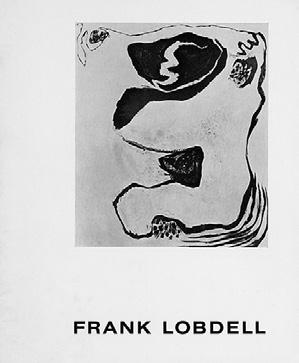
Catalogue for Lobdell’s exhibition at Galerie Anderson-Mayer, Paris, April 1965, with the painting April 1954 Number 1.
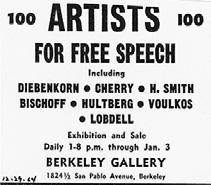
ad for the Berkeley Gallery exhibition 100 Artists for Free Speech, December 1964.
December 22, 1964–January 3, 1965. Lobdell participates in 100 Artists for Free Speech at Berkeley Gallery, Berkeley, California. The exhibition, which also includes works by BischoV, Diebenkorn, Hassel Smith, Peter Voulkos, and others, is a bene¬t for the FacultyStudent Legal Defense Fund and the Academic Publicity Fund of the University of California.
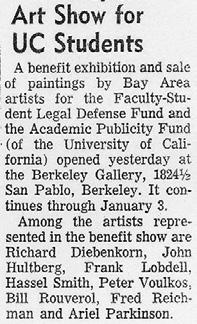
1965
February 9–March 6. Paintings by Lobdell are shown in the group exhibition Figuration at Martha Jackson Gallery in New York. Gallery press materials describe his works as “Personal Images.”
April 7–May. Solo exhibition at Galerie Anderson-Mayer, 15 rue de l’Echaude, Paris, includes eight paintings, eleven gouaches and six drawings, dating from 1954 to 1964. An illustrated catalogue is published, with an essay by Michel Tapié.
At the suggestion of Nathan Oliveira, Lobdell begins a long association with Stanford University, taking leave from his teaching duties at CSFA. At Stanford, he succeeds Diebenkorn as Artist-inResidence, with the assignment of organizing a graduate program in the art department.
Moves his studio to Hamilton Street in Palo Alto, where he works until 1979. Lobdell begins to draw regularly from the model with fellow Stanford instructors Oliveira, Keith Boyle, and Jim Johnson, meeting in each other’s studios.

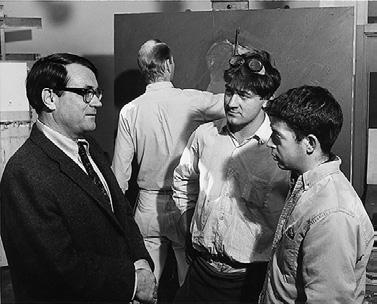
He begins looking at reproductions of Goya’s print series Los Caprichos (The Caprices) and Los Desastres de la guerra (The Disasters of War). He speci¬cally studies Goya’s painting Saturn Devouring His Son, which he sees as an allegory of war. The ¬gure of Saturn soon emerges as a central image in Lobdell’s work. He also studies Goya’s The Witches’ Sabbath, noting particularly how the painting’s composition circles around the dominant black goatlike ¬gure on the left. The theme of a central image surrounded by others becomes a signi¬cant element in his painting and would appear again in the later composition for the large painting Summer 1967 (In Memory of James Budd Dixon).
By the mid-1960s, Lobdell has formed strong feelings against U.S. policies in Vietnam. His stance is partly informed by Jules Roy’s book The Battle of Diem Bien Phu, recounting failed policies in the former French colony. Lobdell relates: “My father was in the First World War, I was in the Second, Frankie in Vietnam. This whole century’s been nothing but wars.”
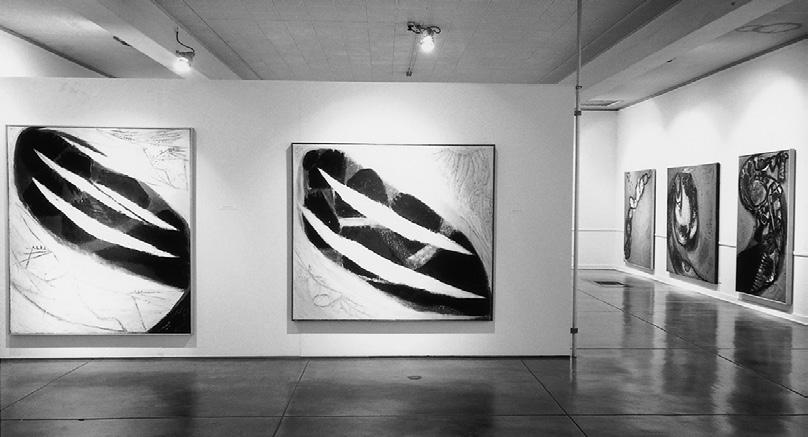
1966 Joins the faculty of the Art Department at Stanford University, where he is invited to stay on in a tenured position as Associate Professor. Later that year he is appointed Chairman of the Graduate Program in Painting, Sculpture, and Lithography at Stanford.
March 15–April 10. The Pasadena Art Museum presents Frank Lobdell: Paintings and Graphics from 1948 to 1965, organized by Walter Hopps with installation design by Ninfa Valvo. The exhibition of 57 paintings and 26 graphic works is accompanied by an illustrated catalogue. An opening reception is held at the museum on the evening of March 15, and on March 23, Hopps gives a gallery talk on Lobdell’s work. After closing in Pasadena, the show travels to the Stanford Art Museum for exhibition in May. A review by John Coplans appears in the Summer issue of Artnews (vol. 65, no. 4).

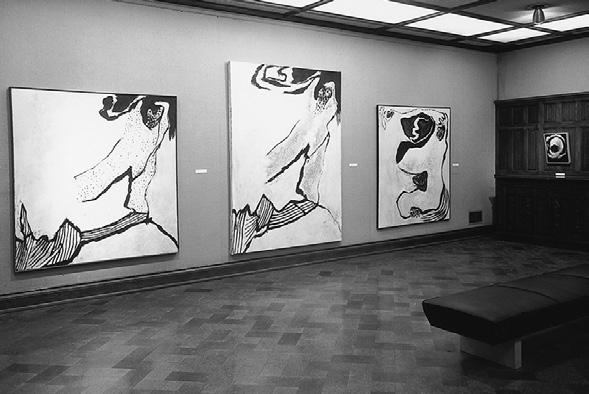


Announcement for solo exhibition at the Stanford



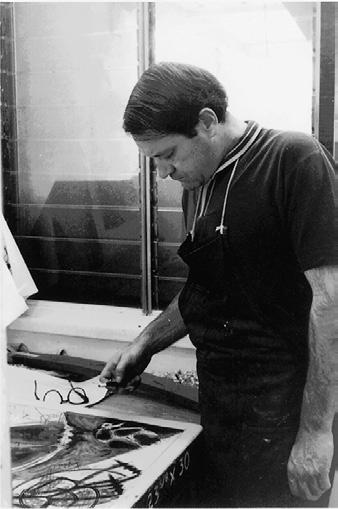


During the summer, as a Fellow at the Tamarind Lithography Workshop in Los Angeles, Lobdell completes 33 lithographs of which 32 are editioned. The prints are produced with close collaboration from printer fellows Kinji Akagawa, Bob Bigelow, Ernest de Soto, John Dowell, Bob Evermon, and Jack Lemon, under the technical supervision of CliVord Smith, studio manager.
At Tamarind, he develops a new method of striking the stone using transfer paper, which leaves him with an image for developing subsequent prints. He uses elements of these transfer impressions to create new compositions. In this process, he arrives at his approach for constructing the composition for his painting Summer 1967 (In Memory of James Budd Dixon). He uses his time at Tamarind “as a means of getting all the parts together for the big painting; that goes back to the Guernica . . . that was the lesson I got.”
November 5–December 4. He exhibits the 32 editioned Tamarind lithographs—26 black-and-white, and 6 color—at Stanford Art Gallery. In December, they are shown at San Jose City College in San Jose, California.



1967
Lobdell creates Summer 1967 (In Memory of James Budd Dixon), a painting whose composition he had developed the previous year at Tamarind. The painting’s title notes the recent passing of his friend Budd Dixon, as a way to acknowledge the signi¬cance of a painter whom Lobdell feared might otherwise disappear from the history of Bay Area painting.
Working with Ernest de Soto, Lobdell produces one lithograph at Collector’s Press, formed in 1967 with equipment from Joseph Zirker’s old Original Press.
In 1967–68, he and Nathan Oliveira regularly meet at his Palo Alto studio for ¬gure drawing sessions with a model.
Lobdell’s print Untitled 1966 is selected by the Smithsonian Institution National Collection of Fine Arts for inclusion in their program of rotating exhibitions of paintings and prints by contemporary artists at the White House.
October–December. A solo exhibition of Lobdell’s lithographs is presented at Marylhurst College in Portland, Oregon.


1968
Students and faculty at Stanford call for a shutdown of the university during anti-Vietnam War demonstrations, and classes are cancelled. Lobdell spends the time in the drawing studio working on two antiwar posters, which show caricatures of President Richard Nixon as a spotted dog being patted by a four-star general. One of them is later donated to San Francisco public television station KQED for a fundraising auction. The purchaser subsequently produces a postcard using Lobdell’s image.
November 12–December 17. Lobdell’s painting February 1959, in the collection of the Los Angeles County Museum of Art, is included in the museum’s exhibition Late Fifties at the Ferus.
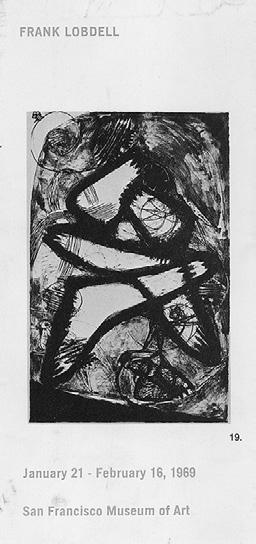
1969 January 21–February 16. The San Francisco Museum of Art presents Frank Lobdell: Twenty-Seven Lithographs and A Large Painting. A brochure is published with illustrations and an essay by Gerald Nordland. The centerpiece of the exhibition is the 14H-foot-long painting Summer 1967 (In Memory of James Budd Dixon). He also exhibits a number of lithographs and hand-colored transfer prints produced at Tamarind in 1966 as developmental studies for the large painting. His concept for the exhibition re‰ects the early impact of his experience of viewing Guernica and its preparatory studies in 1940 in Chicago.

July. Gallery owner Martha Jackson drowns in the pool of her home in Los Angeles. The Bolles Gallery in San Francisco proceeds with plans for an exhibition of artists from her gallery, which had been organized with Jackson’s assistance. The exhibition opens on July 31.
July–August. Solo exhibition at Galerie Anderson-Mayer, Paris. Frank’s mother Ruth Lobdell dies on September 9.
November 21, 1969–January 4, 1970. Participates in the exhibition Kompas 4: West Coast USA at the Van Abbemuseum in Eindhoven, The Netherlands. The exhibition of nineteen artists includes Lobdell, Still, Diebenkorn, and Hassel Smith as “¬rst generation” West Coast artists. Lobdell paintings exhibited include November 1953, March 1954, and May 1955.

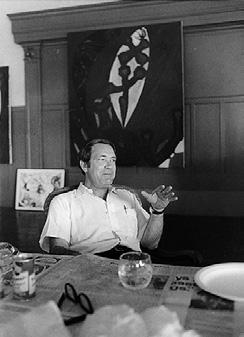
Lobdell begins work on his Dance Series, inspired principally by medieval woodcuts of the Dance of Death. He also draws on his study of Goya, Picasso, and Matisse, and cites Rembrandt’s use of light in The Conspiracy of the Batavians (1661) at the Stockholm Museum:
The light bounces all around, all the way down that table. It’s connecting things, in Rembrandt’s painting, so I thought of the idea of light connecting this central Wgure to others. . . . I’m trying to keep the space shallow, but at the same time suggesting the form. . . . The original idea was the Dance of Death. That’s what I was thinking of.
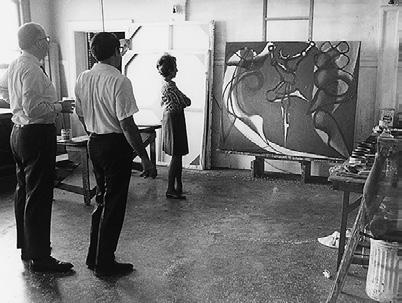



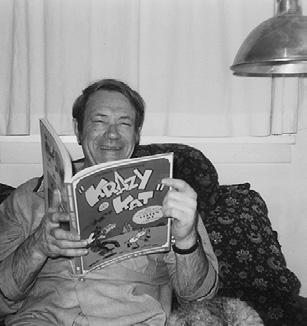


1971
February 12–March 14. Over six thousand visitors attend Lobdell’s solo exhibition at the Cheney Cowles Museum at Eastern Washington University, Spokane. The exhibition features the large painting Summer 1967 (In Memory of James Budd Dixon) and a selection of lithographs.
March–April. Four of Lobdell’s Dance Series paintings are sent to The Corcoran Gallery of Art in Washington, D.C., and are included in the Thirty-Second Annual Exhibition of Contemporary American Painting, organized by Walter Hopps. Hopps had invited a small number of artists to exhibit—among them Lobdell, Sam Francis, Roy Lichtenstein, and Ed Ruscha—then asked them to recommend others for inclusion in the show. Lobdell remarks that ClyVord Still is the most important American painter of the time, and Hopps borrows a Still painting from a private collector, which he hangs with Lobdell’s works in the exhibition. A catalogue is published, and several of the paintings, including Lobdell’s Dance V (1970), are reproduced in Smithsonian Magazine (March 1971).

for

May 1–28. St. Mary’s College Art Gallery in Moraga, California, exhibits the Dance Series, and produces a large poster for the show. Lobdell begins working on sculptures in wood and clay.
Receives a scroll in the mail from descendants of Samuel Clemens congratulating him on his appointment as a Knight of Mark Twain by the International Mark Twain Society.

1972 March 1–25. After the Corcoran Gallery exhibit, the Dance Series paintings are shipped to New York, where they are shown in a solo exhibition at the Martha Jackson Gallery. A preview reception is held at the gallery on the evening of February 29.
32nd Biennial Exhibition of Contemporary American Painting at The Whitney Museum of American Art, New York, includes works by Lobdell. A catalogue is published for the exhibition.

Announcement of the exhibition Frank Lobdell: Paintings and Drawings 1955–1973 at Martha Jackson Gallery, New York, October 17–November 16, 1974.
1973 Lobdell exhibits ¬gure drawings at Smith Andersen Gallery in Palo Alto, from the last group done in drawing sessions with Nathan Oliveira and Keith Boyle.
1974 October 17–November 16. Lobdell exhibits large canvases— including January 1971, Winter 1972, Spring 1972, Summer 1973, and Fall 1973—as well as smaller paintings and works on paper, in a solo exhibition at Martha Jackson Gallery, New York. A brochure is published with color illustrations of recent paintings. Lobdell attends a preview reception at the gallery on October 16.
1975 February 16–March 30. The Walker Art Center in Minneapolis exhibits Selections from the Martha Jackson Collection. Lobdell’s painting December 1955 is among the seventeen works on exhibit, along with works by Karel Appel, Alberto Burri, de Kooning, Lucio Fontana, Sam Francis, Gorky, Marsden Hartley, Pollock, and others. Solo exhibition at Martha Jackson Gallery in New York.
1976 March 7–April 17. Lobdell is included in the exhibition The Last Time I Saw Ferus, 1957–1966, at the Newport Beach Art Museum, California. Other artists in the exhibition include Jay DeFeo, Diebenkorn, Sonia GechtoV, Hassel Smith, Still, and Julius Wasserstein.
He begins printing a series of monotypes at the Stanford University art department, with the assistance of Lee Altman, a graduate student studying printmaking with Nathan Oliveira. Over the next ¬fteen years, he produces approximately 100 prints at Stanford. When Altman leaves Stanford to work at Paula Kirkeby’s 3EP Press in Palo Alto, Lobdell continues his monoprinting there.
September 3, 1976–January 2, 1977. Lobdell’s 5 October 1949, March 1954, and Black Edge II, 3 March 1962 are included in Painting and Sculpture in California: The Modern Era at the San Francisco Museum of Modern Art. The exhibition travels to the National Collection of Fine Arts, Smithsonian Institution, Washington, D.C. (May 20–September 11, 1977).
1977 March 8–April 26. Paula Kirkeby presents a solo exhibition of Lobdell’s monotypes at Smith Andersen Gallery in Palo Alto.
April 22–June 5. Two paintings by Lobdell are shown in the exhibition Collectors Collecting: American Abstract Art Since 1945, which occupies six galleries of the San Francisco Museum of Modern Art. Lobdell’s paintings—Untitled 1959, from the museum’s collection, and Summer 1967 (In Memory of James Budd Dixon)—are hung in a gallery that includes works by de Kooning, Diebenkorn, Gorky, Guston, Kline, Pollock, and others.
1978 Solo exhibition at Smith Andersen Gallery in Palo Alto.
1979 Lobdell and Morency separate. (They divorce in 1996.) He moves from Palo Alto to Bleeker studio at Stanford, where he maintains his studio until the late 1990s.




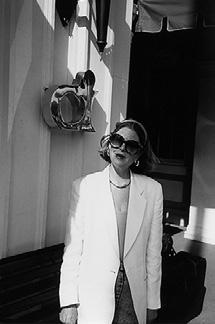
1980 March 20–April 17. Exhibits oil paintings Untitled Fall 1978 and Untitled Fall 1979; monotypes “III” September 29, 1976, “I” November 3, 1976, and “I” November 26, 1976; and drawings Untitled Spring 1975 and Untitled Spring 1975 in Bay Area Art: Then and Now at Suzanne Brown Gallery, Scottsdale, Arizona, along with BischoV, Alexander Nepote, Oliveira, Wayne Thiebaud, and Paul Wonner.
On April 9, Lobdell is interviewed at his Stanford studio by Terry St. John, Associate Curator of Art at The Oakland Museum, for the California Oral History Project of the Archives of American Art, Smithsonian Institution. (Lobdell later states that because of the poor quality of the recording and the noise of the birds outside his studio windows, much of the interview was dif¬cult to understand and later had to be rewritten. He now describes the interview as “one version of things, but they can be questioned too.”)
Through mutual friends, he meets painter and sculptor Virginia (“Jinx”) Rowan, daughter of George D. and Virginia Rowan, and niece of noted Los Angeles art patron and collector Robert A. Rowan, Jr. He and Jinx immediately begin a close relationship, later living together and sharing Jinx’s studio at Pier 70 in San Francisco.

1981 February 11–March 31. Charles Strong organizes a solo exhibition, Frank Lobdell Summer Mural 1961 and Related Drawings, at the College of Notre Dame Art Gallery, Belmont, California. A catalogue is published for the exhibition. The exhibition focuses on a single painting, Summer Mural 1961, a 6- by 20-foot canvas. (It is the same painting that was pulled from the San Francisco Museum of Art exhibition in 1961, when it caused “plenty of trouble” for the student organizers who, Lobdell says, had to “take the wrath” for exhibiting the work.) San Francisco Chronicle art critic Thomas Albright writes: “At a time when ‘major’ exhibitions . . . are measured largely in terms of the sheer quantity of work that they contain, it is refreshing, and a bit startling, to ¬nd a show that takes a single work seriously enough to display it virtually all by itself” (San Francisco Chronicle, March 12, 1981, “Datebook,” p. 60). The exhibition later travels to Pepperdine University Art Gallery in Malibu, California (October 25–November 25), and Reed College Art Gallery in Portland, Oregon. All three exhibitions are arranged by former graduate students of Lobdell, who are employed at those institutions.
Solo exhibition of drawings and prints at Smith Andersen Gallery, Palo Alto.
November. Lobdell produces a sequence of eight etchings (among his ¬rst prints in that medium) at 3EP Press, printed by Ikuru Kuwahara.

Announcement of the solo exhibition Frank Lobdell: Drawings and Prints, presented by Smith Andersen Gallery at 2140 Bush Street, San Francisco, 1982. Illustrated is the etching Untitled, 12.5.81, produced at 3EP Press.
1982 February 27–March 27. Smith Andersen Gallery in Palo Alto rents a space at 2140 Bush Street in San Francisco for a solo exhibition of Lobdell’s work. Included are April 1957; Black Edge III; Black Edge IV; I; V; III; January; Dance VII; Dance III; Spring; Summer I, and Fall.
Lobdell begins living between Bleeker Street and Jinx’s house on Octavia Street in San Francisco.
December 1982–January 1983. Lobdell’s ¬rst exhibition at Oscarsson-Hood Gallery in Manhattan includes the paintings Summer 1968; Winter 1969; Summer 1977; Untitled 1977; Spring 1978; Winter 1979; Winter ’81, and Summer ’82.

1983 January 20–March 27. The San Francisco Museum of Modern Art presents Frank Lobdell: Paintings and Monotypes, 1955–1981. The exhibition of twenty-seven paintings and twenty monotypes is organized by curator George Neubert. A catalogue is published. With emphasis on works created after 1976, this is Lobdell’s ¬rst major museum show since the 1966 Pasadena exhibition. Articles on the exhibition by Thomas Albright appear in the San Francisco Chronicle on January 30 and March 3. Lobdell’s sisters Phyllis and Doris travel to San Francisco to visit him and see the exhibition.


Begins working with David Kelso at made in California Press in Oakland, and produces his ¬rst color intaglios. The partnership continues until 2000 and results in nearly ¬fty intaglio editions.
December 7, 1983–January 7, 1984. Solo exhibition Frank Lobdell: Recent Paintings and Monotypes at Oscarsson-Hood Gallery, New York.

of
Frank





1984 Lobdell spends the summer as Visiting Artist at the Skowhegan School in Maine. He and Jinx drive from California via Excelsior, Minnesota, for a family visit. They continue north, through Canada, and down to Maine. At Skowhegan, he does many drawings, but produces little other work of note. They spend a weekend with Steve and Pam Pace in Stonybrook on the Maine coast. Victoria Oscarsson, who has shown Lobdell’s work at her Oscarsson-Hood Gallery in New York, visits him at Skowhegan.


1985 February 27–March 30. Solo exhibition Frank Lobdell: Paintings and Gouaches, 1958–1972 at Oscarsson-Hood Gallery, New York. Included in the show are the paintings Untitled (1958); Fall 1964; Summer 1967 (In Memory of James Budd Dixon); Spring 1972, and works on paper.
April. An exhibition at the ECHO Gallery in Austin, Texas, includes works by Stanford art faculty members Lobdell, Oliveira, Boyle, and Kristina Branch.
November. Spends a week as Visiting Artist at the Tyler School of Art of Temple University, Philadelphia, where he executes seven lithographs. In producing the prints, he draws on Mylar and transfers the image to the plate.


Announcement for Lobdell’s concurrent solo exhibitions at Temple University, November–December 1985, with the painting May 1983.

November–December. Solo exhibitions are presented at the Tyler Gallery (November 15–December 12) and the Tyler School of Art (November 20–December 14) at Temple University, Philadelphia.
1986 June 9–August 1. Serves as Artist-in-Residence at New York Studio School of Drawing, Painting and Sculpture.
Through Stanford University, he wins a Pew Foundation grant, awarded to faculty who have arrived at critical points in their work. In the Pew project, Lobdell works with David Kelso at made in California over a period of several months, continuing his exploration of etching begun in 1981 at 3EP Press. The grant frees him to focus on the medium, and to consider the development of his etchings in relation to his primary work in painting.
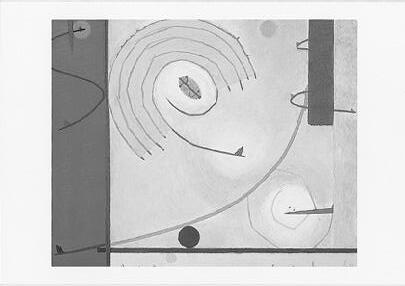


1987 March 10–April 4. Solo exhibition Frank Lobdell: Recent Paintings at John Berggruen Gallery in San Francisco includes paintings and lithographs.
1988 A suite titled Frank Lobdell—Seven Etchings is published by made in California. The prints, all produced in 1987, are black-and-white hardground etchings, some with aquatint.
September 27–October 29. Charles Campbell Gallery in San Francisco presents the exhibition Frank Lobdell: Figure Drawings 1964–1974, for which a catalogue is published. Located at 645 Chestnut Street in North Beach, the gallery is in the same space Lobdell rented in 1951 with Ernest Briggs.
September 27–November 27. Solo exhibition Frank Lobdell: Recent Etchings and Aquatints at the Stanford University Museum of Art. A catalogue is published, with an essay by Caroline A. Jones.
Fall. Solo exhibition Frank Lobdell: Paintings and Prints at Smith Andersen Gallery, Palo Alto.
Receives Gold Medal for Distinguished Achievement in Painting from the American Academy and Institute of Arts and Letters, New York.

Announcement for the exhibition Frank Lobdell: Figure Drawings 1964–1974 at Charles Campbell Gallery, San Francisco, September 27–October 29, 1988.

Announcement for Stanford exhibition, 1988. Illustrated are two working proofs and the published state (bottom) of the etching Untitled, 10.29.86.

Catalogue for the exhibition Frank Lobdell: Figure Drawings 1964–1974, at Charles Campbell Gallery, San Francisco, 1988.

Announcement for the solo exhibition Frank Lobdell: Paintings and Prints at Smith Andersen Gallery, Palo Alto, Fall 1988. Illustrated is the lithograph Untitled, Tyler 11.6.85 (handcolored 8.27.88).

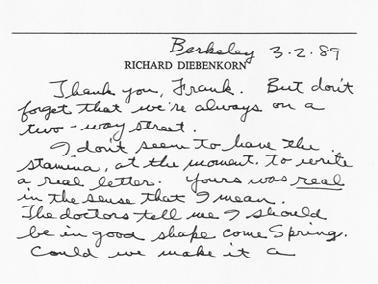

1989 April 23–June 3. The Wiegand Gallery at the College of Notre Dame in Belmont, California, presents the exhibition The Abstract Expressionist Years & After: Jack Jefferson, Frank Lobdell, Alvin Light. The exhibition includes Lobdell’s oil paintings April 1957; Untitled (1958); June 1964; Summer 1968; Dance VI (1970); Fall 1980; Untitled, August 1988; and Untitled, October 1988. A catalogue is published for the exhibition.
Appointed Paul L. and Phyllis Wattis Professor of Art, Stanford University. The position includes an honorarium and a quarterterm oV from teaching (which he takes in 1990).
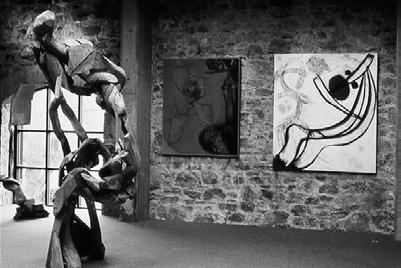
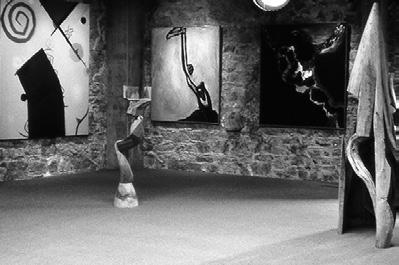


for


1990 September 4–October 13. Solo exhibition Frank Lobdell: Recent Paintings, Drawings, Prints at Campbell-Thiebaud Gallery in San Francisco.
Cathryn M. Cootner, textile curator at the Fine Arts Museums of San Francisco, sends Lobdell a catalogue for the exhibition Anatolian Kilims: The Caroline and H. McCoy Jones Collection (San Francisco: Fine Arts Museums of San Francisco, and London: Hall Publications, 1990). Cootner had seen Frank’s recent paintings and sent him the catalogue because she saw associations with the color, imagery, and sense of geometric ¬guration in these carpets.

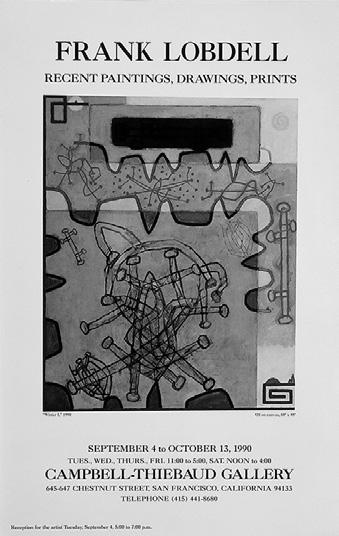
Announcement for the solo exhibition Frank Lobdell: Recent Paintings, Drawings, and Prints at Campbell-Thiebaud Gallery, September 4–October 13, 1990. Illustrated is the painting Winter I (1990).


Lobdell’s monotype 8.9.91 IV on the announcement for Frank Lobdell: Recent Monotypes from Smith Andersen Editions at Smith Andersen Gallery, November 22, 1991–January 4, 1992.
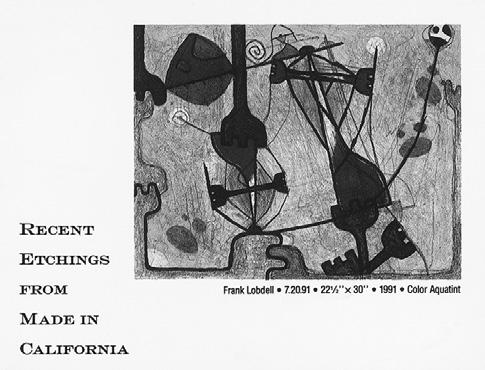
Lobdell’s aquatint 7.20.91 on the announcement for the group exhibition Recent Etchings from made in California at Olga Dollar Gallery, San Francisco, December 5, 1991–January 5, 1992.


1991 Retires from Stanford University after thirty-¬ve years of teaching in the art department.
Solo exhibition at Campbell-Thiebaud Gallery in San Francisco.
November 22, 1991–January 4, 1992. Completes a series of monotypes at Smith Andersen Editions, which are shown in Frank Lobdell: Recent Monotypes at Smith Andersen Gallery, Palo Alto.
December 5, 1991–January 5, 1992. Exhibits etchings in a group exhibition, Recent Etchings from made in California, at Olga Dollar Gallery, San Francisco.


1992 January 10. Son Judson marries Heather Wright in La Jolla, California.
Solo exhibition Viewpoints XVIII: Frank Lobdell—Recent Acquisitions in Context at the M. H. de Young Memorial Museum in San Francisco, curated by Steven A. Nash. The exhibit features two paintings that were the ¬rst to enter the museum’s collection— Untitled 1958, donated by Wayne and Betty Jean Thiebaud, and Untitled, Spring 1989, donated by Morgan Flagg—set in the context of thirteen other works dating from 1948 to 1991.
February. Visits Yale University with printer David Kelso for a two-day printmaking workshop, and begins to work on ¬ve blackand-white etchings.
Okeanos Press, Berkeley, California, publishes The Music of the Spheres, a 20-page bound livre de luxe of Ralph Manheim’s English translation of Michel Tournier’s epic tale. The book has as its frontispiece an intaglio by Lobdell, a black-and-white aquatint with hardground and sugarlift titled 8.29.90, printed by David Kelso at made in California. The book is produced in an edition of 98 with one artist’s proof, signed by the author and artist.

Brochure published by made in California announcing new editions by Lobdell, 1992, with an image of the softground and aquatint Untitled, 5.1.92.
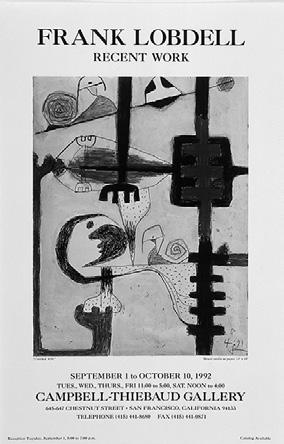
Announcement for the exhibition Frank Lobdell: Recent Work at Campbell-Thiebaud Gallery, September 1–October 10, 1992. Illustrated is the mixed-media work on paper Untitled, 4.91.
made in California publishes the Yale Portfolio, a suite of five black-and-white aquatint and hardground etchings, and a brochure to announce Lobdell’s recent prints.
Works exhibited in a group show at IPA Gallery in Boston.
Receives Academy Purchase Award from the American Academy and Institute of Arts and Letters, New York.
Summer. Visits his sister’s home in Duck Lake, Minnesota, where he sees his three sisters.
September 1–October 10. Solo exhibition Frank Lobdell: Recent Work at Campbell-Thiebaud Gallery, San Francisco. The exhibition includes the paintings 4.27.92, 3.23.92, 1.22.92, 10.28.91–12.4.91 Bleeker, and 10.23.91, which are illustrated in color in a catalogue published by the gallery. Also in the exhibition are prints and mixed-media works on paper.


Catalogue for the exhibition Frank Lobdell: Works, 1947–1992 at the Stanford University Museum of Art, January 12–April 25, 1993. On the cover is 3 October 1962.

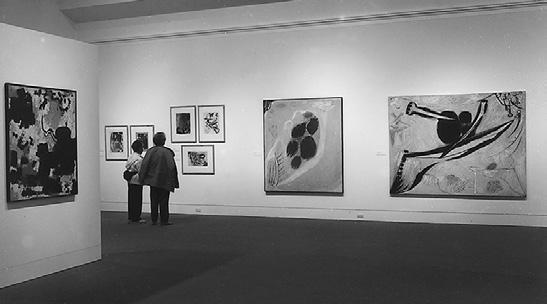
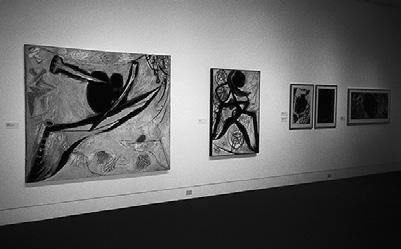
Frank Lobdell: Works, 1947–1992 at the Stanford University Museum of Art, January 1993. On the entrance wall is 3 October 1962; Summer 1967 (In Memory of James Budd Dixon) is at right. Photographs by Leo Holub.
Installation view, Stanford University Museum of Art, January 1993. The painting at left is 1 January 1949; at right are Black Edge III 23 March 1962 and Fall 1964.


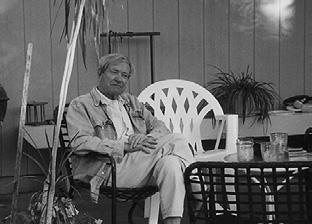
1993 January 12–April 25. Stanford University Museum of Art presents the exhibition Frank Lobdell: Works, 1947–1992, curated by Caroline A. Jones, for which a catalogue is published. The exhibition assembles ¬fteen paintings, seventeen drawings, and ¬fteen prints from key phases in Lobdell’s career.
Begins to work at Jinx’s studio at Pier 70.
Beginning in June, Lobdell produces lithographs at Stanford, working with Patrick Surgalski from the San Jose State University art department, who provides him with the stones. The printing is dif¬cult, as they struggle to work satisfactorily on run-down printing equipment inadequate for the task. Nevertheless, they produce nineteen ¬nished editions, the last of which are signed in November 1994.
Summer. Visiting Artist at the Tyler School of Art of Temple University, Philadelphia, where he presents a slide lecture.
August. Visiting Artist at Vermont Studio Center, Johnson, Vermont, where he produces several monotypes in the printmaking studio.
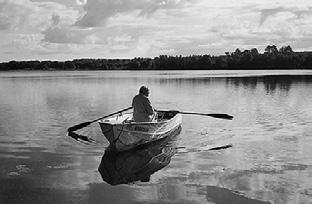

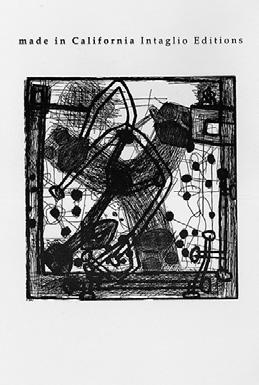
Lobdell’s print 4.18.90 on the announcement for the exhibition made in California Intaglio Editions at Mulligan-Shanoski Gallery, San Francisco, May 1–31, 1995.
1994 Lobdell receives a second Academy Purchase Award from the American Academy and Institute of Arts and Letters, New York. His work is included in the Academy’s Purchase Exhibition.
1995 August 12. Granddaughter Charlotte is born to son Judson and his wife Heather.
Solo exhibition at Campbell-Thiebaud Gallery, San Francisco.
Four paintings by Lobdell are included in the exhibition Fifteen Pro¬les: Distinguished California Modernists at the Fresno Art Museum. The exhibition catalogue includes an interview with Lobdell by guest curator Daphne Lane Beneke, conducted in Palo Alto on September 1, 1994.
Solo exhibition of aquatints and etchings at Printworks in Chicago.

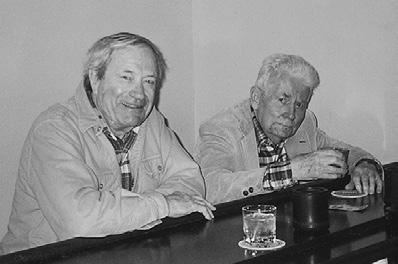

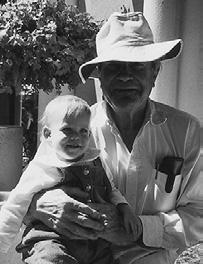


1996
January 27–April 21. The exhibition The San Francisco School of Abstract Expressionism, organized by Susan Landauer, is on view at the Laguna Art Museum, Laguna Beach, California. The show travels to the San Francisco Museum of Modern Art, July 18–September 29. A catalogue for the exhibition is published by University of California Press.
January 31. Lobdell marries Jinx Rowan in San Francisco at their home on Octavia Street. They then travel to Hawaii for a honeymoon.
June 18–July 27. Paintings by Lobdell, Diebenkorn, Budd Dixon, Jack Jefferson, Ann Morency, and Charles Strong are shown in Bay Area Abstract Expressionism at Campbell-Thiebaud Gallery, San Francisco.
November 6–9. Prints by Lobdell are shown by Smith Andersen Editions at The 1997 New Editions Fair at The Drawing Center, New York.
Works by Lobdell are included in the San Francisco Art Institute tribute exhibition Illustrious History 1871–1996. The exhibition is shown at Salander-O’Reilly Gallery, New York (September 5–28), and in San Francisco at Montgomery Gallery and John Berggruen Gallery (November 12–December 11).



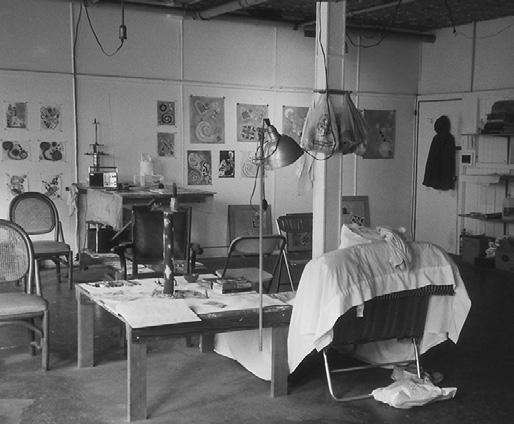
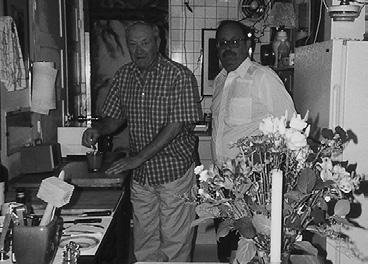

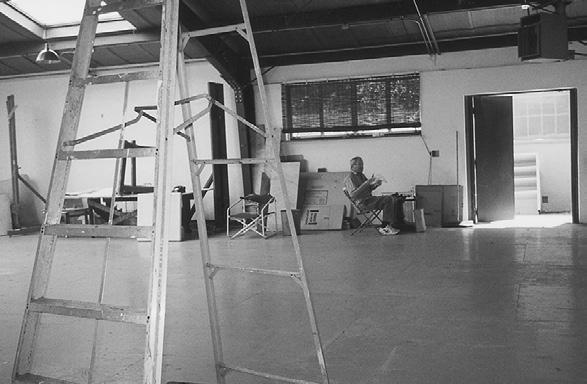
1998 Spring. Builds a new studio in Lemoor, near Fresno, California. Lobdell is elected to the National Academy of Design.
Solo exhibition at Campbell-Thiebaud Gallery, San Francisco.
June. Pier 70 becomes Lobdell’s exclusive studio when he vacates the Bleeker Street studio at Stanford.
Western Michigan University in Kalamazoo presents the exhibition Etchings by Frank Lobdell.
October 11–December 20. Lobdell is honored with a tribute exhibition, Frank Lobdell: Master Artist V, at the Hearst Art Gallery, St. Mary’s College, Moraga, California. Lobdell is invited to select the works for the exhibition, one of the most signi¬cant of his career. The exhibition focuses on recent paintings, and also shows works produced over the past four decades, including early works from the 1950s and paintings from the Dance series of the 1960s and 1970s.

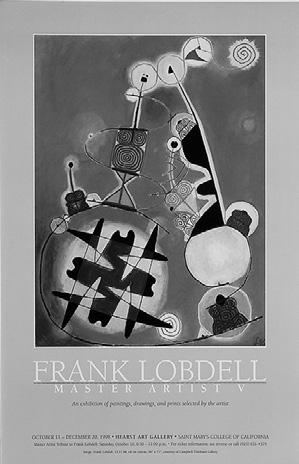
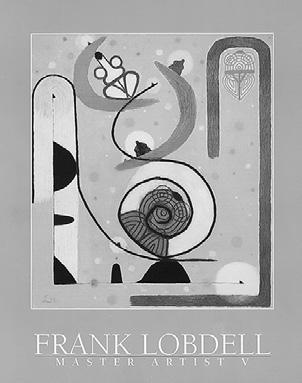




Installation view of Frank Lobdell: Master Artist V exhibition at Hearst Art Gallery, October 11–December 20, 1998. Paintings on exhibit include:
1. December 1964, Black Edge II 3 March 1962, and Summer 1959.
2. Dance IV (1970), Spring 1969, and December 1964.
3. Dance VIII (1971, center) and Dance IV (right).
4. 10.28.91–12.4.91 (left) and Dance VIII (right).
5. 2.16.98 (left) and 2.22.93–4.8.93 Bleeker (right) with works on paper.
6. 3.1.94–3.19.94 Pier 70 (left) and 3.3.96–12.17.96 Bleeker (right).
7. 7.20.94–9.28.94 Bleeker (left) and 1.3.95–4.10.95 Bleeker (right).
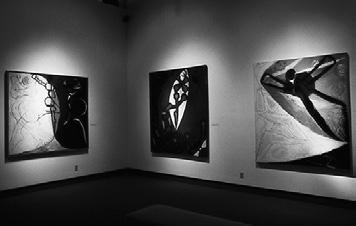

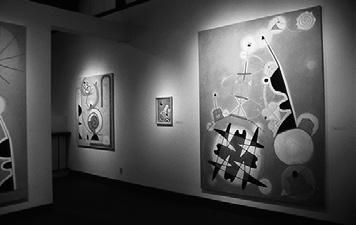



Announcement for the exhibition Frank Lobdell: Recent Prints at Printworks, Chicago, November 17, 1998–January 6, 1999. Illustrated is the etching and aquatint 6.25.91.

November 17, 1998–January 6, 1999. Solo exhibition Frank Lobdell: Recent Prints at Printworks, Chicago, of recent works produced with David Kelso at made in California.
December 16. Lobdell participates with Lawrence Ferlinghetti, Walter Kuhlman, and Horst Trave in an artists’ conversation, “The Artist as Veteran of World War II,” at the California Palace of the Legion of Honor, presented in conjunction with the exhibition Picasso: The War Years.
1999 He and Jinx rent and refurbish an apartment across the street from their Octavia Street residence, and move in early the following year.




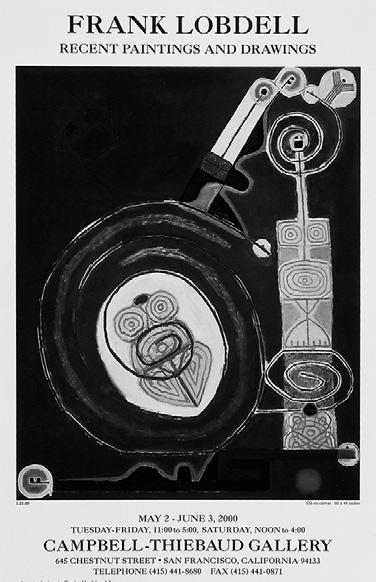
for
2000 May 2–June 3. Solo exhibition Frank Lobdell: Recent Paintings and Drawings at Campbell-Thiebaud Gallery, San Francisco.
made in California publishes discovery/experiment: a decade of etchings, a suite of thirty-four small format black-and-white intaglio prints dating from 1990 to 2000 made by Lobdell at the press in Oakland.
July 26. Has ¬rst hip replacement surgery.

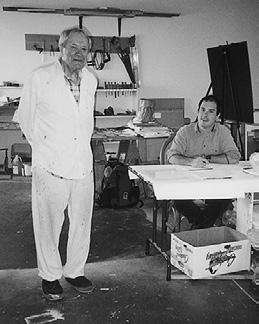
2001
November. Has second hip replacement surgery. He receives word that his close friend Jack Jefferson has passed away. During his recuperation from both operations, he produces numerous small drawings.
September. The Art Exchange in San Francisco presents a solo exhibition of prints, Frank Lobdell: A Decade of Etchings, in their new gallery at 645 Chestnut Street.
September 6–October 27. 1 January 1949 is exhibited in San Francisco Abstract Expressionism: Selected Works, 1948–1982 at Hackett-Freedman Gallery, San Francisco. A catalogue is published for the exhibition, with an essay by Susan Landauer. Hackett-Freedman Gallery begins to represent Lobdell’s work.


Card announcing Hackett-Freedman Gallery representation of Lobdell’s work, 2001. Illustrated is the painting 5.31.94.


Announcement for exhibition Frank Lobdell: A Decade of Etchings at The Art Exchange, San Francisco, September 2001.


2002 March 7–30. Solo exhibition Frank Lobdell: Three Phases, 1947–2001, at Hackett-Freedman Gallery includes recent paintings and a selection of paintings from the late 1940s, 1960s, and 1970s, including the oil paintings 2 October 1947, 17 October 1947, 31 December 1948, 1 January 1949, 30 April 1949, May 1949, 13 September 1949, 3 October 1962, February 1963, October 1965, Winter 1969, Dance II 1969, Dance VIII 1971, Spring 1972, Untitled Summer 1989, 6.26.92–11.6.92 Bleeker, 11.30.92–2.16.93 Bleeker, 2.22.93–4.8.93 Bleeker, 5.23.94 Bleeker, 3.3.96–12.17.96 Bleeker, 11.17.98 Pier 70, 3.15.98 Pier 70, Pier 70 12.26.99, Pier 70 1.21.2000, Pier 70 Summer II 2001; and the drawings Untitled 1949, Untitled 1949, Untitled 1964, and Untitled 1964. A color catalogue, with an essay by Bruce Guenther, is published for the exhibition.
Summer. Lobdell’s illustrations appear in the Threepenny Review (Berkeley, CA, no. 90).


Announcement for the exhibition Frank Lobdell: Three Phases, 1947–2001 at Hackett-Freedman Gallery, San Francisco, March 7–30, 2002. Illustrated is the painting 17 October 1947.




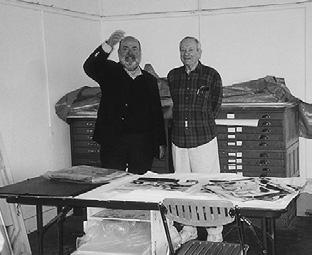
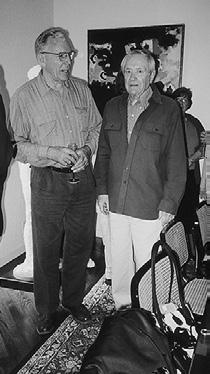
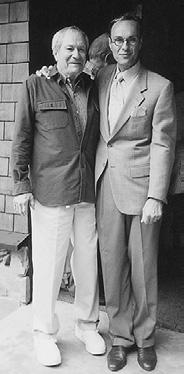


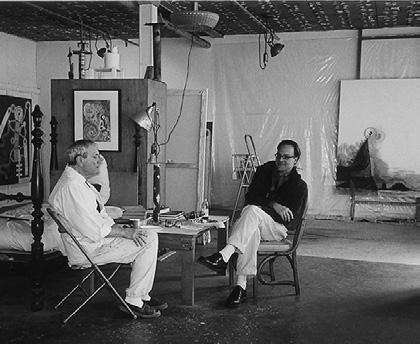




views, Frank
include 17 February
September
December
2 May
May
3 October


November 23–December 21. Solo exhibition Frank Lobdell: Early Works at Charles Cowles Gallery, New York. The works are selected for the exhibition by Walter Hopps. The gallery presents a concurrent exhibition, Richard Diebenkorn and Frank Lobdell: Figurative Drawings.

Timothy Anglin Burgard
1. 31 December 1948
1948, Oil paints on canvas
44J × 35M inches
Fine Arts Museums of San Francisco, Museum purchase, Dr. Leland A. Barber and Gladys K. Barber Fund, 2002.142
2. Pablo Picasso (1881–1973) Guernica
1937, Oil paints on canvas
11 feet 5H inches × 25 feet 5I inches Museo Nacional Centro de Arte Reina Sofía, Madrid Photograph © Snark/Art Resource, NY
3. 17 October 1947
1947, Oil paints on canvas 32 × 38 inches
4. Auguste Rodin (1840–1917)
The Mighty Hand (Main crispée)
c. 1880, Bronze
18 × 12K × 7Š inches
Fine Arts Museums of San Francisco, Gift of Alma de Bretteville Spreckels, 1942.39
5. Rembrandt van Rijn (1606–1669) Lucretia
1666, Oil paints on canvas
43K × 36H inches
The Minneapolis Institute of Arts, The William Hood Dunwoody Fund
6. Francisco de Goya y Lucientes (1746–1828)
El 3 de mayo de 1808 en Madrid: Los fusilamientos en la Montaña del Príncipe Pío (Madrid: 3rd of May, 1808)
1814, Oil paints on canvas
105H × 137L inches
All rights reserved © Museo Nacional del Prado, Madrid
Frank Lobdell: Paintings and Graphics from 1948 to 1965
Walter Hopps
1. 4 January 1948
1948, Oil paints on canvas
38 × 32 inches
2. 17 January 1948
1948, Oil paints on canvas
35I × 29I inches
3. 3 September 1948
1948, Oil paints on canvas
92H × 29I inches
4. 31 December 1948
1948, Oil paints on canvas
44J × 35M inches
Fine Arts Museums of San Francisco, Museum purchase, Dr. Leland A. Barber and Gladys K. Barber Fund, 2002.142
5. 1 January 1949
1949, Oil paints on canvas
48 × 40 inches
6. May 1949
1949, Oil paints on canvas
53I × 41I inches
7. 13 September 1949
1949, Oil paints on canvas
47I × 47I inches
8. 5 October 1949
1949, Oil paints on canvas
72 × 42G inches
9. Untitled 1950, Oil paints on canvas
70 × 64 inches
Waddington Galleries, London
10. 19 January 1950
1950, Oil paints on canvas
81G × 50H inches
11. Untitled 1950, Oil paints on canvas
70 × 64 inches
Waddington Galleries, London
12. November 1953 Number 1 1953, Oil paints on canvas
73H × 68M inches
Smithsonian American Art Museum, Museum purchase
13. Untitled (black & white 1) 1953, Oil paints on canvas
80 × 70 inches
Collection of Michel Tapié, Turin, Italy
14. March 1954 (2) 1954, Oil paints on canvas
69H × 65H inches
San Francisco Museum of Modern Art, Anonymous Gift
Photograph by Don Myer
15. March 1954 Number 3 1954, Oil paints on canvas 93 × 68G inches
16. March 1954 (4)
[Lobdell states that this painting does not exist and its listing was an error in the Pasadena catalogue.]
17. April 1954 Number 1 1954, Oil paints on canvas
72 × 63H inches
University of California, Berkeley Art Museum, Gift of Mr. David K. Anderson, New York, in memory of Martha Jackson (from the Martha Jackson Collection)
18. July 1954
1954, Oil paints on canvas 66H × 49H inches
19. January 13, 1955 1955, Oil paints on canvas 19 × 14 inches
20. January 1955 1955, Oil paints on canvas 69H × 53H inches
The Oakland Museum, Gift of Mrs. Robert Chamberlain
21. 2 May 1955
1955, Oil paints on canvas 69I × 53H inches
22. September 1955 1955, Oil paints on canvas 69H × 48 inches
23. December, 1955
1955, Oil paints on canvas 67 × 90 inches
Phoenix Art Museum, Gift of Mr. and Mrs. David K. Anderson
Photograph by Craig Smith
24. Black Edge
1956, Oil paints on canvas
70 × 61G inches
Collection of Ann Morency
25. December 1956
1956, Oil paints on canvas
38 × 36 inches
(no longer exists)
26. Summer 1957 (formerly titled February 1957)
1957, Oil paints on canvas
70G × 60 inches
San Francisco Museum of Modern Art, Gift of the Lannan Foundation
Photograph by Ben Blackwell
27. April 1957
1957, Oil paints on canvas
69G × 60G inches
Collection of Judson Lobdell
28. August 1957
1957, Oil paints on canvas
70 × 60G inches
29. GRAY I
Not illustrated
30. November 1957 (Gray II)
1957, Oil paints on canvas
74 × 68H inches
31. Winter 1957
1957, Oil paints on canvas
87G × 70 inches
Private collection
32. December 1957
1957, Oil paints on canvas
74 × 70 inches
33. Untitled
1958, Oil paints on canvas
61 × 37 inches
34. Fall 1958
1958, Oil paints on canvas
69G × 91I inches
Collection of Mrs. Albert Levinson, Los Angeles (1966)
35. December 1958
1958, Oil paints on canvas
69G × 58 inches
Smithsonian American Art Museum, Gift of Mr. and Mrs. David K. Anderson, Martha Jackson Memorial Collection
36. Untitled 1958, Oil paints on canvas
70 × 58 inches
Fine Arts Museums of San Francisco, Gift of Wayne and Betty Jean Thiebaud
37. February 1959
1959, Oil paints on canvas
70 × 59G inches
Los Angeles County Museum of Art, Gift of Betty M. Asher, through the Contemporary Art Council
38. April 1959
1959, Oil paints on canvas
70I × 74G inches
San Francisco Museum of Modern Art, Gift of the Women’s Board from the Grace McCann Morley Fund
Photograph by Ben Blackwell
39. June 1959
1959, Oil paints on canvas
73G × 70 inches
Mrs. Martha K. Jackson, New York (1966)
40. Summer 1959
1959, Oil paints on canvas
68G × 91 inches
San Francisco Museum of Modern Art, Gift of Betty and Monte Factor
Photograph by Ben Blackwell
41. August 1959
1959, Oil paints on canvas
61 × 37 inches
42. October 1959
Not illustrated
43. July 1960
Not illustrated
44. September 1960
Not illustrated
45. October 1960
Not illustrated
46. Fall 1960
Not illustrated
47. February 1961
1961, Oil paints on canvas
61H × 70 inches
Jack S. Blanton Museum of Art, The University of Texas at Austin, Gift of Mari and James A. Michener, 1968
Photograph by George Holmes
48. March 1961
1961, Oil paints on canvas
63 × 70 inches
Museum of Fine Arts, Museum of New Mexico, Gift of Mr. and Mrs. Gifford Phillips, 1980
49. Summer Mural 1961
1961, Oil paints on canvas
68H × 242H inches
50. November, 1961
1961, Oil paints on canvas
71H × 60J inches
Norton Simon Museum, Anonymous Gift through the American Federation of Art, Museum Donor Program, 1962
51. January 1962
1962, Oil paints on canvas
70 × 71H inches
Private collection, Seattle
52. Black Edge II 3 March 1962
1962, Oil paints on canvas
85H × 70 inches
Collection of Mrs. Sally Lillienthal
53. Black Edge III 23 March 1962
1962, Oil paints on canvas
70 × 60 inches
54. 15 April 1962
1962, Oil paints on canvas
69I × 61G inches
The Oakland Museum of California
55. Black Edge IV Summer 1962
1962, Oil paints on canvas
69I × 61G inches
Private collection, San Francisco
56. Summer
1962, Oil paints on canvas
69I × 97G inches
Smithsonian American Art Museum, Gift of Mr. and Mrs. David K. Anderson, Martha Jackson
Memorial Collection
57. 3 October 1962
1962, Oil paints on canvas
30 × 24 inches
58. Ascent (Red) 13 October 1962
1962, Oil paints on Masonite
72I × 48I inches
Private collection
59. Dark Presence (Yellow) 3 January 1963
1963, Oil paints on canvas
97G × 69I inches
Collection of Walter Hopps
60. February 1963
1963, Oil paints on canvas
62H × 69M inches
61. Dark Presence III (Yellow)
1963, Oil paints on canvas
61H × 69I inches
62. Dark Presence (White) 20 March
1963, Oil paints on canvas
70H × 60H inches
63. 3 October 1963
1963, Oil paints on canvas
48 × 44 inches
64. November 1964
1964, Oil paints on canvas
60 × 50 inches
65. June 1964
1964, Oil paints on canvas
60J × 49M inches
Collection of Judson Lobdell
66. 15 September 1964, Dedicated to the Memory of Ninfa Valvo
1964, Oil paints on canvas
57 × 47H inches
Private collection, San Francisco
67. Fall 1964
1964, Oil paints on canvas
69K × 90 inches
Iris and B. Gerald Cantor Center for Visual Arts at Stanford University, Gift of the artist
68. December 1964
1964, Oil paints on canvas
70 × 61 inches
Collection of Katharine Doyle Spann
69. January 1965
1965, Oil paints on canvas
43H × 57 inches
70. May 1965
1965, Oil paints on canvas
57 × 47H inches
Collection of Charles and Rose Gibbs
71. Summer 1965
1965, Oil paints on canvas
83K × 69 inches
San Francisco Museum of Modern Art, Partial gift of Mary and Frank Keesling in honor of John Humphrey
Photograph by Ben Blackwell
72. October 1965 1965, Oil paints on canvas 57 × 43 inches
GRAPHICS
73. Untitled 1958 1958, Gouache and ink on paper 9 × 14 inches
Private collection
74. Untitled 1958 1958, Gouache and ink on paper 9J × 14 inches
Collection of Mrs. Albert Levinson, Los Angeles (1966)
Photograph courtesy Frank J. Thomas Archives
75. Drawing 7/4/58 1958, Gouache and ink on paper 18 × 24 inches
Collection of Mr. and Mrs. Robert A. Rowan, Pasadena (1966)
76. Untitled 1958, Gouache and ink on paper 9 × 14 inches
Photograph courtesy Frank J. Thomas Archives
77. Untitled 1958, Gouache and ink on paper 13L × 11 inches
Photograph courtesy Frank J. Thomas Archives
78. Untitled 1961, Gouache and ink on paper 14M × 20G inches
79. Untitled Not illustrated
80. Untitled #7 1961, Gouache and ink on paper 15G × 20 inches
Photograph courtesy Frank J. Thomas Archives
81. Untitled Not illustrated
82. B 3 Not illustrated
83. A 2 Not illustrated
84. A 3 Not illustrated
85. Untitled #22 Not illustrated
86. Untitled #19 Not illustrated
87. Untitled #21 1963, Gouache and pencil on paper 11I × 17I inches
Photograph courtesy Frank J. Thomas Archives
88. Untitled 1963, Gouache, ink and pencil on paper 11I × 17I inches
Photograph courtesy Frank J. Thomas Archives
89. Untitled A 1964, Gouache and ink on paper 17 × 13 inches
90. Untitled B Not illustrated
91. Untitled D 1964, Gouache and ink on paper 14 × 10M inches
92. Untitled E 1964, Gouache, ink, pencil and collage on paper 17 × 14 inches
93. AIR SERIES H 1964, Gouache, ink and pencil on paper 17I × 23H inches
94. AIR SERIES I 1964, Gouache and ink on paper 18 × 23H inches
Private collection, San Francisco
95. AIR SERIES K 1964, Gouache, ink and pencil on paper 18 × 11H inches
96. AIR SERIES M 1964, Gouache, ink and crayon on paper 18 × 17M inches
Photograph courtesy Frank J. Thomas Archives
97. AIR SERIES N 1964, Gouache, ink and pencil on paper 18 × 23H inches
Photograph courtesy Frank J. Thomas Archives
98. Untitled, Zirker
1964, Lithograph: ink on paper (4 colors) 22 × 30 inches (paper) 20I × 28H inches (image)
A Wonderland of His Own
Bruce Nixon
1. June 1964
1964, Oil paints on canvas
60J × 49M inches
Collection of Judson Lobdell
2. 10 October 1947
1947, Oil paints on canvas 32 × 38 inches
3. November 1947
1947, Oil paints on canvas 39 × 31 inches
4. Pablo Picasso (1881–1973)
Girl Before a Mirror
Boisgeloup, March 14, 1932, Oil paints on canvas 64 × 51G inches
The Museum of Modern Art, New York, Gift of Mrs. Simon Guggenheim
Digital image © 2002 The Museum of Modern Art, New York
5. May 1949
1949, Oil paints on canvas
53I × 41I inches
6. 31 December 1948
1948, Oil paints on canvas
44 × 36 inches
Fine Arts Museums of San Francisco, Museum purchase, Dr. Leland A. Barber and Gladys K. Barber Fund, 2002.142
7. 13 September 1949
1949, Oil paints on canvas
47I × 47I inches
8. 1 January 1949
1949, Oil paints on canvas
48 × 40 inches
9. 30 April 1949
1949, Oil paints on canvas
45H × 38 inches
10. 27 January 1948
1948, Oil paints on canvas 38 × 31H inches
11. Untitled, 13 Oct 49
1949, Ink on paper
12† × 10J inches
12. Untitled, 20 Sept 49 1949, Ink on paper
12† × 10J inches
13. Untitled, 5 Oct 49
1949, Ink on paper 12‹ × 10J inches
14. Untitled, 1950 1950, Ink on paper mounted on board 10K × 14H inches
15. March 1954 (2) 1954, Oil paints on canvas 69H × 65H inches
San Francisco Museum of Modern Art, Anonymous Gift Photograph by Don Myer
16. Francisco de Goya y Lucientes (1746–1828) El 3 de mayo de 1808 en Madrid: Los fusilamientos en la Montaña del Príncipe Pío (Madrid: 3rd of May, 1808)
1814, Oil paints on canvas 105H × 137L inches
All rights reserved © Museo Nacional del Prado, Madrid
17. Francisco de Goya y Lucientes (1746–1828) Estragos de la guerra (Ravages of war), plate 30 of Los desastres de la guerra (The disasters of war) c. 1810–11, Etching and drypoint 5H × 6L inches
All rights reserved © Museo Nacional del Prado, Madrid
18. Francisco de Goya y Lucientes (1746–1828) Grande hazaña! Con muertos! (Great deeds—against the dead!), plate 39 of Los desastres de la guerra (The disasters of war) c. 1812–15, Etching and drypoint 6J × 8J inches
All rights reserved © Museo Nacional del Prado, Madrid
19. Francisco de Goya y Lucientes (1746–1828) Soplones (The squealers), plate 48 of Los Caprichos (The caprices) 1797–98, Etching and burnished aquatint 8J × 5M inches
All rights reserved © Museo Nacional del Prado, Madrid
20. Francisco de Goya y Lucientes (1746–1828)
Volaverunt (Gone for good), plate 61 of Los Caprichos (The caprices)
1799, Etching, aquatint and drypoint
8H × 5M inches
All rights reserved © Museo Nacional del Prado, Madrid
21. December, 1955
1955, Oil paints on canvas
67 × 90 inches
Phoenix Art Museum, Gift of Mr. and Mrs. David K. Anderson
Photograph by Craig Smith
22. November 1957 (Gray II)
1957, Oil paints on canvas
74 × 68H inches
23. January 13, 1955
1955, Oil paints on canvas
19 × 14 inches
24. Francisco de Goya y Lucientes (1746–1828) Saturno devorando a un hijo (Saturn devouring his son)
1820–22, Mural painted with oil paints, mounted on canvas
56G × 31M inches
All rights reserved © Museo Nacional del Prado, Madrid
25. Untitled 1957, Ink on paper
9 × 14 inches
26. Untitled 1957, Ink on paper
9 × 14 inches
27. Untitled 1957, Ink and ink wash on paper 9 × 14 inches
28. April 1957
1957, Oil paints on canvas
69G × 60G inches
Collection of Judson Lobdell
29. Francisco de Goya y Lucientes (1746–1828) Duelo a Garrotazos (Duel with cudgels)
1819–23, Mural painted with oil paints, mounted on canvas
49G × 101I inches
All rights reserved © Museo Nacional del Prado, Madrid
30. Francisco de Goya y Lucientes (1746–1828) El Aquelarre (El Gran Cabrón) (The Witches’ Sabbath)
1820–23, Mural painted with oil paints, mounted on canvas
56J × 174K inches
All rights reserved © Museo Nacional del Prado, Madrid
31. 3 October 1962
1962, Oil paints on canvas
30 × 24 inches
32. Black Edge III 23 March 1962
1962, Oil paints on canvas
70 × 60 inches
Collection of Mr. and Mrs. Morgan Flagg
33. Untitled 1959, Mixed media on paper 11M × 17Š inches
34. Untitled 1958, Ink on paper 11M × 5H inches
35. Untitled 1958, Mixed media on paper 14 × 11 inches
36. Summer Mural 1961 1961, Oil paints on canvas 68H × 242H inches
37. Untitled drawing for Summer Mural 1961 1961, Mixed media on paper 8 × 14 inches
38. Untitled drawing for Summer Mural 1961 1961, Mixed media on paper
7H × 14M inches
39. Untitled drawing for Summer Mural 1961 1961, Mixed media on paper
8 × 14 inches
40. Untitled drawing for Summer Mural 1961 1961, Ink on paper 12 × 7H inches
41. Untitled drawing for Summer Mural 1961 1961, Mixed media on paper 17 × 14 inches
42. Untitled drawing for Summer Mural 1961 1961, Mixed media on paper
7H × 15 inches
43. Untitled drawing for Summer Mural 1961 1961, Mixed media on paper 14 × 11 inches
44. Untitled drawing for Summer Mural 1961 1961, Mixed media on paper 8 × 17M inches
45. Untitled drawing for Summer Mural 1961 1961, Mixed media on paper 17H × 11M inches
46. February 1963
1963, Oil paints on canvas
62H × 69M inches
47. 3 October 1963
1963, Oil paints on canvas
48 × 44 inches
48. Fall 1964
1964, Oil paints on canvas
69K × 90 inches
Iris and B. Gerald Cantor Center for Visual Arts at Stanford University, Gift of the artist
49. October 1965
1965, Oil paints on canvas
57 × 43 inches
50. January 1962
1962, Oil paints on canvas
70 × 71H inches
Private collection, Seattle
51. November, 1961
1961, Oil paints on canvas
71H × 60J inches
Norton Simon Museum, Anonymous Gift through the American Federation of Art, Museum Donor Program, 1962
52. Ascent (Red) 13 October 1962 1962, Oil paints on Masonite 72I × 48I inches
Private collection
53. Untitled 1964, Mixed media on paper 14 × 34 inches
54. Untitled 1963, Mixed media on paper 12 × 18 inches
55. Untitled 1963, Mixed media on paper 11I × 17I inches
56. Untitled 1963, Mixed media on paper 14 × 17 inches
57. Untitled 1964, Mixed media on paper 18 × 24L inches
58. Untitled 1963, Mixed media on paper 14 × 17 inches
59. December 1964 1964, Oil paints on canvas 70 × 61 inches
Collection of Katharine Doyle Spann
60. May 1965
1965, Oil paints on canvas 57 × 47H inches
Collection of Charles and Rose Gibbs
61. Summer 1967 (In Memory of James Budd Dixon) 1967, Oil paints on canvas 90H × 173H inches
Fine Arts Museums of San Francisco, Gift of Judson, Heather, and Charlotte Lobdell, 2002.150
62. Untitled, Tam 1713 1966, Lithograph: ink on paper 20I × 30H inches
63. Untitled, Tam 1713: State II 1966, Lithograph: ink on paper 22G × 30H inches
64. Untitled, Tam 1746: State II 1966, Lithograph: ink on paper 19G × 25G inches
65. Untitled, Tam 1742 1966, Lithograph: ink on paper 40 × 32 inches
66. March 1961
1961, Oil paints on canvas 63 × 70 inches
Museum of Fine Arts, Museum of New Mexico, Gift of Mr. and Mrs. GiVord Phillips, 1980
67. Pablo Picasso (1881–1973) Guernica 1937, Oil paints on canvas 11 feet 5H inches × 25 feet 5I inches Museo Nacional Centro de Arte Reina Sofía, Madrid Photograph © Snark/Art Resource, NY
68. Summer 1968 1968, Oil paints on canvas 69I × 60 inches Collection of Judson Lobdell
69. Untitled, 1967 1967, Ink and ink wash on paper 17 × 14 inches
70. Untitled, 1966 1966, Ink on paper 14 × 17 inches
71. Untitled, 1965 1965, Ink and mixed media on paper 14 × 17 inches
72. Untitled, 1972 1972, Ink on paper 14 × 17 inches
73. Untitled, 1973 1973, Ink on paper 13H × 17 inches
74. Untitled, 1967 1967, Ink on paper 17 × 14 inches
75. Untitled, 1972 1972, Ink on paper 14H × 11H inches
76. Untitled, 1972 1972, Ink on paper 11H × 14H inches
77. March 1954 (2) 1954, Oil paints on canvas 72 × 65I inches Collection of San Francisco Museum of Modern Art, Anonymous Gift Photograph by Don Myer
78. 3 October 1962 1962, Oil paints on canvas 30 × 24 inches
79. Untitled, 1972 1972, Ink, ink wash and pencil on paper 17 × 12H inches
80. Untitled, 1972 1972, Ink and ink wash on paper 11H × 14H inches
81. Untitled, 1965 1965, Ink and pencil on paper 14 × 17 inches
82. Untitled, 1964 1964, Ink wash and pencil on paper 17 × 14 inches
83. Winter 1969 1969, Oil paints on canvas 48 × 37 inches
84. Dance VIII
1971, Oil paints on canvas
60H × 88 inches
85. Spring 1972
1972, Oil paints on canvas
84 × 66 inches
86. Summer 1969
1969, Oil paints on canvas
71 × 61I inches
87. January 1969
1969, Oil paints on canvas
57 × 47H inches
88. Fall 1968, Dedicated to the Memory of Martha Jackson
1968, Oil paints on canvas
79L × 121 inches
San Francisco Museum of Modern Art, Gift of the Hamilton-Wells Collection
Photograph by Ben Blackwell
89. Dance III
1970, Oil paints on canvas
76 × 62 inches
90. Pablo Picasso (1881–1973)
The Three Dancers
1925, Oil paints on canvas
84L × 55M inches
The Tate Gallery, London
© Tate Gallery, London/Art Resource, NY
91. Dance V
1970, Oil paints on canvas
67 × 60I inches
92. Rembrandt van Rijn (1606–1669) Lucretia
1666, Oil paints on canvas
43K × 36 inches
The Minneapolis Institute of Arts, The William Hood Dunwoody Fund
93. Rembrandt van Rijn (1606–1669)
The Conspiracy of the Batavians 1661, Oil paints on canvas
77G × 121I inches
The Swedish National Museum, Stockholm
Photograph by Hans Thorwid
94. Dance VI
1970, Oil paints on canvas
61H × 89I inches
Collection of Judson Lobdell
95. Dance IV
1970, Oil paints on canvas
60G × 66G inches
96. Dance I
1969, Oil paints on canvas
61I × 72 inches
Photograph by Hackett Freedman
97. Dance II
1969, Oil paints on canvas
61I × 72J inches
98. Fall 1971
1971, Oil paints on canvas
84 × 66 inches
99. Untitled
1971, Mixed media on paper
12 × 17J inches
100. Untitled 1971, Mixed media on paper 12 × 18 inches
101. Untitled 1972, Mixed media on paper 12K × 16M inches
102. Untitled 1971, Mixed media on paper 14K × 12 inches
103. Dance 1971, Mixed media on paper 14H × 11H inches
104. Untitled 1972, Mixed media on paper 12 × 19 inches
105. Untitled 1972, Mixed media on paper 11H × 14H inches
106. Untitled 1971, Ink and mixed media on paper 14H × 11H inches
107. Untitled 1971, Ink and mixed media on paper 14H × 11H inches
108. Untitled 1977, Oil paints on canvas 84 × 66 inches (no longer exists)
109. Summer 1980 1980, Oil paints on canvas 96 × 78 inches
Collection Byron Meyer, San Francisco
110. Fall 1980 1980, Oil paints on canvas 96 × 78 inches
Private collection, San Francisco
111. Untitled (Skowhegan, Summer 1984) 1984, Mixed media on paper 15 × 22 inches
112. Untitled (Skowhegan, Summer 1984) 1984, Mixed media on paper 15 × 22 inches
113. Untitled (Skowhegan Summer 1984) 1984, Ink on paper 8H × 11 inches
114. 6.26.92–11.6.92 Bleeker 1992, Oil paints on canvas 96J × 78G inches
115. 8.9.91 II 1991, Monotype: ink on paper 20 × 26G inches (paper) 15I × 19I inches (image)
116. 10.28.91–12.4.91 Bleeker 1991, Oil paints on canvas 78 × 96 inches
117. 2.22.93–4.8.93 Bleeker 1993, Oil paints on canvas 84 × 120 inches
Collection of Mr. and Mrs. Morgan Flagg
118. 11.17.98 Pier 70 1998, Oil paints on canvas 72 × 60J inches
119. 10.21.94–11.30.94 Bleeker 1994, Oil paints on canvas
78J × 96J inches
120. Untitled 2000, Mixed media on paper 22I × 18 inches
121. Untitled 1999, Mixed media on paper 17 × 12 inches
122. Untitled 1991, Ink and mixed media on paper 12M × 8M inches
123. Untitled 1991, Mixed media on paper 16G × 14G inches
124. Untitled 1991, Mixed media on paper 10 × 13 inches
125. Untitled, 8.27.96 1996, Mixed media on paper 18G × 16H inches
126. Untitled, 12.30.93 1993, Mixed media on paper 17 × 19H inches
127. Untitled, 11.7.93 1993, Mixed media on paper 17 × 24 inches
128. Untitled 1995, Mixed media on paper 22H × 17I inches
129. Untitled, 8.6.96 1996, Mixed media on paper 16H × 11M inches
130. Untitled 2000, Mixed media on paper 17 × 13 inches
131. Untitled, Spring 1989 1989, Oil paints on canvas
72 × 60 inches
Fine Arts Museums of San Francisco, Fractional Gift of Morgan Flagg, 1991.103
132. Untitled, Summer 1989 1989, Oil paints on canvas 72 × 60 inches
133. 3.15.99 Pier 70 1999, Oil paints on canvas
42 × 36 inches
134. 12.30.93–2.3.94 Pier 70 1994, Oil paints on canvas
72 × 64 inches
135. Pier 70 Summer I 2001 2001, Oil paints on canvas
36H × 28 inches
136. Pier 70 Summer II 2001 2001, Oil paints on canvas
35 × 30 inches
137. Pier 70 Summer III 2001 2001, Oil paints on canvas
40 × 30 inches
Robert Flynn Johnson
1. Untitled, 1968 1968, Pencil on paper 14 × 17 inches
2. Untitled, 1968 1968, Ink on paper 14H × 18 inches
3. Untitled, 1967 1967, Ink and ink wash on paper 17 × 14 inches
4. Untitled, 1967 1967, Ink and ink wash on paper 17 × 14 inches
5. Untitled, 1967 1967, Ink and ink wash on paper 17 × 14 inches
6. Untitled, 1968 1968, Ink, ink wash and gouache on paper 14 × 17 inches
7. Untitled, 1968 1968, Pencil on paper 14 × 17 inches
8. Untitled, 1972 1972, Ink and ink wash on paper 14 × 17 inches
9. Untitled, 1974 1974, Ink and ink wash on paper 13H × 17 inches
10. Untitled, 1968 1968, Ink and ink wash on paper 14 × 17 inches
11. Untitled, 1972 1972, Ink and ink wash on paper 12H × 17 inches
12. Untitled, 1967 1967, Ink and ink wash on paper 17 × 14 inches
13. Untitled, 1967 1967, Ink on paper 14 × 17 inches
14. Untitled, 1968 1968, Ink and ink wash on paper 14 × 17 inches
15. Untitled, 1974 1974, Ink and ink wash on paper 13L × 17 inches
16. Untitled, 1972 1972, Ink on paper 14H × 11H inches
17. Untitled, 1968 1968, Ink on paper 17 × 11 inches
18. Untitled, 1968 1968, Ink on paper 17 × 14 inches
19. Untitled, 1973 1973, Ink and ink wash on paper 13 × 17G inches
Bruce Guenther
1. Untitled, 1964 1964, Mixed media on paper 17 × 14 inches
2. Untitled, 1965 1965, Mixed media on paper 17 × 14 inches
3. Untitled, 1965 1965, Ink on paper 12H × 17 inches
4. Untitled, 1968 1968, Mixed media on paper 17 × 14 inches
5. Untitled, 1964 1964, Ink on paper 11 × 14 inches
6. Untitled, 1965 1965, Ink on paper 17 × 14 inches
7. Untitled, 1964 1964, Ink wash and pencil on paper 17 × 14 inches
8. Untitled, 1964 1964, Ink and ink wash on paper 17 × 14 inches
9. Untitled, 1964 1964, Ink and ink wash on paper 14 × 17 inches
10. Untitled, 1963 1963, Ink and ink wash on paper 17 × 14 inches
11. Untitled, 1965 1965, Ink on paper 17 × 12H inches
12. Untitled, 1964 1964, Ink and ink wash on paper 17 × 14 inches
13. Elmer Bischoff Seated Woman on Wicker Chair 1964, Ink and ink wash on paper 18 × 15 inches
14. Untitled, 1965 1965, Ink and ink wash on paper 17 × 12H inches
15. Untitled, 1968 1968, Mixed media on paper 17 × 14 inches
16. Untitled, 1965 1965, Ink and ink wash on paper 17 × 14 inches
17. Richard Diebenkorn Untitled 1964, Ink wash and conte crayon on paper 17 × 14 inches
18. Untitled, 1965 1965, Crayon and charcoal on paper 17 × 14 inches
19. Untitled, 1965 1965, Ink on paper 17 × 14 inches
20. Untitled, 1967 1967, Ink and ink wash on paper 14 × 17 inches
21. Untitled, 1967 1967, Ink and ink wash on paper 14 × 17 inches
22. Untitled, 1965 1965, Ink and ink wash on paper 14 × 17 inches
23. Richard Diebenkorn Untitled c. 1962–64, Ink wash and conte crayon on paper 17 × 14 inches
24. Richard Diebenkorn Untitled (#3084) 1963, Charcoal and ink wash on paper 17 × 14 inches
25. Untitled, 1964 1964, Ink and ink wash on paper 14 × 17 inches
26. Untitled, 1967 1967, Ink and ink wash on paper 14 × 17 inches
27. Untitled, 1965 1965, Ink and ink wash on paper 17 × 14 inches
28. Untitled, 1965 1965, Ink and ink wash on paper 17 × 14 inches
29. Elmer Bischoff Standing Nude 1963, Ink on paper 17I × 14I inches
30. Untitled, 1965 1965, Pencil and ink wash on paper 17 × 12H inches
31. Untitled, 1967 1967, Ink and ink wash on paper 17 × 14 inches
32. Elmer Bischoff Standing Nude—Partially Clothed c. 1965, Ink and ink wash on paper 18 × 15 inches
Collection of Adelie Landis Bischoff
33. Elmer Bischoff Standing Nude 1963, Ink and ink wash on paper 17H × 14H inches
Collection of Laurie Bischoff Hall
34. Untitled, 1967 1967, Ink and ink wash on paper 17 × 14 inches
35. Untitled, 1964 1964, Pencil and ink wash on paper 17 × 14 inches
36. Untitled, 1967 1967, Pencil and ink wash on paper 17 × 14 inches
37. Untitled, 1964 1964, Ink and ink wash on paper 14 × 17 inches
38. Untitled, 1967 1967, Pencil and ink wash on paper 12H × 17 inches
39. Untitled, 1967 1967, Pencil, ink and ink wash on paper 14 × 17 inches
40. Untitled, 1968 1968, Ink on paper 17 × 14 inches
41. Untitled, 1965 1965, Pencil and ink wash on paper 17 × 14 inches
42. Richard Diebenkorn Seated Girl 1962, Pencil on paper 17 × 12H inches
43. Untitled, 1964 1964, Pencil on paper 17 × 12H inches
44. Untitled, 1967 1967, Charcoal and ink wash on paper 14 × 17 inches
45. Untitled, 1965 1965, Pencil on paper 17 × 14 inches
46. Untitled, 1965 1965, Pencil on paper 17 × 14 inches
47. Untitled, 1967 1967, Ink and ink wash on paper 12H × 17 inches
48. Untitled, 1967 1967, Pencil and ink wash on paper 14 × 17 inches
49. Untitled, 1965 1965, Pencil and ink wash on paper 17 × 12H inches
50. Untitled, 1965 1965, Ink and ink wash on paper 17 × 12H inches
51. Untitled, 1969 1969, Ink and ink wash on paper 14 × 17 inches
52. Untitled, 1967 1967, Ink and ink wash on paper 17 × 12H inches
53. Untitled, 1964 1964, Ink and ink wash on paper 17 × 12H inches
54. Untitled, 1968 1968, Ink on paper 17 × 14 inches
55. Untitled, 1967 1967, Ink and ink wash on paper 17 × 14 inches
56. Untitled, 1964 1964, Ink and ink wash on paper 12H × 17 inches
57. Untitled, 1967 1967, Ink on paper 17 × 14 inches
58. Untitled, 1964 1964, Pencil and ink wash on paper 17 × 14 inches
59. Untitled, 1972 1972, Ink, ink wash and gouache on paper 17 × 14 inches
60. Untitled, 1972 1972, Ink and ink wash on paper 17 × 12H inches
61. Untitled, 1972 1972, Ink and ink wash on paper 17 × 12H inches
62. Untitled, 1973 1973, Ink, ink wash and gouache on paper 12M × 16H inches
63. Untitled, 1974 1974, Ink, ink wash and gouache on paper 17 × 13H inches
64. Untitled, 1974 1974, Ink, ink wash and gouache on paper 17 × 13H inches
65. Untitled, 1973 1973, Ink, ink wash and gouache on paper 13 × 17G inches
66. Untitled, 1973 1973, Ink, ink wash and gouache on paper 17 × 14 inches
67. Untitled, 1974 1974, Ink, ink wash and gouache on paper 13H × 17 inches
The Life of the Hand
Bruce Nixon
1. Untitled, 4.19.90 1990, Monotype: ink on paper 29I × 22G inches (paper) 21J × 16I inches (image)
2. Untitled, April 1948 1948, Lithograph: ink on paper 25G × 19 inches (paper) 18 × 12 inches (image)
3. Untitled 1948, Lithograph: ink on paper 19 × 12I inches (paper) 14I × 11 inches (image)
4. Untitled, 5 Young Moderns 1948, Lithograph: ink on paper 12I × 19 inches (paper) 12 × 18G inches (image)
5. Untitled 1949, Lithograph: ink on paper 19 × 12I inches (paper) 14I × 11 inches (image)
6. Untitled, Zirker 1964, Lithograph: ink on paper 11 × 15 inches (paper) 10 × 13I inches (image)
7. Untitled, Zirker
1964, Lithograph: ink on paper
22 × 30 inches (paper)
20I × 28H inches (image)
8. Untitled, Tam 1747
1966, Lithograph: ink on paper
22G × 57 inches
9. Untitled, Tam 1773
1966, Lithograph: ink on paper
15G × 22 inches (paper)
13 × 18 inches (image)
10. Untitled, Tam 1746
1966, Lithograph: ink on paper
19G × 25G inches
11. Untitled, Tam 1705
1966, Lithograph: ink on paper
20 × 27 inches
12. Untitled, Tam 1748
1966, Lithograph: ink on paper
15 × 22 inches (paper)
12I × 17I inches (image)
13. Untitled, Tam 1709A
1966, Lithograph: ink on paper
27 × 20 inches
14. Untitled, Tam 1710 (HC)
1966, Lithograph: ink on paper
27 × 20 inches
15. Untitled, Tam 1712
1966, Lithograph: ink on paper
22G × 30 inches
16. Untitled, Tam 1711
1966, Lithograph: ink on paper
20 × 27 inches
17. Untitled, Tam 1711 State II
1966, Lithograph: ink on paper
20 × 27 inches
18. Untitled, Tam 1711A (trial proof) 1966, Lithograph: ink on paper
20 × 27 inches
19. 1971 Dance IX
1971, Oil paints on canvas
66 × 54G inches
20. Spring 1971 1971, Oil paints on canvas
55H × 68G inches
21. Untitled, 10.21.81 State I 1981, Monotype: ink on paper
23K × 30 inches (paper)
17G × 22L inches (image)
22. Untitled, 10.21.81 State II 1981, Monotype: ink on paper
23K × 30 inches (paper)
17G × 22L inches (image)
23. Untitled, 10.21.81 State III 1981, Monotype: ink on paper
22G × 29M inches (paper)
18G × 22L inches (image)
24. Untitled, 8.27.83 1983, Monotype: ink on paper
30J × 22K inches (paper)
19I × 15M inches (image)
25. Untitled, 8.28.76 I 1976, Monotype: ink on paper
30I × 22 inches (paper)
23I × 17M inches (image)
26. Untitled, 8.28.76 II
1976, Monotype: ink on paper
30I × 22 inches (paper)
23I × 17M inches (image)
27. Untitled, 8.28.76 III
1976, Monotype: ink on paper
30I × 22 inches (paper)
23I × 17M inches (image)
28. Untitled (HC 1977)
1977, Hand-colored monotype: ink and mixed media on paper
27I × 20 inches (paper)
17M × 11M inches (image)
29. Untitled, 10.20.81 State II 1981, Monotype: ink on paper
29M × 22K inches (paper)
23L × 17K inches (image)
30. Untitled, 6.27.77 State I 1977, Monotype: ink on paper
29M × 22G inches (paper)
22H × 17G inches (image)
31. Untitled, 4.20.90 1990, Monotype: ink and mixed media on paper
22G × 29M inches (paper)
17I × 21 inches (image)
32. Untitled, 8.26.93 State III 1993, Monotype: ink on paper
22J × 30 inches (paper)
14I × 19M inches (image)
33. Untitled, 8.25.93 State I 1993, Monotype: ink on paper
22H × 29M inches (paper)
15L × 19M inches (image)
34. Untitled, 5.25.90 1990, Monotype: ink on paper
22G × 29I inches (paper)
16I × 21J inches (image)
35. Untitled, 8.11.91 1991, Monotype: ink on paper
22 × 29J inches (paper)
15I × 19I inches (image)
36. Untitled, 11.21.81 1981, Etching: ink on paper
15 × 19 inches (paper)
9 × 12 inches (image)
37. Untitled, 11.7.81 1981, Etching: ink on paper
9H × 25 inches (paper) 5 × 21I inches (image)
38. Untitled, 11.2.81 1981, Etching: ink on paper
19 × 15 inches (paper)
12 × 10 inches (image)
39. Untitled, 12.9.81
1981, Etching: ink on paper
22H × 15 inches (paper)
17I × 8G inches (image)
40. Untitled, 12.5.81
1981, Etching: ink on paper
28 × 22 inches (paper)
19H × 15H inches (image)
41. Untitled, 11.1.81
1981, Etching: ink on paper 19 × 15 inches (paper) 12 × 10 inches (image)
42. Untitled, Tyler 11.8.85 (HC 1.24.88)
1985/88, Hand-colored lithograph: ink and mixed media on paper
31 × 21G inches (paper)
24 × 16I inches (image)
43. Untitled, Tyler 11.8.85 (HC 7.29.90)
1985/90, Hand-colored lithograph: ink and mixed media on paper
31 × 21G inches (paper) 24 × 16I inches (image)
44. Untitled, Tyler 11.6.85 1985, Lithograph: ink on paper 21G × 31 inches (paper) 17H × 24H inches (image)
45. Untitled, Tyler 11.10.85 1985, Lithograph: ink on paper 31G × 21H inches (paper) 17I × 14H inches (image)
46. Untitled, Tyler 11.10.85 (HC 8.3.90) 1985/90, Hand-colored lithograph: ink and mixed media on paper
31G × 21G inches (paper) 17I × 14H inches (image)
47. Untitled, 5.8.87 1987, Etching: ink on paper 8L × 10 inches (paper) 2‡ × 3L inches (image)
48. Untitled, 7.3.87 1987, Etching: ink on paper 10J × 8I inches (paper) 5H × 3M inches (image)
49. Untitled, 7.6.89 1989, Etching and aquatint: ink on paper 15 × 22H inches (paper) 7 × 14 inches (image)
50. Untitled, 6.11.91 1991, Etching: ink on paper 12H × 11J inches (paper) 5K × 4K inches (image)
51. Untitled, 7.1.91 1991, Etching: ink on paper 12H × 11H inches (paper) 5K × 4K inches (image)
52. Untitled, 9.6.90 1990, Etching: ink on paper 12H × 11H inches (paper)
5† × 4M inches (image)
53. Untitled, 9.20.96 1996, Etching: ink on paper 12H × 11H inches (paper) 6M × 5M inches (image)
54. Untitled, 4.23.90 1990, Etching: ink on paper 30 × 22H inches (paper) 15 × 11I inches (image)
55. Untitled, 3.6.83
1983, Color aquatint with hard- and softground: ink on paper
22H × 30 inches (paper) 14 × 18 inches (image)
56. Untitled, 12.23.86 1986, Color aquatint with hard- and softground: ink on paper
22H × 30 inches (paper) 10 × 18I inches (image)
57. Untitled, 1.15.87
1987, Color aquatint with hard- and softground: ink on paper
18I × 22H inches (paper) 10 × 12I inches (image)
58. Untitled, 2.25.83
1983, Color aquatint and hardground: ink on paper 24G × 30 inches (paper) 14 × 18 inches (image)
59. Untitled, 7.20.91 1991, Color hard- and softground with aquatint: ink on paper
22H × 30 inches (paper)
14 × 17I inches (image)
60. Untitled, 8.8.92 1992, Color softground with aquatint and burnishing: ink on paper
26 × 19H inches (paper)
15 × 10 inches (image)
61. Untitled, 9.17.95 1995, Etching: ink on paper
19I × 26 inches (paper)
9I × 12G inches (image)
62. Untitled, 5.25.90 1990, Etching: ink on paper
12H × 11H inches (paper)
6J × 4 inches (image)
63. Untitled, 6.29.91 1991, Etching: ink on paper
12H × 11H inches (paper)
5J × 4M inches (image)
64. Untitled, 8.7.92 1992, Etching: ink on paper 19L × 26 inches (paper)
9I × 12H inches (image)
65. Untitled, 2.12.00 2000, Color hard- and softground with aquatint and burnishing: ink on paper
30 × 22H inches (paper)
23 × 17 inches (image)
66. Untitled, 8.1.91 1991, Etching: ink on paper
12H × 11H inches (paper)
4M × 5J inches (image)
67. Untitled, 6.12.91 1991, Etching: ink on paper
12H × 11H inches (paper)
6H × 6 inches (image)
68. Untitled, 10.17.95 1995, Etching: ink on paper
11H × 12H inches (paper)
4I × 6H inches (image)
69. Untitled, 7.30.96 1996, Handcolored etching: ink and mixed media on paper
11H × 12H inches (paper)
4I × 6H inches (image)
70. Untitled, 6.14.93 1993, Etching: ink on paper
11H × 12H inches (paper)
6K × 8M inches (image)
71. Untitled, 3.9.97 1997, Etching: ink on paper
12H × 11H inches (paper)
7M × 7K inches (image)
72. Untitled, 3.10.97 1997, Etching: ink on paper
12H × 11H inches (paper)
8M × 7 inches (image)
73. Untitled, 1.9.00 2000, Etching: ink on paper
12H × 11H inches (paper) 6 × 4 inches (image)
Negotiating Space: The Sketchbooks Anthony Torres
1. Untitled, 6.22.00 2000, Ink on paper
8G × 5K inches
2. Untitled, 12.1.95 1995, Ink on paper
8G × 5K inches
3. Untitled, 12.1.95 1995, Ink on paper
8G × 5K inches
4. Untitled, 12.10.95 1995, Ink on paper
8G × 5K inches
5. Untitled, 12.13.95 1995, Ink on paper
8G × 5K inches
6. Untitled, 2.14.99 1999, Ink, colored pencil, gouache and collage on board
8 × 6 inches
7. Untitled, 6.12.00 2000, Ink on paper
8G × 5K inches
8. Untitled, 9.26.00 2000, Ink on paper
8G × 5K inches
9. Untitled, 9.29.00 2000, Ink on paper
8G × 5K inches
10. Untitled, 4.12.01 2001, Ink on paper
8G × 5K inches
11. Untitled, 4.17.01 2001, Ink and colored pencil on paper 9 × 5H inches
12. Untitled, 6.3.96 1996, Ink, colored pencil and crayon on paper 11H × 9 inches
13. Untitled, 6.4.96 1996, Ink, colored pencil and crayon on paper 11H × 9 inches
14. Untitled, 6.6.96 1996, Ink and colored pencil on paper 11H × 9 inches
15. Untitled, 9.5.96 1996, Ink, colored pencil and oil pastel on paper 11H × 9 inches
16. Untitled, 4.9.02 2002, Ink and colored pencil on paper 8G × 6H inches
17. Untitled, 4.9.02 2002, Ink and colored pencil on paper 8 × 6H inches
18. Untitled, 4.10.02 2002, Ink, colored pencil and oil pastel on paper 8H × 6H inches
19. Untitled, 4.11.02 2002, Ink and colored pencil on paper 7I × 6H inches
20. Untitled, 4.18.02 2002, Colored inks on paper 8 × 6H inches
21. Untitled, 4.22.02 2002, Colored inks and colored pencil on paper 8 × 6H inches
22. Untitled, 4.25.02 2002, Ink and colored pencil on paper 8 × 6H inches
23. Untitled, 5.1.02 2002, Ink and colored pencil on paper 8 × 6H inches
24. Pier 70 Spring I, 2002 2002, Oil on canvas 60 × 48 inches
25. Pier 70 Spring II, 2002 2002, Oil on canvas 60 × 48 inches
26. Pier 70 Spring III, 2002 2002, Oil on canvas 60 × 48 inches
27. Untitled, 7.25.00 2000, Ink on paper 8G × 5K inches
28. Untitled, 8.9.00 2000, Ink on paper 8G × 5K inches
29. Untitled, 8.6.00 2000, Ink on paper 8G × 5K inches
30. Untitled, 11.6.00 2000, Ink on paper 8G × 5K inches
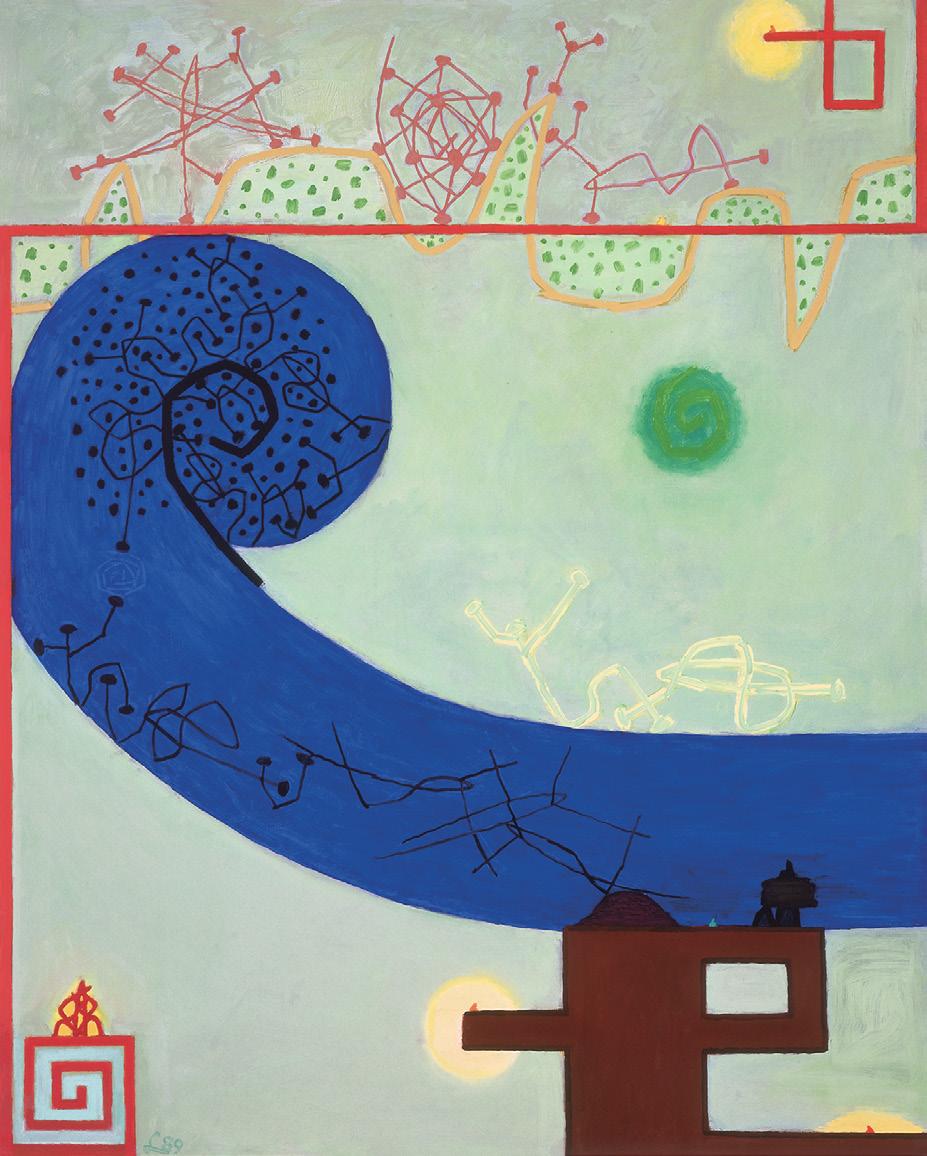
BORN
1921 Kansas City, Missouri.
EDUCATION
1939–40 St. Paul School of Fine Arts, St. Paul, Minnesota.
1947–50 California School of Fine Arts (now the San Francisco Art Institute).
1950–51 Académie de la Grande Chaumière, Paris.
TEACHING
1957–65 California School of Fine Arts, San Francisco.
1966–91 Stanford University, Stanford, CA. Professor of art; appointed Paul L. and Phyllis Wattis Professor of Art, 1989.
VISITING ARTIST/ARTIST-IN-RESIDENCE
1948 College of the PaciWc, Stockton, CA. Instructor, summer session.
1948–49 California Palace of the Legion of Honor, San Francisco. Painting instructor.
1965 Artist-in-Residence, Stanford University, Stanford, CA.
1966 Fellow, Tamarind Lithography Workshop, Los Angeles.
1984 Visiting Artist, Skowhegan School, Skowhegan, ME.
1985
Visiting Artist, Tyler School of Art of Temple University, Philadelphia.
1986 Artist-in-Residence, New York Studio School of Drawing, Painting, and Sculpture, New York, June 9–August 1.
1992 Visiting Artist, Yale University School of Art, New Haven, CT (with David Kelso), February.
1993 Visiting Artist, Tyler School of Art of Temple University, Philadelphia, Summer.
Visiting Artist, Vermont Studio Center, Johnson, August.
GRANTS AND AWARDS
1947 First Prize (oil painting), Minnesota State Fair.
1948 Artists’ Council Prize, Twelfth Annual Drawing and Print Exhibition, San Francisco Art Association.
1950 San Francisco Bank Prize, 69th Annual Oil, Tempera, and Sculpture Exhibition, San Francisco Art Association.
Purchase Prize, 14th Annual Drawing and Paint Exhibition, San Francisco Art Association.
1960 Nealie Sullivan Award for a California Artist, San Francisco Art Association.
1986 Pew Foundation Grant, awarded through Stanford University.
1988 Gold Medal for Distinguished Achievement in Painting, American Academy and Institute of Arts and Letters, New York.
1992 Academy Purchase Award, American Academy and Institute of Arts and Letters, New York.
1994 Academy Purchase Award, American Academy and Institute of Arts and Letters, New York.
1998 Elected to National Academy of Design.
1948 College of the PaciWc, Stockton, CA.
1958 Martha Jackson Gallery, New York.
1960 M. H. de Young Memorial Museum, San Francisco, Frank Lobdell: Exhibition of Paintings, January 19–February 18. Brochure. Martha Jackson Gallery, New York, Frank Lobdell: Catalogue of Paintings, 1953–1959, April 19–May 7. Catalogue.
1962 Ferus Gallery, Los Angeles, April 16–May 5.
1963 Martha Jackson Gallery, New York, Frank Lobdell: Paintings and Drawings, April 20–May 21.
1964 Galerie D. Benador, Geneva, Switzerland, Frank Lobdell: Peintures, Gouaches, Dessins, November–December.
1965 Galerie Anderson-Mayer, Paris, April 7–May. Catalogue.
1966 Pasadena Art Museum, Pasadena, CA, Frank Lobdell: Paintings and Graphics from 1948 to 1965, March 15–April 10. Travel to Stanford Art Museum, Stanford, CA, May 1–31. Catalogue.
Stanford Art Gallery, Stanford, CA, November 5–December 4. San Jose City College, San Jose, CA, December 5–19.
1967 Marylhurst College, Portland, OR, Lithographs by Frank Lobdell, October–December.
1969 San Francisco Museum of Art, Frank Lobdell: Twenty-Seven Lithographs and a Large Painting, January 21–February 16. Brochure.
1971 Cheney Cowles Museum, Eastern Washington University, Spokane. St. Mary’s College Art Gallery, Moraga, CA, Frank Lobdell: Paintings–Drawings, May 1–28.
1972
1974
1975
Martha Jackson Gallery, New York, Frank Lobdell: Paintings, 1969–1971, March 1–25. Brochure.
Martha Jackson Gallery, New York, Frank Lobdell, Paintings and Drawings, 1955–1973, October 17–November 16. Brochure.
Martha Jackson Gallery, New York.
1977 Smith Andersen Gallery, Palo Alto, CA, Monotypes.
1978 Smith Andersen Gallery, Palo Alto, CA.
1981 Wiegand Gallery, College of Notre Dame, Belmont, CA. Frank Lobdell: Summer Mural and Preparatory Drawings. Travel to Pepperdine University Art Gallery, Malibu, CA, October 25–November 25; Reed College Art Gallery, Portland, OR. Catalogue.
1982
Smith Andersen Gallery, Palo Alto, CA, Drawings and Prints.
Smith Andersen Gallery at 2140 Bush Street, San Francisco, February 27–March 27.
Oscarsson-Hood Gallery, New York, December 1982–January 1983.
1983 San Francisco Museum of Modern Art, Frank Lobdell: Paintings and Monotypes, 1955–1981, January 20–March 27. Catalogue.
Oscarsson-Hood Gallery, New York, Frank Lobdell: Recent Paintings and Monotypes, December 7, 1983–January 7, 1984. Brochure.
1985
Oscarsson-Hood Gallery, New York, Frank Lobdell: Paintings and Gouaches, 1958–1972, February 27–March 30. Brochure.
Tyler Gallery, Temple University, Philadelphia, November 15–December 12.
Tyler School of Art of Temple University, Philadelphia, November 20–December 14.
1987 John Berggruen Gallery, San Francisco, March 10–April 4.
1988 Charles Campbell Gallery, San Francisco, Frank Lobdell: Figure Drawings 1964–1974, September 27–October 29. Catalogue.
Stanford University Museum of Art, Stanford, CA, Frank Lobdell: Recent Etchings and Aquatints, September 27–November 27.
1990 Campbell-Thiebaud Gallery, San Francisco, Frank Lobdell: Recent Paintings, Drawings, Prints, September 4–October 13.
1991 Smith Andersen Gallery, Palo Alto, CA, Frank Lobdell: Recent Monotypes, November 22, 1991–January 4, 1992.
Campbell-Thiebaud Gallery, San Francisco.
1992 M. H. de Young Memorial Museum, Fine Arts Museums of San Francisco, Viewpoints XVIII: Frank Lobdell. Brochure.
Campbell-Thiebaud Gallery, San Francisco, Frank Lobdell: New Work, September 1–October 10. Catalogue.
1993 Stanford University Museum of Art, Stanford, CA, Frank Lobdell: Works, 1947–1992, January 12–April 25. Catalogue.
1995 Campbell-Thiebaud Gallery, San Francisco.
Printworks, Chicago, Frank Lobdell, Aquatint Etchings.
1998 Western Michigan University, Kalamazoo, Etchings by Frank Lobdell. Campbell-Thiebaud Gallery, San Francisco. Shorenstein Building, 425 Market Street, San Francisco.
Hearst Art Gallery, St. Mary’s College, Moraga, CA, Frank Lobdell: Master Artist V, October 11–December 20. Catalogue.
Printworks, Chicago, Frank Lobdell, Recent Prints, November 17, 1998–January 6, 1999.
2000 Campbell-Thiebaud Gallery, San Francisco, Frank Lobdell: Recent Paintings and Drawings, May 2–June 3.
2001 The Art Exchange, San Francisco, Frank Lobdell: A Decade of Etchings, September.
2002 Hackett-Freedman Gallery, San Francisco, Frank Lobdell: Three Phases, 1947–2001, March 7–30. Catalogue.
Charles Cowles Gallery, New York, Frank Lobdell: Early Works, November 23–December 21.
2003 Fine Arts Museums of San Francisco.
Hackett-Freedman Gallery, San Francisco, Frank Lobdell: Early Figure Drawings, March 6–29.
Portland Art Museum, Portland, OR, Frank Lobdell: The Art of Making and Meaning.
GROUP EXHIBITIONS
1947 San Francisco Museum of Art, Annual Exhibition. Catalogue. Minnesota State Fair, Minneapolis. Award.
Rex Art Theatre, San Francisco, Frank Lobdell and John Hultberg, October.
California Palace of the Legion of Honor, San Francisco, Second Annual Exhibition of Painting, November 19, 1947–January 4, 1948. Catalogue.
1948 San Francisco Museum of Art, 67th Annual Exhibition: Oil, Tempera, and Sculpture of the San Francisco Art Association, February 4–29. Catalogue.
California Palace of the Legion of Honor, San Francisco, Young Artists of the Bay Area, April 23–May 16. Brochure.
San Francisco Museum of Art, Twelfth Annual Drawing and Print Exhibition, San Francisco Art Association. Award. Catalogue. Reed College, Portland, OR (exhibition organized by Kenneth Sawyer).
San Francisco Museum of Art, Twelfth Annual Watercolor Exhibition, San Francisco Art Association, October 20–November 14. Catalogue.
California College of Arts & Crafts, Oakland, Current Trends in Bay Region Art.
Seashore Gallery of Modern Art, Sausalito, CA, Five Young Moderns, May 9–June 15.
Contemporary Gallery, Sausalito, CA.
North Beach Studio Gallery, San Francisco.
Schillerhaus, Sausalito, CA.
Lawson Galleries, San Francisco, Group Show, Sixteen Lithographs.
Oakland Art Gallery, Oakland, CA, Oakland Art Gallery’s Annual Exhibition of Oil Paintings and Sculpture. Catalogue.
California Palace of the Legion of Honor, San Francisco, Third Annual Exhibition of Painting.
1949 Minneapolis Institute of Art, Minneapolis.
Lucien Labaudt Gallery, San Francisco, Frank Lobdell and George Stillman.
Alta Mira Hotel, Sausalito, CA.
San Francisco Museum of Art Rental Gallery.
California School of Fine Arts, San Francisco, Museum of Unknown and Little Known Objects.
1950 San Francisco Museum of Art, 69th Annual Oil, Tempera, and Sculpture Exhibition of the San Francisco Art Association, February 10–March 12. Award. Catalogue.
San Francisco Museum of Art, 14th Annual Drawing and Print Exhibition of the San Francisco Art Association. Award. Catalogue.
San Francisco Museum of Art, New Bay Region Artists (Fifteenth Anniversary).
San Francisco Museum of Art Rental Gallery.
1951 Petit Palais, Paris, 6ème Salon des Réalités Nouvelles.
1952 San Francisco Museum of Art, Bay Region Painting and Sculpture.
1953 Felix Landau Gallery, Los Angeles, Six San Francisco Painters.
1954 Dilexi Gallery, San Francisco, Drawings and the Like.
1955 United States Pavilion, São Paulo, Brazil, Third Biennial of São Paulo— Paci¬c Coast Art, July–October. Catalogue.
1956 Santa Barbara Museum of Art, Santa Barbara, CA, California Artists.
Municipal Art Center, Long Beach, CA, in collaboration with the San Francisco Museum of Art, California Painting: 40 Painters. Catalogue.
Oakland Art Museum, Oakland, CA, California School—Yes or No?
San Francisco Museum of Art, Paci¬c Coast Art: United States’ Representation at the Third Biennial of São Paulo. Travel to Cincinnati Art Museum, Cincinnati, OH; Colorado Springs Fine Arts Center, Colorado Springs, CO; and Walker Art Center, Minneapolis. Catalogue.
1957 San Francisco Museum of Art, Painting and Sculpture Now: 76th Annual Painting and Sculpture Exhibition of the San Francisco Art Association. Catalogue.
Ferus Gallery, Los Angeles, Objects on the New Landscape Demanding of the Eye (Inaugural exhibition), March 15–April 11.
Ferus Gallery, Los Angeles, December 6, 1957–January 4, 1958.
1958 Ferus Gallery, Los Angeles, May 9–31 (with Jay DeFeo, Hassel Smith, Julius Wasserstein, others).
Osaka International Festival, Osaka, Japan, International Art of a New Era. Ferus Gallery, Los Angeles, November–December (with Richard Diebenkorn, Sonia GechtoV, David Park, Hassel Smith, Julius Wasserstein, others).
Martha Jackson Gallery, New York.
1959 Dilexi Gallery, San Francisco, First Anniversary Group Show (with Joel Barletta, Jay DeFeo, Richard Diebenkorn, Robert Morris, Philip Roeder, Hassel Smith).
Ferus Gallery, Los Angeles, July 20–August 15 (with Jay DeFeo, Sonia GechtoV, Robert Irwin, Ed Moses, Hassel Smith, others).
1960 Walker Art Center, Minneapolis, 60 American Artists: Abstract Expressionist Painting of the Fifties, April 3–May 8. Catalogue.
Ferus Gallery, Los Angeles, June 20–July 16.
Triangle Gallery, San Francisco, drawing exhibition with Richard Diebenkorn.
1961 Ferus Gallery, Los Angeles, Group Exhibit, April 3–29.
San Francisco Art Institute, Faculty Exhibition.
Dilexi Gallery, San Francisco, A Selection of Drawings.
Pasadena Art Museum, Pasadena, CA, Drawings by Richard Diebenkorn and Frank Lobdell, December 15, 1961–January 17, 1962.
1962 Martha Jackson Gallery, New York.
San Francisco Museum of Art and Los Angeles County Museum of Art, Fifty California Artists. Catalogue.
Whitney Museum of American Art, New York, Fifty California Artists, October 23–December 2. Travel to Walker Art Center, Minneapolis, February 17–March 17, 1963; Albright-Knox Art Gallery, BuValo, April 10–May 8, 1963; Des Moines Art Center, Des Moines, May 24–June 23, 1963. Catalogue.
Stanford University Art Gallery, Stanford, CA, Some Points of View—’62: San Francisco Bay Area Painting and Sculpture, October 30–November 20. Catalogue.
Amon Carter Museum of Western Art, Fort Worth, TX, The Artist’s Environment: West Coast, November 6–December 23. Travel to UCLA Art Gallery, Los Angeles, and The Oakland Museum. Catalogue.
Contemporary Arts Museum, Houston, San Francisco 9, November 29–December 29. Catalogue.
1963 Allentown Art Museum, Allentown, PA, The James A. Michener Foundation Collection, February 2–March 20. Catalogue.
Ferus Gallery, Los Angeles, June–July.
San Francisco Museum of Art, 82nd Annual Exhibition of the San Francisco Art Association, March 21–April. Catalogue.
Achenbach Foundation for the Graphic Arts, California Palace of the Legion of Honor, San Francisco, Drawings by Elmer Bischoff, Richard Diebenkorn, and Frank Lobdell.
International Center of Aesthetic Research, Turin, Italy.
California Palace of the Legion of Honor, San Francisco, September.
Art Center in La Jolla, La Jolla, CA, Fourth Art Center Annual of California Painting and Sculpture, November 17–December 15. Catalogue.
Isaac Delgado Museum of Art, New Orleans, The Michener Foundation Collection, December 8, 1963–January 12, 1964.
1964 Solomon R. Guggenheim Museum, New York, American Drawings, September 17–October 27. Travel to Dallas Museum of Fine Arts; Seattle Art Museum; University of Michigan Museum of Art, Grand Rapids; Krannert Art Museum, University of Illinois, Champaign. Catalogue.
Berkeley Gallery, Berkeley, CA, 100 Artists for Free Speech, December 22, 1964–January 3, 1965.
1965 Martha Jackson Gallery, New York, Figuration, February 9–March 6.
M. H. de Young Memorial Museum, San Francisco, The San Francisco Collector.
Everhart Museum, Scranton, PA, Non-Objective Paintings from the Michener Foundation, May 1–30.
Kutztown State College, Kutztown, PA, American Painting Since 1950, from the Michener Collection, October 1–31.
1967 The White House, Washington, D.C., group exhibition from the National Collection of Fine Arts, Smithsonian Institution.
1968 Los Angeles County Museum of Art, Late Fifties at the Ferus, November 12–December 17. Catalogue.
Art Museum, University of Texas, Austin, Painting as Painting. Catalogue.
1969 Bolles Gallery, San Francisco, exhibition of artists from Martha Jackson Gallery, July 31–August.
Pasadena Art Museum, Pasadena, CA, West Coast 1945–1969. Catalogue. Stedelijk van Abbemuseum, Eindhoven, The Netherlands, Kompas 4: West Coast U.S.A., November 21, 1969–January 4, 1970. Catalogue.
1971 The Corcoran Gallery of Art, Washington, D.C., Thirty-Second Annual Exhibition of Contemporary American Painting. Catalogue.
Hearst Art Gallery, St. Mary’s College, Moraga, CA.
SpringWeld Art Museum, SpringWeld, MO, The Sixties, from the Michener Collection, University of Texas at Austin, September 19–October 18.
1972
Whitney Museum of American Art, New York, 32nd Biennial Exhibition of Contemporary American Painting. Catalogue.
E. B. Crocker Art Gallery, Sacramento, CA, West Coast—72 Painters & Sculptors. Catalogue.
Michener Galleries, University of Texas, Austin, The Michener Collection: American Paintings of the Twentieth Century, November 22, 1972–March 1, 1973.
1973 The Oakland Museum, Oakland, CA, A Period of Exploration: San Francisco 1945–1950. Catalogue.
Pasadena Art Museum, Pasadena, CA, The Betty and Monte Factor Family Collection. Catalogue.
University of Maryland Art Gallery, College Park, The Private Collection of Martha Jackson. Travel to Albright-Knox Art Gallery, BuValo; Finch College Museum of Art, New York. Catalogue.
Smith Andersen Gallery, Palo Alto, CA.
1974 Krannert Art Museum, University of Illinois, Champaign, Contemporary American Painting and Sculpture. Catalogue.
1975 Walker Art Center, Minneapolis, Selections from the Martha Jackson Collection, February 16–March 30. Catalogue.
1976 San Francisco Museum of Modern Art, Painting and Sculpture in California: The Modern Era, September 3, 1976–January 2, 1977. Travel to The National Collection of Fine Arts, Smithsonian Institution, Washington, D.C., May 20–September 11, 1977. Catalogue
Newport Harbor Art Museum, Newport Beach, CA, The Last Time I Saw Ferus, 1957–1966, March 7–April 17. Catalogue.
1977 Smithsonian Institution Traveling Exhibition Service, Washington, D.C., New American Monotypes. Travel to U.S. Museums. Catalogue.
San Francisco Museum of Modern Art, Collectors Collecting: American Abstract Art Since 1945, April 22–June 5. Brochure.
1980 Suzanne Brown Gallery, Scottsdale, AZ, Bay Area Art: Then and Now, March 20–April 17. Catalogue.
1983 Bluxome Gallery, San Francisco.
1984 The Grolier Club, New York, Selections from the Rutgers Archives.
1985 Richard Hanson Fine Arts, Fresno, CA, Art of the Bay Area. ECHO Gallery, Austin, TX.
1986 Richmond Art Center, Richmond, CA, Process/Prints.
1987 The Allport Gallery, San Francisco, Recent Etchings from made in California.
1989 Faculty Club, Stanford University, Stanford, CA, made in California. Wiegand Gallery, College of Notre Dame, Belmont, CA, The Abstract Expressionist Years & After: Jack Jefferson, Frank Lobdell, Alvin Light, April 23–June 3. Catalogue.
1990 Villa Montalvo Center for the Arts, Saratoga, CA, made in California: A Ten-Year Survey.
Jane Voorhees Zimmerli Museum, Rutgers University, Newark, NJ, Intaglio Printing in the 1980s. Catalogue.
1991 Faculty Club, Stanford University, Stanford, CA, made in California. Olga Dollar Gallery, San Francisco, Recent Etchings from made in California, December 5, 1991–January 5, 1992.
1992 Palo Alto Cultural Center, Palo Alto, CA, Directions in Bay Area Printmaking: Three Decades. Catalogue.
IPA Gallery, Boston.
1993 Art Museum of Santa Cruz County, Santa Cruz, CA, Paper Trails: Abstract Expressionist Prints. Catalogue.
OYce of the Mayor, City Hall, San Francisco, Exhibition of Bay Area Fine Art Presses. Brochure.
1994
OYce of the Mayor, City Hall, Berkeley, CA.
American Academy and Institute of Arts and Letters, New York, Purchase Exhibition.
1995 Mulligan-Shanoski Gallery, San Francisco, made in California Intaglio Editions—A Fifteen-Year Survey, May 1–31.
Jane Voorhees Zimmerli Museum, Rutgers University, Newark, NJ, California Abstractions.
Fresno Art Museum, Fresno, CA, Fifteen Pro¬les: Distinguished California Modernists. Catalogue.
Triton Museum of Art, Santa Clara, CA, A Bay Area Connection: Works from the Anderson Collection, 1954–1984, November 1, 1995–January 28, 1996. Catalogue.
1996 Laguna Art Museum, Laguna Beach, CA, The San Francisco School of Abstract Expressionism, January 27–April 21. Travel to San Francisco Museum of Modern Art, July 18–September 29. Catalogue.
San Francisco Museum of Modern Art Rental Gallery, made in California. Campbell-Thiebaud Gallery, San Francisco, Bay Area Abstract Expressionism, June 18–July 27.
Salander-O’Reilly Gallery, New York, San Francisco Art Institute: Illustrious History 1871–1996, September 5–28. Travel to Montgomery Gallery and John Berggruen Gallery, San Francisco, November 12–December 11. Catalogue.
1997 Emmie Smock Gallery, San Francisco.
Portland Art Museum, Portland, OR, International Print Exhibition.
Smith Andersen Editions at The Drawing Center, New York, The 1997 New Editions Fair, November 6–9.
1999 Mendocino Art Center, Mendocino, CA, Prints from made in California.
2000 Spokane Falls Community College Fine Arts Department, Spokane, WA, made in California: Limited Edition Intaglio Prints.
Campbell-Thiebaud Gallery, San Francisco, Twenty-Five Treasures, September 5–October 7. Catalogue.
Worcester Art Museum, Worcester, MA, The Stamp of Impulse: Abstract Expressionist Prints. Catalogue.
2001 Gregory Kondos Gallery, Sacramento City College, Sacramento, CA, made in California.
Hackett-Freedman Gallery, San Francisco, San Francisco Abstract Expressionism: Selected Works, 1948–1982, September 6–October 27. Catalogue.
2002 The Contemporary Museum, Honolulu, Escape from the Vault: The Contemporary Museum’s Collection Breaks Out.
San Francisco Museum of Modern Art Rental Gallery, made in California.
Charles Cowles Gallery, New York, Richard Diebenkorn and Frank Lobdell: Figurative Drawings, November 23–December 21.
BOOKS
Albright, Thomas. Art in the San Francisco Bay Area, 1945–1980: An Illustrated History. Berkeley and Los Angeles: University of California Press, 1985.
Hayakawa, S. I., ed. The Use and Misuse of Language. Greenwich, CT: Fawcett Publications, Inc., 1962. Illustrations by Willliam H. Schneider and Frank Lobdell.
Jones, Caroline A. Bay Area Figurative Art: 1950–1965. Berkeley and Los Angeles: University of California Press; San Francisco: San Francisco Museum of Modern Art, 1990.
Kramer, Hilton, ed. Arts Yearbook 4. New York: Art Digest, 1961.
Landauer, Susan. The San Francisco School of Abstract Expressionism. Berkeley: University of California Press, 1996.
Motherwell, Robert, and Ad Reinhardt, eds. Modern Artists in America. New York: Wittenborn Schultz, 1951.
Natsoulas, John et al. The Beat Generation Galleries and Beyond. Davis, CA: John Natsoulas Press, 1996.
Northwestern University. Printmaking in America: Collaborative Prints and Presses, 1960–1990. New York: Abrams; Chicago: Northwestern University; pp. 34–36, 44.
Plagens, Peter. Sunshine Muse. New York: Praeger, 1974.
Sawyer, Kenneth, and Frank Lobdell. Poems & Drawings: Kenneth Sawyer, Frank Lobdell. San Francisco: Bern Porter, 1949. Illustrations by Frank Lobdell. Tapié, Michel. Morphologie autre. Turin, Italy: Edizione d’Arte Fratelli Pozzo, 1960.
Tournier, Michel. The Music of the Spheres. Berkeley, CA: Okeanos Press, 1992. Frontispiece etching by Frank Lobdell.
CATALOGUES
Albright, Thomas, and Peter Boswell. Frank Lobdell: Paintings and Monotypes, 1955–1981. San Francisco: San Francisco Museum of Modern Art, 1983.
Allentown Art Museum. The James A. Michener Foundation Collection. Allentown, PA: Allentown Art Museum, 1963.
Arnason, H. H. 60 American Painters: Abstract Expressionist Painting of the Fifties. Minneapolis: Walker Art Center, 1960.
Art Center in La Jolla. Fourth Art Center Annual of California Painting and Sculpture. La Jolla, CA: Art Center in La Jolla, 1963.
Bauersfeld, Erik. Frank Lobdell: Catalogue of Paintings, 1953–1959. New York: Martha Jackson Gallery, 1960.
Beneke, Daphne Lane. Fifteen Pro¬les: Distinguished California Modernists. Fresno, CA: Fresno Art Museum, 1995.
Boynton, James, ed. San Francisco 9. Houston: Contemporary Arts Museum, 1962. California Palace of the Legion of Honor. Second Annual Exhibition of Painting. Foreword by Thomas Carr Howe, Jr.; introduction by Jermayne MacAgy. San Francisco: California Palace of the Legion of Honor, Fine Arts Museums of San Francisco, 1947.
Campbell-Thiebaud Gallery. Twenty-Five Treasures Exhibition. San Francisco: Campbell-Thiebaud Gallery, 1996.
————. Twenty-Five Treasures. San Francisco: Campbell-Thiebaud Gallery, 2000. E. B. Crocker Art Gallery. West Coast—72 Painters & Sculptors. Sacramento, CA: E. B. Crocker Art Gallery, 1972.
Freeman, Richard B. (foreword). 67th Annual Exhibition: Oil, Tempera, and Sculpture of the San Francisco Art Association. San Francisco: San Francisco Museum of Art, 1948.
Galerie Anderson-Mayer. Frank Lobdell. Paris: Galerie Anderson-Mayer, 1965. Guenther, Bruce. Frank Lobdell: Three Phases, 1947–2001. San Francisco: HackettFreedman Gallery, 2002.
Holland, Katherine Church, et al. A Bay Area Connection: Works from the Anderson Collection, 1954–1984. Santa Clara, CA: Triton Museum of Art, 1995.
Hoos, Judith, and Mark Lassiter. Selections from the Martha Jackson Collection. Minneapolis: Walker Art Center, 1975.
Hopps, Walter. [Group Exhibition]. Los Angeles: Ferus Gallery, 1963.
————. Frank Lobdell: Paintings and Graphics from 1948 to 1965. Pasadena, CA: Pasadena Art Museum, 1966.
————. Thirty-Second Annual Exhibition of Contemporary American Painting. Washington, DC: The Corcoran Gallery of Art, 1971.
Jane Voorhees Zimmerli Museum. Intaglio Printing in the 1980s. Newark, NJ: Jane Voorhees Zimmerli Museum, Rutgers University, 1990.
Jones, Caroline A. Frank Lobdell: Works, 1947–1992. Stanford, CA: Stanford University Museum of Art, 1993.
Karlstrom, Paul J., et al. San Francisco Art Institute: Illustrious History, 1871–Present. San Francisco: San Francisco Art Institute, 1996.
Krannert Art Museum. Contemporary American Painting and Sculpture. Champaign, IL: Krannert Art Museum, University of Illinois, 1974.
Landauer, Susan. Paper Trails: Abstract Expressionist Prints. Santa Cruz, CA: Art Museum of Santa Cruz County, 1993.
————. San Francisco Abstract Expressionism: Selected Works, 1948–1982. San Francisco: Hackett-Freedman Gallery, 2001.
LaPlante, John D., ed. Some Points of View–’62: San Francisco Bay Area Painting and Sculpture. Stanford, CA: Stanford University Art Gallery, 1962.
Leering, Jan, et al. Kompas 4: West Coast U.S.A. Eindhoven, The Netherlands: Stedelijk van Abbemuseum, 1969.
Long Beach Municipal Art Center. California Painting: 40 Painters. Long Beach, CA: Municipal Art Center, 1956.
MayWeld, Signe. Directions in Bay Area Printmaking: Three Decades. Palo Alto, CA: Palo Alto Cultural Center, 1992.
McChesney, Mary A. Period of Exploration: San Francisco 1945–1950. Oakland, CA: Oakland Museum, 1973.
Monte, James. Late Fifties at the Ferus. Los Angeles: Los Angeles County Museum of Art, 1968.
Morley, Grace McCann. Paci¬c Coast Art: United States’ Representation at the Third Biennial of São Paulo. San Francisco: San Francisco Museum of Art, 1956.
Moss, Stacey. The Abstract Expressionist Years & After: Jack Jefferson, Frank Lobdell, Alvin Light. Belmont, CA: Wiegand Gallery, College of Notre Dame, 1989. Natsoulas/Novelozo Gallery Press. Foreword by John Allen Ryan. Lyrical Vision: The ‘6’ Gallery 1954–1957. Davis, CA: Natsoulas/Novelozo Gallery Press, 1989. Neubert, George. Drawings 1964–1974: Frank Lobdell. San Francisco: Charles Campbell Gallery, 1988.
Oakland Art Gallery. Oakland Art Gallery’s Annual Exhibition of Oil Paintings and Sculpture. Oakland, CA: Oakland Art Gallery, 1948.
Pasadena Art Museum. West Coast 1945–1969. Pasadena, CA: Pasadena Art Museum, 1969.
————. The Betty and Monte Factor Family Collection. Pasadena, CA: Pasadena Art Museum, 1973.
San Francisco Museum of Art. Annual Exhibition. San Francisco: San Francisco Museum of Art, 1947.
————. 67th Annual Oil, Tempera, and Sculpture Exhibition of the San Francisco Art Association. San Francisco: San Francisco Museum of Art, 1948.
————. Twelfth Annual Drawing and Print Exhibition, San Francisco Art Association. San Francisco: San Francisco Museum of Art, 1948.
————. Twelfth Annual Watercolor Exhibition, San Francisco Art Association. San Francisco: San Francisco Museum of Art, 1948.
————. 14th Annual Drawing and Print Exhibition, San Francisco Art Association. San Francisco: San Francisco Museum of Art, 1950.
————. 69th Annual Oil, Tempera, and Sculpture Exhibition of the San Francisco Art Association. San Francisco: San Francisco Museum of Art, 1950.
————. Painting and Sculpture Now: 76th Annual Painting and Sculpture Exhibition. San Francisco: San Francisco Museum of Art, 1957.
————. 82nd Annual Exhibition of the San Francisco Art Association. San Francisco: San Francisco Museum of Art, 1963.
San Francisco Museum of Art and Los Angeles County Museum of Art. Fifty California Artists. San Francisco: San Francisco Museum of Art, and Los Angeles: Los Angeles County Museum of Art, 1962.
San Francisco Museum of Modern Art. Collectors Collecting: American Abstract Art Since 1945. San Francisco: San Francisco Museum of Modern Art, 1971.
San Francisco Museum of Modern Art and the National Collection of Fine Arts. Painting and Sculpture in California: The Modern Era. San Francisco: San Francisco Museum of Modern Art; Washington, DC: National Collection of Fine Arts, Smithsonian Institution, 1977.
Smithsonian Institution. New American Monotypes. Washington, DC: Smithsonian Institution Traveling Exhibition Service, 1977.
Solomon R. Guggenheim Museum. American Drawings. New York: Solomon R. Guggenheim Museum, 1964.
Tanner, Marcia. Frank Lobdell: Master Artist V. Moraga, CA: Hearst Art Gallery, St. Mary’s College, 1998.
Tapié, Michel. Introduction to Frank Lobdell. Geneva, Switzerland: Galerie D. Benador, 1964.
————. Frank Lobdell. Paris: Galerie David Anderson, 1965.
Thiebaud, Paul LeBaron. Frank Lobdell: New Work. San Francisco: CampbellThiebaud Gallery, 1992.
Third Biennial of São Paulo. São Paulo, Brazil: United States Pavilion, 1955. Turk, R. H. Bay Area Art: Then and Now. Scottsdale, AZ: The Suzanne Brown Gallery, 1980.
Turnbull, Betty. The Last Time I Saw Ferus, 1957–1966. Newport Beach, CA: Newport Harbor Art Museum, 1976.
University of Maryland Art Gallery. The Private Collection of Martha Jackson. College Park: University of Maryland Art Gallery, 1973.
University of Texas Art Museum. Painting as Painting. Austin: University of Texas, 1968.
Whitney Museum of American Art. Fifty California Artists. Foreword by Lloyd Goodrich. New York: Whitney Museum of American Art, 1962.
————. 32nd Biennial Exhibition of Contemporary American Painting. New York: Whitney Museum of American Art, 1972.
Wiegand Gallery. Frank Lobdell: Summer Mural and Preparatory Drawings. Belmont, CA: Wiegand Gallery, College of Notre Dame, 1981.
Wight, Frederick S. The Artist’s Environment: West Coast. Fort Worth, TX: Amon Carter Museum of Western Art, 1962.
Worcester Art Museum. The Stamp of Impulse: Abstract Expressionist Prints. Worcester, MA: Worcester Art Museum, 2001.
BROCHURES
California Palace of the Legion of Honor. Young Artists of the Bay Area. San Francisco: California Palace of the Legion of Honor, 1948.
Cohen, Ronny. Frank Lobdell: Paintings and Gouaches, 1958–1972. New York: Oscarsson-Hood Gallery, 1985.
Hopkins, Henry T., et al. Collectors Collecting: American Abstract Art Since 1945. San Francisco: San Francisco Museum of Modern Art, 1977.
M. H. de Young Memorial Museum. Frank Lobdell: An Exhibition of Paintings. San Francisco: M. H. de Young Memorial Museum, 1960. made in California. Frank Lobdell: 10 Etchings and Aquatints, 1987. Oakland, CA: made in California, 1987.
————. Frank Lobdell: 1992 Intaglio Editions. Oakland, CA: made in California, 1992. Martha Jackson Gallery. Frank Lobdell: Paintings, 1969–1971. New York: Martha Jackson Gallery, 1972.
————. Frank Lobdell, Paintings and Drawings, 1955–1973. New York: Martha Jackson Gallery, 1974.
Nash, Steven A. Viewpoints XVIII: Frank Lobdell. San Francisco: The Fine Arts Museums of San Francisco, 1992.
Nordland, Gerald. Frank Lobdell: Twenty-Seven Lithographs and a Large Painting. San Francisco: San Francisco Museum of Art, 1969.
OYce of the Mayor, City of San Francisco. Exhibition of Bay Area Fine Art Presses. San Francisco: OYce of the Mayor, City Hall, 1993.
Oscarsson-Hood Gallery. Frank Lobdell: Recent Paintings and Monotypes. New York: Oscarsson-Hood Gallery, 1983.
SELECTED ARTICLES
Albright, Thomas. “Looking Back on Bay Area Art.” San Francisco Chronicle, August 18, 1968, “This World,” pp. 25–26.
————. “Frank Lobdell Painting—Memorial and Milestone.” San Francisco Chronicle, January 24, 1969, p. 43.
————. “Corporation’s First-Rate Art.” San Francisco Chronicle, June 13, 1970.
————. “Hanging His Hopes on a Single Work.” San Francisco Chronicle, March 12, 1981, “Datebook,” p. 60.
————. “San Francisco: DiVerent and IndiVerent Drummers.” Artnews, vol. 81, no. 1, January 1982, pp. 86–90.
————. “On the Lighter Side of Frank Lobdell.” San Francisco Chronicle, March 15, 1982, “Datebook” section.
————. “San Francisco: Coming Up from Underground.” Artnews, January 1983, pp. 76–79.
————. “Lobdell’s Monastic Commitment.” San Francisco Chronicle, January 30, 1983, “Review” section, p. 12.
————. “The Value of a ‘Bad’ Painting to an Artist.” San Francisco Chronicle, March 3, 1983, p. 61.
————. “The New Image of Rothenberg.” San Francisco Chronicle, November 19, 1983, p. 38.
“Album: Frank Lobdell.” Arts, March 1985, p. 44.
A[nderson], L[aurie]. “Reviews and Previews.” Artnews, vol. 71, no. 1, March 1972, p. 18.
“Art Show for UC Students.” San Francisco Chronicle, December 23, 1964.
“Artist-in-Residence: Frank Lobdell.” The Committee for Art at Stanford Newsletter, October 1965, pp. 3–5.
Ashton, Dore. “Galleries Join in BeneWt Show.” New York Times, June 8, 1958, part II, p. 13.
————. “Art: Master Drawings—Estes Gallery Show Spans 5 Centuries; Frank Lobdell’s Work on View.” New York Times, April 19, 1960, p. 34.
————. “Art.” Arts & Architecture, vol. 77, no. 7, July 1960, p. 9.
————. “West Coast Artists Score in Painting: New York Commentary.” Studio, vol. 165, no. 838, February 1963, pp. 65–66.
————. “Objective Painting with the Personal Touch: New York Commentary.” Studio, vol. 166, no. 844, August 1963, pp. 80–81.
Baker, Kenneth. “Imaginative Freedom of Lobdell’s New Paintings.” San Francisco Chronicle, March 27, 1987.
————. “30-Year Panorama of Art at the Triton.” San Francisco Chronicle, November 28, 1995, p. E1.
Barrio, Raymond. “Lobdell Exhibit Tiresome, Silly.” Palo Alto Times, May 4, 1966, section III, p. 27.
Bengston, Billy Al. “Late Fifties at the Ferus.” Artforum, vol. 7, no. 5, January 1969, pp. 33–35.
Berkson, Bill. “Frank Lobdell: Campbell-Thiebaud Gallery.” Artforum International, January 1991, p. 132.
BloomWeld, Arthur. “Lobdell’s Canvases Appear Haunted.” San Francisco News-Call Bulletin, January 23, 1960, p. 13TV.
————. “Lobdell—Brute Power and Traumatic Sweep.” San Francisco Examiner, May 7, 1966, “Lively Arts,” p. 14.
Blum, Irving. “Letters to the Editor.” Artforum, vol. 1, no. 3, August 1962. (Letter sent in reply to article “Reviews: Los Angeles” by Larry Rottersman in Artforum, vol. 1, no. 2, July 1962.)
Bogat, Regina. “Fifty California Artists.” Artforum, December 1962, pp. 23–26. Burrows, Carlyle. “Art Acquisitions, OVerings.” New York Herald Tribune, April 24, 1960.
C.-S. “Frank Lobdell: Oscarsson Hood.” Artnews, Summer 1985, p. 122.
C[ampbell], L[awrence]. “Frank Lobdell.” Artnews, vol. 62, no. 4, Summer 1963, p. 14.
Carr, Jack. “Beyond Abstract: Art Museum Provides Rare Study of Lobdell’s Work.” Pasadena Star News, March 20, 1960.
Case, William D. “In the Galleries: New York Art Review.” Arts, February 1972, p. 61.
Chipp, Herschel. “This Summer in San Francisco.” Artnews, vol. 57, no. 4, Summer 1958, p. 48.
Cohen, Ronny. “Frank Lobdell, Oscarsson Hood Gallery.” Artforum International, April 1984, pp. 77–78.
“Come Up and See Their Etchings.” S.F. Sunday Examiner & Chronicle, “California Living,” October 20, 1968, pp. 14–15.
Conal, Robbie. “Drawings with AE Traditions.” Artweek, February 17, 1979, p. 5.
Coplans, John. “Notes from San Francisco.” Art International, May 25, 1963, p. 73.
————. “Circle of Styles on the West Coast.” Art in America, vol. 52, no. 3, June 1964, pp. 24–40.
————. “Art News from Los Angeles.” Artnews, vol. 65, no. 4, Summer 1966, p. 57.
Cutler, Carol. “An Attempt to Enliven Big, Boring Biennial Surveys of American Art.” Smithsonian, March 1971, pp. 60–67.
D[ennison], G[eorge]. “In the Galleries.” Arts, vol. 34, no. 8, May 1960, p. 56.
Donnell-Kotrozo, Carol. “Bay Area Synopsis.” Artweek, vol. 11, no. 13, April 5, 1980.
————. “Bay Area Art.” Arts, May 1980.
Drath, Viola Herms. “The 32nd Corcoran Biennial: Art as Visual Event.” Art International, vol. 15, no. 5, May 20, 1971, p. 40.
Duncan, Michael. “Bay Area Bravura.” Art in America, September 1996, pp. 45–47. F[actor], D[on]. “Frank Lobdell: Pasadena Art Museum.” Artforum, vol. 4, no. 9, May 1966, pp. 13–14.
“Forum Letters.” Palo Alto Times, May 12, 1966.
“Four Painters at Stanford: Keith Boyle, Jim Johnson, Frank Lobdell, Nathan Oliveira.” The Stanford Magazine, Spring/Summer 1976, pp. 64–68.
“Frank Lobdell.” Print Collector’s Newsletter, May/June 1982, p. 57.
“Frank Lobdell.” Print Collector’s Newsletter, January/February 1984, p. 214.
“Frank Lobdell & Michel Tournier.” Print Collector’s Newsletter, March/April 1993, p. 22.
“Frank Lobdell: Four Drawings.” Artforum, vol. 1, no. 12, June 1963, pp. 26–27.
“Frank Lobdell, San Francisco Artist, Honored at Stanford.” Vallejo Times-Herald (Vallejo, CA), May 15, 1966.
Frankenstein, Alfred. “The Legion’s Huge and Diverse Invitational.” San Francisco Chronicle, January 7, 1962, “This World,” pp. 21–22.
————. “Big Group Shows Emphasize the Experienced.” San Francisco Chronicle, March 24, 1963, pp. 23–24.
————. “The Depth and Radiance of Lobdell.” San Francisco Chronicle, May 8, 1966, “This World,” pp. 25–26.
————. “Two Bay Area Masters.” San Francisco Chronicle, May 20, 1971, p. 44.
Fried, Alexander. “Forceful View of Life in Baskin Prints.” San Francisco Examiner, October 13, 1963.
Fulton, Jack. “Flirting with Abstraction.” Marin Independent Journal, July 20, 1996, p. E1.
Gibson, Ann, ed. “Frank Lobdell.” Issue 4, Fall 1985, pp. 30–32.
Gilbert-Rolfe, Jeremy. “Reviews.” Artforum International, vol. 13, no. 5, January 1975, p. 73.
Glueck, Grace. “The Artists’ Artists.” Artnews November 1982, pp. 90–100.
————. “Frank Lobdell.” New York Times, December 23, 1983.
————. “Frank Lobdell.” New York Times, November 29, 2002, p. B34. Grothaus, Molly. “Lobdell Prints at Marylhurst.” Oregon Journal (Portland, OR), October 20, 1966.
Guilbert, Gladys E. “Three-Part Show Opens Friday.” Spokesman-Review (Spokane, WA), February 7, 1971.
“Jurors for S.F. Art Exhibition.” San Francisco Chronicle, October 11, 1962.
Kelso, David. “Frank Lobdell: ProoWng for Prints.” Print Collector’s Newsletter, vol. 19, no. 5, November/December 1988, pp. 173–176.
————. “Consuming Art.” Zyzzyva, vol. 15, no. 2, Summer 1999, pp. 103–104.
Kramer, Hilton. “Wiley of the West: ‘Dude Ranch Dada.’” New York Times, May 16, 1971, part II, p. 19.
————. “Art.” New York Times, October 26, 1974, p. 25.
Leider, Philip. “California after the Figure.” Art in America, vol. 51, no. 5, October 1963, pp. 73–83.
Leider, Philip and John Coplans. “West Coast Art: Three Images.” Artforum, vol. 1, no. 12, October 1963, p. 25.
Levy, Mark. “Frank Lobdell at John Berggruen.” Art in America, September 1987, p. 185.
Littlejohn, David. “The New York School’s Cross-country Rival.” Wall Street Journal, September 10, 1996.
Malone, Molly. “Emotive Color and Line” Artweek, vol. 13, no. 11, May 20, 1982, p. 4. Martin, Fred. “Painting and Sculpture in California: The Modern Era.” Art International, October/November 1976, pp. 48–53.
McCombie, Mel. “Artists’ Bay Area ReXections Now on Exhibit in Texas.” Austin American-Statesman, April 5, 1985, p. J11.
Mellow, James R. “Bolotowsky: An Old Style Gets New Life.” New York Times, March 12, 1972, part II, p. 23.
Menzies, Neal. “Painterly Summation.” Artweek, November 14, 1981, p. 3.
Miedzinski, Charles. “Frank Lobdell: Painting and Spiritual Quest.” Artweek, vol. 14, no. 6, February 12, 1983.
Monte, James. “Reviews: San Francisco.” Artforum, vol. 2, no. 1, July 1963, pp. 7–8.
————. “Reviews: Drawings by Elmer BischoV, Richard Diebenkorn and Frank Lobdell.” Artforum, January 1975, pp. 7–8.
“Month in Review.” Arts, October 1960, p. 54.
Morley, Grace McCann. “The PaciWc Coast Artists Brought Their Climate to São Paolo.” San Francisco Chronicle, October 2, 1955.
Moss, Stacey. “Frank Lobdell Explores the Monotype.” Artweek, April 16, 1977, p. 3.
Nixon, Bruce. “Lobdell’s Burden.” Artweek, April 8, 1993, pp. 4–5.
Nordland, Gerald. “Frank Lobdell: Process & Conclusion.” Newsletter of the Committee for Art at Stanford, Winter 1969.
“One-Man Show at Stanford.” San Jose Mercury News, May 1, 1966.
Peillex, Georges. “Ausstellungen.” Werk (Switzerland), vol. 52, no. 1, January 1965, p. 18.
“People in the Arts.” Arts, vol. 34, no. 6, March 1960, p. 10.
Plagens, Peter. “70 Years of California Modernism in 340 Works by 200 Artists.” Art in America, May 1977, pp. 65–69.
————. “The San Francisco School of Abstract Expressionism.” Artforum International, November 1996, pp. 91, 127.
“Professor Shows 32 Lithographs.” Valley News & Green Sheet (Van Nuys, CA), November 10, 1966.
Program Folio, KPFA Radio (Berkeley, CA), vol. 17, no. 3, May 16–June 12, 1966. Rangarajan, Raj S. “Lobdell Keeps Reinventing Himself.” Artnewsletter, vol. 27, no. 19, May 14, 2002, p. 6.
RatcliV, Carter. “New York Letter.” Art International, May 1972, p. 46.
R[ottersman], L[arry]. “Reviews: Los Angeles.” Artforum, vol. 1, no. 2, July 1962, p. 7.
(See Irving Blum reply in August 1962 issue.)
S[andler], I[rving] H. “Reviews and previews: New Names this Month.” Artnews, vol. 59, no. 3, May 1960, p. 19.
Sawyer, Kenneth B. “Review of New York Season.” The Sun (Baltimore), April 1960. Schneider, Greg. “Frank Lobdell at Hearst Art Gallery.” Artweek, January 1999, pp. 17–18.
Seldis, Henry J. “Vitality of Bay Area Art Accented in Three Shows.” Los Angeles Times, April 20, 1962, Part IV, p. 4.
Shere, Charles. “Exhibit Requires Two Visits.” Oakland Tribune, September 23, 1973.
————. “Exhibitions Show Vitality of Abstract Expressionism.” Oakland Tribune, March 19, 1982.
————. “Lobdell’s Inspiring Lesson.” Oakland Tribune, March 1983.
Shirey, David L. “Bolotowsky Shows a Vertical Format.” New York Times, March 4, 1972.
“Stanford Museum Sets Month-Long Exhibit of Work Spanning 18 Years of Frank Lobdell’s Art Career.” Palo Alto Times, April 30, 1966.
Stiles, Knute. “San Francisco.” Artforum, vol. 2, no. 10, April 1964, p. 13.
————. “On Art.” The Voice (San Francisco), March 12, 1982, p. 16.
————. “Frank Lobdell at the San Francisco Museum of Modern Art.” Art in America, May 1983, p. 177.
Stone, Judy. “New Art Explained by Sausalitans.” San Rafael Daily Independent and Marin Journal, January 22, 1949.
————. “The Unexpected Career of an Unusual Curator.” San Francisco Chronicle, April 5, 1965.
“Student News.” San Francisco Art Association Bulletin, vol. 13, no. 4, October 1947.
Tannenbaum, Judith. “Arts Reviews: Frank Lobdell.” Arts, vol. 49, no. 5, January 1975, pp. 16–17.
Tanner, Marcia. “Representative Abstractions.” Artweek, 1989.
————. “A Conversation with Frank Lobdell.” Artweek, April 8, 1993, pp. 5, 31.
Tapié, Michel. “Les Arts: Lobdell.” France-Amérique (New York), April 1960.
“The Galleries: Sculpture and Representational Art.” San Francisco Chronicle, February 14, 1960, “This World” section, p. 24.
Threepenny Review (Berkeley, CA), no. 90, Summer 2002. Illustrations by Frank Lobdell.
Tillim, Sidney. “New York Exhibitions: Month in Review.” Arts, December 1962, pp. 38–41.
van der Marck, Ted. “The Californians.” Art International, May 25, 1963, pp. 28–31.
Van Proyen, Mark. “Frank Lobdell at the Hearst Art Gallery.” Art in America, March 1999, p. 125.
Ventura, Anita. “The Prospect Over the Bay.” Arts, vol. 37, no. 9, May 1963, p. 19.
————. “Nationwide Reports: San Francisco, Pop, Photo and Paint.” Arts, vol. 38, no. 7, April 1964, p. 54.
————. “San Francisco: The Aloof Community.” Arts, vol. 39, no. 7, April 1965, pp. 70–73.
Wallace, Dean. “18 Arguments for Collecting in S.F.” San Francisco Chronicle, May 6, 1960.
————. “Director’s Choice—San Francisco: Frank Lobdell.” Art in America, vol. 50, no. 4, Winter 1962, p. 127.
Weeden, Leslie. “Art Professor with Major Show.” Stanford Daily, February 23, 1983.
White, Nan. “Creating Important to Artist.” San Francisco News, May 27, 1950, p. 10.
Wilson, William. “Quiet and Talented Lobdell to Get Major Exposure.” Los Angeles Times, April 1, 1966, part IV, p. 4.
————. “From the Shadowy World of Artist Frank Lobdell.” Los Angeles Times, March 13, 1983, “Calendar” section, p. 74.
Winter, David. “Lobdell Leaves the Art Trends Securely Behind.” Times Tribune (Palo Alto, CA), March 1983.
Zyzzyva, vol. 4, no. 1, Spring 1988, p. 87.
————, vol. 8, no. 3, Fall 1992, pp. 108–109.
Achenbach Foundation for Graphic Arts, Fine Arts Museums of San Francisco, San Francisco, California
Albright-Knox Art Gallery, BuValo, New York
American Academy and Institute of Arts and Letters, New York
Amon Carter Museum of Western Art, Fort Worth, Texas
The Anderson Collection, Palo Alto, California
The Contemporary Museum, Honolulu, Hawaii
Crocker Art Museum, Sacramento, California
De Saisset Museum, Santa Clara University, Santa Clara, California
Fine Arts Museums of San Francisco, San Francisco, California
Frances Lehman Loeb Art Center, Vassar College, Poughkeepsie, New York
Hood Museum, Dartmouth College, Hanover, New Hampshire
Iris & B. Gerald Cantor Center for the Visual Arts, Stanford University, Stanford, California
Jack S. Blanton Museum of Art, The University of Texas at Austin Los Angeles County Museum of Art, Los Angeles, California
Mari and James A. Michener Collection, University of Texas, Austin
The Menil Collection, Houston, Texas
Museum of Contemporary Art, San Diego, California
Museum of Fine Arts, Museum of New Mexico
National Academy of Design, New York
The National Gallery of Art, Washington, D.C.
Nora Eccles Harrison Museum of Art, Utah State University, Logan
Norton Gallery, West Palm Beach, Florida
Norton Simon Museum, Pasadena, California
The Oakland Museum, Oakland, California
Phoenix Art Museum, Phoenix, Arizona
San Francisco Museum of Modern Art, San Francisco, California
Sheldon Memorial Art Museum, University of Nebraska, Lincoln
Smithsonian American Art Museum, Washington, D.C.
University of California, Berkeley Art Museum
Worcester Art Museum, Worcester, Massachusetts
The publication of Frank Lobdell: The Art of Making and Meaning is celebrated by exhibitions at the following venues:
Fine Arts Museums of San Francisco California Palace of the Legion of Honor March 1–May 25, 2003
Portland Art Museum Portland, Oregon
Copyright © 2003 by Anne Kohs & Associates
First Edition
All rights reserved under International and Pan-American Copyright Conventions
Library of Congress Control Number: 2002117656
isbn: 1-55595-235-6 (hardcover)
isbn: 0-88401-106-2 (softcover)
Distributed by Hudson Hills Press LLC 74-2 Union Street Manchester, Vermont 05254
Paul Anbinder: Founding Publisher
Leslie van Breen and Randall Perkins: Executive Directors
Distributed in the United States, its territories and possessions, and Canada through National Book Network. Distributed in the United Kingdom, Eire, and Europe through Windsor Books International.
Frontispiece: Frank Lobdell, c. 1967–68. Photograph by Leo Holub.
Page iv: Summer 1965, Oil paints on canvas, 83K × 69 inches. San Francisco Museum of Modern Art, Partial gift of Mary and Frank Keesling in honor of John Humphrey. Photograph by Ben Blackwell.
Page vi: 1.3.95–4.10.95 Bleeker, Oil paints on canvas, 96 × 78 inches. Iris and B. Gerald Cantor Center for Visual Arts, Stanford University.
Page viii: Untitled, 8.27.96, Mixed media on paper, 18G × 16H inches.
Page x: Untitled, 12.5.81, Etching: ink on paper, 28 × 22 inches (paper), 19H × 15H inches (image)
Page 386: Untitled, Spring 1989, Oil paints on canvas, 72 × 60 inches. Fine Arts Museums of San Francisco, Fractional Gift of Morgan Flagg, 1991.103.
Page 396: Untitled, Fall 1988, Oil paints on canvas, 60 × 48J inches.
Photography credit is unknown for the following works: pp. 61–62, Wgs. 22–23; p. 71, Wg. 32; pp. 86–88, Wgs. 50–52; pp. 94–95, Wgs. 59–60; p. 120, Wg. 89; p. 126, Wg. 96; p. 128, Wg. 98; p. 138, Wg. 109; p. 166, Wg. 131; p. 267, Wg. 55.
Photography in the Illustrated Chronology is from a variety of sources, with credit listed when the photographer is known.
Elsewhere, except where noted, all photography by M. Lee Fatherree, Oakland, California.
Catalogue concept, research, and project coordination by Anne Kohs & Associates, Inc., Portola Valley, California. Edited by Lorna Price and Diane Roby.
Designed by John Hubbard.
Typeset by Jennifer Sugden.
Color separations by iocolor, Seattle.
Produced by Marquand Books, Inc., Seattle. www.marquand.com
Printed and bound by CS Graphics Pte., Ltd., Singapore.

